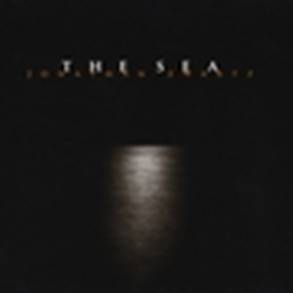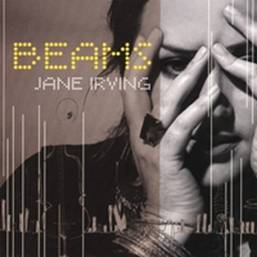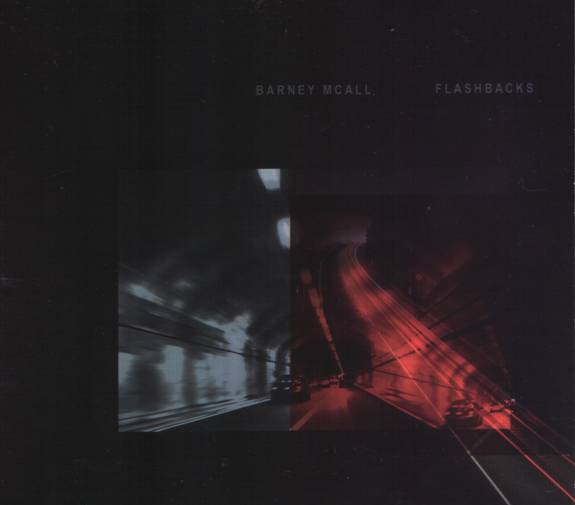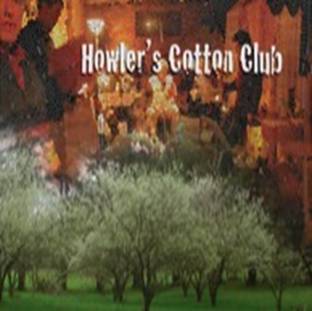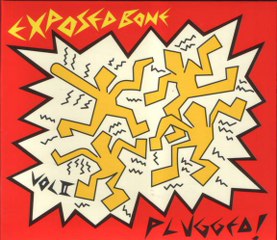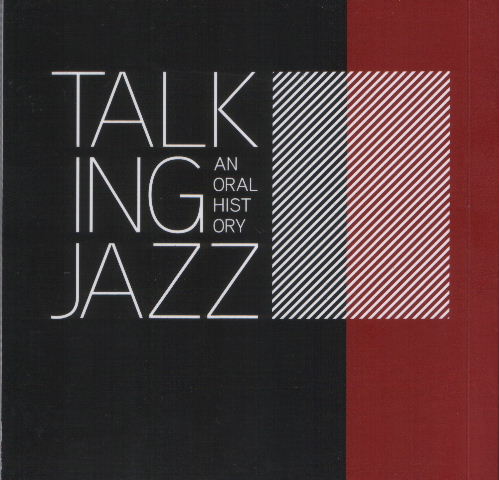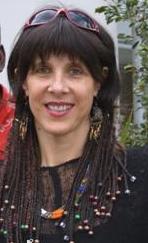Back to recent reviews
Back to 2011 archives
Johannes Luebbers Dectet - The Exquisite Corpse of Beethoven
Tamir Hendelman - Destinations
Albare - Travel Diary
Charlie Haden Quartet West - Sophisticated Ladies
Janet Carroll - Lady Be Good
Kurt Elling - The Gate
The Pearly Shells - Belmar Sessions
Esperanza Spalding - Chamber Music Society
17/1/2011 Jazzgroove Summer Festival
Yaron Herman Trio - Follow the White Rabbit
Boggy Creek Bop - SNAP
Dave Brubeck - Legacy Of A Legend
Benny Goodman - NBC Broadcast Recording 1936-1943
Bob Wilber - Bob Wilber Is Here!
Corea, Clarke & White - Forever
The Grid - The Grid
Julian Curwin - The Mango Balloon Vol 1
Loni Thomson Band - Rewind
Jef Neve Trio - Imaginary Road
James Sherlock Trio - Domestic Arts
Luke Howard Trio - The Meadowland
Ehud Asherie - Welcome to New York
Hilary Kole - You Are There: Duets
Ben Webster - See You at the Fair
Joonatan Rautio Trio - Commitment
Ragabop Trio - Ragabop Trio
Paul Derricott Arrow - Big Sea
Warren Vache-John Allred Quintet - Top Shelf
Louise Rogers - Black Coffee
Alastair Kerr Quartet - The Ultimate Fate Of...
The Drip Hards - This is Dripping
Vince Jones - Modern Folk
Scott Tinkler, John Rodgers, Ken Edie & Marc Hannaford - NTRPDN
Ran Blake & Sara Serpa - Camera Obscura
Mark Costa - Textures
Harry Allen - New York State of Mind
Dave Bennett Quartet - Clarinet Is King
Jose James and Jef Neve - For All We Know
Bernie McGann - Double Dutch?
Casey Golden Trio - Clarity
Manins McGann Dewhurst Holland Samsom - Latitude
Wangaratta Jazz Festival 2010
Shannon Barnett Quartet - Country
Logic - The Hierarchy
Hamish Stuart - Someone Else’s child
Misinterprotato - The Gentle War
Casey Golden Trio - Clarity
Evan Christopher - The Remembering Song
Humphrey Lyttelton - 1959
John Morrison and Jacki Cooper - Mood Swings
Anat Cohen - Clarinetwork Live At The Village Vanguar
Stacey Kent - Raconte-moi
The Subterraneans
Medeski Martin & Wood – Radiolarians
David Reaston - 10 Guitar Project
Matt Keegan Trio - Live
Java Quartet - Rejavanation
Tokyo Jazz Festival 2010
John Bunch - Do Not Disturb
Jackie Ryan - Doozy
Martin Taylor’s Spirit of Django - Last Train to Hauteville
Joseph Tawadros - The Hour of Separation
Cindy Blackman - Another Lifetime
Bonnie J Jensen - Shimmer
Jex Saarelaht Quartet - Five Ways
Terje Rypdal and Bergen Big Band - Crime Scene
The Subterraneans
Arrow - Big Sea
Aaron Flower’s BAZ - Lady From Toulouse
Rigmor Gustafsson and Radio String Quartet Vienna - Calling You
Listen/Hear Collective - Presence motion
José James & Jef Neve - For All We Know
James Morrison and The Idea Of North - Feels Like Spring
Dave Bennett - Celebrates 100 years of Benny
John Pizzarelli - Rockin’ In Rhythm
Heinz Sauer, Michael Wollny, Joachim Kuhn - If (Blue) then (Blue)
Jeremy Pelt - Men of Honour
Sophie Milman - Take Love Easy
Carol Sloane - We'll Meet Again
Mike Nock Trio - An Accumulation of Subtleties
Christine Sullivan - Away
Way Out West - The Effects of Weather
Melbourne International Jazz Festival 2010
The Wynton Marsalis Quintet & Richard Galliano - From Billie Holiday to Edith Piaf
Kim Lawson Trio - Alive and Kicking
Warwick Alder Quintet - Brendance
Steve Arie - Short Stories. The Bass and I
Oscar Peterson - Debut: The Clif/Mercury Duo
B Sharp Big Band - Big Band Bounce!
Nicki Parrott and Rossano Sportiello - Do it Again
Ran Blake, Anthony Braxton - A Memory of Vienna
Cedar Walton - Voices Deep Within
Phil Treloar - Pathways of the Mind. Of Paradox Once Found
Hayden Jones - Nine Lives Slipping
Tim Wilson, Andrea Keller - Life that Lingers
Angelika Niescier Quartet - Sublime III
The Vampires - Chellowdene
Kim Lawson Trio - Alive and Kicking
Daryl Sherman - Johnny Mercer: A Centennial Tribute
Ella Fitzgerald - Twelve Nights in Hollywood
Jacam Manricks - Labyrinth
Steve and Mal Sedergreen - Mistaken Identity Live
Oscar Peterson - The Very Best Of Jazz
Louie Prez - Scam
Jimmy Cobb Quartet - Jazz In The Key Of Blue
The Andy Sugg Group - Brunswick Nights
Anton Delecca Quartet - Lost City
Randy Sandke - Jazz for Juniors
Rossano Sportiello - It Amazes Me
Tord Gustavsen Ensemble - Restored, Returned
Glyn MacDonald Trio - Birth
Glen Cannon - Clockwork
Marmalade Circus - YUP /And Other Words of Affirmation/
Darius Jones Trio - Man’ish Boy /A Raw and Beautiful thing/
Katia Labèque - Shape of My Heart
Australian Jewish Music Ensemble - Pazit
Tim Garland - The Lighthouse Trio
Scott LaFaro - Pieces of Jade
Andy Bey - Ain’t Necessarily So
Dave Brubeck - Time Out
Frank Sinatra - Ring-A-Ding Ding!
The Dilworths
Vehere - Unravelling
Wangaratta Jazz Festival 2009
Stu Hunter - The Gathering
Tomasz Stanko Quintet - Dark Eyes
Bernie McGann - Solar
Fit
The World According to James - Lingua Franca
Judy Campbell’s Mosaic - Waters of Kenya
Barbra Streisand - Love Is the Answer
Nik Payton & Bob Wilber - Swinging the Changes
Kurt Elling - Dedicated to You
Simon Tedeschi & Ian Cooper - Quintet
The Very Best Of Prestige Records
Dick Hyman - In Concert at The Old Mill Inn
Nicki Parrott - Fly Me To The Moon
The World According to James - Lingua Franca
Jeremy Rose - Chiba
Tina Harrod - Temporary People
Tierney Sutton Band - Desire
Tim Garland (The Lighthouse Trio) - Libra
Mike Stern - Big Neighborhood
Ruby Braff - For The Last Time
Melissa Morgan - Until I Met You
Coffin Brothers - Living in Apocalyptic Times
Tom Harrell - Prana Dance
Roil - Meaning
John Harkins Trio - The Jazz Type
Yaron Herman Trio - Muse
The Harry Allen-Joe Cohn Quartet - Music From South Pacific
Yale University Archives, Volume Three - Benny Goodman
Fallingwater Trio - Stay
Trio Apoplectic - Sofia
Mark Ginsburg Band - Generations
Roberta Gambarini - So In Love
Tierney Sutton Band - Desire
John Allred, Jess Barnhart and Danny Coots - The ABC’s of Jazz
Keith Jarrett, Gary Peacock, Jack DeJohnette - Yesterdays
Michelle Nicole - The Loveliest Night
Johnny Varro featuring Ken Peplowski - Two Legends of Jazz
Anita Wardell - Kinda blue
Tom O’Halloran Trio - We Happy Few
Ernestine Anderson - A Song for You
Diana Krall - Quiet Nights
Antti Sarpila - We’d Like New York In June!
Alex Maguire Sextet - Brewed in Belgium
Ingrid James & John Reeves - Circumflex
Keizjer McGuiness Quintet - The Seed Habit
Joe Ascione - Movin’ Up
Benny Golson - New Time, New ‘Tet
Horace Silver - Live At Newport ‘58
The Fantastic Terrific Munkle - Music to Dance to
The Bruce Cale Quartet - The Sydney Concert - On Fire
Dale Barlow - Treat Me Gently
Darren Heinrich - New Vintage Tunes for the Hammond Organ
Phil Treloar & Hamish Stuart - Converging Paths Shades of There
Boz Scaggs - Speak Low
John Pizzarelli - With A Song in My Heart
The Warren Vache-John Allred Quintet Live - Jubilation
Judy Carmichael - Come and Get It
Charlie Parker Bird - The Complete Charlie Parker on Verve
Greg Coffin Trio - It’s Neither Either or. It’s Both And
Jonathan Zwartz - The Sea
Mehldau meltsdown the Basement 12/03/2009
Johnny Varro Swing 7 - Ring Dem Bells
Margie Lou Dyer and Allan Browne - Allfrey Street
Katie Noonan - Blackbird
Charlie Parker - Bird in Time 1940-1947
Jenny Scheinman - Crossing the Field
Michael Feinstein - The Sinatra Project
The John Bunch Trio - Music of Irving Berlin
Ron Carter - Jazz and Bossa
Joe Lovano with the WDR Big Band & Rundfunk Orchestra - Symphonica
The Alcohotlicks - You You
Michael Occhipinti - The Sicilian Jazz Project
Jim Galloway’s Wee Big Band - Blue Reverie
Patricia Barber - The Cole Porter Mix
Don Braden - Gentle Storm
Dave Holland Sextet - Pass It On
Aunty Richard - Leaf Blower
Steve Turre - Rainbow People
Danilo Perez and Claus Ogerman - Across the Crystal Sea
The Soprano Summit in 1975 and More
Trio da Paz and Joe Locke - Live At JazzBaltica
Wangaratta Jazz Festival 2008
Stan Getz - The Bossa Nova Albums
Willie Nelson & Wynton Marsalis - Two Men With The Blues
Aaron Weinstein & John Pizzarelli - Blue Too
Manly Jazz Festival 2008
Neilsen Gough - A Beautiful Dream
Manuel Mengis Gruppe 6 - The Pond
Brian Blade and The Fellowship Band - Season of Changes
Wycliffe Gordon at Sound Lounge - 9th Oct 2008
Cassandra Wilson - Loverly
Judy Carmichael - Southern Swing
Scott Robinson Plays the Compositions of Thad Jones - Forever Lasting
Andrew Robson Trio - Radiola
Wallace Roney - Jazz
Harry Allen & Joe Cohn Quartet - Stompin’ The Blues
Monty Alexander - The Good Life
Wanderlust - When in Rome
Catherine Russell - Sentimental Streak
Yuganaut - This Musicship
Evan Christopher - Delta Bound
Dianne Reeves - When You Know
Sweet Lowdowns - Cuttin’ Capers
Blaine Whittaker - Sound Barrier
Jack Zorawski Trio - First Train
Daniel Levin Quartet - Blurry
Buddy DeFranco - Charlie Cat 2
Jackson & Hazeltine - Sugar Hill
Keith Jarrett, Gary Peacock, Jack DeJohnette - Setting Standards New York Sessions
Enrico Pieranunzi - As Never Before
Elizabeth Geyer - On Patrol with the Jazz Police
Marcin Wasilewski Trio - January
Pat Metheny - Day Trip
Jane Irving - Beams
Howard Alden & Ken Perlowski - Pow-Wow
Bill Charlap - Live at the Village Vanguard
Nicki Parrott - Moon River
Ruby Braff - Ruby Braff and the Flying Pizzarellis
Dina Derose - Live At The Jazz Standard
Janet Seidel & Joe Chindamo - Charade
The best of Newport ’57
Kim Sanders and Friends Bent Grooves - Sound Lounge 9th May 2007
Clifford Brown. Jazz Characters - Joy Spring
Eliane Elias - Something for You
Dave Douglas & Keystone - Moonshine
Les Tresors - Du Jazz
Harry Allen-Joe Cohn Quartet - Music from Guys and Dolls
The Jimmy Cobb Quartet - Cobb’s Corner
Barney McAll - Flashbacks
Matt Keegan Trio - Tone Imagination
Steve Russell - When the Light Comes
Becky Fox - Allure
Horace Silver - Jazz Characters
Cam McAllister Quintet - Libran Balance
Jackie Ryan - You And The Night And The Music
Ella Fitzgerald - Live At Mister Kelly’s
Anthony Howe - The Misty Downs Sessions
Enrico Rava and Stefano Bollani - The Third Man
Roberta Gambarini and Hank Jones - You Are There
Jon-Erik Kelso - Blue Roof Blues: A Love Letter to New Orleans
Russell Malone - Live At the Jazz Standard
Don Rader - Odyssey
Judy Bailey Trio - Pendulum
Exposed Bone - Plugged Vol II
GEST8 - Kaleidoscope
Dexter Gordon - Live in 63 & 64
Knoxville Jazz Orchestra - Blues Man from Memphis
Andrew Robson and Paul Cutlan - Simpatico
Diana Krall - The Very Best Of
Kurt Elling - Nightmoves
The Mulgrew Miller Trio - Live At The Kennedy Center
Ella Fitzgerald and Louis Armstron - The Ultimate Duets
Harry Allen & Joe Temperley - Cocktails for Two
David Hazeltine Trio - The Jobim Songbook in NY
Billy Taylor & Gerry Mulligan - Live at MCG
Carol Sloane - Dearest Duke
Watermelon Slim - The Wheel Man and The Workers
Ben Sidran Talking Jazz - An Oral History
Jazzgroove Mothership Orchestra with Florian Ross - Dream Wheel
The Steve Hunter Band - Dig My Garden
Dave Brubeck - Indian Summer
Joe Cohn - Restless
Ella Fitzgerald - Love Letters from Ella
GEST8 - Sound Lounge 26/10/2007
Way Out West 'Old Grooves for New Streets'
Chris Cody Coalition 'Conscript'
Sara Gazarek 'Return to You'
Andrea Keller Quartet 'Little Claps'
Barnett 5'Little Green Men'
Andy Fiddes 'Livewire'
Manly Jazz Festival 2007
Jane Monheit 'Surrender'
Oscar Peterson, Ray Brown & Milt Jackson 'The Very Tall Band'
Terrill Stafford Quintet 'Taking Chances: Live at the Dakota'
'Wanderlust' - Sound Lounge 28/8/2007
The Tim Bruer Quartet (self titled)
Deidre Rodman & Steve Swallow 'Twin Falls'
Zoe and the Buttercups (self titled)
Tony Gorman and Bobby Singh 'As Wide as the Sky'
Ella Fitzgerald 'The Very Best Of The Songbooks'
Kenny Davern and Ken Peplowski 'Dialogues'
Tord Gustavsen Trio 'Being There'
Claire Martin 'He Never Mentioned Love'
Frank Vignola 'Vignola Plays Gershwin'
Trio Apoplectic
Jazz in the Charts
Squall 'Squall'
Doug Cox, Salil Bhatt with Ramkumar Mishra 'Slide to Freedom'
SHOWA44 'Ormus'
Paul Motian 'Time And Time Again'
Cheryl Bentyne 'The Book Of Love'
Fred Hersch 'Personal Favourites'
Tierney Sutton Band 'On The Other Side'
Regina Carter 'I’ll Be Seeing You: A Sentimental Journey'
Wynton Marsalis 'From The Plantation To The Penitentiary'
Christian McBride 'New York Time'
Adrian Cunningham Quartet 'The Live Sessions'
Bonnie J Jensen 'The sapphire tree'
Sean Coffin Quintet - Sound Lounge 2/06/2007
Harry Connick Jr 'Chanson du vieux carre'
Scott Hamilton 'Nocturnes And Serenades'
Romero Lubambo 'Softly'
Bucky Pizzarelli '5 For Freddie'
John Pizzarelli 'Dear Mr Sinatra'
Various Artists 'Lush Life'
New York Trio 'Thou Swell'
Sonny Rollins 'Sonny Please'
Judy Campbell's Mosaic with Bandika Ngao 'Colours of Kenya'
Tim Bruer Quartet - Sound Lounge 11/05/2007
Stefon Harris 'African Tarantella'
Gladys Knight 'Before me'
Russell Malone 'Live At The Jazz Standard'
Ike Quebec 'It Might As Well Be Spring'
Charles Tolliver Big Band 'With Love'
Mike Nock and Dave Liebman 'In Concert – Duologue'
Tom O'Halloran 'Green Hills and White Clouds'
Paul Motian 'On Broadway VOL 4'
Judy Bailey Quartet 'Colours'
Kenny Davern 'No One Else But Kenny'
Coleman Hawkins 'The Hawk Flies High'
Hank Jones and Frank Wess 'Hank and Frank'
Norm Kubrin 'I Thought About You'
Irene Kral 'The Band And I'
Mark Isaacs's Resurgence - Sound Lounge 24/042007
Judy Campbell's Mosaic - Eastside Arts 17/03/2007
The Necks - The Basement 21/03/2007
Sean Wayland
Bernie MCGann Re-unite at the Lounge, 19/01/2007
Bob Margolin 'In North Carolina'
Dave Panichi Septet 'Seven Steps to Manhattan'
Roger Manins 'Hip Flask'
Billy Cobham 'Drum'n'voice'
The Necks 'Chemist'
Alister Spence Trio 'Mercury'
John Harkins
Days of Wine and Oehlers, Wangaratta 2006.
Andy Fiddes 'Survival of the Fiddes'
Coffin Brothers 'Coffin Brothers Live'
Grace Chung 'Liking you Liking Me'
Leo Trincabelli 'Hangmusic'
Andrea Keller 'Angels and Rascals'
Brad Mehldau Trio 'House on Hill'
Blake Wilner Quartet 'Interloper'
Joe Chindamo 'Solo Live at Umbria
Jazz 2005'
Leo Dale 'Moonlight Drive - @ the Famous
Blue Raincoat'
Barney McAll 'Vivid'
Kim Sanders with Peter Kennard
'Tranc'n'Dancin'
The Conglomerate 'Go to the
Beach'
Bernie McGann 'Blues for Pablo Too'
Cameron Undy 'Numerology - Telepathy'
Greg Osby 'Public'
Jasper Leak Quintet 'It's Cold Out'
Keith Jarrett 'The Out of Towners'
Steven Bernstein 'Diaspora Hollywood'
Alice Coltrane 'Translinear Light'
Fiona Johnson and Cameron Undy 'Beads of
Light'
Jukka Perko, Severi Pyysalo, Teemu
Viinikainen 'Kuunnelmia'
Leonie Cohen Plus 'Jerusalem'
Graeme Lyle Meets Joe Chindamo 'Love
Blues and Other Fiction'
Karlie Bruce 'La Brava'
Adrian Cunningham 'The View from Here'
The Java Quartet 'Deep Blue Sea'
Bill Frisell 'Unspeakable'
|
Reviews
 
 
 -
masterpiece, -
masterpiece, 
 
 -
excellent, -
excellent, 
  - good,
- good, 
 - fair, - fair,
 - poor - poor
| 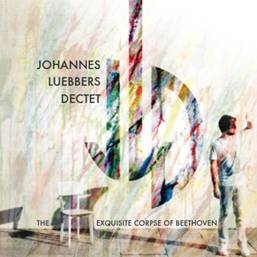 | Johannes Luebbers Dectet - The Exquisite Corpse of Beethoven (www.listenhearcollective.com)
|
Led by Perth based composer and arranger Johannes Luebbers, this dectet was invited to perform at last years Wangaratta Jazz Festival and proved they successfully straddle the jazz and classical divide. Rather than high brow, other western forms such as rock and pop are touched including a soulful vocal cover of Leonard Cohen’s ‘Hallelujah’ by Aaron Malone and the nimble elasticity of guitarist Simon Jeans. The title track is layer upon layer of richly bladed sectional coatings underneath exciting solo’s by altoist Ben Collins and pianist Chris Foster book-ended by a jaunty dialogue between piano, drums and bass. ‘Just Ripe’ is a lavish theme given a post modern bent and features trumpeter Callum G’Froerer, who reveals some Freddie Hubbard influence. ‘Everything for Brod’ increases in lyrical intensity with an oboe intro from Steph Nicholls but soon swells in orchestral energy before retreating to woodwind and piano sobriety only to explode once again, exemplifying the textural and dramatic qualities of Luebber’s pen.
   
|
by Peter Wockner
Previously published in Limelight Mar 2011 |
| Back to Index |
| 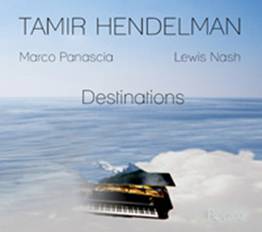 | Tamir Hendelman - Destinations (Resonance Records RCD-1017)
|
What I like about the Israeli born pianist is his willingness to embrace the music of contemporary piano giants such as Fred Hersch and Keith Jarrett. Joining him on this journey is the hard swinging drummer Lewis Nash and the ever present Marco Panascia on bass. He indulges with only two originals from twelve but his arrangements of standards such as ‘Wrap your Troubles in Dreams’ and Parker’s ‘Anthropology’ is enough to stamp a brand which clearly stems from the Oscar Peterson lineage. Blessed with a dazzling technical ability, he rarely over expresses but rather tastefully enlarges the trio’s sum.
   
|
by Peter Wockner
Previously published in Limelight Mar 2011 |
| Back to Index |
| 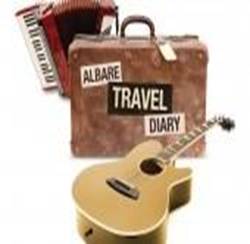 | Albare - Travel Diary (Canadian American Records)
|
To the fans of that awkward American term ‘smooth jazz’ take note, this album will appeal to you. Rather than travelling, you’ll feel you’re on an extended vacation in an idyllic tropical paradise. These nine original melodies from the guitarist are easy on the ear but the consistency of rhythmic textures (drum programming) runs the risk of entering elevator territory, and improvising remains closely aligned with melody. Joe Chindamo becomes the preventative with his fleeting, feathery piano accordion and Kenny Dorham’s ‘Blue Bossa’ is case in point. The disc finishes with a contrasting and less produced live recording at Bennett’s Lane.
  
|
by Peter Wockner
Previously published in Limelight Mar 2011 |
| Back to Index |
| 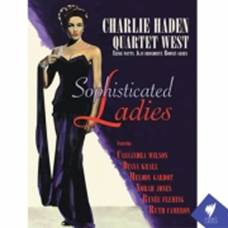 | Charlie Haden Quartet West - Sophisticated Ladies (Emarcy 2750816)
|
Smokey, atmospheric music is what we have come to expect from bassist Charlie Haden’s film noir-inspired Quartet West, one of the finest jazz groups of the past 20 years. It continues to reinterpret the past - this time it’s the torch singers of the 1950’s with the addition of six contemporary vocalists in this sequel to the wonderful The Art Of The Song (1999) recorded in Los Angeles and New York with two different string sections conducted by pianist Alan Broadbent. Cassandra Wilson, Diana Krall, Melody Gardot, Renee Fleming and Ruth Cameron (Haden’s wife and co-producer) add to a musical journey of bittersweet romance. But as expected with such a lineup the results are uneven; Wilson and Krall are the best although Jones does well with Ill Wind. Wilson’s beautiful rendition of My Love And I shows what a great jazz vocalist she is and Krall turns Goodbye into the slowest of laments. Haden has a superb solo after Wilson’s vocal but this could also sum up the contributions of the rest of the group - Broadbent, tenor Ernie Watts and new drummer Rodney Jones, especially on the string-shrouded Ellington standard Sophisticated Lady and My Old Flame. This is quality and class.
    
|
by Kevin Jones
Previously published in Limelight Mar 2011 |
| Back to Index |
| 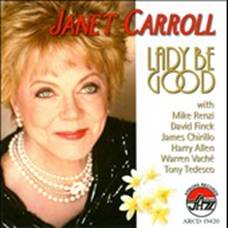 | Janet Carroll - Lady Be Good (Arbors ARCD 19420)
|
Veteran singer-actress Janet Carroll covers all bases, from opera to jazz and Broadway to gospel and Dixieland. Her career includes stints as a jazz singer which is probably why her unfettered voice sounds so comfortable in this setting. But what lifts her fourth jazz vocal album is the first-class backing, especially by cornetist Warren Vache and tenor saxophonist Harry Allen. Vache is brilliant whether muted (I Love Paris) or open (Georgia On My Mind) as is the in-form Allen: swinging easily (What is This Thing Called Love) or caressing a ballad (I Just Don’t Know)
   
|
by Kevin Jones
Previously published in Limelight Mar 2011 |
| Back to Index |
| 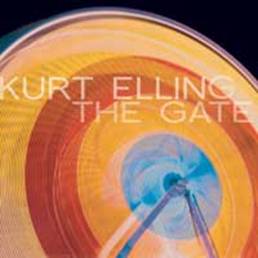 | Kurt Elling - The Gate (Concord/Universal)
|
This album is quite a departure for Kurt Elling, one of the top male jazz vocalists in the US; some would say the top. The material – unusually for Elling – includes songs by King Crimson, Joe Jackson, Stevie Wonder and the Beatles plus a few from his more usual repertoire. Produced by Don Was, noted for his productions of the Rolling Stones, Bob Dylan, Bonnie Raitt and many others from pop or country genres, the arrangements are all by Elling and his long-term musical director/pianist Laurence Hobgood. Several tracks use back-up voices that detract from the arrangements especially in their “shush, shush, bom, bom” routine in an otherwise likable, bluesy, Elling composition, Samurai Cowboy. His amazing voice retains its verve, range and improvisational expression probably best heard here on Miles Davis’s Blue In Green, with lyrics contributed by Al Jarreau. Joe Jackson’s Steppin’ Out, in a medium tempo works quite well and Hobgood delivers a crisp flowing solo while the Herbie Hancock ballad Come Running To Me is a natural for Elling’s style, but again has those superfluous and distracting back-up vocals. The most curious inclusion is the Beatles’s Norwegian Wood where Elling delivers a passable arrangement of this by now clichéd melody. The newest Elling album is unlikely to fulfil the release notes forecast of “. . . perhaps the finest of his career.”
   
|
by John McBeath
Previously published in The Australian March 2011 |
The grammy winning vocalist describes this album as ‘definitive’ Kurt Elling. One thing’s for certain, his move to producer Don Was shifts the singer’s emphasis to a more highly produced album that includes his own layered backing vocals and other resonating/sustaining effects which in a way detracts from Elling’s natural wow factor. Even more assured however with a maturing grainy crackle around the edges, Elling’s highlights are two songs only 6 years apart in birth-date but poles apart in DNA , the Davis/Evans ‘Blue in Green’ and the Lennon/McCartney ‘Norwegian Wood’. Laurence Hobgood remains a prized collaborator and foil
   
|
by Peter Wockner
Previously published in Limelight May 2011 |
| Back to Index |
|  | The Pearly Shells - Belmar Sessions (Newmarket Music)
|
The style and content of this album is directly referenced to the swing and early rock era of the late forties and early fifties. Melbourne nine piece group The Pearly Shells specialises in having a variety of vocalists and instrumentalists guesting and there are nine here, plus vocal back-ups. Intentional or not there is a definite similarity between these ten tracks and the music of the swing, r’n’b group led by Louis Prima around sixty years ago. This is especially noticeable on When I Grow Too Old To Dream featuring the trumpet and vocals of Paul Coyle. Prima also played trumpet and sang and Coyle’s vocal phrasing and expression are very like Prima’s. The Pearly Shells often employ shuffle rhythms under swing style arrangements, such as in Hetty Kale’s vocal, Honeysuckle Rose. The r’n’b component is to the fore in Blue Light Boogie, complete with Dai Jones’s barrelhouse piano. Vocalist Julie O’Hara’s Little Secret has her also impersonating a superfluous “voice trumpet.” The most successful nostalgia take is on the only instrumental track, Jumpin’ With Dean which captures some of the feel of a New Orleans jump. The album means to convey a sense of mid 20th century musical fun, which is only partly achieved. It may well be that The Pearly Shells are more entertaining in live performances
  
|
by John McBeath
Previously published in The Australian March 2011 |
| Back to Index |
| 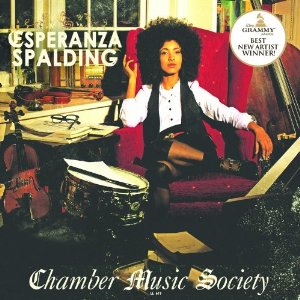 | Esperanza Spalding - Chamber Music Society (Heads Up/Fuse)
|
When US vocalist, bassist and composer Esperanza Spalding won the 2011 Grammy Award for Best New Performer – a case of true talent trumping musical mediocrity – she beat out the likes of Florence & The Machine and Justin Beiber. Resentful Beiberites tweeted their anger even hacking into Spalding’s Wikipedia page, but as the New York Daily News said: “She’s the real deal . . . This is a real musician.” She is also the first jazz performer ever to win that award. The 26-year-old Spalding may be unknown to Beiberites but she’s been a rising star in the jazz world for several years, becoming at the age of just twenty the youngest ever professor at Boston’s Berklee College of Music. After her 2008 album Esperanza topped Billboard’s Contemporary Jazz Album chart for 16 months, her latest, Chamber Music Society went to number one there in January 2011. The album draws on both her jazz and classical backgrounds, pushing boundaries and interweaving those two genres with folk, world music, bossa nova, and a touch of funk. Spalding is on acoustic bass with drummer Terri Lyne Carrington and pianist Leo Genovese. Then to create the chamber music effect violin, viola and cello are added, along with wordless vocals as additional backing. Soaring atop this eclectic mix is Spalding’s angelic soprano. From the opening notes of her bass with the string trio on track one Little Fly, it is obvious that this is a very special recording. Singing words from a William Blake (d.1827) poem, Spalding’s ethereal voice floats out with delicate expression. After three choruses with the strings in a chamber music style without piano or drums, Spalding takes a bass solo inflected with jazz ideas and finishes with a single high climbing vocal phrase. Knowledge of Good And Evil blends strings with the rhythm section groove as Spalding scats in mid range, while a Latin beat infuses Chacarera as she demonstrates her amazing vocal range and ability with a complex melody line, in an arrangement neatly balancing piano, bass and cello against compound percussion. Paired with Brazilian vocalist Milton Nascimento, she gives an unusual classical approach to the ballad Apple Blossoms. A most unusual album of unique creativity
    
|
by John McBeath
Previously published in The Australian March 2011 |
| Back to Index |
17/1/2011 Jazzgroove Summer Festival Review
The music of Duke Ellington is as relevant and as influential today as it ever was. Visiting Melbourne based saxophonist Julien Wilson is re-visiting Ellington/Strayhorn at the moment and gave a keen bunch of sweaty festival goers, in the Redfern Town Hall, a taste of just how much he is loving Ellington with three pieces “Creole Blues”, “Bloodcount” and a beautifully mangled and de-railed “Take the A Train”. Guitarist Carl Dewhurst provided some of the most breathtaking harmony of the three day festival during “Bloodcount”. With the rapport of Cameron Undy on bass and Hamish Stuart on the drums, the tangible musical empathy between these artists had an almost spiritual effect on the music. Ellington also featured in the repertoire of Grant Arthur’s Debonair Gentlemen during a fiery pub gig where he played the antique and overgrown trumpet - the ‘bumpet’, an instrument that looked and sounded like it came from the early Ellington era but it’s deep throaty tone oddly fitting the quirky Preservation Hall meets Ornette Coleman flavour of this group.
On the Friday night, Greg Coffin’s nimble playing was dazzling enough to overlook the brittle sounding piano at Raval. With Dave Jackson’s alto out front and Brendan Clarke on bass, the Denominators is a wonderfully balanced band assembled by drummer Paul Derricott.
Jane Irving’s band ‘The Swinging Blades’ and a cool ale, was just the elixir for a balmy Saturday afternoon crowd at the Excelsior Hotel. Irving might sing for her Zambucca but her vocals are seriously sassy with articulate diction and scatting that raised both eyebrows and shot glasses. Meanwhile guitarist Julian Curwin’s Fantastic Terrific Munkle was trimmed by the absence of clarinettist Martin Kay. Conceptually one of the most interesting sounds of the festival program, neither retrospective nor futuristic, the sousaphone, piano accordion and banjo mix kept the mostly 2-3 minute stylised pop bytes highly entertaining but also highly artistic.
Simon Ferenci is without doubt a Sydney trumpet talent worthy of wider recognition. He and his quartet made up of Alister Spence piano, Mike Majkowski bass & James Waples drums captivated a capacity Venue 505 audience with their oblique, spatial and highly lyrical originals.
The Kristin Berardi band included James Muller on guitar and Matt McMahon on piano. Berardi’s angelic voice is an original and like her own fertile melodies and sometimes overly sweet lyrics, her naturalness at delivery point is infectious and infiltrated both band-members and audience alike. Matt McMahon was in an especially attacking mood with some dazzlingly successful solos.
With two thirds of the capacity Macquarie Hotel audience in attendance for socialising rather than listening, vocalist Briana Cowlishaw showed us a bold confidence in her own original material some of which she recently recorded in New York city. Matt McMahon, this time on the Fender Rhodes and an unusually subdued James Muller made up the group with Brendan Clarke bass and Nic Cecire drums.
The festival this year was embellished by a couple of free and very worthwhile Musica Viva kids workshops by The Sousaphonics and The World According to James. Whilst they all may not end up being musicians, at the very least, the basic knowledge of what elements to listen out for in the music we call jazz is vital to the future prosperity of the music. Well done Jazzgroove!
|
by Peter Wockner
|
| Back to Index |
| 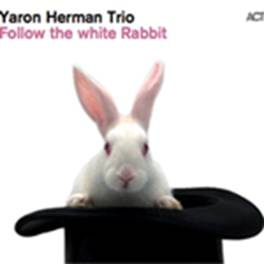 | Yaron Herman Trio - Follow the White Rabbit (ACT 9499-2)
|
It would be easy to say Herman is picking up where EST left off. This is his first for the ACT stable with the new trio of Chris Tordini bass and Tommy Crane drums. The Israeli born, Paris based pianist continues to explore rock composers like Kurt Cobain and Radiohead and adds a depth of clarity to the focused direction of the Herman trio ‘sound’. While it doesn’t reach the artistic heights of ‘Muse’ (2009) with string quartet, there is much to savor here like his nimble right hand on ‘The Mountain’ resembling rapidly multiplying rock falls or Crane’s groove on ‘Heart Shaped Box’
   
|
by Peter Wockner
Previously published in Limelight February 2011 |
| Back to Index |
| 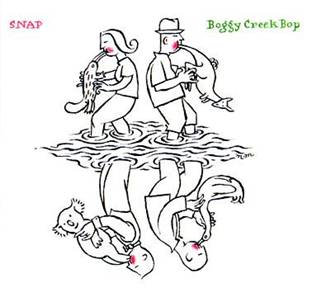 | Boggy Creek Bop - SNAP (Rufus Records RF 076)
|
Jazz is a novel vehicle for use by saxophone quartets to further explore the combined sounds of the instrument; the World Saxophone Quartet being most prominent. A project designed by Philip Johnston with the addition of Nick Bowd, Sandy Evans and Paul Cutlan, SNAP has matured into a very original Australian quartet. The rhythm ,melody and harmony are all driven by various members at differing times using complex counterpoint. Evans’s Bellingen suite is inspired by the town’s geography and artistic culture. Take the peaceful flow of ‘The Beautiful Bellinger’, the swinging laughing ‘Urungatang’ or the joyous celebratory ‘Street Party’ referring to the annual jazz festival
   
|
by Peter Wockner
Previously published in Limelight February 2011 |
| Back to Index |
| 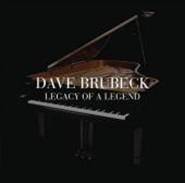 | Dave Brubeck - Legacy Of A Legend (Columbia/Legacy 88697805632)
|
Despite having pacemaker surgery October 2010 and in the late autumn of an illustrious career, jazz legend Dave Brubeck who was 90 on December 6, shows no sign of easing up, receiving glowing reports of his quartet’s gig at New York’s Blue Note club over the Thanksgiving weekend, his first since leaving hospital. Brubeck chose the 21 tracks, which chart the pianist, arranger and composer’s career from 1954-73. Most of them feature the “classic” quartet (1958-67) with alto saxophonist Paul Desmond, bassist Eugene Wright and drummer Joe Morello. Inevitably two of his most popular experiments into unusual time signatures, Take Five and Blue Rondo A La Turk, are included as is Three To Get Ready from the group’s last concert released for the first time. But there is so much more, beginning with the original quartet (Jeepers Creepers) and ending with Gerry Mulligan at the Berlin Philharmonic
    
|
by Kevin Jones
Previously published in Limelight February 2011 |
| Back to Index |
|  | Benny Goodman - NBC Broadcast Recording 1936-1943 ((Yale University Archives Vol V)
|
Nimbus NI2734/35
With so much emphasis on Benny Goodman’s great 1937-38 orchestra, it’s easy to forget just how good his bands of the early 1940’s were. These never before released broadcast recordings set the record straight. Despite being almost immobilised by a crippling back problem in 1940 which would force him to disband temporarily he plays brilliantly. A five minutes One O’Clock Jump shows the band’s solo strength and power. Goodman never had a better band than that of 1941 whose stars were trumpeter Cootie Williams, showcased superbly on Superman, and pianist-arranger Mel Powell. And then there are the small groups. A treasure chest of swing
    
|
by Kevin Jones
Previously published in Limelight February 2011 |
| Back to Index |
|  | Bob Wilber - Bob Wilber Is Here! (Arbors ARCD 19402)
|
This enjoyable reunion of Bob Wilber and his multi-reed proteges Anti Sarpilla and Nic Payton should delight mainstream jazz lovers. With Wilber the familiar is never commonplace: the unbridled swing of Vampin’ Miss Georgia, based on the chords of the venerable Sweet Georgia Brown, features the three on soprano saxophone. Even better is The World Is Waiting For The Sunrise, showcasing their clarinet styles to great effect, both in unison and solo. Anne Barnhart’s flute blends nicely with Wilber’s clarinet on some of the ballads. Her husband, stride pianist Jeff, is a strong soloist and with bassist Nicki Parrott, stars in a first-class rhythm section.
   
|
by Kevin Jones
Previously published in Limelight February 2011 |
| Back to Index |
| 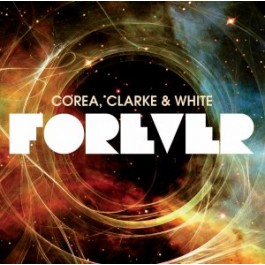 | Corea, Clarke & White - Forever (Concord/Universal)
|
Released to coincide with Return To Forever’s Australian tour which concluded Thursday, February 17th, this double set was recorded in California in 2009. The two discs are distinctly different illustrating two of 17-time Grammy winner pianist Chick Corea’s groups and their styles. Disc one is a live recording of the acoustic trio featuring Corea with bassist Stanley Clarke and drummer Lenny White reflecting their pre-fusion days before 1972. Standards such as Green Dolphin Street and Waltz For Debby are included plus originals by Corea and Clarke. The style on disc one is straight ahead mainstream, mostly up-tempo, with Corea’s piano in flowing, shimmery mode. The one slow tempo number from eight on disc one is Clarke’s La Cancion de Sofia where the composer extensively uses bowed bass, although his unaccompanied solo ending the Spanish-tinged piece, is high speed pizzicato interspersed with slower delicate passages. Thelonious Monk’s Hackensack opens with a military style snare drum switching to quick sock cymbal for the racing piano entry and lift-off before a lengthy drum solo works the kit into a percussive climax. Disc two contains electric productions, a reprise of Corea’s fusion group Return To Forever with the same personnel as their 1973 album Hymn of The Seventh Galaxy: Corea, Clarke, and White with guitarist Bill Connors. (Due to ill health Connors was not on the Australian tour, replaced by Australian-born guitarist Frank Gambale.) Three tracks from the 1973 album are re-presented on disc two and two earlier associates make guest appearances: violinist Jean Luc Ponty, who was on the Australian tour, and vocalist Chaka Khan. The singer makes a creditable job of Gershwin’s Porgy and Bess delivering a swinging, if slightly over-raucous, scatted interpretation with the trio unplugged. Corea’s piece Senor Mouse is the full on rock-fusion sound that became emblematic of RTF: fast and heavy back beat, keyboard and guitar exchanging phrases or working in unison with Clarke’s bass in overtime. Amplified violin rides the top-end of the electric ensemble theme in After The Cosmic Rain, and excels in Ponty’s composition Renaissance with Corea on acoustic piano. This double set is a nostalgia trip with special relevance for those who saw RTF in Australia
   
|
by John McBeath
Previously published in The Australian Feb 2011 |
| Back to Index |
| 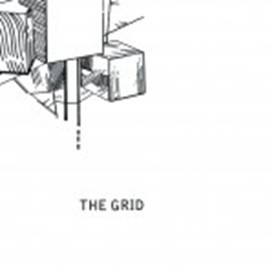 | The Grid - The Grid (Listen/Hear)
|
Perth guitarist Tim Jago, currently studying and teaching in the US, formed The Grid with two other Perth musicians, drummer Ben Vanderwal and Dane Alderson on electric bass. The trio’s debut album is astonishingly diverse, containing songs by Willie Nelson, Miles Davis, Radiohead, Coldplay, and Thelonius Monk, as well as half a dozen originals. Nelson’s Home Motel – a tune with echoes of Paul Simon’s Still Crazy After All These Years – adds Lucky Oceans on pedal steel guitar to produce an authentic country feel. The up-tempo Davis piece Tune Up keeps Vanderwal’s kit in overdrive under Jago’s speeding guitar and features a spectacular racing bass solo before drums cleverly break out with just the right beats expertly emphasised. Talk-back radio is ridiculed in a 45 second send-up Tampered Evidence, complete with idiotic caller voices and music segues. Jago’s composition and opener, Unfinished Busy Nest is a soft, post-bop theme with some smart chord changes and an unexpectedly jagged line, ideal for Vanderwal’s quick drum work. Another original, named after an early model pc, Commodore 64, composed by Vanderwal, combines electronic effects with a strict tempo drum machine style robotic rhythm to give an impressive musical portrayal of digital technology. Each tune here has a unique character, varying in concept and spreading across different genres
   
|
by John McBeath
Previously published in The Australian Feb 2011 |
| Back to Index |
|  | Julian Curwin - The Mango Balloon Vol 1 (Rufus Records RF 070)
|
At an uncanny coinstantaneous moment, I drove past a happy dancing homeless man moving obliviously to the beat while I listened to ‘Candle Dance’ and the ironical melody struck me. The conceptual origin of this album, mainly traditional Eastern European folk music, emotionally draws upon irony, tragedy and reality as consistent themes. Charming narrations includes Ciampa’s chiming gong passing the passages of time on ‘Grindstone’ and the yelping trumpet of Sam Golding on ‘Dog Day Night’ among others. The overriding triumph though is Curwin’s guitars which somehow manage to bridge Django Reinhardt with Metallica balladry and many Eurasian points in between.
   
|
by Peter Wockner
Previously published in Limelight January 2011 |
| Back to Index |
|  | Loni Thomson Band - Rewind (Independent)
|
Four of the five young graduate performers on this debut album are from Adelaide, but are now Melbourne based. Pianist Darrin Archer is the only Melbourne original. Leader and vocalist Loni Thomson began her studies in Adelaide and completed them at the Victorian College of The Arts. She and her bassist Sam Zerna either individually or together wrote all ten of the tracks, making a refreshing change from many vocal albums reworking over-tired standards. The songs demonstrate a good grasp of composition and the musicians are all of high standard. Thomson’s vocal style is diverse, equally compatible with a ballad such as Rewind, scatting in a post-bop piece like Nowhere, or delivering Who Could Say in waltz time. Many of the numbers use interesting harmonic structures, ideal for soloists, and guitarist Hugh Stuckey displays his comprehensive ability on Time Is Lost. Words and syllables are well fitted to the sometimes tricky melody lines but perhaps more attention could have been given to poetic meanings. Sufficient space is left for the instruments and Hugh Harvey’s drum work is impressively mobile throughout. Archer’s piano shines particularly well on Restless, capturing the mood of the song’s title in a pretty ballad format. An interesting and original debut album from a promising youthful vocalist and her talented group
   
|
by John McBeath
Previously published in The Australian January 2011 |
This Melbourne based vocalist and songwriter brings life’s realities, it’s beauty and sometimes frustrations to song in a pure fashion that points to folk and pop in an egalitarian way but draws upon the tenderness and warmth in her tone and the originality in her phrasing to paint a jazz realism self portrait. The pieces range from short sharp stabs of imagery and questioning to lengthy melodious narrative using darker tonal harmonies and post modern sensibilities leaving ample room for creativity from her band members Darren Archer piano, bassist and composer Sam Zerna, Hugh Stuckey guitar and Hugh Harvey drums.
   
|
by Peter Wockner
Previously published in Limelight June 2011 |
| Back to Index |
|  | Jef Neve Trio - Imaginary Road (Emarcy/Universal)
|
This is a timely album from Belgian pianist Jef Neve whose trio has recently toured Australia including an acclaimed appearance at the 2010 Wangaratta Jazz Festival. The performances are strongly in the Euro-jazz style, comprehensively referencing classical music influences. Indeed at Wangaratta, some questioned whether Neve’s music qualified as ‘jazz,’ but with classical/contemporary jazz divides fading those definitions are harder to apply. Neve’s sidemen, bassist Ruben Samama and Teun Verbruggen on drums sound very jazz-oriented, notably on Samama’s composition Little Piece for Justin, where piano also pushes out into a swinging solo with rich chords, reinforced by the bass. On the other hand an out-of-tempo Vibe 1 is a shortish flowing, pastoral piece seguing into what might be termed a post-classical groove on The Space We Need, with Verbruggen’s double-timed drumming excitement driving the climax. The leader’s compositions are intensely descriptive especially in Endless DC – a reference to Da Capo, musical terminology for ‘repeat from the beginning’ – consisting of fugue-like sequences played with a rhythmic pulse swelling to a powerful finale with added electronics. Neve’s For The People employs a repetitive piano treble riff and stabbing chords to open, leading into some straight ahead soloing from piano and hyper-fast bass, before a return to the opening theme
   
|
by John McBeath
Previously published in The Australian January 2011 |
| Back to Index |
| 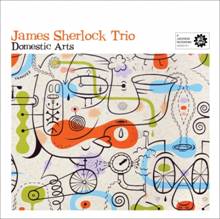 | James Sherlock Trio - Domestic Arts (Jazzhead)
|
This album – Melbourne-based guitarist James Sherlock’s third for Jazzhead – doesn’t push boundaries or strive to be cutting edge, but it swings gently and is competently played in a style that is reminiscent of sixties guitar greats Jim Hall
or Barney Kessel. Together with Sydney players, bassist Brendan Clarke and Tim Firth on drums, Sherlock leads the way through a collection of five, lesser known standards and two of his originals. On the opening track original Domestic Arts And Sciences, a pleasantly bouncy theme, Sherlock displays a smart harmonic understanding and an aptitude for full-throttle flourishes. The Cole Porter song You’d Be So Nice To Come Home To, taken at a medium clip, also recorded by Jim Hall at a faster tempo in 1975, works the ballad over professionally, if a little predictably. The piece features an agile bass solo allowing Sherlock to play a subdued accompaniment and grounding chords. Carlos Jobim’s lovely 1981 ballad Luiza, opens with an out-of-tempo meandering solo guitar expressively played before bass and drums appear in a Latino waltz time. Here, Sherlock’s interpretative ability is evident, spreading big Brazilian chords and racing into high-speed runs. Probably the deepest groove and best solo ideas – in an album of conventional professionalism – are on Monk’s We See
  
|
by John McBeath
Previously published in The Australian January 2011 |
| Back to Index |
| 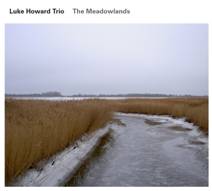 | Luke Howard Trio - The Meadowlands(Which Way Music/Fuse Music)
|
Given the album’s title, it’s no surprise that these originals roll out in a relaxed, pastoral, almost semi-classical way from this Melbourne trio led by pianist Luke Howard. Yet all twelve tracks are infused with a definite jazz feel, some more strongly than others. A strong groove appears in Batch with sturdy bass work from Jonathon Zion and intelligent rhythmic embellishment from Daniel Farrugia’s drumkit as the piano drifts into its dynamic solo. Ballad No. 3 is delivered in a slower tempo and uses interesting harmonies with a flowing foray into the piano’s upper treble. The short title track sounds appropriately bucolic as it wafts through a stillness of abstraction. The tempo picks up for Theme From An Untitled Film as it skips jauntily through its refrain, while Spring ups the pace further with fast-running piano passages in a swinging fugue effect. The longest track Two Percent, strides purposefully along in a medium-slow tempo with a chiming block chord theme and features an explorative bass solo from the composer. Like the natural countryside the album portrays, this music generates quietude and tranquillity as it moves through varying serene moods with occasional cresting flashes. It’s reverie-inducing music, well played and with more than a few satisfying compositions
   
|
by John McBeath
Previously published in The Australian January 2011 |
| Back to Index |
| 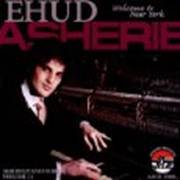 | Ehud Asherie - Welcome to New York (Arbors ARCD 19406)
|
The 31-year-old Israeli-born pianist’s duet sessions with cornetist and trumpeter Jon-Erik Kellso and tenor saxophonist Harry Allen and a scintillating performance with Rossano Sportiello at the 2010 Jazz At Chautauqua, Lake Chautauqua, New York have received rave reviews. With influences ranging from James P. Johnson to Art Tatum and Errol Garner, Ehud Asherie combines the rhythmic thrust of stride and swing with the more modern harmonies of bop in an impressive solo debut highlighted by an exuberant take on Thelonius Monk’s 52nd Street Theme with overtones of Johnson and Fats Waller. His ballad playing is exquisite. An exceptional talent!
    
|
by Kevin Jones
Previously published in Limelight January 2011 |
| Back to Index |
| 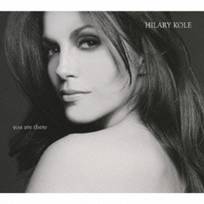 | Hilary Kole - You Are There: Duets (Justin Time JTR8561-2)
|
That a jazz singer on only her second album could persuade 11 of the finest pianists around including the late Hank Jones, Dave Brubeck and Benny Green, and two, Alan Broadbent and Mike Renzi, who have made an art of accompanying vocalists, is remarkable in itself but that their mutual respect has resulted in a album of such quality is even more so. This is a jazz singing master class with each pianist providing a different nuance to Hilary Kole’s warm, subtle phrasing: Brubeck has never been gentler than on These Foolish Things. Romantic jazz at its best!
   
|
by Kevin Jones
Previously published in Limelight January 2011 |
| Back to Index |
|  | Ben Webster - See You at the Fair (Impulse GRD-121)
|
His style may have been considered out of date in some quarters but tenor saxophone giant Ben Webster showed on his final American recording date in 1964 before leaving for Europe where he was more appreciated that he had no peer as a ballad player. At 55 he was at the peak of his considerable powers as his magnificent balladeering on Someone To Watch Over Me and Stardust show. On four tracks he had a superb accompanist in pianist Hank Jones and another nearly as good, Roger Kellaway, on five. Two tracks from Oliver Nelson’s greatest session complete a definitive reissue
    
|
by Kevin Jones
Previously published in Limelight January 2011 |
| Back to Index |
|  | Joonatan Rautio Trio - Commitment (Prophone Finnish Jazz PCD 104)
|
Gifted with a warm rounded tone on tenor saxophone and sometimes reminiscent of Dexter Gordon, Finnish saxophonist, Rautio and his trio have produced a beautifully balanced disc including two standards and six originals playing the soprano on Joe Henderson’s ‘Tetragon’ only. Highlights include Rautio’s own ‘Kabul’ a clipping paced original from the Coltrane ‘Africa’ school but with a wailing Eastern motif. Victor Young’s ‘Weaver of Dreams’ receives further tenderising when Rautio moves up an octave mid chorus. The lack of a chordal instrument allows other nuances like Joonas Riippa’s locking rim shots on ‘Quiet Boy’ to be accentuated
   
|
by Peter Wockner
Previously published in Limelight December 2010 |
| Back to Index |
| 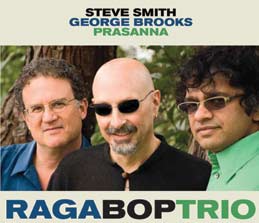 | Ragabop Trio - Ragabop Trio (Abstract Logix ABLX 025)
|
Ragabop brazenly swaggers between Indian Classical styles and driving modern jazz but incorporates other western funk and Euro-jazz flavours. This is no new hybrid creation, but it is one of the most successful fusions since John McLaughlin’s ‘Remember Shakti’. Guitarist Prasanna’s dazzling ability to simultaneously play those yodelling Carnatic sitar like strains from his electric and acoustic guitars while drummer Steve Smith vocalises the percussive art of Konnakol concurrently, forging deep funk grooves. A second Konnakol layer was placed on ‘The Geometry of Rap’. Long time collaborator saxophonist George Brook’s adds a steely edge on both tenor and alto
   
|
by Peter Wockner
Previously published in Limelight December 2010 |
| Back to Index |
| 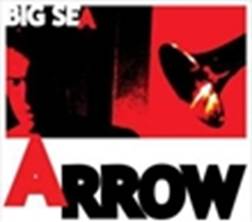 | Paul Derricott's Arrow - Big Sea (Jazzgroove JGR 057)
|
Drummers tend to rely heavily on texture when presenting their own compositions. Derricott is no exception. ‘Arrow’s’ instrumentation was carefully chosen to facilitate the textural qualities of his writing. Each pieces simple melody establishes its own sense of drama and tension bringing with it an unpredictability that is embellished by the dynamics of the group and the use of rhythmic changes. Dale Gorfinkel brings an utterly convincing set of swinging and free expressions on vibraphone while the pianistic talents of the nimble fingered Hugh Barrett replacing logical notes with unlikely choices creating mesmerising solos worthy of repeated listening. Derricott, influenced by Simon Barker, leans on the side of restraint and in the process gets easily to the essence of his music. The chiming Gorfinkel vibes sit beautifully against the darker trumpet of Simon Ferenci, a very jazzy combination rarely recorded in recent history. One of the most impressive Jazzgroove releases
   
|
by Peter Wockner
Previously published in Limelight December 2010 |
| Back to Index |
| 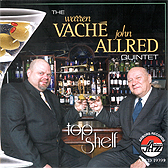 | Warren Vache-John Allred Quintet - Top Shelf (Arbors ARCD 19399)
|
The co-leaders of this group, cornetist Warren Vache and trombonist John Allred, share many things in common including a special rapport built on a friendship of more than 20 years and a catholic musical taste which enables them to move from one musical genre to another, thus a shared love for the music of bop trumpeter Blue Mitchell who from 1958-64 with tenorist Junior Cook was the sparkplug of pianist Horace Silver’s best quintet. Although some would pigeonhole Vache and Allred as classic, swing or mainstream musicians, the pair show here that they are just as at home with bop; not only the music of Mitchell, but also that of Cannonball Adderley, Thelonius Monk, Bud Powell and Clifford Brown. Another highlight is Aussieology by former Sydney bassist Nicki Parrott, part of a first-rate rhythm team with pianist Tardo Hammer (a strong soloist) and drummer Leroy Williams. Both horns shine on the ballads. Vache is sensitive on My Romance and Allred is gentle on Moonlight In Vermont. This is an exciting album by a tight, hard-swinging group which recaptures the spirit of the legendary Clark Terry-Bob Brookmeyer Quintet of the 1960’s. The power of positive swinging indeed!
    
|
by Kevin Jones
Previously published in Limelight Dec 2010 |
| Back to Index |
| 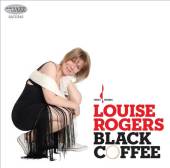 | Louise Rogers - Black Coffee (Chesky SACD 345)
|
Louise Rogers is an exceptional singer! She has a pure minimalist approach, think Peggy Lee or Chris Connor or from an even earlier vintage Mildred Bailey, and her scat singing shows her debt to Ella Fitzgerald. Lyrically delicate at times, she can also swing fluidly. On her fifth album, an intimate showcase of timeless melodies, she is perfectly backed by a trio led by her husband, bassist Rick Strong who complements her beautifully in their duet on Comes Love; even better is the one with guitarist Paul Meyers on the title track. Billy Drummond’s brushwork is superb throughout.
   
|
by Kevin Jones
Previously published in Limelight Dec 2010 |
| Back to Index |
| 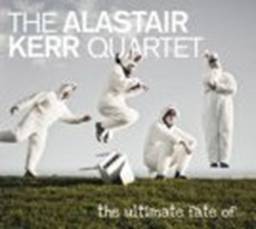 | Alastair Kerr Quartet - The Ultimate Fate Of . . .(Independent)
|
This youthful Melbourne quartet led by drummer Alastair Kerr has released a debut album of originals, five by Kerr, plus one from the group’s pianist Marc Hannaford. It’s a straight-ahead jazz combo recorded live at Bennett’s Lane, and featuring trumpeter Pat Thiele with Sam Zerna on double bass. Most of the substance is provided by Hannaford’s inspired piano; they’re all talented musicians, but Hannaford is the most experienced. Comically entitled The Ultimate Fate of The Energizer Bunny, this fifteen minute Kerr piece opens with bass, piano and a toy piano chiming daintily to establish the theme. Zerna’s bass contributes a lengthy, intelligent solo with piano chords fleshing out the low notes before the drumkit arrives and Hannaford provides a piano bass ostinato, as the three instruments build climactically to the trumpet’s entry. Here, Thiele injects clever humour using half-valving to portray the Energizer Bunny staggering as it runs out of power. The toy piano returns for the close in slowing waltz time. Hannaford’s Silver Charlie is a post-bop theme on which the pianist plays an elongated solo, swinging adeptly within the genre to introduce Thiele’s fast-running trumpet in contemporary style with undercurrents from earlier traditions. Kerr’s grooving kit, underpinned by double bass, is forefront for the opening to Not Another One which builds to an energetic trumpet climax
   
|
by John McBeath
Previously published in The Australian December 2010 |
| Back to Index |
| 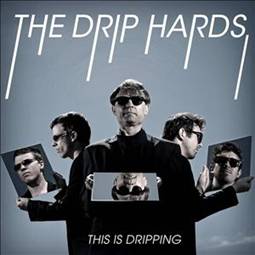 | The Drip Hards - This is Dripping (Jazzgroove)
|
Sydney trio The Drip Hards, featuring multi-genre guitarist Carl Dewhurst has a new definition: “dripping is a form of improvisational interaction in which the relationship of parts is analogous to the sound of water dripping.” Despite its very high quality musicianship this drop of advanced, exploratory music won’t be to everyone’s taste. Bassist Cameron Undy and drummer Evan Mannell make up the group, both having contributed to several of these originals, with most composed by Dewhurst. The music is structured to some extent, often in a blues/funk/electronica format. There are also free sequences and certainly the dripping metaphor is given musical expression to an almost torturous degree in the ten-minute opening title track. The overall approach might be termed Frank Zappa meets Ornette Coleman via John Cage. Unlike some experimental jazz, a strong swinging pulse is used here, often sounding polymetric, plus many kinds of guitar and bass effects giving a jazz/rock fusion feel. He’s Today’s Yeeros is a cleverly eclectic reworking of the Bay City Rollers’ hit Yesterday’s Heroes featuring Dewhurst’s saggy guitar line with the bass’s quick-moving counter melody plus phase-shifted percussion. Opening with an insistent bluesy guitar riff against a quirky bass, I Got The Greens moves into a new paradigm of alt. funk culminating in a riotous climax
   
|
by John McBeath
Previously published in The Australian December 2010 |
The brainchild of superb guitarist Carl Dewhurst, this album is sometimes a rollicking, jolting rollercoaster ride, sometimes a missing two stroke engine using high octane fuel and at other times quirky minimalism . Whether intentional or not, the flexible rhythmic influence of Ornette Coleman’s harmolodics is apparent. Both the electric guitar and Cameron Undy’s electric bass purposely double shunt against the weight of Evan Mannell’s drums. If questioning the level of creativity, I would suggest this is gushing rather than dripping and may be one of the most influential local releases in recent times.
   
|
by Peter Wockner
Previously published in Limelight February 2011 |
| Back to Index |
| 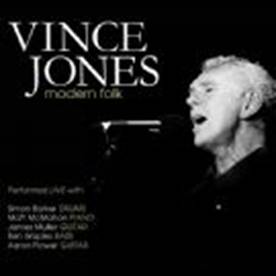 | Vince Jones - Modern Folk (Vitamin VJ3560)
|
Modern Folk is almost like a natural homecoming for the audience friendly Jones voice which manages to bridge jazz, folk and blues in a single phrase. Jones’s originals are all about life’s realities and socio-political awareness. Warm sensitivity and now a heart rendering vulnerability reverberate in this veteran’s voice captured in various live settings around Australia. While some lyrics such as “The food refinery will bring you misery” might be hard to swallow, the majority of his originals are gilded with his bittersweet irony and unfettered conviction eg “Its not the love of power but the power of love’. Definitive Vince.
   
|
| by Peter Wockner |
| Back to Index |
| 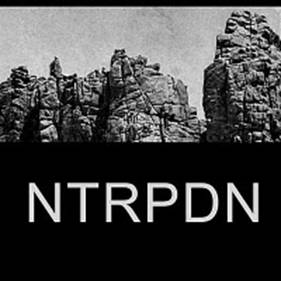 | Scott Tinkler, John Rodgers, Ken Edie & Marc Hannaford - NTRPDN (Independent)
|
This album expands on a genre that emerged in the 1950s, grew in performances during the 1960s and into the 1970s, but declined over the following twenty years. Somewhat ambiguously it was titled “free jazz” – in one sense all improvisation is “free” – and to date, although the style has seen a resurgence from the 1990s onwards, no more suitable term has appeared. Perhaps the word 'autogenesis,' lifted from biology and meaning self- propagating could apply. The approach is one of improvisation not based on a harmonic structure. It may be in a particular key or it may not, it may be rhythmic or without a pulse, there may or may not be a composed theme, and non-western influences might be used. Its pioneers included Ornette Coleman, Cecil Taylor, Albert Ayler, Eric Dolphy and others who placed emphasis on unstructured collective improvisation. Many audiences, then and now, failed to appreciate the “new music” but it should be remembered that without talented exploration there is no innovation or evolution in the arts. The challenge for practitioners is to take audiences with them, and the danger is that spectators may feel like outsiders watching players absorbed in their own closed circuit creativity. Perhaps any sounds can become music, but their successful deployment depends crucially on the abilities of the musicians. All of this brings us to NTRPDN, a follow-up to Funcall released in 2008 by the same quartet The Antripodeans, featuring trumpeter Scott Tinkler, violinist John Rodgers, pianist Marc Hannaford and Ken Edie on drums – all highly gifted Melbourne musicians. The obscure title may be “Antripodean” minus the vowels. There are only two tracks, each of just over thirty minutes and both move through a diversity of out-of-tempo moods and characteristics, often indistinguishable from free form avant-garde classical music. The drum-kit, freed from time-keeping, is used for melodic embellishment and punctuation, while the other instruments range in abstraction either collectively or solo, with pizzicato or bowed violin working especially well with the piano. Almost no chords are used, giving the music a linear continuum. The trumpet role varies from lengthy, occasionally slightly garbled held notes, high frequency excursions, and fast moving expressive passages. This is experimental music for reverie, introspection, and transcendental tripping, but not without tension of an unpredictable kind, sometimes achieved by gaps and silences. It won’t please everyone and the genre may not continue to flourish but it is presently increasing in performances. Perhaps its ultimate legacy will be to enrich existing, diverse jazz languages and to supplement the vocabulary of many other musicians
   
|
by John McBeath
Previously published in the Australian |
| Back to Index |
|  | Ran Blake & Sara Serpa - Camera Obscura (Inner Circle Music/Newmarket)
|
The release of New York-based, universally acclaimed young vocalist Sara Serpa’s Camera Obscura is timely, following her recent Australian tour. Serpa’s extraordinary voice and unique approach reach astonishing levels when she sings wordlessly to blend into her backing group. On this album she has only the solo piano accompaniment of Ron Blake, a long established pianist, composer and teacher. Blake, with singer Jeanne Lee, was among the first to attempt total voice and piano improvisation in the early 1960s. This short album – just under 30 minutes – of ten songs, nine with words, features one of Serpa’s originals Folhas, in Portuguese, and two by Blake. The remainder are various standards in flexible tempos, opening with When Sunny Gets Blue beautifully rendered in Serpa’s incomparable style; fragile and ethereal, yet assertive and deeply expressive, with a perfect soprano command of pitch. Blake’s complex chords and sympathetic approach combine well with Serpa’s skilful interpretation, notable at the song’s ending where dissonant treble chords add dimension to the final two semitones. I Should Care displays Serpa’s ability to ingeniously re-work the melody, while Monk’s Nutty has never before had such a delicately successful treatment in just over one minute. A mystical atmosphere is woven into Get Out of Town, produced by Serpa’s varied tempos and phrasings in a subtle reinvention of the melody
    
|
by John McBeath
Previously published in the Australian |
| Back to Index |
| 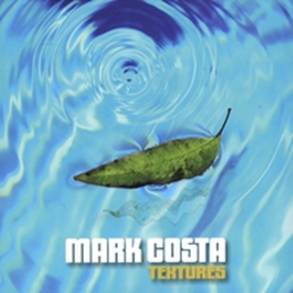 | Mark Costa - Textures (Independent)
|
Sydney bassist Mark Costa has put together a quintet of top-flight players for his debut CD of eight of his originals. Costa has undertaken study of the Schillinger system which he says has enabled him to find a new compositional voice. Joseph Schillinger (1895 – 1943) was a composer and teacher who evolved a system of composition related to mathematics and who advised such famous US composers as George Gershwin, Benny Goodman, and many others. Costa’s natural musical expertise is in the jazz/rock idiom, and these tracks cover a diverse range of tempos and interpretations. He has talented support from James Muller on guitar; Bill Risby, keyboards; Gordon Rytmeister, drums; and percussionist Tony Azzopardi. Muller is the standout here, his solos flying in precise passages of astute expression at a variety of speeds. Risby’s keyboard augments the front line well, and without him and Muller this collection would be less effective and more of a rock-oriented exercise. Stand and Deliver demonstrates this, with heavy drumming and rocky bass work considerably elevated by the guitar and keyboard contributions. A solo keyboard introduces Dedication, a slower piece for guitar and keyboards to investigate skilfully, but a heavy backbeat throughout seems misplaced. There is an interesting harmonic structure to Pendulum enabling Muller and Risby to play their most jazz-oriented improvisations and a piano and drums crescendo climax works well
   
|
by John McBeath
Previously published in the Australian |
| Back to Index |
| 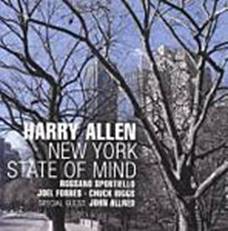 | Harry Allen - New York State of Mind (Challenge CR73293)
|
Blessed with a technique to rival Stan Getz, the nonchalant yet effortless swing of a Zoot Sims and a consummate command of melody, tenor saxophonist Harry Allen goes from strength to strength with each new album. Buoyed by an excellent rhythm section (pianist Rossano Sportiello, bassist Joel Forbes and drummer Chuck Riggs, with heavyweight trombonist John Allred added on six of the 11 tracks), Allen follows up the success of his first outing for Challenge Records (Hits By Brits) with one even better devoted to the many musical moods of New York with songs ranging from 1894 (Sidewalks of New York) to the 1970’s title track. It’s a musical journey with many highlights: his tenor adds another mood to the lovely ‘Harlem Nocturne’, covered by so many alto saxophonists over the years, and the elegantly rich balladry of ‘Autumn in New York’ to name but two. Not to be missed.
    
|
by Kevin Jones
Previously published in Limelight Nov 2010 |
| Back to Index |
| 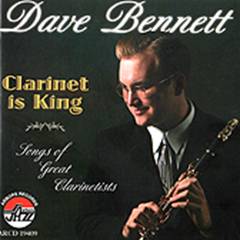 | Dave Bennett Quartet - Clarinet Is King (Arbors Jazz ARCD 19409)
|
Dominated by numbers associated with Benny Goodman and Artie Shaw,
this tribute to the “great” clarinettists is much more satisfying than the 26-year-old Dave Bennett’s previous album on the label (100 Years of Benny). As befits someone who makes rock swing, the Goodman-influenced Bennett likes to stretch the boundaries, always attempting to find something new. He inventively adds a creepy dimension to Shaw’s rarely played theme ‘Nightmare’, the outstanding track. ‘Stranger on the Shore’ is given a country feel with pianist Tad Weed recalling Floyd Cramer in his solo but for unrelenting excitement nothing matches the blazing tempo of ‘China Boy’. Recommended
   
|
by Kevin Jones
Previously published in Limelight Nov 2010 |
| Back to Index |
|  | Jose James and Jef Neve - For All We Know (Verve Music Group 00602527321493)
|
An album like this reaffirms your faith in good music. It shows that in an era dominated by the inanity of sub-pubescent “pop” and glitz, there is still room for quality. The sensitive and intimate duets by the American-born London-based singer and the prodigiously talented Belgian pianist are breathtakingly beautiful. Jef Neve’s stylishly subtle pianistics provide the perfect accompaniment as Jose James’s baritone tenderly massages such timeless ballads as ‘Embraceable You’, ‘Tenderly’ and ‘Lush Life’, and his a cappella beginning to ‘Body And Soul’ is stunning. And to think it was recorded in one six-hour session. Magnificent!
4 ½ stars
    
|
by Kevin Jones
Previously published in Limelight Nov 2010 |
| Back to Index |
| 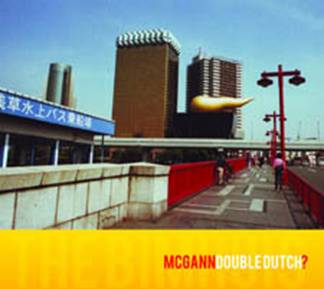 | Bernie McGann - Double Dutch? (Rufus Records RF103)
|
Captured at the esteemed Amsterdam jazz playhouse, the Bimhuis, this 2004 recording is perhaps the finest of McGann’s quartet. What makes this pianoless group distinctive is not only the dry raspy tone and wry invention of McGann but also the concentrated, accented and splashy cymbal beat displacements from drummer John Pochee in a style self created. McGann’s weeping high register against the pantomorphic harmonies of Lloyd Swanton on bass can be bizarrely sorrowful and exuberant simultaneously. Three originals along with works by Dexter Gordon, Duke Ellington and the rarely covered ballad ‘The Talk of the Town’ are spread over two discs
    
|
by Peter Wockner
Previously published in Limelight Nov 2010 |
| Back to Index |
| 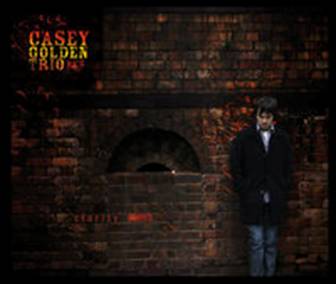 | Casey Golden Trio - Clarity (www.caseygolden.com.au SCRAMP001)
|
Casey Golden is another in the historically significant Barnard jazz lineage. This is his debut recording for a piano trio showcasing his own compositions plus his chiming and bouncy arrangement of Harold Arlen’s ‘If I only had a Brain’, stamping his own watermark on the under- appreciated tune. There are three similarly themed interludes which punctuate the 11 title agenda plus a brief piano solo bookending the disc. Clearly influenced by the more progressive euro piano trios, Golden’s tunes invite a truly ensemble approach to the trio and when the eggs are allowed to hatch they swing briskly and tightly in odd meters
  
|
by Peter Wockner
Previously published in Limelight Nov 2010 |
| Back to Index |
| 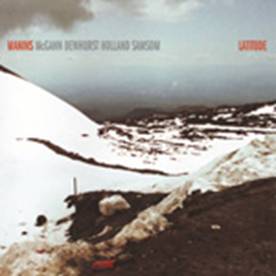 | Manins McGann Dewhurst Holland Samsom - Latitude (Rufus Records RF 096)
|
Three years after ‘Solar’, this live double album, recorded in Auckland with locals Olivier Holland on bass, Ron Samsom on drums and brilliant Sydney guitarist Carl Dewhurst swings vigorously on all 6 lengthy tracks and is a timely reminder of Dewhurst’s command in a more mainstream genre. Manins tenor is white hot and screamin especially on Monk’s ‘Well You Needn’t’ and his own ‘Blues for Marty White’. While McGann, invigorated by the energy of Manins, is content to delve deeper into recent and his now well documented repertoire ‘D Day’ based on Doris Day’s ‘Secret Love’ and Dexter Gordon’s ‘Fried Bananas’.
   
|
by Peter Wockner
Previously published in Limelight Nov 2010 |
| Back to Index |
|
Wangaratta Jazz Festival 2010 in Reviews
Wangaratta’s 2010 Wet n’ Wild
Jazz Festival
“Wangaratta Jazz Festival
has very few rivals anywhere in the world” – These were the words of Joe Chindamo
following his Saturday morning performance of the 2010 festival.
I usually travel by train
from Sydney to Wangaratta. Not only is it convenient but you also have the opportunity
to appreciate the natural basalt sculptures south of Goulburn, some of which resemble
noses that Picasso would have been proud of and others that resemble Whitleyesque
derrieres that immodestly litter the landscape. Moreover, at every stop along the
way, I was reminded how thankful I should be, while observing the seven or eight
bodies jostling off the train for a valuable three or four puffs, that I’m addicted
to jazz and not nicotine.
Recently turned 70, pianist
Mike Nock appropriately opened proceedings with his new quintet adding the mercurial
trumpet of Phil Slater and the slick tenor saxophone of Karl Laskowski to his already
established trio of the Waples brothers. Nock, as usual, provided the beautiful
variety of his compositional skills, always embellished by his trademark melodious
themes. From the ‘Messengers’ drive of ‘Hop Skip Jump’ to the burgeoning ‘Slow
News Day’ which soon provided scoop after scoop thanks to an exploding trumpet solo
by Phil Slater. ‘After Satie’ was an ensemble piece with fragments of the French
composer’s legacy evident while ‘Speak to the Golden Child’ introduced some funky
blues and Slater once again featured heavily. Following a rousing solo by Laskowski,
Slater pushed the concept to its outer limits of recognition while James Waples
preferred to concentrate the groove to his hi-hat only. ‘Choices’, a sectionalised
piece of composed and free-form, completed a marvellous opening set.
Undoubtedly one of the highlights
of the festival was alto saxophonist Oliver Lake and his Organ Quartet. Oliver Lake formed his Organ Quartet in 2005 featuring powerful trumpeter Russell Gunn, drummer
Jonathan Blake (who was replaced by the thunderous Chris Beck on this occasion)
and Jared Gold on a grinding rather than grooving Hammond B3 Organ. Performing
three sets across the festival plus a stunning solo recital in the Holy Trinity
Cathedral, Lake overwhelmed audiences with his very personal silvery torrents of
Pollock like splatter. Lake’s alto has a pure and clear tone even at times of high
register scrambling which he often explored. The energy of this quartet is monstrous,
creating vacuums and whirlpools of sound using original material and progressive
standards from the 1960’s. Trumpeter Russell Gunn is a powerhouse to match the
drums. Fortunately concerns based upon some of his previous commercially driven
material were put to rest. He pushed the boundaries of his existentialism with
fire and passion. Oliver Lake’s pre-scripted ‘Beat’ poetry offered a further insight
into the motivational activism of the artist, with pieces such as ‘What If’, ‘If
I Knew This’, ‘Bp Bop’ and ‘Post-It’ which include revealing aspects on his socio-political
views on lifestyle, poverty, injustice, art & consumerism alternately shooting
chapters of his solo saxophone and beat poetry into the lofts of the Cathedral using
the acoustics to spiritual effect. He lobbed, hurled & casted his sound waiting
for its return for further inspiration. Whether it was playing the horn into his
leg, playing the stem only or swinging the horn around the Cathedral’s altar, Lake
was clearly revelling in what this special environ had to offer.
Meanwhile the Johannes Luebbers
Dectet from Perth, entertained a large crowd in St. Patrick’s Hall with a cerebral
recital of original ensemble pieces clearly influenced by the past (Olivier Messiaen)
and the present (Maria Schneider).
On Saturday the piano trio
of Joe Chindamo, made up of part time tuba player Philip Rex on double bass, and
an unassuming Rajiv Jayaweera on drums, gave a consummate performance of four jazz
standards, two contemporary pieces by Paul Simon and Dolly Parton and his own APRA
award winning original ‘Something will Come to Light’. One only has to witness
how often Chindamo actually needs to look at the keyboard to realise how synthesized
he is with his instrument. His fleeting, caressing, never punishing and often tickling
style roused the audience. In the hands of Chindamo, Parton’s ‘Joeline’ was given
a level of sophistication and finesse the piece has rarely enjoyed before. He and
his trio rendered ‘Moon River’ with a sublime touch before sending it into a ‘Film
Noir’ imagery by paring away all the flesh of the melody leaving skeletal remains
at the end of the piece.
‘Behold, the Sower went forth
to Sow’ and so Paul Williamson played an intriguing series of movements at the Holy
Trinity Cathedral with an unusual instrumentation trio of trumpet, guitar and drums.
Bending notes in a celestial mood and sometimes wringing the sound out of his horn
like moisture from a wet towel in these hallowed surrounds.
Some of the most amazing music
of the festival was created by Stu Hunter’s ensemble and his ‘The Gathering’ Project.
Sounding hypothetically like an ideal soundtrack to a documentary on former Cuban
leader Fidel Castro, with its horn section spread across the stage and their jaunty
insistent rhythms complete with pork pie hats. This band is entirely made up of
leaders in their own right. Stu Hunter – piano/composer, James Greening – trombone/pocket
trumpet, Matt Keegan and Julien Wilson – tenor saxophones, Jonathan Zwartz – bass
and Simon Barker – drums/percussion. Hunter wrote’ The Gathering’ suite for the
2008 Jazz Now Festival and these textural compositions were matched only by the
supreme improvising and ensemble work from the artists. James Greenings trombone
solo was like an out of control whipping, snapping livewire. Simon Barker played
a major role in determining textural range, at times draping a sheet of cloth over
the kit, deadening the resonance, while Zwartz tapped his strings with the bow and
strained the ‘G’ string off the fret board to create the sound of a whining cat.
But it was the underlying intensity of the groove, beautifully balanced against
the intrigue of the soloists that brought the crowed to their feet. Unfortunately,
Hunter’s other project ‘The Muse’, later in St Patricks Hall, did not reach the
same euphoric heights due to an imbalance of sound levels.
Belgian pianist Jeff Neve
and his trio presented original compositions rooted firmly in the western classical
tradition with Bach flavoured themes often bubbling to the surface. Intensity was
sustained and gradually heightened through-out the performance commencing with a
Bulgarian lullaby-like waltz ‘Sophia’ and the subtle Asian inspired ‘She Came from
the East’ amongst others. Belgian drummer Teun Verbruggen utilised a scrunched
aluminium can and sampled effects from a sound device into a megaphone to add both
texture and variety. Neve created fascinating conversations both between his own
hands and with bassist Reuben Samama (based in New York).
The World According to James
is one of the tightest bands on the Australian scene. Greenings sound remains highly
contemporary on trombone and yet consistently references its history to stamp a
unique barnstorming sound unique to Greening alone. The group performed pieces
from their recent release ‘Lingua Franca’.
The Andrew Dickeson Quintet
opened day three with a tribute to Dame Joan Sutherland performing a hard swinging
‘Falling in Love with Love’. His ‘dream band’ included this year’s National Jazz
Award winner Eamon McNelis, who must have one of the fattest tones and dazzling
facilities on trumpet in Australia today. The New Zealand connection made up of
Roger Manins – tenor saxophone and Steve Barry – piano made this easily the most
exciting set of the festival for lovers of the 1950’s and 60’s hard bop style. Selections
included ‘Blues on the Corner’ and Dexter Gordon’s ‘Soy Kalifa’ when Dickeson discarded
the sticks and reached back to the African roots of the music with his hand drum
solo.
Greg Coffin and his trio performed
pieces from his Jazzgroove album ‘It’s Neither either or. It’s both and’ plus the
standard ‘Just in Time’ meanwhile at St Patrick’s Hall , veteran drummer Allan Browne
took his quintet to the stage to present music from his second Jazzhead album in
tribute to French poet Arthur Rimbaud featuring Eugene Ball trumpet, Phil Noy saxophones,
Geoff Hughes guitar and Nick Haywood on bass. The biographical mood ranged from
entrancing to pensive to disturbing to erratically charming marking a genius life
less than stable.
Dutch tenor saxophonist Yuri
Honing was last in Australia in 1998. His set commenced with an utterly euro-contemporary
coolness but soon warmed up with Milton Nascimento’s ‘Miracle of the Fishes’ and
his own ‘Romanian Folk Song’
The late legendary pianist
Serge Ermoll was remembered in tribute by trumpeter Warwick Alder who spritely delivered
renditions from his long awaited debut on Rufus Records ‘Brendance’. ‘Zing went
the Strings of my Heart’ provided John Harkins an opportunity at rev this 1934 pop
piece to overdrive.
Based in Japan for the last two years, Aaron Choulai toured his latest group ‘Sisia Natuna’. Influenced
by Ronny Ferella’s group ‘Ish Ish’ at a younger age, Choulai respected Ferella’s
beautiful melody ‘What Should Be’ with his trademark unassuming sensitivity.
ATM 15 is not a cash dispenser
but a Big Band dispensing big sounds led by Andrew Thomas Murray and an extremely
talented group of Melbourne based musicians including Darren Archer – piano, Shannon
Barnett – trombone, Carlo Barbaro – tenor saxophone and Cam McAlister – trumpet
amongst others. Theirs is a fresh, youthful approach to Big Band and they played
music from their new album on the Listen Hear label ‘Big Band Re-born’. Their soulful
grooves, original arrangements and exciting improvising ensured the Reid Street revellers were both highly entertained and sufficiently stimulated.
In 1958 Frank Sinatra was
43 years of age and arguably at the pinnacle of his vocal powers. Headlining this
year’s festival, Chicago vocalist Kurt Elling turns 43 in November 2010 and said
recently “I certainly feel like I’m in good voice”. I hadn’t witnessed Elling
live since a Basement performance in the late 1990’s, but I cannot recall his stage
mannerisms and gestures to be so reminiscent of Sinatra’s as they are today. Comparisons
should end there but nevertheless Elling remains the world’s most compelling jazz
vocalist of the last 15 years and a magnetic stage performer. His vocal abilities
resemble an Olympic gymnast performing multiple manoeuvres within a single routine.
He can be tender and gruff before a blink of your very eyes. His gushing stream
of consciousness on vocalese pieces such as ‘My Foolish Heart’ and ‘Body and Soul’
(built on a Dexter Gordon solo) were simply jaw dropping. He and his trio led by
Laurence Hobgood performed pieces from his Grammy Award winning album ‘Dedicated
to You’ and other favourites such as Nancy Wilson’s ‘Save your Love for Me’ and
‘Nature Boy’. Ulysses Owens’s work on the drum kit was both flashy and dazzling
especially his brush work solo but never groundbreaking while guest tenor saxophonist
Bob Shepherd played with assured command in support.
While the rain and cooler
temperatures may have dampened some outside performances, the inclemency failed
to dampen spirits with dancers and jazz fans intent on enjoying the local wine and
song. In the jazz haven of WPAC (out of the weather) a number of packed houses
proved once again the success of this major international Jazz Festival.
|
by Peter Wockner
|
| Back to Index |
|
The last weekend in October
is when dedicated jazz fans join the high-speed caravanserai on the Hume Freeway
to travel to the pretty Victorian city of Wangaratta. The leafy town is home to
the renowned Wangaratta Jazz Festival, in 2010 celebrating its 21st anniversary.
Many have been regularly attending for years. The summery mid-twenties weather
on Friday turned overcast by Saturday morning and pelting rain forced some of the
food and drink stalls throughout the town to close temporarily. Nevertheless the
program, perhaps a little lighter this year in terms of fresh overseas headliners,
went ahead. There were six different venues, plus a blues marquee, the free stage
in the main street, and events at four different wineries. Local shops and cafes
got into the spirit with jazz-inspired window displays, and special menus. The
Wangaratta Art Gallery ran its annual award arts exhibition with around seventy
works displayed. There were youth music workshops, and the hugely popular National
Jazz Awards open to musicians under the age of 35. As expected there was a huge
variety of music styles on offer: blues and roots, trad, mainstream, post-bop and
contemporary jazz from small and large groups, vocalists, and a dash of avant-garde,
but fewer experimental works than last year. There were over 200 Australian performers,
and around 40 international musicians.
It was fitting that the grand
old master of Australasian jazz, pianist, composer and bandleader Mike Nock, who
appeared in 1990 at the first Wang – as it’s known to all – should open the program
with his new quintet. Adding to Nock’s piano trio were Phil Slater’s deliberative
trumpet and talented saxophonist Karl Laskowski playing Nock’s illustrative compositions.
A piece entitled Choices made skilful use of unorthodox elements from free jazz,
without abandoning rhythm. A more contemporary term for the resurgence of 1960s
free jazz style would be, to borrow a term from biology: musical autogenesis, a
self-generating approach used extensively by US saxophonist Oliver Lake’s Organ Quartet. Lake’s group comprised trumpet, alto sax, B3 Hammond organ and drums
and throughout their interpretations of the leader’s compositions they used collective
improvisation extensively. Lake played advanced solos with a range of techniques
including alternate fingering sounds, high frequency flights, and reed clicks. But
the most impressive passages came when the front line duo turned everything on as
trumpet and alto duelled in flat out counterpoint.
Portuguese songstress, Sara
Serpa, now New York based, has attracted much attention; she not only looks superb
with a model’s features, she has an amazing vocal range. Her style is to sing wordlessly
as if an instrument, often in unison with the guitar. Her crystal-like tones floated
delicately from the stage with sensitive backing from her guitarist husband Andre
Matos plus Aaron Choulai’s piano trio. She sang lyrics to several Portuguese songs
and one in English: the Beatles’ Julia.
The award-winning composition
The Gathering by Sydney pianist Stu Hunter was performed by a luminary Australian
sextet led by Hunter. It’s a highly original piece of almost symphonic stature,
loaded with descriptive meaning, embodying climax and quietude. The playing was
virtuosic, with a memorable, hyper fast trombone solo from James Greening. The
luscious harmonies throughout Hunter’s work were especially noticeable in sequences
featuring deep, rich piano chords paired with Jonathan Zwartz’s bowed double bass.
Wangaratta’s landmark Holy
Trinity Cathedral is also a festival venue and its soaring ceiling and capacious
interior provided unusual acoustics for Melbourne trumpeter Paul Williamson’s trio.
They played one lengthy piece featuring unearthly trumpet, restrained drums and
Geoff Hughes’s guitar which rang with an almost religious intensity. There were
subdued elements of autogenesis and a naturalistic touch came when twitterings from
a nest of fledglings behind a stained glass window could be heard during quieter
passages.
By Sunday morning the temperature
dropped and the rain eased to showers turning the audience area at the open-sided
Blues Marquee into spongy mud. No matter, the popular twelve bar blues format delivered
by performers such as Diesel, Anni Piper, Ray Beadle, The Backsliders, and Dutch
Tilders had the crowd’s complete attention.
The festival headline star,
US vocalist Kurt Elling was reserved for the closing performance on Sunday night.
Elling appeared at Wangaratta in 1998 and has obviously gone from strength to strength
since. He sang some lesser known standards in his supremely professional style,
sounding at times like a combination of Frank Sinatra and Sammy Davis Jnr but with
an added high energy scat ability. It was a great performance involving comedy,
consummate musicianship and adept jazz phrasing at any tempo.
The National Jazz Award finalists
on trumpet also competed on Sunday night, with Eamon McNelis from Melbourne taking out first prize of $8,000. Second was Mathew Jodrell, Perth, and third place
went to Nick Garbett, Sydney. It was all over for another year, and as the festival
ended, with perfect timing, so did the rain.
|
by John McBeath
Previously published in the Australian Nov 2010 |
| Back to Index |
| 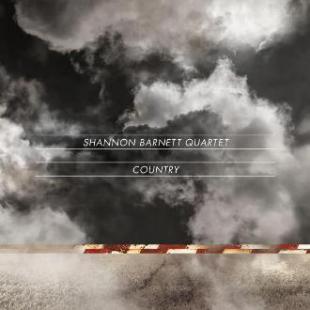 | Shannon Barnett Quartet - Country (Which Way Music/Fuse WWM009)
|
This debut CD from young Melbourne trombonist Shannon Barnett’s quartet features diverse compositions by the leader or her guitarist Nashua Lee, and one by the group’s drummer Ben Hendry. The compositions are melodic – but not simplistic – especially the alt country flavoured title track Country, where Lee salutes with originality the history of country guitar styles, and the trombone powers through a commanding solo unlike anything Slim Dusty ever dreamed of. Pathos (for pathological liars) lowers the tempo but lifts the harmonic complexity as the trombone emerges with moody tension over guitar chords and Christopher Hale’s luscious acoustic bass guitar. The bass guitar – more suited in this context than double or electric bass – features in a duet with a staccato trombone in the opening to ‘Sidelines’ which progresses to a steady medium-slow, soul-infused groove, closing with the theme interspersed with Hendry’s smart drumkit embellishments. A broken-rhythm trombone riff introduces ‘Rabid Hawk’, a piece where percussive punctuation is prominent throughout, while ‘Pesos (for pessimists)’ uses a subdued Latin beat and Barnett delivers an energetic solo of ceaselessly inventive ideas. She displays a technique of total control over her instrument, especially with tonal qualities, combined with a skilful soloing ability adaptable to many different styles and expressions. The quartet is well integrated and arranged, without trying to be cutting edge
   
|
by John McBeath
Previously published in the Australian Oct 2010 |
| Back to Index |
|  | Logic - The Hierarchy (Logic: www.logiconline.net LOG 004)
|
This fourth album from Melbourne quartet Logic follows their 2008 release Native Strut, using the same personnel except that Dane Alderson replaces Gavin Pearce on electric bass and guest trumpeter Dan Beasy appears on three tracks. Jazz-rock influences remain, with greater emphasis on the jazz component, and these high-quality compositions are again supplied by either guitarist Glenn Cannon or saxophonist Tim Wilson. A variety of time signatures has been used – often within the same song – from standard and waltz time through to more unusual meters like 5/4, 6/4, 7/4 and an esoteric passage in 10/16. The opening track Northgate features some fast and fluent unison work between Cannon’s nylon string guitar blending in striking tonality with Wilson’s soprano sax before several tempo changes and an exuberantly accelerated saxophone flight. Drummer Ben Vanderwal delivers a powerful extended solo against a jagged riff as a closer on ‘Broken’, while ‘Ella-gance’ is a quite slow and moody theme with its melody shared between soprano and flugelhorn who both solo profoundly over strong chordal guitar structures. Title track ‘The Hierarchy’ opens with some impressively fast bass against an insistently urging groove from the drumkit and later features an intelligent melody and counter-melody from soprano and guitar, this time with steel strings. Logic continue their uniquely talented explorations of highly original material and interpretations in an advanced approach to jazz-rock
   
|
by John McBeath
Previously published in the Australian Oct 2010 |
| Back to Index |
| 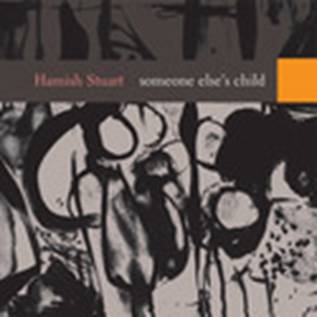 | Hamish Stuart - Someone Else’s child (Vitamin)
|
This debut solo album from renowned Sydney drummer Hamish Stuart has been a long time in the making with the title track featuring vocalists Tina Harrod and the late Jackie Orszaczky recorded in 2003. Stuart has assembled a coterie of world class Sydney musicians ranging from a piano trio up to a sextet plus the two vocalists to perform his original music. The style is sophisticated, interpretive and descriptively melodic in slow to medium tempos, some with a Latino injection aided by Aykho Akhrif’s congas. Stuart’s drumming is admired for his nuanced ensemble understanding, never pushing the drumkit unnecessarily to the fore, and always rhythmically distilling the essence of a composition. Together with pianist Chris Abrahams and long-term associate, bassist Dave Symes, Stuart’s trio works over a soul-infused/alt country piece, ‘You Folks’ where the drummer’s soft, deceptively simple-sounding brushwork is an indispensable component. Someone Else’s Child employs a Latin beat, opening with Matt Ottignon’s subdued tenor and two-part vocal harmonies leading into Scott Leisman’s refined guitar solo. With Stuart Hunter on piano and Phil Slater’s probing, declamatory trumpet, ‘When It All Comes Down’ is a searching, quintet piece with ghostly harmonies. Guitarist Ben Hauptmann and saxophonist Andrew Robson complete a quartet rendition of ‘Sense of Place’ imparting a mysterious atmosphere with skilful interplay between alto and guitar. This is an album of sensitive nostalgic introspection
   
|
by John McBeath
Previously published in the Australian Oct 2010
|
The Sydney based drummer/percussionist states that these original pieces are mere sketches and that the artists involved have engaged with spirit of the material. To this end Stuart has chosen his musicians wisely including Chris Abrahams on piano and Matthew Ottignon on tenor saxophone. When Abrahams touches a melody, the notes resonate like gentle ripples on a still pond expanding to encompass the shape of the group’s dynamic. The album has an air of understatement, never copiously exciting but often intoxicating. The melodies are simple and in some cases after repeated listening I found myself filling in the almost implied notes; a minimalist success story. Recorded over five years, the opening track allows Aykho Akhrif to lay down a conga groove leaving the leader to add texture. The end result is a hypnotic trance-like effect. “Sense of Place” encroaches on Bill Frisell territory with the addition of Scott Leisman on guitar while the title track protest song was written at the commencement of the Iraq War and includes some ethereal and elsewhere, droning vocal harmonies from Jackie Orszaczky and Tina Harrod. “When it all Comes Down” wanders freer with an explorative Phil Slater trumpet solo before the disc becomes darker with “Shempa” and “The Crossing”.
   
|
by Peter Wockner
Previously published in Limelight January 2011 |
| Back to Index |
|
 |  |
| Casey Golden Trio - Clarity (Scramption Records/Planet Company) |
Misinterprotato - The Gentle War (Jazzhead SCRAMP 001) |
   
|
   
|
Two high-quality Australian jazz piano trios have each released an album, the fifth from Brisbane’s Misinterprotato and a debut recording from Sydney’s Casey Golden Trio. The piano-leaders in each group have quite a lot in common: they’re both young; Sean Foran of Misinterprotato is 30 and Casey Golden is 22, both are music graduates majoring in jazz piano, and both have considerable overseas experience. Golden’s keyboard technique is energetic, assertive, inclined to repetitive chords in a mainstream style, while Foran is delicate, languid, and ceaselessly explorative using classical influences.
Foran’s ‘Chase’ maintains tension using a scurrying piano, jumpy bass and travelling drum work from John Parker, whereas Time, by Misinterprotato bassist Pat Marchisella uses a variety of out of tempo cymbal and triangle strikes to convey its title idea with minimalist piano appearing only briefly. The Brisbane group’s drummer, John Parker wrote three of the originals including ‘Cute’ with its jagged piano line supported by snare drumming, alternating with swinging passages over a strong bass
Opening with ‘Ready Ready Ready’ Casey Golden strides solidly into a two-minute introduction piece with forceful drumming in a strong groove from Rob Turner. A slower piece,’ Waiting’ features a satisfying harmonic structure which Brendan Clark’s bass steps through with finesse as Golden’s piano lays out the chords. ‘All My Shirts Have Heroes On Them’ begins sounding like a solo piano exercise piece, then as drums and bass appear moves into a melodic improvisation sequence before concluding – after a four bar silence – with a dragged out stomp of piano chords. The only non-original in the Golden collection, Harold Arlen’s ‘If I Only Had A Brain’ moves quickly through a tuneful piano solo and a more complex one on bass
Both of these albums contain interesting, and well-played compositions. Foran’s cover a wider descriptive spectrum employing more diverse ideas and textures, while Golden relies on a more traditional approach
|
by John McBeath
Previously published in the Australian Oct 2010 |
| Back to Index |
| 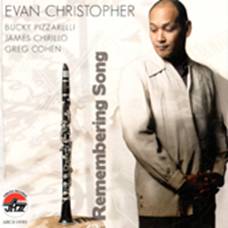 | Evan Christopher - The Remembering Song (Arbors ARCD 19383)
|
If his previous album (Delta Bound with pianist Dick Hyman) was about leaving New Orleans in 2005, this one is about being back in his adopted hometown, a loving tribute by the liquid-toned clarinettist. There are moments of sheer beauty in this mixture of originals and songs from early last century such as ‘Dear Old Southland’ with the verse and tango section restored from the original sheet music. The backing; two guitarists, Bucky Pizzarelli (acoustic) and James Chirillo (electric), and bassist Greg Cohen couldn’t be better. Neither could the ending with Christopher whistling a slowly fading title track.
    
|
by Kevin Jones
Previously published in Limelight Oct 2010 |
| Back to Index |
|  | Humphrey Lyttelton - 1959 (Lake LACD282)
|
The date marked the end of a two-year transition from traditional jazz to a mainstream band for the English trumpeter. It was an outstanding group with fine instrumentalists and arrangers and a five-piece front line which gave it a big sound which belied its size. The Ellington-inspired swinger ‘Finger Snapper’ summed up its musical philosophy. There were two exceptional soloists, reed player Tony Coe, listen to his Hodges-inspired alto on ‘Swallowing The Blues’, and a lyrical but swinging baritone saxophonist in Joe Temperley. If Kansas City-styled combo jazz is your bag don’t miss this! The big band tracks are an enjoyable added bonus
   
|
by Kevin Jones
Previously published in Limelight Oct 2010 |
| Back to Index |
| 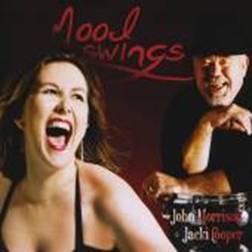 | John Morrison and Jacki Cooper - Mood Swings (JCJM001 (john@swingcity.com.au))
|
Inspired by hanging out in New York with veteran pianist, vocalist and composer Bob Dorough, this album by one of Australia’s most respected drummers and his singer/wife is full of surprises; a mixture of the familiar: ‘Honeysuckle Rose’; the unexpected: (the dreamy wordless vocal on ‘Echoes Of Ellington’ (In A Sentimental Mood); the unusual: the ballad treatment Buddy Holly’s 1950’s hit ‘Everyday’; and the highlight, Cooper’s slow but sensual award-winning original ‘Play Me’. Two of Sydney’s finest young talents, pianist Tim Fisher and bassist Karl Dunnicliff, shine as the settings change, guided by Morrison’s exemplary drumming.
   
|
by Kevin Jones
Previously published in Limelight Oct 2010 |
| Back to Index |
|
 |
Anat Cohen - Clarinetwork Live At The Village Vanguard(Anzic Records ANZ 1203)
|
Claims that Israeli-born Anat Cohen, who on June 14 2010 won the Jazz Journalists Association clarinet award for the fourth successive year, has pushed the instrument to the forefront of jazz are not exaggerated. She is the clarinettist to watch. Listening to Ken Peplowski, one of 2010’s five nominations for the award, inspired the multi-talented reed player to return to an instrument which she first began studying at the age of 12. (She is also a first-class tenor and soprano saxophonist). As exciting to listen to on disc as she must be live, Cohen has a fresh and personable style, is a fluid and nimble improviser with a full-bodied tone which can be either elegantly expressive (listen to Body And Soul) or exciting (After You’ve Gone). The New York-based Israeli is a regular at the city’s most famous jazz club, the Village Vanguard, where last year she celebrated the centenary of the birth of her early idol with a show billed “Benny Goodman and Beyond”. Backed by a sizzling rhythm section of pianist Benny Green, bassist Peter Washington and drummer Lewis Nash, she revitalises Goodman chestnuts by using the master as a starting point before giving them a contemporary edge.
    
|
by Kevin Jones
Previously published in Limelight Sept 2010 |
| Back to Index |
| 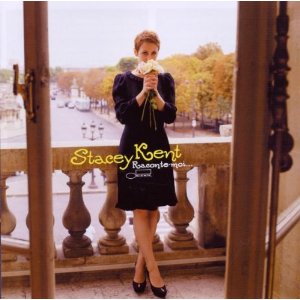 | Stacey Kent - Raconte-moi (Blue Note 5 099962 68239)
|
American-born Stacey Kent is arguably the most popular jazz singer in Europe, especially in France where her albums make the pop charts. Her status should be elevated further with this lovely collection of low-key songs sung in French. It may be another language but Kent captures and interprets the meaning of the lyrics of the timeless, It Might As Well Be Spring (C’est le Printemps) and Mon Amour, and the new, Raconte-Moi, written especially for her. The mood is sophisticated yet delicate, the result of the sublime musical chemistry by her intimate, jazz-inflected stylings and the best elements of the smokey tenor of her husband Jim Tomlinson. Musical Poetry!
   
|
by Kevin Jones
Previously published in Limelight Sept 2010 |
| Back to Index |
|  | The Subterraneans – A (Jazzgroove JGR 056)
|
Saxophonist, leader and principal composer James Ryan describes this as ‘rock-jazz’. It’s simultaneously heavy and agile and it’s likely to lead younger generations to jazz. The influences are as diverse as Caribbean dub, Jimi Hendrix or the curious tweets that a mobile phone gives when in the vicinity of other electrical equipment. What is constant however is the earthly tremors these grooves produce thanks to electric bassist Steve Hunter and drummer James Hauptmann whipped up by the lashing virtuosity of guitarist James Muller. The Subterraneans will almost certainly demand a re-think of how many considered the music once called ‘fusion’.
   
|
by Peter Wockner
Previously published in Limelight Sept 2010 |
| Back to Index |
|  | Medeski Martin & Wood – Radiolarians (Indirecto Records LISN82043)
|
Trying to be all encompassing to all corners of the market is fraught with danger. This double disc set is a compilation taken from the three Radiolarian volumes recorded in 2008. The resulting perception is almost like scanning an entire radio spectrum such is its breadth of diversity. What started as a piano trio jam band 18 years ago has seemingly become a showcase for cross cultural pop. The musicianship cannot be disputed nor the attractive and sometimes throbbing pulses but some motifs and dare I say it, melodies can be bland and laboured at best; in the end, aimless.
  
|
by Peter Wockner
Previously published in Limelight Sept 2010 |
| Back to Index |
| 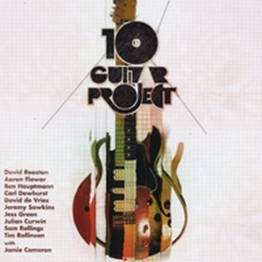 | David Reaston - 10 Guitar Project (www.davidreaston.com)
|
This is Sydney’s finest and only guitar dectet and it’s recorded here with the drummer Jamie Cameron. The orchestration of the leader David Reaston encompasses moments of metal chaos, lucid telepathy and fluid swing. The sheer weight of the task at hand is best aurally presented during improvised pieces such as ‘Brew’ based on the process of making a cup of tea and ‘Guitarstrophe’ where all minds are at play and seemingly meet at the most unlikely of places. The disc then falls back into grooves which allow for more conventional individual soloing by artists such as Jeremy Sawkins & David de Vries.
   
|
by Peter Wockner
Previously published in Limelight Sept 2010 |
| Back to Index |
|
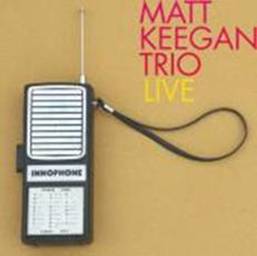 |
Matt Keegan Trio - Live (Chillum Records)
|
Matt Keegan’s saxophone-led Sydney trio sounds like a larger group, partly due to Keegan’s usage of electronic effects and partly because of Dave Goodman’s comprehensively energetic drumming. Toplepsey is an example: after Cameron Undy’s solo electric bass intro, slowly stepping moodily downwards, Keegan arrives with a double tracked sax theme against shifting, speeding drums. The opening track, Ambiguous begins with solo sax and multiple effects in a slow-tempo mystical melody, soon joined by bass and drums in a heady rush of quadrupled time behind a continuously undistracted, languorous saxophone. A bluesy theme permeates Half Full over a hefty groove from bass and drums, while a more post-bop style blues at a faster tempo occupies Blues Accoutrements, notable for its accelerated sax runs and a knock-down-drag-out drum solo. Another sinewy bass solo opens Ins with smartly fingered embellishments, settling into a strong, rhythmic theme for Keegan’s sax plus effects to busily investigate as hyperactive drums hurtle and scurry. The bass is given effective wah-wah treatment for an intro to Blood Let where again a slower theme from the sax rides over doubled time, something of a trademark in this collection. In these originals the saxophone trio moves into another dimension where, with talented players and clever use of electronics, broader textures and multi-phonics are used to good effect.
   
|
by John McBeath.
Previously published in The Australian September 2010 |
|
Back to Index
|
|
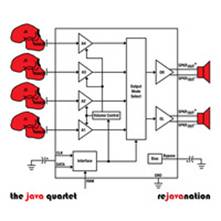 |
Java Quartet - Rejavanation (Vitamin Records)
|
After a series of five acoustic jazz albums, composer/bassist, Michael Galeazzi has departed from tradition. Think ‘re-use, recycle and return’. Most of these pieces are re-adaptations from the best of Java using contemporary modes such as trance, dub, euro-trash, drum n bass etc. Guests include saxophonist Richard Maegraith on the dark moody ‘Nursery Crimes’, vocalist Linda Janssen singing what could easily be a pop charting ‘Only You’ and Bobby Singh on two Indian influenced tracks. The greatest interest for me lay in what I call a melodious computer virus or the electronic ‘glitch translation’. A quirky reminder of an impressive back catalogue
   
|
by Peter Wockner
Previously published in Limelight Oct 2010
|
This sixth album from Sydney’s Java Quartet over 15 years introduces a new musical palette for the Sydney group led by bassist Michael Galeazzi who composed these seven tracks. Described as “an eclectic romp through digital beats,” the music incorporates aspects of hip-hop, electro-jazz, drum ‘n’ bass beats, Hindustani music, and serious jazz improvisation; it’s an adventurous collection of new, remixed and re-invented material. The idea is to weave the band’s acoustic improvisers – pianist Greg Coffin, drummer Mike Quigley and Mathew Ottignon on saxophone – into digital soundscapes. No doubt some of their younger audience members will find plenty here to enjoy. All tracks have short explanatory labels appended. Yeah Man (boom bap) brings Bobby Singh on tablas and Adrian McNeil’s sarod to the fore against digital beats, hip-hop and sampling, a combination that might be an acquired taste. Only You (nu soul) features vocalist Linda Janssen delivering a pleasant sounding ballad with a fine solo from Ottignon and a repetitive hip-hop beat throughout. A murky opening to an out-of-tempo Nursery Crimes (ambient dub) leads to some mystical saxophone from guest Richard Maegraith and atmospheric piano passages. Influences from Indian music and digital effects from rock and hip-hop are being increasingly heard in jazz groups, but it remains to be seen whether Java’s established fan base will enjoy this latest release.
   
|
by John McBeath.
Previously published in The Australian September 2010
|
|
Back to Index
|
|
Tokyo Jazz Festival 2010 - Tokyo International Forum, Sept 3 – 5th
Big enough to accommodate a five-storey building, the Tokyo International Forum, comfortably seats 5,000. The immense auditorium was an air-conditioned refuge from the daily mid-thirties temperature and high humidity outside. There were billboard-sized screens each side of the stage and subtle backdrop lighting drifted in pleasing pastel colours and oriental designs. On Friday’s opening night the massive sound system played a recorded introduction with the force and dynamic quality of a live symphony.
On the previous evening the Australian embassy, a festival sponsor, launched a smaller introduction concert as part of its cultural relations program. This featured Sydney group The Mike Nock Trio, and Nock’s Tokyo Big Small Band, adding trumpeter Phil Slater and saxophonist Matt Ottignon plus Japanese musicians Ken Ota on alto sax and trombonist Eijiro Nakagawa. The septet played arrangements of Nock originals demonstrating the universality of the jazz idiom where players without a common language can play cohesive music. Everyone soloed on Nock’s funky tribute to US flautist Jeremy Steig who was in the audience, and the piece worked well, as it did again on Saturday, pleasing the casual crowd in the Forum’s enormous courtyard.
Although Australian jazz is not widely known in Japan, there is a large general jazz following with the first Tokyo Jazz Festival occurring in 2002 but without Australian participation. Since 2006 the Australian embassy has been promoting Australian jazz and musicians at the festival, planning eventually for performances by Japanese players in Australia. The highly committed staff of the embassy's Cultural Relations program work to introduce many aspects of Australian culture to the Japanese and at this festival, in addition to the music there were opportunities to sample Australian wines and food at a well-attended marquee in the open courtyard of The Forum. Music from the stage in the courtyard was free and relayed over several huge screens where a total of 12,000 fans attended over three days. Paid indoor tickets totalled 14,000, and there were more than twenty Japanese business sponsors.
On Friday one of the opening acts was US trumpeter Christian Scott’s impressive quintet in a Future Shapes of Jazz session but with the unexpected addition of Kazunori Kumagai a male tap dancer. He tapped along with muscular energy in front of the band presenting an amazing visual spectacle, but not adding greatly to the music, except for a sequence where Japanese tap-dog and US drummer executed four bar exchanges. Next was a trio of older US jazz icons: pianist Kenny Barron, Ron Carter on bass and drummer Lenny White. They played a set of standards in beautifully integrated mainstream style with 73-year-old Carter’s bass work as impressive as ever with sliding chords and speedy passages. Barron’s piano was fast and crisp, often using quick runs reminiscent of Art Tatum, and playing a movingly lyrical version of Monk’s Round Midnight.
Opening day two in the morning was US group Chris Minh Doky and The Nomads with the leader on bass, and featuring the spectacular guitarist Dean Brown, composer George Whitty on keyboards, and drummer Tom Brechtlein. Their music was a high energy, sophisticated jazz/rock, full of European influences from Minh Doky’s Danish origins. Then came the 100 member NHK (equivalent of Australia’s ABC) Orchestra conducted by Damon Gupton to play a Broadway show style overture introducing US bassist Marcus Miller’s funky quintet. Miller is an accomplished electric bassist, and the orchestra supplied a subdued backdrop but the prevalent heavy backbeat from the jazz drummer became repetitive. Miller brought on US vocalist Roberta Flack – now aged 73 – for one song, Prelude to a Kiss, also given the funky treatment with Flack injecting a hip-hop chorus that seemed out of character with the ballad’s mood. She performed better that evening with her quintet and three back-up singers, opening of course with her 1974 hit Killing Me Softly. Also on Saturday evening was local vocalist Toku who was welcomed effusively by the audience. He sang ballads in English in an expressive, Kurt Elling style with solo piano accompaniment and played impressively on flugelhorn. There’s a tradition for Japanese musicians to also entertain with ad-libbed repartee and Toku and pianist obliged, trading dialogue which, judging by audience reactions, must have included comedy.
Sunday morning was devoted to Women in Jazz beginning with a young Japanese alto saxophonist Erena Terakubo with a technique of stunning virtuosity. Backed by a piano trio Erena poured out cascades of notes during a few jazz standards, and the ballad My Foolish Heart. It was an extraordinary performance where technique exceeded expression, but perhaps experience will bring more depth. A larger women’s group, The Mosaic Project was led by US drummer Terri Lyne Carrington and featured bassist/vocalist Esperanza Spalding who sang an inspiring version of Crayola. Sunday night’s standout performance came from Joshua Redman’s saxophone trio playing mostly originals from his CD Compass, notably Identity Thief interpreted in three different tempos.
In a huge international program there were performers from the USA, France, Italy, Poland, Norway, Holland, Brazil and Australia as well as Japan highlighting, with a few exceptions, mainstream jazz, electro funk and rock fusion. The finale came from local guitar hero Kazumi Watanabe leading an all-star group through a variety of jazz/rock arrangements.
The Mike Nock Trio wound up their appearances in Japan with an Australian embassy sponsored concert at Tokyo’s foremost jazz venue, the Shinjuku Pit Inn. There was a small, but appreciative audience – it’s a tiny establishment – as the trio expertly worked their way through several Nock originals and a few standards.
John McBeath traveled courtesy of the Australia-Japan Foundation, DFAT.
|
by John McBeath.
Previously published in The Australian September 2010 |
|
Back to Index
|
|
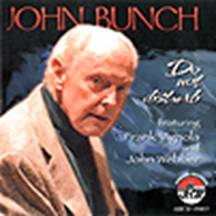 |
John Bunch - Do Not Disturb (Arbors ARCD 19403)
|
This 2009 session is a fitting finale to the distinguished career of pianist John Bunch who was Tony Bennett’s musical director for five years and a sideman with Benny Goodman, Woody Herman, Buddy Rich and Gene Krupa. He died in March 2010 at the age of 88. His innate sense of swing, complete command of the keyboard and impeccable taste shine as, with guitarist Frank Vignola and bassist John Webber, he explores bop and popular standards and little known Ellingtonia. Dave Brubeck’s ‘In Your Sweet Way’ shows why he was so aptly named the Fred Astaire of the jazz piano.
   
|
by Kevin Jones.
Previously published in Limelight August 2010 |
|
Back to Index
|
|
 |
Jackie Ryan - Doozy (OpenArt OA 07262)
|
The San Francisco based Jackie Ryan has never sounded better than on this two-CD set recorded on both the West Coast (Hollywood) and the east (New Jersey), a mixture of classic standards, jazz compositions and Brazilian music. And what a voice! Far ranging over three octaves with authority (such as Benny Carter’s title track; she wrote the lyrics) and feeling (Caminhos Cruzados). Her first-class backing includes pianist Cyrus Chestnut, tenorist Eric Alexander, trumpeter Jeremy Pelt and guitarist Romero Lubambo. This is jazz singing at its very best by a remarkable vocalist, one of the finest of the current crop.
    
|
by Kevin Jones.
Previously published in Limelight August 2010 |
|
Back to Index
|
|
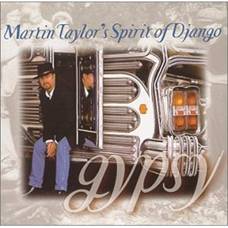 |
Martin Taylor’s Spirit of Django - Last Train to Hauteville (The Guitar Label (P3 Music P3MCD023))
|
There is a timeless and infectious charm about gypsy jazz especially by a guitarist as polished and classy as Martin Taylor who last year re-formed his popular and award winning group of 15 years ago to mark the centenary of the birth of his idol, the Belgian legend Django Reinhardt. With a front line of clarinettist Alan Barnes and the exceptional accordionist Jack Emblow, the group retains Django’s spirit in updating the classic French idiom where Charles Trenet’s classic ‘La Mer’ dovetails smoothly into the mix of Gallic songs and Taylor’s toe-tapping originals. Easy on the ear, this is happy music.
   
|
by Kevin Jones.
Previously published in Limelight August 2010 |
|
Back to Index
|
|
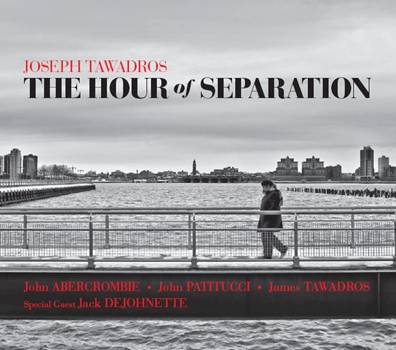 |
Joseph Tawadros - The Hour of Separation
|
A standout recording of 2010, Tawadros, an oud virtuoso, has chosen some NYC gravitas to elevate his music to new heights, while remaining in total command of his vision to coalesce the 5000 year old sound of the oud with 21st century sound of jazz. There is no doubting the oud is in the foreground, zithering melodies that balance between traditional Egyptian folk and modern middle- eastern music and adding harmonic impetus during John Abercrombie’s guitar solos. Abercrombie’s middle- eastern credentials stretch back to at least his 2003 ECM release Dansir. These pieces shift from beautifully poised tension to upbeat turbo-charged gear shifts. All but two are composed by Tawadros save a percussive groove between brother James and Jack DeJohnette, and a seemingly spontaneous improvisation with Abercrombie’s middle- eastern scales and the addition of DeJohnette’s brushes against cymbals. The bedrock behind much of the disc’s danceable propulsion is John Patitucci’s eclectic double bass.
    
|
by Peter Wockner.
Previously published in Limelight August 2010 |
|
Back to Index
|
|
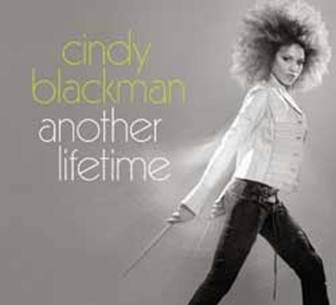 |
Cindy Blackman - Another Lifetime (Four Quarters Entertainment FQT CD 1820)
|
There’s no denying Blackmans’ a formidable exponent on the drums and hearing the subtleties of mentor Tony Williams in her playing is a treat. This tribute album was recorded over a number of sessions but mainly in 2007 with an ever present Mike Stern on guitar, but Blackman raises the bar in the powerhouse stakes. Some of the vocal inclusions add more curiosity than merit, such as the ‘phoned in’ voice over ramming home ’40 years of innovation’ and elsewhere the lyric ‘I love you more when you’re spiteful’. The duo with the throaty gargling tenor of Joe Lovano is an artistic highlight.
   
|
by Peter Wockner.
Previously published in Limelight August 2010 |
|
Back to Index
|
|
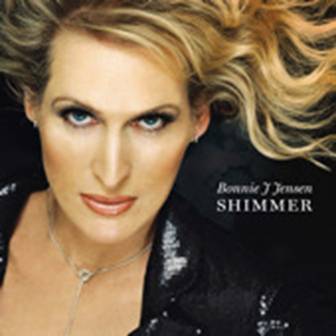 |
Bonnie J Jensen - Shimmer (www.bonniejjensen.com)
|
Contemporary tunes, American songbook, jazz standards and three compelling originals adorn Jensen’s fourth album. The opener, an original ‘Spend a Little Time with Me’ reminded me of how Patricia Barber crafts and delivers a dynamic, storytelling lyric. An impeccable choice of material and musicians including James Muller, Matt McMahon & Graham Jesse complement Jensen’s versatility as a subtle vocal stylist. She un-tethers her sidemen on Stevie Wonder’s ‘Higher Ground’ while rising to the occasion herself on Toots Thieleman’s challenging ‘Bluesette’. Jensen’s conviction on Mose Allison’s blues protest ‘Everybody’s Crying Mercy’ is matched by her funk on Sting’s ‘If You Love Somebody’.
   
|
by Peter Wockner.
Previously published in Limelight August 2010 |
|
Back to Index
|
|
 |
Jex Saarelaht Quartet - Five Ways (Jazzhead)
|
This debut recording of Jex Saarelaht’s masterly quartet comes after the Melbourne pianist/composer’s nearly thirty years of impressive performances with a diverse range of top-flight Australian and international musicians. The album is from a concert in Melbourne’s Stonnington Jazz Festival of 2009 showcasing Saarelaht’s intricate and absorbing compositions. Julien Wilson on tenor sax is a perfect choice for these interpretations, as is multi award-winning Sydney bassist Jonathan Zwartz. Long term associate Niko Schäuble on drums contributes rhythmic and transcendent understanding. There are echoes here of classically influenced, Eurojazz stylings, especially in the restrained out of rhythm piano intros to several pieces including the opener, Threeways. Here Saarelaht moves subtly into a down-tempo beat to welcome the tenor’s plaintive theme statement. Gradually the groove builds throughout the opening track, as the piano solo expertly injects vibrancy into a languorous mood before Wilson’s breathtaking tenor cameo of profoundly moving expression leads to an equally explorative and sensitive bass solo. Five-nineteen has some fine soul piano and a lift-off from Wilson’s tenor using occasional rasps, high frequency leaps and fast unorthodox runs culminating in a muscular, intelligent break-out on drums. The fastest rhythms are evident in Pepperman, with its cracking drum solo intro, post-bop theme, and Wilson’s astounding foray into the upper register. Julien Wilson has rarely sounded better, a deserving tribute to the originality of Saarelaht’s works.
    
|
by John McBeath.
Previously published in The Australian August 2010 |
|
Back to Index
|
|
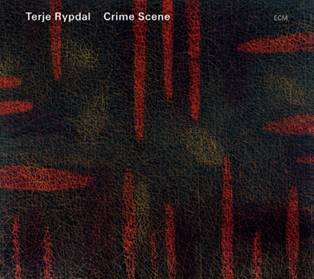 |
Terje Rypdal and Bergen Big Band - Crime Scene (ECM/Fuse Music)
|
Guitarist Terje Rypdal has been an important member of the Norwegian jazz community since he moved from rock to the jazz scene in 1968. Since then he has appeared on scores of recordings as band member, leader, and composer. This latest album features his quartet, with long-term associate trumpeter Palle Mikkelborg, Ståle Storløkken on Hammond organ and drummer Paolo Vinaccia fronting the Bergen Big Band in a concept collection of fourteen ‘episodes.’ Crime Scene is a non-visual soundtrack, a musical noir detective mystery using sampled dialogue and effects from films. Tracks have appropriate names such as: Suspicious Behaviour, Investigation and finally Crime Solved. While it’s possible to listen to this suite solely as a musical work without narrative – and there is a good deal of interesting music here in both solo and ensemble contexts – the sampled voices and effects then become intrusions. A large dose of creative imagination is necessary to formulate a crime story from this pastiche of music and samplings. Cutting edge abstractions from the big band, as in Prime Suspects, often segue into heavy rock with shrieking guitar and howling Hammond. Mikkelborg’s trumpet is always engrossing, sometimes reminiscent of the electric Miles Davis, but overall this album is a comprehensive soundtrack in search of an appropriately dark and cryptic cinematic production.
  
|
by John McBeath.
Previously published in The Australian August 2010 |
|
Back to Index
|
|
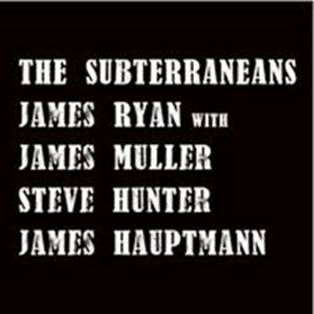 |
The Subterraneans (Jazzgroove)
|
Jazz-Rock-Fusion first appeared in the late 1960’s when contemporary jazz forms – bebop, hard bop, modal and free jazz – seemed played out and rock was established as the ascendant idiom. Several jazz groups – especially on Miles Davis’s 1969 recording Bitches Brew – combined rock rhythms and bass riffs with electric instruments. Saxophonist and composer James Ryan’s Sydney quartet The Subterraneans explores the jazz-rock genre and brings it off brilliantly mostly because of the sheer ability and understanding of the players plus the strength of these originals. Guitarist James Muller has an outstanding international reputation, while electric bassist and composer Steve Hunter has had over 100 of his compositions recorded. Drummer James Hauptmann brought a powerful rhythmic basis to Ryan’s previous two albums, and has appeared with a virtual who’s who of Australian jazz performers. Opening track The Rush begins with a familiar riff from Jimmy Hendrix’s Foxy Lady, quickly building an over-riding Thelonious Monk style theme for Ryan’s tenor to rocket off with, followed by Muller’s astounding wailing guitar. Effects from Bob Marley, Led Zeppelin and others are utilised inventively but the album is no mere exercise in sampling, it’s a highly original collection amalgamating rock influences into contemporary jazz expression. The title track travels at breakneck speed with drums and Hunter’s bass racing beneath the astonishing rapidity of cascading outpourings from tenor and guitar.
   
|
by John McBeath.
Previously published in The Australian August 2010 |
|
Back to Index
|
|
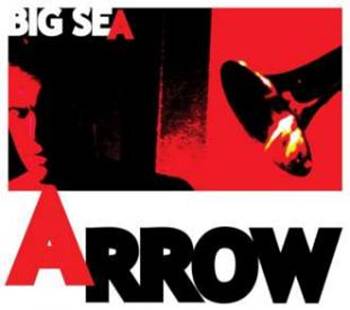 |
Arrow - Big Sea (Jazzgroove)
|
Drummer and composer Paul Derricott leads Arrow, his Sydney quintet of graduates from the Sydney Conservatorium, aged in their late twenties. All are strong jazz players in an interesting instrumentation using vibes and trumpet in front of a piano trio. An innovative debut album, Derricott’s originals are characterised by an improvised approach to thematic music. The melodies draw extensively on pop/rock ideas – but without a rock beat – and are given added authority and impetus by the arrangements and abilities of the musicians. Triple Oh, the opener, begins with drums and Dale Gorfinkel’s muted vibes establishing a clickety-clack, walking groove along with Mike Majkowski’s bass. Hugh Barrett’s piano poses a riff for Simon Ferenci’s trumpet to state the theme, upping the tempo slightly to return to the piano for a strengthening solo as the rhythm shifts up another gear and vibes emerge with a variety of unorthodox sounds. The track concludes with a muscular drumming sequence ushering everyone in for the final theme. The title track opens in a trumpet led, highly melodic ballad style and features a beautifully flowing piano passage, while Big Sea Reprise concentrates more on some involving piano work over a pushing rhythm before the trumpet arrives calmly at first, then building a powerful climax. These are outstanding and varied compositions, intelligently played; a demonstration of how pop influences can be fused into valuable jazz interpretations.
   
|
by John McBeath.
Previously published in The Australian August 2010 |
|
Back to Index
|
|
 |
Aaron Flower’s BAZ - Lady From Toulouse (Jazzgroove Records JGR 054)
|
Pounding rhythms from James Hauptmann and Flower’s grinding guitar overlay captivatingly simple melodies with strong but sometimes forlorn themes that owe as much to AC/DC as to Bill Frisell but with Flower’s undeniably unassuming originality. Saxophonist Karl Laskowski plays another beautifully restrained role complementing Flower’s ‘less is more’ approach, while the cello of Oliver Miller brings some chamber like sophisticated sedation to the appropriately titled ‘Dark Ballad’. Mix with that some lively blues coloured by lapslide guitarist Ben Romalis and Zoe Hauptmann’s laid back electric bass and you have the ideal disc for a leisurely warm Sunday afternoon.
   
|
by Peter Wockner.
Previously published in Limelight July 2010 |
|
Back to Index
|
|
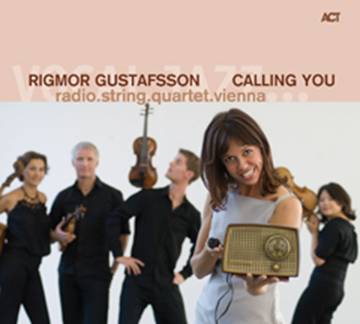 |
Rigmor Gustafsson and Radio String Quartet Vienna - Calling You (9722-2 ACT)
|
Some jazz singers aspire to record with stringed accompaniment but there’s another league when the singer interacts with a string quartet as if it were both a horn frontline and a rhythm section. Thanks to the arrangements of Bernie Mallinger, and Johannes Dickbauer and Gustafsson’s natural intuition these favourite tunes from the pop and jazz world take on intensely dramatic formations. With a tone similar to Tierney Sutton and phrasing at times reminiscent of early Betty Carter, Gustafsson brings a new poignancy to Hal David and Paul Simon lyrics. ‘I Just Don’t Know What to do with Myself’ characterises utter devastation while Gustafsson sings ‘Close to You’ as if she was penning her thoughts in a love letter against a background of tremulous strings. There is no need for flashy ornamentation but unison scatting with violin on ‘Makin Whoopee’ rivals the artistic heights of Mingus’s folkloric “The Dry Cleaner from Des Moines’ where angry high pitched violins put you deliriously into the impulsive centre of the Las Vegas strip. The euphoric climax however, is saved for the traditional Swedish folk song ‘Dear Old Stockholm’ sung in native tongue before, soaring into a type of operatic celestial yoik matched by ecstatic violins.
   
|
by Peter Wockner.
Previously published in Limelight July 2010 |
|
Back to Index
|
|
 |
Listen/Hear Collective - Presence motion
|
It’s not just the mining industry that’s on the boil in WA, the music industry is also flourishing, especially in the jazz genre. Three of the four musicians in _motion gained a Bachelor of Music at the WA Academy of Performing Arts before moving to Melbourne. Long-time friends saxophonist Andrew Brooks and pianist Berish Bilander formed this group to explore their interests in jazz, progressive rock, 20th century classical, and ambient music. Bassist Nick Abbey and drummer Hugh Harvey (B. Mus Adelaide Uni) round out the quartet. Much of this original album has a tone of cool tranquility, underpinned by contemporary jazz perceptions. The title track however is in a more rhythmic post-bop mode with Bilander’s piano theme statement and consequent excitement-stoking breakout. Brooks’s alto solo on ‘Presence’ at first halves the time against lively drumming, then takes off at full speed revealing echoes of Paul Desmond. ‘I Heard It Before Part II’ features wordless vocals from guest Gian Slater in a ballad style with a steadily climbing harmonic structure while ‘Missing’ has Brooks on soprano sax floating serenely in front of out of tempo bass, percussive effects, and a classical-style piano. Guest guitarist Brett Thompson joins the group on ‘Pendulum’ to introduce some rock style sounds into a pulsing esoteric mix, highlighting the diversity, capability and imagination of this debut CD
   
|
by John McBeath.
Previously published in The Australian July 2010 |
|
Back to Index
|
|
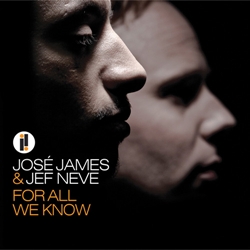 |
José James & Jef Neve - For All We Know (Impulse/Universal Music 00602527321493)
|
Following the success of his 2008 album The Dreamer, singer/songwriter José James, US born of Panamanian/Irish descent, is now based in London, closer to European venues where he has achieved considerable acclaim. James first performed with Belgian pianist Jef Neve at a Brussels concert and the duo recorded this latest album next day. Unlike the earlier CD this one contains no originals; all tracks are re-worked jazz standards laid down in one session of mostly first takes. The atmosphere is an after midnight intimacy with Jones’s soft, warm baritone reading of songs like Body and Soul, Lush Life, or Autumn in New York delivered in gripping, unique interpretations. Neve’s piano accompaniment is competent in a classically influenced Eurojazz style, although perhaps a little too loud for the vocals in places, sometimes falling silent, but also taking introspective solos. The title track ‘For All We Know’ is an excellent example of Jones’s originality and profoundly expressive ability, with melody and lyrics spread out and phrased to perfection. ‘Just Squeeze Me’ is the most swinging number here, but still in the album’s characteristic, quietly controlled fashion. Jones’s renditions of familiar songs are vivid and innovative. As he says: “In a duo, it’s just you, the piano and silence,” and this CD gives equal importance to each of these elements.
   
|
by John McBeath.
Previously published in The Australian July 2010 |
|
Back to Index
|
|
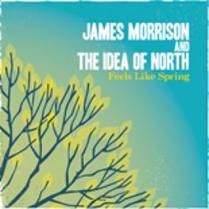 |
James Morrison and The Idea Of North - Feels Like Spring (ABC Records ABC 273 5660)
|
One runs out of superlatives when describing this long overdue collaboration on disc between Australia’s finest multi-instrumentalist and it’s leading a capella group. Morrison’s name is a byword for jazz and The Idea Of North - Sally Cameron soprano, Naomi Crellin alto, Nick Begbee tenor and Andrew Piper bass, show their roots lie in the music, as their spectacular harmonies are enriched by the superb and imaginative arrangements which transform songs. Shades of Gene Krupa and Benny Goodman’s ‘Sing, Sing, Sing’ as the Swing Era is recalled by Crellin on an uptempo ‘It Might As Well Be Spring’ and Morrison’s bright trumpet solo and chart takes the mystery out of ‘Stella By Starlight’. The ballads are beautiful, tender and sensitive, a perfect blending of the four voices. With Morrison added to the mix on several instruments, the disc is a must for those who appreciate the very best in music.
    
|
by Kevin Jones.
Previously published in Limelight July 2010 |
|
Back to Index
|
|
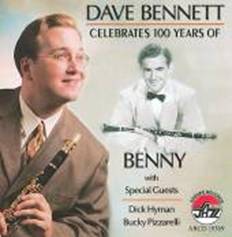 |
Dave Bennett - Celebrates 100 years of Benny (Arbors ARCD 19389)
|
Dave Bennett, a Benny Goodman-influenced clarinet player, does not excite me as Ken Peplowski and, more recently, Anat Cohen did when I first heard them. Nevertheless the 26-year-old clarinettist’s tribute to his idol and inspiration is worth hearing, especially the trio tracks enhanced by the presence of Goodman veterans, pianist Dick Hyman, and guitarist Bucky Pizzarelli. Although the warm intimacy of the ballads makes them the most memorable tracks, the masterful Hyman’s will to swing ignites fiery playing from Bennett on a scaled down (trio version) of ‘Sing, Sing, Sing’ and ‘That’s A Plenty’, the epitome of “Le Jazz Hot”
   
|
by Kevin Jones.
Previously published in Limelight July 2010 |
|
Back to Index
|
|
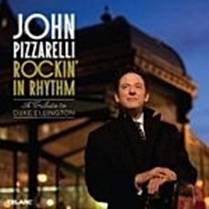 |
John Pizzarelli - Rockin’ In Rhythm (Telarc TEL-31921-02)
|
Guitarist and vocalist John Pizzarelli, with his love for the music of America’s greatest popular icons, has excelled himself here, reinterpreting and refreshing the music of Duke Ellington, jazz’s most important composer. His infectious singing is complemented by Don Sebesky’s superb charts for the Swing Seven, especially the sizzling ‘C Jam Blues’, and the contributions of two natural swingers, tenorist Harry Allen and violinist Aaron Weinstein. But for excitement nothing matches the rollicking ‘Perdido’ with Pizzarelli, his wife, Broadway singer Jessica Molaskey, and Kurt Elling, bopping liked the famed vocal group Lambert, Hendricks and Ross.
    
|
by Kevin Jones.
Previously published in Limelight July 2010 |
|
Back to Index
|
|
 |
Heinz Sauer, Michael Wollny, Joachim Kuhn - If (Blue) then (Blue) [ACT 9493-2]
|
Following two successful collaborations between veteran German saxophonist Sauer and countryman/pianist Wollny, another pianist Joachim Kuhn is now added to the mix in a tribute to Miles’s album ‘Kind of Blue’. The pianists alternate collaborations with Sauer and no track exceeds five minutes. The standards, including two Ellington pieces, are cropped in odd shapes and are generally clipped short leaving further expectation. Sauer’s tone is dry and fragile as empty egg shells but in the lower register bleak as if you can feel cool air from his horn; as distinctive as McGann’s but with Shorter’s long directional phrasing.
    
|
by Peter Wockner.
Previously published in Limelight June 2010 |
|
Back to Index
|
|
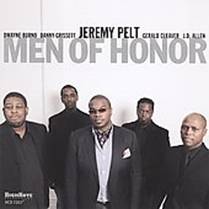 |
Jeremy Pelt - Men of Honour (High Note HCD 7203)
|
Similarities to Alder’s disc end after the opener ‘Backroad’ which harks ‘Maiden Voyage’ but then moves on to a somewhat freer post bop mid 80’s Marsalis style. Pelt’s phrasing, contrasted to Alder, is shorter, his tone more frosty and aggressive. These eight originals are brooding as ballads or at up-tempo, a series of harmonically laboured penetrations. This brings some magnetic moments, rhythmic interplay and surprising melody lines amongst a yearning for warmer relief in the form of JD Allen’s bluesy and sometimes probing tenor saxophone; a no apologies, straight faced, proud American greeting on a welcome mat showing signs of wear and tear.
   
|
by Peter Wockner.
Previously published in Limelight June 2010 |
|
Back to Index
|
|
 |
Sophie Milman - Take Love Easy (Linus 2 70108)
|
Claims that Russian-born Canadian Sophie Milman is the next big thing in jazz singing have not been exaggerated. On the evidence of this disc, her third and the first I have heard, the 27-year-old “Toronto-based sensation” is way ahead of the crop of singers inspired by the success of Diana Krall and, according to reports, Milman now rivals Krall for both popularity and record sales in her adopted country. This is the most exciting new jazz voice to appear since Roberta Gambarini! Her tone is smokey, the voice sensuous yet captivating and she has the ability to explore the emotional depths of a song, yet she has not had any formal vocal training. With first-class backing, including alto saxophonist Wessell “Warmdadddy” Anderson and Guido Basso (trumpet and flugelhorn), she mines the changing moods of carefully chosen chestnuts (Ellington, Porter, Jobim and Mercer) and contemporary pop by Joni Mitchell, Paul Simon and even Bruce Springsteen. Her way of moving the jazz vocal tradition forward I suppose. Mitchell’s Be Cool sums up her approach but the pop tracks, neither melodically nor harmonically, are a match for the standards. It’s the bossa-nova tinged I Concentrate On You and Day In Day Out that remain in the memory. Remember the name . . . Sophie Milman!
    
|
by Kevin Jones.
Previously published in Limelight June 2010 |
|
Back to Index
|
|
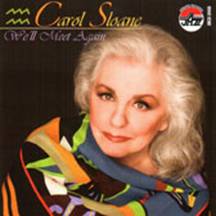 |
Carol Sloane - We'll Meet Again (Arbors ARCD 19400)
|
At 73 Carol Sloane is a marvel! Reunited with Ken Peplowski from her highly-praised Dearest Duke set, her breathy lyrical voice is just made for the many love songs heard here. The sympathetic backing from veteran guitarist Bucky Pizzarelli and bassist Steve LaSpina is a plus and as for Peplowski, better known as a clarinettist, his tenor has never sounded lovelier. The gifted young violinist Aaron Weinstein adds some nice touches but it’s Sloane’s album. A marvel? She is magic.
    
|
by Kevin Jones.
Previously published in Limelight June 2010 |
|
Back to Index
|
|
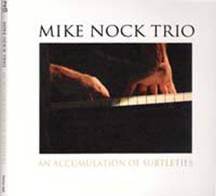 |
Mike Nock Trio - An Accumulation of Subtleties (FWM Records/Birdland)
|
This double disc set accumulates subtleties into a work of significant artistic magnitude on the Keith Jarrett Richter scale and there is more than a subtle contrast between the two separately recorded sets. Apart from the title track, the first set is mainly group expressionism, captured as an afterthought, following a recording session at the SOH in 2008. Somehow ‘Joyous Awakening’ had me in a post Apartheid mindset with rare hints of African sway. Nock has a rare command of melody. Even his most fragmented open ended explorations are littered with melodic motifs while the Waples brothers are at their most balanced allowing Nock’s ideas to develop, adding impetus and seasoning with great restraint. An exquisite trio of pieces by other composers are treated with startling originality during the second Sound Lounge recording. ‘The House of Blue Lights’ grooves effortlessly, then Nock will use a sharp shard of surprise to punctuate and groove again. Nock’s contribution to the arts as a composer should not be underestimated. His melodic masterpiece ‘Beautiful Stranger’ gracefully glides over the top of James Waples’s shuffling brushes while the majestic ‘A Tree has its Heart in its Roots’ originated out of a Nock concerto. Highly recommended
    
|
by Peter Wockner
Previously published in Limelight Oct 2010 |
Apart from the subtlety mentioned in the title, this double CD from Sydney pianist Mike Nock’s trio also exhibits innovative exploration and far-reaching diversity. The title track opens with a minimalist, classical-style piano in a gentle, out of tempo theme, soon taken up by Ben Waples’s double bass with effects gradually added by James Waples’s brushwork. Intensity builds towards the final chorus with the piano marching grandly to a stately conclusion of solitary high treble chords. The other four tracks on disc one, all originals, display a similar approach, tempo-less at times, texturally expressive, and all with Nock’s instinctive compositional flair. Three of the six tracks on disc two are by other composers and two of those, House of Blue Lights, and The Gypsy feature the strongest grooves of the collection, although Nock’s Beautiful Stranger employs a soft bossa beat and some exuberant piano and bass solo work. The Gypsy opens in strong rhythmic mode and drives into a rousing piano solo, a fast running skilful bass sequence and forceful four bar exchanges between piano and drums. Throughout the album’s performance, recorded live in 2008, there are at least two total standouts: firstly Nock’s consummate, artful playing across a miscellany of moods, and secondly the impressive way the trio integrates organically into a seamless yet discursive ensemble
    
|
by John McBeath.
Previously published in The Australian June 2010 |
|
Back to Index
|
|
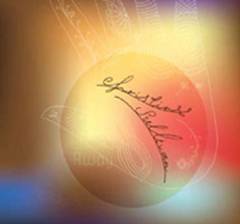 |
Christine Sullivan - Away (Independent/Fuse Music)
|
Recorded over an eight-year period, this album is a good introduction to the unique style of emotional engagement in song by Melbourne vocalist Christine Sullivan. Although classified as a jazz singer, and accompanied here by some superior jazz players, Sullivan’s approach also takes her into areas of alternative folk and contemporary soft rock. There are two sensitive interpretations of Joni Mitchell songs, River, and Black Crow, plus a gently moving version of Bruce Hornsby’s Shadowlands. The other five tracks are Sullivan originals and a common thread is her gossamer fragility, as in the title track Away, featuring some floating guitar backdrops from producer Craig Moss, and a subdued saxophone solo by Tony Buchanan. There is an ethereal atmosphere throughout the album, exemplified in the opening track, Oestre with Sullivan’s wordless vocals gliding restfully in an Asian modality in front of David Jones’s delicate hand drumming and Buchanan’s soothing flute sequences. Quiet Now has a more pronounced rhythm initiated by bassist Evri Evripidou, and strengthened vocal work lifting slowly into the upper register. Sullivan’s cover of Black Crow maintains the introspective mood of Mitchell’s darkly enigmatic song, while the other cover by the same composer River, is stronger and more dramatic. Murdanna is not so much a song, as a whispered recitation against a vague instrumental wash, but also uses some wordless tranquil vocals.
   
|
by John McBeath.
Previously published in The Australian June 2010 |
|
Back to Index
|
|
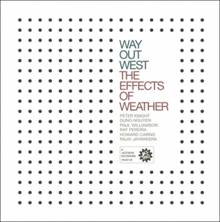 |
Way Out West - The Effects of Weather (Jazzhead)
|
Pushing the Asian/Australian jazz concept even further, award-winning Melbourne jazz/world music sextet Way Out West, have released a follow-up to their 2007 album, Old Grooves For New Streets. Much of this successful exploration is due to leader/trumpeter Peter Knight’s multi-faceted compositions and the stunning versatility of Dung Nguyen’s contributions on various Vietnamese instruments and modified guitar. The opening track Music For April, is like a suite of five parts commencing with a soft African beat and an Asian-sounding theme from trumpet and tenor sax taken up by modified guitar. Then after an out of tempo sequence Ray Pereira’s belafon – a West African marimba – establishes a rhythmic pulse together with drummer Rajiv Jayaweera, for some ethereal trumpet building positivity to introduce a smart drum solo, leading to a free-for-all of controlled chaos led by trumpet and Paul Williamson’s tenor sax rasping and wailing to a subdued fade-out. Found objects – old laundry coppers, gas bottle, pot lids – add unusual textures throughout, providing a metallic offbeat in Blues for a Jungster behind the two-string Dan Nguyet. Knight plays jaw harp in part two of Droop Street Breakdown, co-jointly composed with bassist Howard Cairns, and featuring a clanking, rattling rhythm section of surprising musicality. In the growing Australian genre of jazz/Asian fusion Way Out West is way out in front.
    
|
by John McBeath.
Previously published in The Australian June 2010 |
|
Back to Index
|
|
Melbourne International Jazz Festival 2010 By John McBeath
Following a general invitation many in the huge crowd brought an instrument to the “Big Jam” opening of the MIJF in Federation Square, and under the tutelage of James Morrison on trumpet they all joined in some basic numbers tracing the history of jazz. It was a risky scheme which worked surprisingly well as a crowd-pleaser, some adding vocals while others blew trumpet sounds through rolled up papers. A concert in the square by some top names followed, selected from overseas headliners and local talent totalling over 400 performers. Apart from many gigs across the city, there were daily masterclasses, Jazz For Kids, panel discussions, jazz on film, and installations, including a ‘piano staircase’ at Southern Cross Station where each step produced a different note. The sculpture garden at the National Gallery of Victoria was occupied by various groups, several of a neo-Dadaist persuasion, using electronica, and improbable instruments. Those who found these sounds too weird might instead perhaps sample the Melbourne Symphony Orchestra’s three concerts of jazz-flavoured classical works.
Guitarist/vocalist Lionel Louecke, Benin born and NY based, led his trio into a wonderfully improvised instrumental version of “Skylark,” before launching into astonishing vocals in his native tongue. Using electronics he added several layers of harmonised versions of his voice to create the impression of an African vocal group. Much later, the intimate atmosphere at Bennett’s Lane was cool and rippling as Sydney pianist Mike Nock joined Dave Samuels, US vibraphonist, and Anders Astrand from Sweden on marimba. Their original music chimed in tranquil grooves with alternative vibes produced by padded mallets, bare hands, or hollow seed-filled mallets hitting the bar notes.
Two free sessions daily continued at Federation Square with some notable performers: a strong blues group led by Melbourne saxophonist Paul Williamson announced “The Maribyrnong River Delta Blues – it’s low down and dirty but we love it.” Another free session featured “Twelve Tone Diamonds” an exhilarating local jazz/rock fusion quintet with some amazing guitar work and hyperfast, energetic keyboards of exceptional ability. One top-flight performer not to be missed was Ethiopian Mulatu Astatke, 67 year old founder of Ethio-jazz, who played vibraphone, but soloed just once, on congas. Astatke and The Heliocentrics, an octet led by extraordinary multi-instrumentalist James Arben, played songs from Astatke’s film soundtrack “Broken Flowers.” The music incorporated African and South American influences into jazz concepts.
US saxophonist Charles Lloyd aged 72 is a legendary figure in jazz. He brought three consummate sidemen from NY: pianist Jason Moran, Rueben Rogers on bass and drummer Eric Harland and all gave performances of near genius level. Lloyd’s playing ranged from a hymnal sound to high velocity runs ending on unexpected notes in a constant flow of ideas, at times faintly echoing John Coltrane. Another living US icon, now nearly 80, was Ahmad Jamal who played his signature piano style to a sold-out house featuring advancing, percussive block chords with sudden mood changes to fast and soft treble chromatics. Back at Bennett’s Lane, NY based Adelaide vocalist Jo Lawry justified lavish praise from NY critics with highly expressive versions of originals and other songs. A standout was an ultra fast, tongue-twisting “Loro” in Portuguese where not one note or tricky syllable was missed. Lawry’s aching nostalgia in the ballad “I Have The Feeling I’ve Been Here Before,” held the packed-out club spellbound.
A magnificent local success was the Australian Art Orchestra with Paul Grabowsky’s tribute to Miles Davis, especially the twenty piece group’s arrangement of “Sketches of Spain” – from 1960 – with Phil Slater giving a beautiful reading of the trumpet part. After interval a sudden leap to futurism, electronics and abstraction seemed too much for some, who left early. Guitar virtuoso John Abercrombie brought his US quartet and played several numbers from their recent CD. Abercrombie’s velvety guitar exchanged exquisite passages with his long-term violinist Mark Feldman. The two worked seamlessly: violin responded to guitar phrases echoing and embellishing them, and vice versa. They were driven by the marvellously inventive drummer Joey Baron with a ceaseless flow of cleverly integrated percussion and pulse.
The festival finale and another highlight, brought back Charles Lloyd with his trio, “Sangam” featuring tablas master Zakir Hussain and drummer Eric Harland. In an inspired fusion of Indian music and jazz Lloyd played piano, drums, flute, tarogato – a clarinet relative – and tenor sax while Hussain played with astonishing speed, precision and a variety of tabla effects.
In an almost overwhelming program, attendances were more than fifty per cent up on last year. As with most festivals – and the MIJF must now be classed as Australia’s foremost jazz festival – events clashed, forcing difficult choices, but that increased the feeling of having experienced a delicious embarrassment of riches.
|
|
Back to Index
|
|
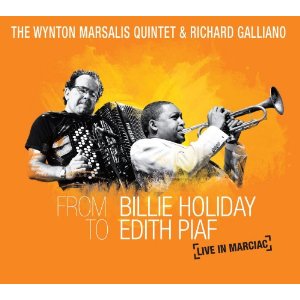 |
The Wynton Marsalis Quintet & Richard Galliano - From Billie Holiday to Edith Piaf Live in Marciac (Harmonia Mundi)
|
Even without the use of the Piaf/Holiday theme, the pairing of Wynton Marsalis (who is in fine fettle) and the French accordion player Richard Galliano is natural enough. The French heritage of Marsalis’ native New Orleans prospered on musical fusion of sorts, which of course goes all the way back to the Hot Club de France. Nevertheless this live set from the now famous Marciac Jazz Festival (where Marsalis is immortalised in bronze) in the south-west of France, sees the Marsalis quintet swinging furiously at ‘What a little moonlight can do’ while Galliano brought the marquee down on the Piaf favourite ‘La Vie En Rose’. Innovative arrangements include an emotionally disturbing version of ‘Strange Fruit’ despite lacking the poignant lyric, thanks mainly to Marsalis’ growling use of the mute. The pianist Dan Nimmer is a stand out amongst the quintet. His ability to call upon a pantheon of piano stylists at a whim, including greats Erroll Garner and Oscar Peterson, is remarkable. The album also includes a DVD version of the concert filmed with the quality and detail that Marciac is renowned. Galliano brings one of his own compositions ‘Billie’ to the program which alternates songs associated with both singers.
   
|
by Peter Wockner.
Previously published in Limelight May 2010 |
|
Back to Index
|
|
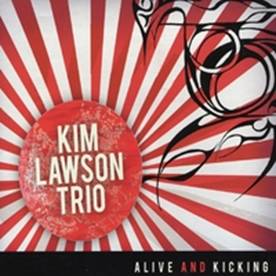 |
Kim Lawson Trio - Alive and Kicking (Jazzgroove Records JGR 053)
|
This is bursting with electric energy. Kim Lawson tenor and alto saxophones, Steve Hunter electric bass and James Hauptmann drums and kalimba contribute to all twelve original pieces, nine of which are intensely rhythmic while all are intricately melodic. Most, it would seem, are arranged with the musicianship of Hunter in mind. His nimble technique, integral to the dazzling synchronised unison passages with saxophone and few electric bassists could shine like he does here. Lawson’s tone is like a headlight on high beam and driving the force is Hauptmann whose kalimba adds an African feel on “To Top a Billion”.
   
|
by Peter Wockner.
Previously published in Limelight May 2010 |
|
Back to Index
|
|
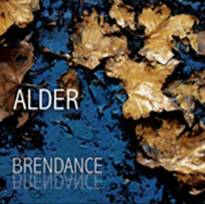 |
Warwick Alder Quintet - Brendance (Rufus/Universal Music RF078)
|
|
Despite appearing on around fifty previous CDs, this is Sydney trumpeter Warwick Alder’s first album in his own name. It’s nearly 30 years since Alder graduated with honours from the Sydney Conservatorium – where he now teaches – during which time he’s played and toured with many of Australia’s very best artists and groups. Most notably he’s been a long-term associate of Bernie McGann’s highly praised Quartet. On this overdue debut album Alder has composed and arranged six tracks and the other three are lesser known standards, including a beautiful rendition of Thad Jones’s ‘Olivia’s Arrival’, a delicate example of a refined muted trumpet in ballad mode. The sidemen, Jonathan Harkins on piano, bassist Brendan Clarke and drummer Andrew Dickeson, are all tried and true colleagues. The exception is newcomer Dave Jackson on alto saxophone who gives a convincing performance on ‘Chromania’ opening with perky chasing and uptempo unison sequences between alto and trumpet, before a flying alto solo introduces the elegant trumpet in restrained flourishes and speeding chromatics. In Thelonious Monk’s ‘Hackensack’, everyone has an opportunity to solo on the bop classic with the piano building a structure of Monkish ideas, and a finale of fast four bar exchanges between trumpet, piano and drums. Alder’s compositions from over twenty years are first class, and they’re skillfully delivered by this outstanding quintet.
   
|
by John McBeath.
Previously published in the Australian May 2010 |
The album we’ve all been waiting for! He was perhaps the most gifted trumpet stylist to emerge here in the 1980’s. Now, after 50 recording as a sideman, Alder has finally released a showcase of six originals and three standards from Thad Jones, Legrand & Monk. The title and opening track has a 1960’s modal flavour, hence the album backtracks to stylish hard bop and melodic ballads. Alder’s playing is soulful and inventive with a beautifully controlled vibrato. Altoist Dave Jackson warmed to this setting as a foil and John Harkins’s trio swings and supports like few others in this genre.
   
|
by Peter Wockner.
Previously published in Limelight June 2010 |
|
Back to Index
|
|
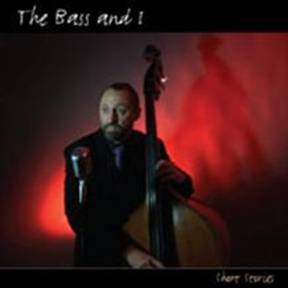 |
Steve Arie - Short Stories. The Bass & I (Independent/www.thebassandi.com)
|
Steve Arié is a Sydney bassist/vocalist with considerable national and international experience. In this, his debut CD, he sings and accompanies himself on acoustic bass – no mean achievement. Only three of the eleven tracks are bass solo originals, while the other eight are standards with bass and vocals. These are all top-flight familiar numbers from the great American songbook, but they have been performed countless times over the last seventy plus years. Their re-recording here must raise the question of just how many versions of these songs are needed before the point of overkill is reached. Of the bass solo originals, ‘What’s The Hurry’ of just 45 seconds duration is the standout, with fast, muscular playing while ‘Ain’t I Good To You’ sets up a strong groove. ‘Twice In A While’ is a reflective ballad with some eloquent chordal work. Ariés bass playing is excellent and the vocals are quite adequate if unremarkable, but with the large pitch differences between bass and voice, after several tracks the gap between the two becomes ever more noticeable. The addition of one more instrument, say guitar or piano, would have filled in the mid range spaces nicely. Nevertheless the bass work is impressive and those who cannot get enough of Hammerstein, Porter, Mercer, Gershwin etc. might enjoy these unusual voicings.
  
|
by John McBeath.
Previously published in the Australian May 2010 |
|
Back to Index
|
|
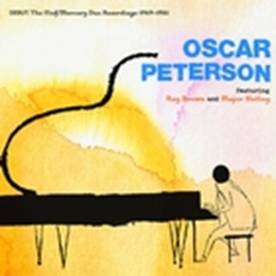 |
Oscar Peterson - Debut: The Clif/Mercury Duo, Recordings 1949-1951 (Verve B002950-02)
|
The setting: New York’s Carnegie Hall just after midnight on Sunday 18 September 1949. To overcome visa problems, impresario Norman Granz calls a young Canadian pianist from the audience to perform at the opening Jazz at the Philharmonic concert of a 29 city tour. The 24 year old Oscar Peterson dazzles the audience with his virtuosity, captured on these rare recordings, which also herald the beginning of his partnership with bassist Ray Brown and the first 12 months of his American recording career, first with Brown and later with bassist Major Holley. This is early Peterson but there’s no mistaking that rhythmic drive and his melodic gifts and it’s the ballads that impressed me the most. This 3 CD set, lavishly packaged like a book with photos, extensive liner notes and discographical information is a must for those interested in the evolution of the jazz piano and the legacy of one of its greatest keyboard masters.
    
|
by Kevin Jones.
Previously published in Limelight May 2010 |
|
Back to Index
|
|
This is a working big band and it shows! The sections are clean, the ensemble purrs or roars as the occasion demands, and it has an impressive array of soloists including some of Melbourne’s top jazz musicians. It swings and no wonder: with its roots anchored in the Benny Goodman tradition set three-quarters of a century ago, the orchestra revisits some of the era’s most popular anthems in its first album. It’s great to hear Julie O’Hara singing with a big band. A pleasure to review, I envy those who can hear the band live and dance to its swinging sounds.
   
|
by Kevin Jones.
Previously published in Limelight May 2010 |
|
Back to Index
|
|
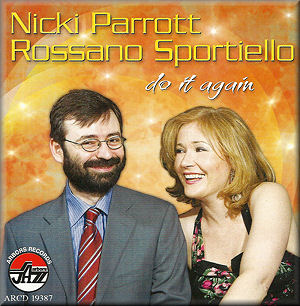 |
Nicki Parrott & Rossano Sportiello - Do it Again (Arbors ARCD 19387)
|
The inspired pairing of former Sydney bassist and vocalist Nikki Parrott and the Italian-born pianist Rossano Sortiello – who sounds more impressive with each new album, is a winner. It’s obvious they enjoy working together; their almost telepathic musical chemistry shines on a program of bop, Ellingtonia (a fragile ‘Fleurette Africaine’), standards and Schumann (‘Foreign Lands and People’ becomes a Teddy Wilson-inspired romp). Parrott’s intimate voice is so satisfying, especially on the suggestive title track, but it all ends too soon with a vocal duet on ‘Two Sleepy People’. I can only repeat the title – and soon.
    
|
by Kevin Jones.
Previously published in Limelight May 2010 |
|
Back to Index
|
|
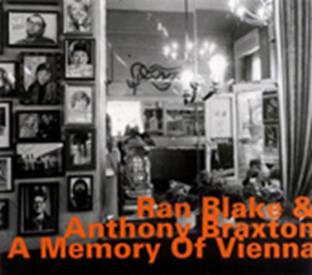 |
Ran Blake and Anthony Braxton - A Memory of Vienna (Hatology 687)
|
Rekindling previous collaborations in 1978, this 1988 duo recording was the result of a chance meeting in a large Viennese hall once used by a local Socialist Group complete with a pot belly stove and a grand piano. Blake, out of the Ellington and Monk tradition, had predominantly recorded solo in the ‘Third Stream’. While the often cryptic Braxton, who at the time titled his own original works with abstract symbols rather than names, with Blake, jointly de-construct a marvelous suite of jazz standards such as ‘Round Midnight’, ‘Four’ and Mal Waldron’s ‘Soul Eyes’ without any loss of heritage or respect.
   
|
by Peter Wockner.
Previously published in Limelight April 2010 |
|
Back to Index
|
|
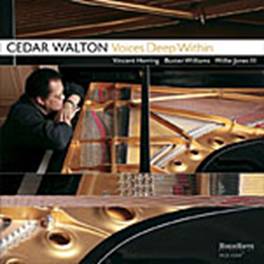 |
Cedar Walton - Voices Deep Within (Highnote HCD 7204)
|
Having recorded ‘Naima’ in 1959 with Coltrane himself, there is none better qualified to re-record the classic from the album ‘Giant Steps’. This is Walton playing to his strengths; three of his own originals, ‘Over the Rainbow’, Stevie Wonder’s ‘Another Star’ and Rollins’s ‘I Got Rhythm’ clone ‘No Moe’. Yes he finds safety in those strengths but there are few more exquisite pianists out of the ‘Messengers’ tradition than Walton. He remains a cherished link to the past via Tatum, Powell, Peterson and Silver. Bassist Buster Williams is the anchor alongside the relative youth of Vincent Herring’s tenor and Willie Jones’s III drums.
   
|
by Peter Wockner.
Previously published in Limelight April 2010 |
|
Back to Index
|
|
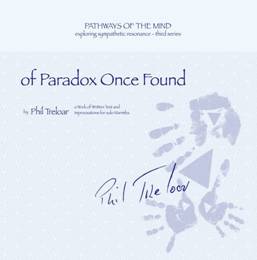 |
Phil Treloar - Pathways of the Mind. Of Paradox Once Found (FT 005-007)
|
Third in the series of ‘Pathways of the Mind’, this expansive 3 disc set is presented with attention to quality and detail. Solo marimba might be too disconcerting for some but the roots of these sounds are firmly derived from the fundamentals of jazz. Organic in his approach, at the heart of the Treloar’s equation is the relationship between the improvised and the composed using the seeds of sound creation and sound byte relationships. Spontaneous improvisation can be sometimes erratic or over zealous. Not Treloar. His is a steady handed measured approach, although the spiritual might consider him a medium for sound creation by a greater force. In reality, his 30 page accompanying booklet contextualises his sensibility for improvisation kindled by the readings of Gayatri Chakravorty Spivak. This great gift is revealed often throughout the three discs when open ended meditative atonality explodes into melodic motifs like sparkling pyrotechnics
    
|
by Peter Wockner.
Previously published in Limelight April 2010 |
|
Back to Index
|
|
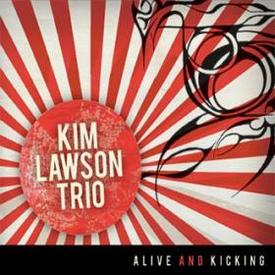 |
Kim Lawson Trio - Alive and Kicking (Jazzgroove JGR053)
|
Sydney alto and tenor saxophonist/composer Kim Lawson has enlisted two equally accomplished players for this debut album of his trio, not to mention their composing contributions. While Lawson wrote more than half of the twelve tracks, electric bassist Steve Hunter and drummer James Hauptmann provided several of their originals to give these pieces separate identities. This is especially true of Hunter’s work, an artist already acknowledged as a fine composer from his recent albums “Dig My Garden” and “The Translators.” Some of the tunes are frantic and frazzled, like Lawson’s “Round the Bend” where independent choruses are separated by a two bar silent break and the alto’s high-powered zigzagging is underscored by fast and energetic bass and drums. Opening with an ultra-slow drag, Hunter’s “Up For It” soon quadruples the time with tenor and bass in unison establishing the theme before the tenor breaks out at top speed, followed by an astonishingly quick, guitar-like bass solo. A short, graphic track, “4AM Bathroom” sounds just like its title with an echoing tenor, gurgling bass line and Hauptmann adding effects from a kalimba (African thumb piano). “Top The Billion” goes through several sections of broken rhythm with the tenor leading the way into a climactic build-up until in the final chorus the bass comes out of the blocks like a high speed runner.
   
|
by John McBeath.
Previously published in The Australian April 2010 |
|
Back to Index
|
|
 |
The Vampires - Chellowdene (Earshift Records/Fuse Music EAR002)
|
Following the success of this young Sydney quartet’s recording “South Coasting” from 2008, and their saxophonist/composer Jeremy Rose’s 2009 Bell Award for Young Australian Jazz Artist, this new album comes with considerable credibility. Rose wrote most of the tracks and trumpeter Nick Garbett has contributed three. The Vampires manage to play contemporary jazz and at the same time include aspects of traditional reggae, South American music and occasional references to the recent past with echoes of Bernie McGann and The Catholics. Rose’s composition “Balkan Dance” uses a mid-Eastern modality in an unexpected tango rhythm plus thoughtful solos from alto and trumpet in a truly cross-cultural production. Melbourne virtuoso trombonist Shannon Barnett makes a couple of guest appearances and delivers a powerhouse solo against South American riffs and rhythms in “There’s More To Life Than Being A Vampire,” with another guest, Fabian Hevia’s percussion. Alex Boneham on double bass together with Alex Masso on drums play important roles throughout, particularly in a crisp Latino piece “Chellowdene,” with a quick bass solo and smart alto and trumpet work on a catchy, but tricky theme. “Red Head” features a sagging, dragged out, almost tempo-less post-bop theme on trumpet and alto and vivid ornamentation from bass and drums. With varied and superior compositions played with verve, high ability and inspiration, The Vampires have produced another distinguished album
   
|
by John McBeath.
Previously published in The Australian April 2010 |
|
Back to Index
|
|
 |
Angelika Niescier Quartet - Sublime III (Enja Records/Fuse Music ENJ-9533 2)
|
Polish born saxophonist/composer Angelika Niescier is active on the jazz and classical scene in Germany, her home since 1981. Like many Euro-jazz exponents she is predisposed towards classical music, listing Stravinsky and Stockhausen amongst her influences as well as John Coltrane and Wayne Shorter. But she is no mere echo of anyone. Her compositions are innovative and original and she plays them on either alto or soprano sax with a technique of astonishing virtuosity. Ultra high-speed stabbing, energetic and complex phrases are delivered as effortlessly as interlaced passages of grooving longer notes or fast forays into the high register. The accompanying German musicians, pianist Florian Weber, bassist Sebastian Rather and drummer Christoph Hillmann are perfectly supportive and each is given solo opportunities. The opening track Bill uses a quick theme infused with classical-like tremolos with a high-flying, often quadrupled time solo from Niescier’s alto plus melodically intertwined drum and bass work. Oud Suites Parts One and Two feature Mehdi Haddab on oud introducing a Balkan dance style melody for Niescier’s frenetic solo and Hillmann’s ethnic drumming. The piano sets a lyrical ballad mood in ‘Sirr’ with Weber’s introspective, classically inspired solo into which the bass and soprano merge beautifully. A medium tempo homage to Thelonious Monk, Thronk could easily have been written by the master and Niescier’s convoluted high velocity soprano uses Monk-related ideas, as does an impressive piano and drum duet.
   
|
by John McBeath.
Previously published in The Australian April 2010 |
|
Back to Index
|
|
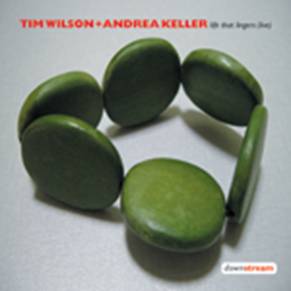 |
Tim Wilson, Andrea Keller - Life that Lingers (Downstream DSCD0905)
|
Both Melbourne players in this duo, recorded live at Bennett’s Lane, pianist Andrea Keller and saxophonist Tim Wilson, are experienced, advanced and award-winning players. Wilson wrote six of these compositions and Keller has contributed three including the title track which is a fine intro to the album’s style. The music floats in melodic undulations, often out of tempo, with the emphasis decidedly on Wilson’s expert alto sax while Keller spreads a gliding, grounding backdrop. The alto soars and speeds impressively against the mostly arpeggiated piano accompaniment. The strategy seems to be to spotlight Wilson’s splendidly lavish alto while the piano remains in a supportive role, and to that extent the album works well. Fading Away gives the piano a solo opportunity but needed a slight lift in recording level to bring the instrument to the foreground, before Wilson’s inspirational flight to the conclusion. With Wilson’s purity of tone and the canonical flow of classical ideas from both players the album has something of a concert hall atmosphere, well illustrated in the flowing piano introduction and subsequent evolving theme in That Day. A jagged style opens Motivate and some bop-like phrasing before a return to the formality of tremolos and a tranquil conclusion. The final track Cadenza is just that, a solo saxophone piece with more astonishing alto runs pouring out in a silvery cascade.
   
|
by John McBeath.
Previously published in The Australian April 2010 |
|
Back to Index
|
|
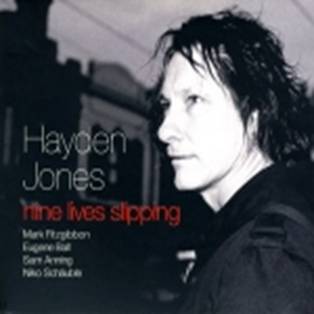 |
Hayden Jones - Nine Lives Slipping (Newmarket NEW3275.2)
|
The Australian jazz scene has not been over supplied with highly talented male vocalists lately but this second album from Melbourne singer Hayden Jones brings a fresh take. It’s been thirteen years since Jones’s Aria-nominated first CD “Whisper Not” appeared, far too long an absence for such a fine talent. A useful guide to a jazz vocalist’s ability is often found in the calibre of the backing group, and here four of Melbourne’s best, pianist Mark Fitzgibbon, Eugene Ball on trumpet, bassist Sam Anning, and drummer Niko Schauble enrich and extend the impact of the nine songs. Jones’s voice has just enough of the “lived in” ingredient combined with an originality of expression and finely tuned control. He moves from the tenderness of “Dreamship Blue,” to the more forceful and quick phrasing of “Nine Lives Slipping.” Most of the tracks were written by Jones’s partner Deanne Adams including lyrics to Freddie Hubbard’s “Little Sunflower,” renamed “Kiss the Sea,” staying true to the original’s ballad tempo and featuring a beautifully calming trumpet solo. The standard “Out Of This World” interweaves Jones’s satisfying interpretation with rhythmic piano work, culminating in an improvised vocal finale ending on an impressive falsetto. The traditional spiritual “Motherless Child” is taken at a slighter brisker tempo than usual and demonstrates the vocalist’s expansive range and especially his expressive command at the bass level.
   
|
by John McBeath.
Previously published in The Australian April 2010 |
|
Back to Index
|
|
 |
Ella Fitzgerald - Twelve Nights in Hollywood (Verve B001 2920-2)
|
Until the release of this lavishly packaged four-disc set with its extensive liner notes and rare photos, I had always regarded the 1960 set ‘Ella in Berlin - Mack the Knife’ as her most successful concert album. Not any more. Mastered from the original tapes produced by her long time manager and Verve label founder Norman Granz, this is so much more satisfying. Taped over 12 nights at The Crescendo, a small jazz club on Hollywood’s Sunset Strip, in May, 1961 (and 1962) it finds Ella Fitzgerald, relaxed and swinging, at her most adventurous on 76 never before released live tracks. There has never been a better setting to marvel at her astonishing vocal control and highly inventive scatting, brilliantly backed by pianist Lou Levy, with guitarist Herb Ellis, bassist Wilbur Middlebrook and drummer Gus Johnson. Her rhythmic joy is balanced by the emotional beauty of her ballad singing. It is a daunting task to pick highlights as this is as good as it gets but the slow and sensuous ‘Baby Won’t You Please Come Home’ is something else. What The Beatles were to pop music, Ella was to jazz vocalising. Here is the proof. Don’t miss it!
    
|
by Kevin Jones.
Previously published in Limelight April 2010 |
|
Back to Index
|
|
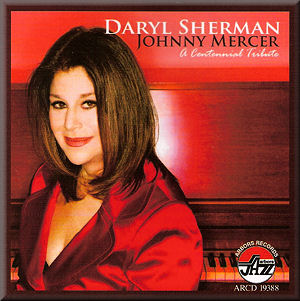 |
Daryl Sherman - Johnny Mercer: A Centennial Tribute (Arbors ARCD 19388)
|
Singer-pianist Daryl Sherman, for so long a fixture at New York’s Waldorf Astoria, has excelled herself in this marvellous tribute to Johnny Mercer who, if not the greatest lyric writer, was the most decorated lyricist in movie history with four Academy Awards. A Mercer enthusiast, Sherman’s girlish voice (think Blossom Dearie and Mabel Mercer) captures the mood of the obscure ‘I’m Shadowing You’, the forgotten ‘The Bathtub Ran Over’ and the well known ‘Come Rain Or Come Shine’. Outstanding are ‘Dream’ tenderly massaged by Wycliffe Gordon’s trombone and ‘Little Ingénue’ written with pianist Jimmy Rowles. Timeless!
    
|
by Kevin Jones.
Previously published in Limelight April 2010 |
|
Back to Index
|
|
Manricks may not yet have a distinctively identifiable sound on alto but his complex compositions ensure that this, only his second album, is one of deep distinction. Based in NYC but formerly from Brisbane, this Doctor of Musical Arts in Jazz Composition (Manhattan School of Music), placed third in the 2009 National Jazz Awards and plays alto, soprano, flutes and clarinets including the arrangements for the 40 piece Chamber Orchestra that embellishes two of these eight originals. Labyrinth is an imposing album that has the over-arching sophistication of an ECM recording. Committed contextual contributions flow from band members taking this music often on an unknown path despite the obvious determination of wholeness from the leader. ‘March and Combat’ starts as a slow Gil Evan’s influenced bolero complete with strings and horns underneath a cutting Ben Monder electric guitar solo morphing into a series of rhythmic trio figures underneath the mercurial Manrick’s alto. The listener is then taken on a minimalist, meditative but at times uneasy journey that blurs the divide between the composed and improvised firstly by the trio only of the Jacob Sacks’ piano, Thomas Morgan’s bass and Monder’s guitar until Tyshawn Sorey’s cymbals slowly envelope the climax. Manricks tours Aust-wide this March
   
|
by Peter Wockner.
Previously published in Limelight March 2010 |
|
Back to Index
|
|
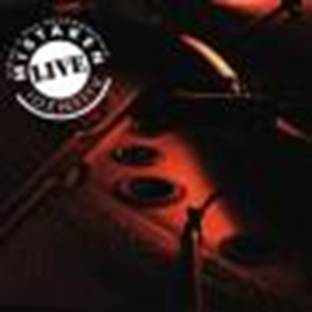 |
Steve and Mal Sedergreen - Mistaken Identity Live (Newmarket Music NEW 3273.2)
|
Since forming the group Mistaken Identity in 1985, Steve (piano) & Mal (saxes) Sedergreen, then still in their teens, have forged their own brand of hard/post bop with occasional use of quality pop material. This double album captures two distinct periods in mostly live jazz club settings. ‘Eleanor Rigby’ opens the first disc recorded in June 2009. Sound quality purists might be disappointed but the inclusion of Hancock’s beautiful ‘Chan’s Song’ delighted me. The second disc goes back to 1998 with trumpeter Toby Mak and Matt Clohesy (bass) & Danny Fischer (drums) now both based in NYC. Great blowing!
   
|
by Peter Wockner.
Previously published in Limelight March 2010 |
|
Back to Index
|
|
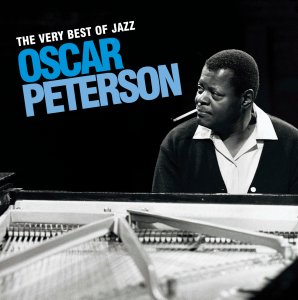 |
Oscar Peterson - The Very Best Of Jazz (Concord Jazz 0600753120064)
|
With the launching of the Pablo label in 1972 and Oscar Peterson’s renewed partnership with Norman Granz, the pianist reached new heights of invention in a variety of settings. The majority of the tracks on this superb compilation are from that period, the highlights being the duets with another master, trumpeter Dizzy Gillespie, who is in sublime form. Peterson also redefines the art of the jazz trio, first with bassist Ray Brown and guitarist Herb Ellis, then with drummer Ed Thigpen and later guitarist Joe Pass. He had it all, technique, melodic logic and the feeling of swing.
    
|
by Kevin Jones.
Previously published in Limelight March 2010 |
|
Back to Index
|
|
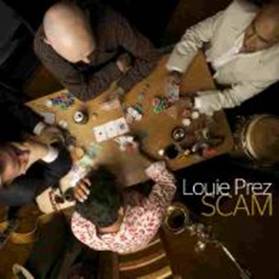 |
Louie Prez - Scam (Q records QR229)
|
Louis Prez - remember the name! This excellent Melbourne trio shows with its cornucopia of delightful but contrasting Brazilian-inspired originals, with a West African touch, that it is a new force to be reckoned with in Australian music. Highlights abound; the duet between Leo Dale’s cool, and melancholy alto and the always impeccable acoustic guitar of Doug DeVries on the reed player’s softly swinging but gentle ‘In Her Arms’ and Louis’ ‘White Shoes’ where Dale’s almost detached and delicate alto floats above the passionate and exciting beat generated by DeVries and percussionist Ray Pereira.
   
|
by Kevin Jones.
Previously published in Limelight March 2010 |
|
Back to Index
|
|
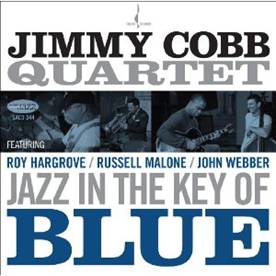 |
Jimmy Cobb Quartet - Jazz In The Key Of Blue (Chesky SACD 3)
|
Jazz instrumental albums of romantic ballads, especially late night chamber of jazz of this quality, are a rarity these days. Here we have drummer Jimmy Cobb, the last surviving member from Miles Davis’ legendary Kind Of Blue session in 1959, leading a younger generation of jazz stars who show their respect for these timeless yet lovely melodies from another era. Nothing new or groundbreaking; there’s no need; the music speaks for itself and gets the respect it deserves, Cobbs’ understated brushwork underpinning some inspired balladeering by Ray Hargrove and Russell Malone. Hargrove of late has been captured in funky settings but here his inventive mastery of both the trumpet and the flugelhorn is given full rein, especially with the latter instrument on the opening track ‘Every Time We Say Goodbye’, cushioned by the guitar of Malone, who shows what a beautiful instrument it can be in the right hands.
    
|
by Kevin Jones.
Previously published in Limelight March 2010 |
|
Back to Index
|
|
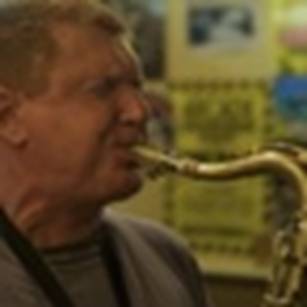 |
The Andy Sugg Group - Brunswick Nights (Downstream DSCD1001)
|
This live recording of Melbourne saxophonist Andy Sugg’s quintet was made in 2009 towards the end of a long season at the Brunswick Green Hotel. For a live recording the sound quality and mixing are very good and quite uncluttered. The tracks are all Sugg originals in a softer jazz-rock-fusion style. Bassist Michael Story and Thom Mann on drums fill the rhythm requirements, with most of the album being without a heavy rock beat; on most tracks Mann uses brushes rather than sticks. Two of the tracks are dedicated to the landmark release of the genre: Miles Davis’s 1969 album “Bitches Brew.” Sugg’s playing on soprano and tenor is impressively quick and darting, sometimes in unison with Nashua Lee’s equally adept guitar. On keyboards Daniel Gassin launches into high velocity solos and provides chordal backing for the ensemble. “Silhouette Live” opens with a dreamy sequence of tenor and guitar followed by their introspective solos ornamented by softly twinkling high end chords from the keyboard before the tenor becomes forceful, building climactically. “Remembering Bitches Brew Parts 1 & 2” are both softly melodic themes featuring soprano sax in a mood of reverie on part one and a faster tempo on part two with a richly fluid keyboard solo and accelerated soprano. Sugg’s compositions employ a good deal of post-bop influences arranged in unusual and interesting ways, offering frameworks for these varied and skilful solos.
   
|
by John McBeath.
Previously published in The Australian March 2010 |
|
Back to Index
|
|
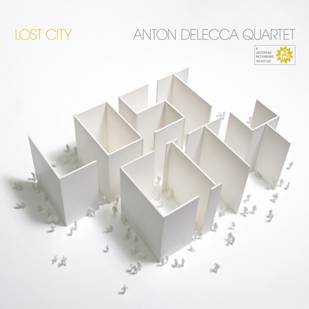 |
Anton Delecca Quartet - Lost City (Jazzhead 120)
|
Melbourne tenor saxophonist Anton Delecca formed his quartet in 1998 and this album follows their 2001 release “Flow,” although personnel have changed, leaving only the leader from the original group for this recording of originals. The newcomers bring an album-load of talent: pianist Marc Hannaford, bassist Jonathan Zion and Daniel Farrugia on drums. The style is modern mainstream with a strong groove driven by Farrugia’s powerfully informed kit. “Catalyst” adds guest Elvis Aljus on congas for a satisfying striding-out piece with Delecca displaying an ability to sustain the horn well, high up in the harmonics. Ultra high frequencies on the tenor are also demonstrated in “Regulated.” There’s a New Orleans bluesy street march feel to “A Dog’s Tale” pushed along by a gutsy tenor sax and Hannaford’s southern gospel piano. The piano features in a more contemporary approach on “Living With Weirdness,” a post-bop piece, while “Lost City” has the tenor wandering in a vague, lost fashion giving the title track a suitably mysterioso effect. An interesting theme from piano and bass opens “Why Can’t Everybody Be Nice Like Gareth?” And the theme is developed inventively in Hannaford’s running, flowing solo. Nothing on the album is extraordinarily ground-breaking, certainly not avant garde, but Delecca’s compositions are stylistically appropriate and the group swings together well adding some exciting solo work from a quartet of obviously skilled performers.
   
|
by John McBeath.
Previously published in The Australian March 2010 |
|
Back to Index
|
|
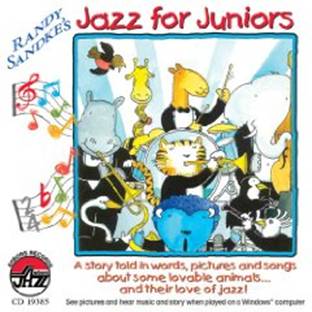 |
Randy Sandke - Jazz for Juniors (Arbors ARCD 19385)
|
I looked at this delightful album when I first received it and wondered what I do with it . . . then I played it! Then I played it again! Why? It reminded me so much how much fun jazz was in the days of American disc jockey Al “Jazzbo” Collins’ 1953 recording of ‘Little Red Riding Hood’ from his “fairy tales for hip kids” . She was hip! And so is this album . . . I couldn’t think of a better way to introduce youngsters to jazz as a trumpet-playing tiger (Sandke) searches for other animals to form a swinging band which includes a hip trombone playing hippo (Wycliffe Gordon), an elegant bass playing elephant (Jay Leonhart), a spritely cockatoo clarinettist (Ken Peplowski) and a penguin who plays cool piano (Ted Rosenthal). It grooves through a spiritual in many different styles in a microcosm of jazz history. One for all ages.
    
|
by Kevin Jones.
Previously published in Limelight Feb 2010 |
|
Back to Index
|
|
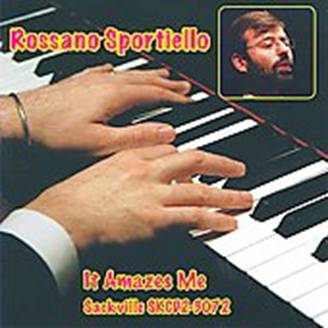 |
Rossano Sportiello - It Amazes Me (Sackville SKCD2-3072)
|
This is a stunning solo recital by the Italian-born pianist Rossano Sportiello who continues to raise the bar every time I hear him. Now living in New York and a regular on the jazz festival circuit, Sportiello again shows his command and knowledge of the jazz tradition in this beautifully recorded session in Toronto last year. He recalls his influences, Hank Jones and Tommy Flanagan, as he demonstrates his touch and sensitivity on ballads such as ‘Darn That Dream’ and strides triumphantly through ‘When I Grow Too Old To Dream’ raising the temperature with every note.
    
|
by Kevin Jones.
Previously published in Limelight Feb 2010 |
|
Back to Index
|
|
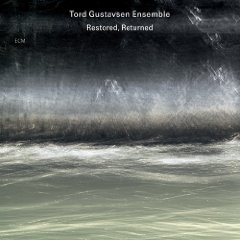 |
Tord Gustavsen Ensemble - Restored, Returned (ECM/Fuse)
|
Opinions have been divided about Norwegian pianist Tord Gustavsen’s trio’s work with accusations of repetitive understatement and anaemic music applied to his 2007 release “Being There.” That ambient album with almost no narrative content or emotional tensions nevertheless attracted a sizeable following. This latest album, adds to the trio saxophonist Tore Brunborg, vocalist Kristin Asbjørnsen and considerably more substance. Bassist Mats Eilertsen replaces the trio’s Harald Johnsen while long term associate drummer Jarle Vespestad is retained. Inspired by poems of W H Auden, the album’s title and lyrics are taken – as are other references – from Auden’s 1940 collection “Another Time,” and all compositions are by Gustavsen. The style is identifiably Nordic, with Brunborg’s soprano and tenor playing highly reminiscent of saxophonist Jan Garbarek. Although not on every track, Asbjørnsen’s vocals are the standout, moving from a gossamer mysticism to a husky, soulful cry across an expansive range. There is less emphasis here on spatial silences with dynamics and jazz elements more to the fore. “Wrapped in a Yielding Air” is based on a piano and tenor riff, over which the bluesy vocal has echoes of Billie Holiday, plus some high register improvisation. Asbjørnsen’s voice brings a haunting melancholy to “Restored, Returned” which gradually builds to a restrained stepping peak assisted by Brunborg’s tenor solo and the underscoring chords of Gustavsen’s piano.
  
|
by John McBeath.
Previously published in the Australian Feb 2010 |
|
Back to Index
|
|
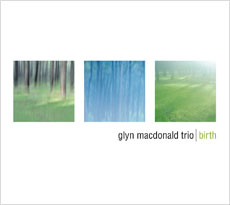 |
Glyn MacDonald Trio - Birth
|
‘Birth’ is the second album from this trio led by the Perth based pianist. Bound by the clutches of beauty, these original pieces, inspired by various periods of the pianist’s life, demand an inviting as opposed to confronting improvisational approach. Rhythm plays a major role too but Sam Anning must be one of the funkiest double bassists around and especially finds great adventure in these 12 tracks. MacDonald for the most part employs a soft elegant touch which suits the flavour of these compositions. However, the feeling of intensive spontaneity comes only in the final two tracks recorded live in Perth.
  
|
by Peter Wockner.
Previously published in Limelight Feb 2010 |
|
Back to Index
|
|
 |
Glen Cannon - Clockwork (GCM/MMusic)
|
Melbourne guitarist Glenn Cannon continues his explorations of jazz-rock fusion, but with the addition of an unexpected element in the mix – classical music. Cannon’s original compositions are played by groups ranging up to sextet size and incorporate bassist Gavin Pearce and saxophonist/flautist Tim Wilson from Cannon’s group Logica? (Ed: “?” intended) and their 2008 release “Native Strut.” On this new album there is one track of pure classicism from a string quartet, another featuring Cannon’s solo classical acoustic guitar, and amongst the remainder several segues from jazz-rock into classically-styled treatment. “Edvard Munch,” after a rocky drum opening from Danny Ferrugia and suitably similar guitar, moves into Luke Howard’s pastoral keyboard set against a paradoxically heavy beat. The flute sets an appropriately serene mood for “Underwater” while a calm, slightly distorted guitar intro in “Santiago”opens the way for a flowing alto passage then a dreamy sequence of Spanish acoustic guitar. “Clockwork” is the most successful track, featuring drum programming by Jon-Erik Andreassen and an insistent ticking theme carried with vivid mechanical regularity by guitar and keyboards. Many of these compositions and the sounds produced are very reminiscent of a Bob James, Earl Klugh album from 1979, “One on One.” It remains to be seen whether this attempt to add classical influences into an electronic-jazz-rock fusion melange will appeal to fans of the genre.
   
|
by John McBeath.
Previously published in the Australian Feb 2010 |
|
Back to Index
|
|
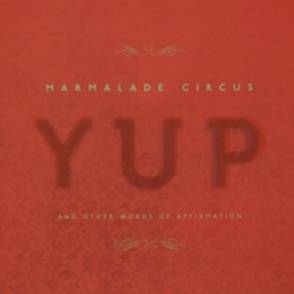 |
Marmalade Circus - YUP /And Other Words of Affirmation/ (Independent)
|
This local ten-piece “little” big band, led by pianist/composer Mark Ferguson, has been appearing in Adelaide since its formation in 1998, but this is their debut recording of compositions and arrangements by the leader. Rather than a band in the Ellington/Basie tradition, Marmalade Circus is more of a show band summed up by Ferguson as “Jazz meets World via New Orleans.” That said it is obvious that the leader is a versatile arranger and a composer of considerable ability who has attracted a group of talented players including some of Adelaide’s best jazz soloists, lifting the band above run-of-the-mill cabaret bands. The most advanced work here, “Anniversary Song for Susan” also the longest piece, has an interesting complexity of voicings and instrumentation with a standout counterpoint passage where Chris Soole’s soprano sax moves against Jonathan Hunt’s bass clarinet. “Animal Curtains” is a fun trad send-up, while “Salaam” employs eastern modalities and rhythms. An “overture to the show” kind of opening entitled “Tropical Fruit Chunks” bounces along in a Latino tempo, but the baritone sax solo sounds under-recorded while “Down Home Up North,” is lifted from its familiar funky soul groove by energetic solos from Warren Heading’s trumpet and Tom Pulford on alto. Another Latino piece, “Thirteen” features smart drum work from Ben Todd and a driving tenor solo from Adam Page.
  
|
by John McBeath.
Previously published in the Australian Feb 2010 |
|
Back to Index
|
|
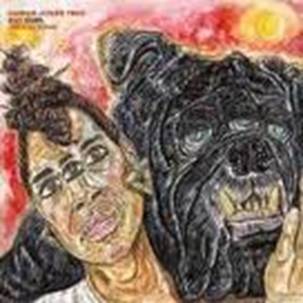 |
Darius Jones Trio - Man’ish Boy /A Raw and Beautiful thing/ (AUM Fidelity/Fuse)
|
New York alto saxophonist and composer Darius Jones’s debut album has been greeted with universal superlatives by US critics. The influential “All About Jazz” magazine named this album as the best debut release of 2009. Others went further, calling Jones’s CD the finest sax trio of the year, and some of the most beautiful sounds ever committed to disc. Several US reviewers have noted Jones’s indebtedness to the groundbreaking saxophonist Albert Ayler, a free jazz exponent who died aged 34 in 1970. That connection holds true. Jones plays with the same vulnerable defiance as Ayler, uses simple melodies as Ayler did, and employs a similar hoarse, raw toned, wide vibrato loaded with emotional weight. Yet sometimes Jones plays in a pure melodic tone vaguely reminiscent of Duke Ellington’s lead alto, Johnny Hodges. To accompany him on his first recording, Jones aged 31 has chosen two experienced, mature musicians twice his age. His drummer, Rakalam Bob Moses has played with many stellar names, including Roland Kirk, Larry Coryell and Pat Metheny. Cooper-Moore on piano is an instrument maker who on this CD also plays his self-made diddley bow – a Ghanaian-derived instrument consisting of a plucked single string and a glass or metal slide.
Five of the eight tracks are Jones’s compositions and the other three he co-wrote with band members. “Chasing The Ghost” – perhaps a reference to Ayler’s “Ghosts” – opens with drums and diddley bow using a bass string bounding along with the sound of a high speed runner on an acoustic stage. The alto joins the chase with a plain over-riding melody which ends in a scale-like climbing passage. Then Jones rockets off into searing improvisation, building each chorus with an increasingly raw tone, and high velocity runs forward and backward. Sometimes he leaps to a pure high note, holding it for a few bars before dropping to a rasping speedy sequence in the lower register. Jones liberally uses alternate fingerings and multiphonic sounds, stretching the tonality of the alto into another dimension. Cooper-Moore on piano introduces “Forgive Me” almost as a soft gospel melody for the alto to sail beautifully across above fluttering brushes. A bonus track, “Chaych”, a soulful piece by Jones with his usual trio is appended featuring bassist Adam Lane and drummer Jason Nazary, a perfect gem to conclude an astonishingly inventive album. Jones’s alto takes us from sobbing melancholy and aching pain to joyful hilarity and soaring ecstasy, in fact the gamut of human feelings and emotions. It’s doubtful if any other contemporary neo free jazz exponents are capable of such unique, life-capturing expression.
    
|
by John McBeath.
Previously published in the Australian Feb 2010 |
|
Back to Index
|
|
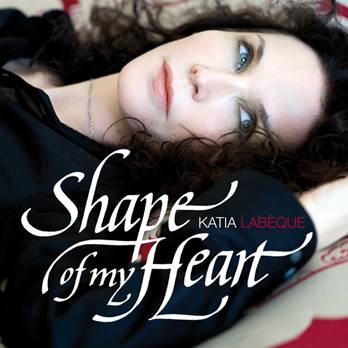 |
Katia Labèque - Shape of My Heart (KML/Select KML 2119)
|
Pianist Katia Labèque, a musician with an international pedigree, often performs classical duo piano works with her sister Marielle, but over her forty year career has investigated other genres. She has released several jazz albums with her ex-husband, guitarist John McLaughlin, a duo version of Gershwin’s “Rhapsody in Blue” with her sister, and a recording of Beatles compositions by her fusion band B For Bang, a group with two tracks on this release. The new album is a crossover effort mostly of solo piano and duets with three outstanding jazz pianists, and features two older songs from Sting, including the title track, but his vocals do not add appeal to this pastiche, despite competent backing from Labèque. Of more interest are the piano duets with Chick Corea, Herbie Hancock, and Cuban virtuoso Gonzalo Rubalcaba. The longest of these, “My Funny Valentine” partnered by Hancock, is a meandering eleven minutes, sadly with only fleeting moments of interest. More successful is “Besame Mucho” with Rubalcaba, but the best tracks are Labèque’s performances of what she does best, playing classical piano, with precise, highly expressive interpretations of a Chopin Prelude, an Erik Satie composition “Gnossienne No. 3”, and “Meditation from Wuthering Heights.” It’s hard to escape the feeling that this is a patchwork album where too many diverse pieces have not amounted to a cohesive whole.
  
|
by John McBeath.
Previously published in The Australian Jan 10 |
|
Back to Index
|
|
 |
Australian Jewish Music Ensemble (AJME) - Pazit (Jazzhead Head 116)
|
The story of the Israelites’ trumpet blasts destroying the walls of Jericho around 1400 BC, while of doubtful authenticity, at least shows that Jewish music has a very old tradition. The history of the music stretches back over 4,000 years, having three distinct streams: a Western stream, Mediterranean sources, and Eastern cultures. In both religious and secular styles much Jewish music, in common with jazz, uses improvisation. Now eight Melbourne jazz musicians of AJME have produced an album of diverse Jewish traditional songs revitalised in contemporary styles. The album opens with “Lech Lamidbar V’hitpalel,” featuring an Eastern European theme from Scott Griffiths’s piano-led ensemble of saxophone, trumpet, guitar, bass and drums. There follows some strong solo work from trumpeter Stephen Grant – who also plays accordion on some tracks – Daniel Farrugia’s drums and finally Anton Delecca on alto sax against a vocal chorus chant. “Ma Testahalchi” has a vaguely familiar melody, not unlike “Return to Sorrento” in an eastern modality, and incorporates flowing piano passages from a different pianist Luke Howard, who ultimately moves the piece into a fast minuet tempo with energetic rhythmic support from Simon Starr’s acoustic bass. A hymnal-sounding clarinet opens “Cholomot Ha Kirkas,” leading to a swinging sequence of muted trumpet in a village dance rhythm, before Adam Starr’s grooving guitar in wah-wah mode gets talkative.
   
|
by John McBeath.
Previously published in The Australian Jan 10 |
|
Back to Index
|
|
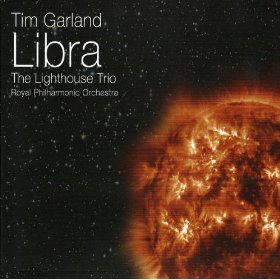 |
Tim Garland - The Lighthouse Trio, The Royal Philharmonic Orchestra (Libra Global Mix 2CD03)
|
The UK orchestrator of Chick Corea’s 2009 Grammy Award winning album ‘The New Crystal Silence’ further blurs the boundaries of jazz and orchestrated music with this double album featuring his Lighthouse Trio and the Royal Philharmonic Orchestra incorporating a live set. Garland’s spritely tenor, soprano & bass clarinet tones dance in an exotic setting with folk and world elements via the percussive harmonies of Asaf Sirkis’s Swiss hang, and bass udu. His commanding bass clarinet rivals the authority of the Orchestra’s booming kettle drums but at a turn is as sensitive as Sirkis’s feathery brushes. The Israeli’s kit is set with frame drums, small cymbals and tambourines abbreviating the beat, providing space and clarity for Gwilym Simcock to add depth, structure and innovative improvising and it doesn’t come any better than on ‘Bajo del Sol’ where the flamenco melody crashes through into Cuban territory. Paul Bollenback guests on a steel string guitar notably playing slide with a bottle neck to bluesy effect on ‘Hang Loose’. Although the trio was spliced in later, Garland’s previous experience in film and soundtrack provides a seamless synthesis between orchestra and trio. Autobiographical in concept, this is quite possibly Garland’s definitive album to date.
    
|
by Peter Wockner.
Previously published in Limelight Jan 10 |
|
Back to Index
|
|
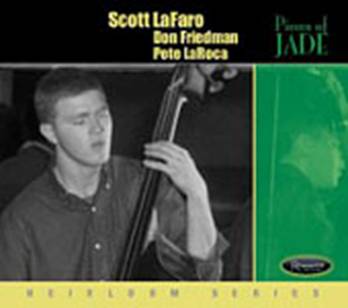 |
Scott LaFaro - Pieces of Jade (Resonance Records HCD-2005)
|
The bassist who died tragically in a car accident only days after the iconic Bill Evans Vanguard sessions never released an album as leader so newly discovered recordings are a welcome reminder of his inspiration to not only bassists, but instrumentalists such as Evans himself. Evans describes LaFaro as having “the largest, longest sound of any bass I’ve ever heard”. The disc includes a 13 minute 1966 insightful interview with Bill Evans on La Faro and a 22 minute poorly recorded rehearsal of “My Foolish Heart” which is tedious after the first listen but possibly a revelation to devotees for study purposes.
   
|
by Peter Wockner.
Previously published in Limelight Jan 10 |
|
Back to Index
|
|
 |
Andy Bey - Ain’t Necessarily So (Nocturne NTCD4509)
|
Andy Bey’s deep voice is an extraordinary instrument, ranging wildly over several octaves from the foggy depths to dramatic falsetto flights. In a long career he has been sadly under-recorded, which makes this album, taped live at New York’s Birdland club in May 1997 so important. Accompanied superbly by the Washingtons, bassist Peter and drummer Kenny, Bey stamps his mark on several standards including a percussively boppish ‘All The Things You Are’ and a soulful treatment of the title track. His tasteful keyboard style enhance an emotionally tender ‘Someone To Watch Over Me’. Worth the wait? You bet!
   
|
by Kevin Jones.
Previously published in Limelight Jan 10 |
|
Back to Index
|
|
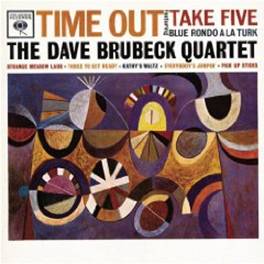 |
Dave Brubeck - Time Out (Columbia/Legacy 88697 39852 2)
|
This two-CD set and DVD is a fitting tribute to the now 89-year-old Dave Brubeck’s landmark album of 1959 which shattered the hegemony of four-bar swing with exotic time signatures like 5/4 and 9/8. It still sounds fresh and joyous! The album, rubbished by the critics, especially Ira Gitler in Down Beat, peaked at No.2 in the pop charts and ‘Take Five’ became a “hit”, selling a million copies. The previously unreleased Newport Jazz Festival performances are even better with fresh interplay by the quartet and more audacious soloing by Brubeck, Paul Desmond and drummer Joe Morello
    
|
by Kevin Jones.
Previously published in Limelight Jan 10 |
|
Back to Index
|
|
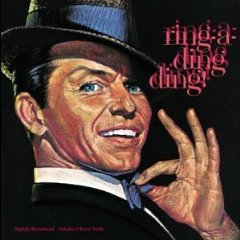 |
Frank Sinatra - Ring-A-Ding Ding! (Universal 0602527169163)
|
A jazz-flavoured swinging affair with arranger Johnny Mandel from 1961, this is one of Sinatra’s greatest albums! His first for his own Reprise label, it ranks with the cream of his concept albums for the Capitol label; ‘Songs For Young Lovers’, ‘In the Wee Small Hours’, ‘Close To You’ (with a string quartet) and ‘Only The Lonely’. With impeccable time and phrasing he kicks the big band along as he swaggers through unforgettable versions of ‘A Foggy Day’ and ‘In The Still Of The Night’ with a lower register that has seldom sounded richer and an upper register unstrained and clear.
    
|
by Kevin Jones.
Previously published in Limelight Jan 10 |
|
Back to Index
|
|
 |
The Dilworths (Jazzgroove/Kimnara)
|
This self-titled debut album by a youthful quintet of students and ex-students from Sydney’s Conservatorium is led by trumpeter Eamon Dilworth who composed all but one of the seven tracks. Although each member is aged in their twenties, they’ve all had extensive local and overseas playing experience. Joining Dilworth in the front line is saxophonist Karl Laskowski, an amazing player who performed in New York’s Carnegie Hall at the age of 17. The compositions are varied in style and reveal an exceptional level of ability, from the atonal car horn opening and eastern modality of “Lettin’ Loose,” to the soul-infused, relaxed Latino feel of “Satura.” Hugh Barrett’s piano is unobtrusively important in ensemble passages and contributes thoughtful, moving solos expertly crafted, as in “Grim Hell,” where he introduces Alex Boneham’s sturdily melodic acoustic bass, followed by a rapid-fire drum solo from Cameron Reid. “Laskowski by Nature” is a swinging post-bop piece featuring Dilworth’s trumpet flaring brightly before the tenor sax’s galvanizing lift-off in rocket trajectory. A subdued, but insistent piano riff steps through “Lili Song,” with the trumpet gradually developing the soothing theme, ahead of an offbeat transformation into a funky finale. Recording levels seem to vary throughout the album – a minor point – but the talent-packed Dilworths are a band to watch out for; their appealing compositions and articulate performances cannot be ignored.
   
|
by John McBeath.
Previously published in The Australian Jan 10 |
Here are five bright talents on the Sydney scene performing original music in a classic post bop instrumentation setting. Led by the trumpeter Eamon Dilworth whose compositions share sentiment with the soul of the Blakey and Silver bands or in the case of the highlight ‘Satura’, Abdullah Ibrahim. His trumpet is bright and brisk and his upwardly projected scrapes are as sharp as a razor but then trembles in a state of ecstasy. Sharing front line is the gifted saxophonist Karl Laskowski whose tenor applies restraint and sheer brilliance at the right moments; defying his age, playing with maturity and lashings of emotion.
  
|
by Peter Wockner.
Previously published in The Limelight Feb 2010 |
|
Back to Index
|
|
 |
Vehere - Unravelling (Newmarket)
|
Here’s another example of the increasing globalisation trend in contemporary music. Award-winning Brisbane pianist and composer Sean Foran – leader of acclaimed trio Misinterpretato – has formed the trio Vehere with Norwegian female vocalist Kari Bleivik and Belgian clarinettist Joachim Badenhorst, to record this album in the UK. The music is tranquil, at times celestial, with Bleivik’s mostly wordless vocals incorporated into the arrangements as a third instrument. Three tracks are Foran originals, there’s a Scandinavian folk song, several ballads, and a thoughtful re-working of “Things Behind The Sun” by doomed English romantic Nick Drake, and a couple more songs like this, with lyrics, would have been welcome. The ballad “Café” is one with lyrics and opens with a hoarse clarinet over a flowing piano before Bleivik’s voice enters softly developing strength as the song continues. There are many influences at work in the collection: contemporary improvisation often with classical references, world music, folk melodies, and jazz stylings. Piano and woodwind – both standard and bass clarinet – work well together exchanging ideas and sometimes dropping into counterpoint. Bleivik’s voice with her tonal purity suits these pieces and integrates well into the arrangements. Badenhort contributes substantial ensemble playing and empathetic solos, especially on the rich warm sounds of bass clarinet in “Unravelling”, while Foran’s piano moves in a fluent timelessness using restraint and intricate subtlety.
   
|
by John McBeath.
Previously published in The Australian Jan 10 |
|
Back to Index
|
|
Wangaratta Jazz Festival 2009 By Peter Wockner
The 20th anniversary of the Wangaratta Jazz Festival will go down as a year of exploration and discovery. Concerns were held about the overall depth and diversity of the program but also the adequacy of the new home of the festival, the brand new Performing Arts Centre. Despite all the planning and lobbying, there seems to be limited capacity to grow the festival at this new centre or indeed to accommodate larger audiences of the “household names” in jazz that this years festival was said to have lacked. Long queues in the hot sun remains an evergreen problem but even basic catering problems existed with the lack of available drinking water or even a coffee vendor amongst the unusual variety of curry, pancakes & mango pulp sellers. However, despite such issues ‘Wang’ never fails to produce several moments of musical magic and 2009 again had its fair share.
If there was just one performance that will be remembered of the 2009 Wangaratta Jazz Festival, it will be that of Andrew Robson’s Thomas Tallis Quartet. Standing ovations are few and far between for Wangaratta, but this was certainly one which was worthy and rightfully received. Robson formed the quartet to record the ABC Classics album ‘Bearing the Bell – The Hymns of Thomas Tallis’, but amazingly this was only the second time that the group had performed the works to a live audience. The Tudor composer is said to have written the hymns in the 1560’s and while Robson’s arrangements respect the heritage of the original composition, he breathed new life into the hymns and chose Sandy Evans, James Greening and Steve Elphick as his co-improvisers. Evans’s high register tenor flutters were like butterflies drawn to the colour, light and wonder of the Holy Trinity cathedral’s stained glass windows. The flexibility of Greening on pocket trumpet and both Evans and Robson doubling on soprano in addition to their usual tenor and alto provided a variety of unique spiritual settings to each piece. And just as these harmonies lingered in the vaults of the cathedral ribs, the memories of this performance will live in our hearts and minds for festivals to come.
The sound quality of the new Alpine MDF Theatre had its first real festival test when Australia’s leading jazz orchestra enjoyed the leadership of renowned New York trumpeter and composer Charles Tolliver. Following a Sydney performance, they opened the 2009 festival in typical Tolliver style. “I like to rumble” Tolliver says but was this really the “angry” music that was anticipated by one saxophonist? I think not, but it was intelligent, powerful, roof raising playing from the big band despite the difficulty in hearing soloists due to either poor mic placement or amplification levels. Tolliver temporarily left the stage midway through the title track of his current Halfnote release “Emperor March” leaving the orchestra looking like a flock of sheep that had lost their shepherd. Fortunately the music lost none of its authority thanks to Evan Mannell’s thunderous elvinesque drumming. Tolliver himself played only two blistering solo parts in an hour long performance so one had to wait for his quartet session with Mike Nock to hear his personal expressive personality at greater length.
Next on the Friday night trail was the New York drummer Ari Hoenig joined by Israeli guitarist Gilad Hekselman and Perth natives Jamie Oehlers and Sam Anning. These guys seamless reaction to Hoenig’s spasmodic rhythmic shifts were played with the cohesion of a group that had been performing together for years. From simply scratching the skins with his finger nails, within a few short seconds, Hoenig was able to reach a crescendo lifting the St Patrick’s Hall ceiling. Hoenig went on to win the hearts of the capacity crowd with his mallet mastery during Bobby Timmons’s ‘Moanin’. He played the lead melody on toms and snare while adjusting the pitch on his snare with his elbow. A ploy repeated throughout the festival to great effect also on Charlie Parker’s ‘Anthropology’.
To complete the opening night, Scott Tinkler arranged a special formation of the Australian Art Orchestra with Phil Slater also on trumpet plus the twin guitars of Carl Dewhurst and Stephen Magnusson and twin drum kits of Simon Barker and Ken Edie. The group was rounded by Marc Hannaford on piano and Phillip Rex on bass. The extended work ‘Folk’ took the audience on an hour long reflective and sometimes startling journey of open ended improvisation interspersed with composed sections of marvelous invention. The idea of Slater and Tinkler trading free flowing ideas against each other had the audience in great anticipation. Both employed their own special effects to the horn to the amazement of even other band members. At one point with eyes closed, Slater could have been playing the didgeridoo.
The pop and jazz world’s collided early on Saturday morning when the Louisiana Shakers performed ‘Ida Sweet as Apple Cider’ at the Hotel Pinsent. Derek Reynolds muting his trumpet, (unlike Scott Tinkler the night before, with the largest mute ever seen in Wangaratta, a galvanized ice tub), instead simply used the cap off his head.
One of the highlights of the festival was the piano of Matt McMahon with the Andy Fiddes AC/DC inspired group ‘Livewire’. McMahon seemed to open up his inner being to release the head-banger within, unleashing a series of rhythmic and harmonic avalanches, most notably on ‘Joystring’ the opening track of their self titled album.
The return of Wangaratta’s prodigal son, the winner of the first National Jazz Award in 1990, Barney McAll always brings some expectation. None more so than with his project ‘Sylent Running’ featuring the angelic voice and stage presence of Gian Slater. The textures of McAll’s piano and korg were augmented by the electronic darting samples from Dan West’s laptop.
Such is the rapport guitarist Carl Dewhurst has with trumpeter Phil Slater, drummer Simon Barker and pianist Matt McMahon, it was only a matter of time before he would be asked to join the Band of Five Names. The group’s swelling and retreating tidal flows of sonic waves naturally enveloped his amplified guitar. He caressed and coaxed the instrument in places normally considered unconventional at the very least. He had the guitar producing sounds ranging from a room full of mosquitoes on attack to a tom cat on heat, meanwhile Slater proceeded to play his horn with sections of tubing dangling like the music itself, in mid air.
Youthful Sydney group The Vampires played pieces new and old from their two most recent albums inspired by the dub beats and Carribean rhythms providing the festival with its first taste of some danceable melodic grooves. The intertwined harmonies of Nick Garbett’s trumpet and Jeremy Rose’s alto lit up the bright melodies of ‘The Beating Sun’ and other original pieces.
I much preferred hearing the Charles Tolliver trumpet in a quartet setting. His sharp ability to cut to the core of his ideas during soloing is a hallmark of his style. Tolliver is a master of that almost holy process of improvisers to distill and filter on the run but tonight it was the bassist Linda Oh who stole the show. Tolliver seemed genuinely in awe of her ability on double bass to propel the momentum of this quartet. While drummer Tommy Crane seemed to be under some heavy guidance by Tolliver. Mike Nock gave this multinational and multigenerational group the framework to swing harder than most.
Ex-pat bassist now forging a path in New York City Linda Oh was here in support of her fine debut album ‘Entry’. Oh’s originals are based around short repetitive riffs while her cross fingering explorations with lightning speed cut to the heart of her composition’s central themes. With the bassist was 2007 Thelonious Monk Jazz Trumpet award winner Ambrose Akinmusire. The trio’s intimate communication came from the focal point of Tommy Crane’s empathetic “feel play” on drums. An interesting variance was the intro to ‘We Want to Live’ which was sampled and inspired by what sounded like a speech by Winnie Mandela.
The Berliner’s led by pianist Carsten Daerr take their inspiration from Western Classical music, pop, rock and of course jazz. Drummer Eric Schaefer expanded his sonic range by the addition of 4 Asian gongs to his kit. Intermittent composed and free sections kept the audience second guessing from the delicate patter of ‘The Rain Man’ to the Bach like fugues of ‘Wide Angle’.
Meanwhile in a strange piece of programming, I cut from one German pianist to another in Laia Genc. She was joined by ferocious Australian saxophonist Adam Simmons who added the ungainly contra-alto clarinet to his options. Joining them were bassist Sebastien Gramms and the stiff wristed drummer Nils Tegen, whose deftly placed punches maintained a surefooted dance.
Aaron Choulai collaborators Carlo Barbaro and Eamon McNelis originally formed their quartet to perform the compositions of the now legendary Mark Simmonds. Their repertoire now reaches further into their own sound and style of which McNelis is rapidly discovering. His lengthy lines of invention on the trumpet flow with the natural freedom of a child at play.
The group led by the drummer Ronny Ferella ‘Ish Ish’ performed all original compositions by Ferella which, like his drumming are based around short sharp staccato stabs of sound. Stoking the fire was Julien Wilson on saxophones, Eugene Ball on trumpet and Jordan Murray on trombone. To complete the set, Ferella “rewarded” the audience with the Ornette Coleman tune ‘I Heard it over the Radio’.
The festival regular Paul Grabowsky and his sextet performed the final Sunday night concert, opening with a piece dedicated to saxophonist Dale Barlow ‘Snap Dance’. While this playlist was littered with material written in the 1990’s, in this setting each piece muscled up over and above their original proportion. ‘Angel’ from his album ‘Tales of Time and Space’ formerly a sober pop inspired piece of delicate beauty was transformed into a statement of grand indulgence. There is no doubting Grabowsky’s commanding stage presence as a leader. It is compelling to observe. Not content to simply guide the direction of the music, he spontaneously challenges the status quo of a wafting sound.
Large crowds attracted by the warm sunny weather discovered a number of new emerging names both nationally and internationally during this weekend. Now it’s back to the drawing board on how to sustain this festival in a functional but limited space.
Wangaratta Jazz Festival 2009 Reviewed by John McBeath (Previously published in the Australian Nov 09)
Unlike previous Wangaratta festivals, the twentieth anniversary edition had no overseas big names, throwing a welcome increased emphasis on the abundant and extraordinary Australian talent. Artistic director Adrian Jackson explained that reduced seating in the newly completed Wangaratta Performing Arts Centre, combined with difficulties in post-festival scheduling of any possible big names in capital cities had influenced his programming decision. There were a few overseas performers, notably US trumpeter and composer Charles Tolliver who fronted the impressive eighteen piece Sydney big band Jazzgroove Mothership Orchestra at the Friday night opening concert. They presented Tolliver’s compositions and somewhat standard arrangements and although the American played only three or four passionate but staccato solos, the band’s soloists, Richard Maegraith and leader David Theak on tenor and alto saxes respectively, really stood out. Despite a wealth of new hi-tech equipment the performance suffered from poor mixing. Later in a quartet format Tolliver stretched out more but was almost overshadowed by Sydney pianist Mike Nock, expatriate Australian bassist Linda Oh and the exciting young US drummer Tommy Crane.
This festival may go down as the year the music deconstructed. The ethos is that all sound can be music, and those sounds might be produced by drone strings plucked in the back of Carl Dewhurst’s modified guitar. They could be Scott Tinkler immersing his trumpet bell in water or Phil Slater developing a range of unorthodox trumpet sounds from breathy notelessness, to rhythmic key tapping, to blowing the partially dismantled instrument. The challenge will be for the practitioners to take audiences with them in this evolving development. Not everyone at Wangaratta was appreciative but this is serious music delivered by highly talented musicians, where the idea is to improvise and amalgamate sounds for particular effects. Its successful production requires an almost telepathic musical rapport, such as exists between Tinkler and drummer Simon Barker. Their duo demonstrated a high level of inter-neural improvisation, as Tinkler worked over and developed phrases which Barker either embroidered, punctuated or soloed upon. Another successful local duo in this genre was grand old master Mike Nock’s always inventive piano paired with sympathetic drumming by Niko Schauble.
Australian pianist Barney McAll, now based in New York, composing for his sextet Sylent Running was among the most successful of the experimental, probably due to McAll’s brilliant conceptual structures, allowing for improvisation, and adding a laptop operator and electronica to conventional instruments. He also included the sometimes wordless, ghostly vocals of Gian Slater. The composer asked the audience to imagine the music being for a future scenario where self-generating technology has seen humans become dinosaurs. This and other experiments in sonic abstract expressionism, such as the Tinkler led Australian Arts Orchestra suite “Folk”, and Phil Slater’s Band of Five Names were at the outer edges of an expanding jazz galaxy. When it worked it offered a glimpse of possible future directions.
New York drummer Ari Hoenig’s quartet featured award-winning Israeli guitarist Gilad Hekselman, and two Australians, the highly-talented saxophonist Jamie Oehlers and outstanding bassist Sam Anning to play Hoenig’s impressive compositions. There was an astonishing rendition of the standard “Moanin’” where Hoenig played several choruses of the melody using mallets and achieving a tuning of the drums by depressing the skins with his elbows.
Ex Brisbane vocalist Kristin Berardi’s sextet included high quality Brisbane artist James Sherlock who backed her impressively with solo guitar on her latest CD, “If You Were There,” and she sang her compositions from that album, her voice floating in a cool restfulness. Also in her line-up was husband David Theak who added high-flying, excitement-stoking solos on tenor sax.
First up on Sunday morning was the exceptional bassist Linda Oh’s trio. Growing up in Perth, she is now New York based, and brought the fiercely gifted young US trumpeter Ambrose Akinmusire with her, along with master integrationist drummer Tommy Crane. Twenty seven year old Akinmusire plays with the technique and maturity of someone twice his age, sometimes holding long notes against a fast-moving bass and busy drums, and during one of his amazing solos played a series of choked-off, half-valved low notes interspersed with a shrieking blast of exhilaration two octaves higher on an occasional off beat. Pianist Laia Genc led her German trio with Melbourne saxophonist Adam Simmons contributing an intelligent front line including one piece on a hugely improbable contra-alto clarinet with subterranean woodwind sounds. A rip-roaring set from Paul Grabowsky’s sextet was the festival finale, driven by Philip Rex’s powerhouse bass as Grabowsky gyrated gymnastically at the piano.
Across the river among the trees, the blues marquee pumped out its roots music in the familiar twelve bar format so beloved of its devotees.
This year’s saxophone national award prize went to Zac Hurren, with Phil Noy second and Jacam Manricks third, all ex-students of the late Brisbane musician Tony Hobbs.
|
|
Back to Index
|
|
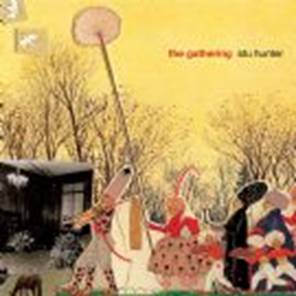 |
Stu Hunter - The Gathering (Vitamin Records)
|
It comes as no surprise to learn that “The Gathering,” a suite by Sydney pianist/composer Stu Hunter received an instantaneous standing ovation at its debut live performance at the Sydney Opera House. Following the universal acclaim for Hunter’s 2007 quartet recording “The Muse”, he has retained that group and added two more of Australia’s best musicians for this outstanding album with brilliantly exceptional results on every level from production to performance. Hunters’ compositions provide an enormous variety of structural form as if every creative concept from jazz beginnings to the avant-garde mixed with a universe of other influences had been deconstructed by a musical alchemist and reassembled into an original, utterly absorbing, hour-long work. All of the soloists are superbly capable of the highest quality interpretation and improvisation required, especially the extraordinary piano playing of the leader. James Greening supplies a range of trombone and trumpet solos and effects of satisfying empathy, while tenor saxophonists Matt Keegan and Julien Wilson add varying virtuosic textures from excitement to soliloquy. Drummer Simon Barker has an important role in both rhythmic and out-of-tempo passages, all handled adroitly, and Cameron Undy’s precise bass brings imaginative solos as well as delivering the ensemble substructure. This album represents a milestone in contemporary Australian jazz, intelligent, expressive and innovatory, at times achieving an almost symphonic level.
    
|
by John McBeath.
Previously published in the Australian Dec 09 |
|
Back to Index
|
|
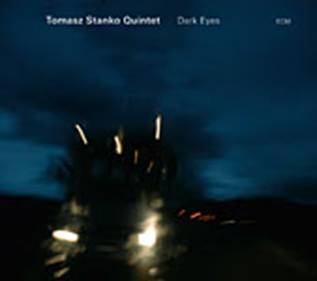 |
Tomasz Stanko Quintet - Dark Eyes (ECM/Fuse Music)
|
Both the personnel and the playing stamp this album as high quality Eurojazz. Polish trumpeter Tomasz Stanko is joined by two Finns: pianist Alexi Tuomarila and drummer Olavi Louhivuori, and two Danes: bassist Anders Christensen, and guitarist Jakob Bro for a session of ruminative beauty. Stanko’s style is reminiscent of Miles Davis (a major influence); the same relaxed pace and virtuosic economy of expression, but with a grainier tone and drawing more upon classical references. The music is meditative, even melancholic at times, but then occasionally, as in “The Dark Eyes of Martha Hirsch,” after a tranquil opening the trumpet flares out in a quick tempo with cascading runs and raw, passionate shrieks. Tuomarila’s piano is especially well suited to the Stanko style, especially in “Dirge for Europe” where the opening and his solo of slow-stepping chords crested by dreamy treble waves are perfect vignettes. “Last Song” is a haunting re-interpretation of a song from Stanko’s 1975 album “Balladyna,” with a mournful classical-like theme and an opportunity for everyone to solo, including a melodic rendition from drummer Louhivuori. Although some of the tracks swing at times, the overall approach is of cerebral tranquillity and intelligent restraint. At first “Samba Nova” has no detectable samba beat, instead painting a textural surface altogether out of tempo until midway through the lengthy piece when a drum solo establishes a discreet latino feel.
    
|
by John McBeath.
Previously published in the Australian Dec 09 |
|
Back to Index
|
|
 |
Bernie McGann - Solar (Rufus Records RF 093)
|
Recorded in 2006 at the Sound Lounge, this live 2 CD set was the first occasion for the visiting NZ tenor titan Roger Manins to join the regular McGann band at the time. Four of McGann’s hardest swinging originals are punctuated by four ballads. The album opens with McGann’s ‘Birthday Blues’. The dialogue is apparent early when John Pochee drums set up a military beat and Alder responds with a cavalry charge but their guns don’t really start smokin’ until ‘D-Day’ when McGann cryptically reconciles his phrases with a tone as dry as the kindling in the Royal National Park and gritty as urban graffiti. His Australian anthem ‘Spirit Song’ made even more spiritual simply by changing the original third note ‘D’ to a bending C sharp to D. Then on disc two, a medley of ‘Lover Man’ featuring McGann, ‘Where are You’ featuring trumpeter Warwick Alder and loping cymbal work rather than brushes by Pochee followed by ‘My Old Flame’ featuring the bluesy brazen Manins.
   
|
by Peter Wockner.
Previously published in Limelight December 09
|
Award-winning Sydney alto saxophonist, Bernie McGann is now a member of that very select group: a grand old master of Australian jazz. Using long-term associates, drummer John Pochee, bassist Lloyd Swanton, and Warwick Alder on trumpet, the session added New Zealand tenor saxophonist Roger Mannins. The album was recorded live at the SIMA Sound Lounge in 2006 with music composed by McGann, except for one track of a standards medley. The format is a familiar one where everyone has space to stretch out in extended solos – and these are all top-flight soloists – with plenty of fiery and inventive exchanges. There are just three tracks on each disc and several of McGann’s memorable compositions are featured including “Sprit Song” and “Blues for Pablo Too.” The collection opens with “Birthday Blues” in a bop-like ensemble scoring, launching McGann’s blazing solo with his characteristic trademarks: the raw tonality; surprising phrases of jagged intensity; odd quotes, and spectacular leaps into the upper register. The following trumpet solo, at first seems calming, but soon Alder is pushing the horn into the high register with fast runs and adventurous ideas. Mannins’s tenor solo also begins in a stately fashion giving way to exciting runs in quadruple time with Pochee and Swanton expertly tying it all together throughout. McGann, now facing his mid-seventies, here leads a milestone collection of monumental talent.
    
|
by John McBeath.
Previously published in The Australian Jan 10 |
|
Back to Index
|
|
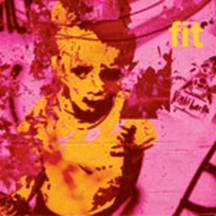 |
Fit (Rufus RF085)
|
The trio of Alister Spence piano, Lloyd Swanton bass & Toby Hall drums & Glockenspiel have released their fourth album which is an atmospheric affair designed to complement and ignite reaction against the video art of Louise Curham and indeed it conjures moving images of its own. All the tracks save ‘Another October’ (Spence) are a genuine collaboration in relation to composition. A series of slow motion pop sound bytes or oscillating waves reaching satisfying crescendos or even a high voltage hum; brittle sounds of the glockenspiel or scraped piano and bass strings sucked into a hyper-vacuum while a service desk bell resonates within the interior of the piano. Remnants of convention appear late before further sampled piano scatters gradually roll over in intriguing layers of sound. Also included is a DVD of Curham’s video art.
   
|
by Peter Wockner.
Previously published in Limelight December 09 |
|
Back to Index
|
|
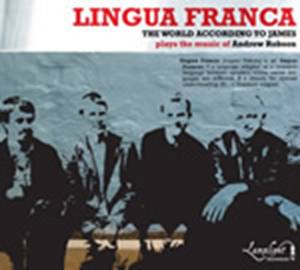 |
The World According to James - Lingua Franca (Lamplight Records LLR00309)
|
From the opening moments of Steve Elphick’s broad double bass tone and Toby Hall’s snappy rim shots on drums, the aesthetics are set for this their third and finest recording in what has been long association for this band. On ‘Cosmology’ James Greening’s pocket trumpet and Robson’s alto blur the straight unison line in Ornette Colemanesque fashion; blurred enough to almost solidify the sound into a shifting 3D impression. The absence of a piano allows the listener to soak up the ranging reconnaissance harmonies of Elphick’s bass. I love the tradition in Greening’s trombone, sliding and growling but always seeming to fit his own context of what is contemporary. All the tunes were penned by alto saxophonist Andrew Robson and most have the inventiveness I likened to some of the best John Sangster left us, especially the blues selections. Lingua Franca is a highly original and incessantly groovy creation.
    
|
by Peter Wockner.
Previously published in Limelight December 09 |
|
Back to Index
|
|
 |
Judy Campbell’s Mosaic - Waters of Kenya (Maju Music MAJU09-5.1)
|
It’s quite an accomplishment when music can simultaneously rest on its own established artistic merit and bring an acute awareness to a cause much greater than simply charitable purposes. That’s what Campbell’s group has achieved with this new EP, which contains five pieces at length and two brief solo interludes about the plight of Kenyans in their struggle for clean water. Using similar vocal textures and regional rhythms from their album ‘Colours’, including Kenyan percussionist Bandika Ngao, Mosaic have been re-ignited by the undercurrent of bassist Karl Dunicliff, the force of Tim Firth’s drums and the nimble pianist Greg Coffin.
   
|
by Peter Wockner.
Previously published in Limelight December 09 |
|
Back to Index
|
|
 |
Barbra Streisand - Love Is the Answer (Columbia 88697 48283 2)
|
This Diana Krall produced album, Barbra Streisand’s first in four years, could be called a jazz album in only the loosest sense of the word. It owes more to the traditional popular music field, especially on the first of the two-disc deluxe set where Johnny Mandel’s subtle orchestrations, which leave room for Krall’s piano, result in superior mood music. But with those by the jazz quartet, and a bevy of first-class pianists: Krall, Bill Charlap. Alan Broadbent and Tamir Hendelman, they also emphasise Streisand’s enduring quality as a singer. At 67 her voice is remarkably fresh although a sense of breathiness has replaced the high notes of yore and her lower register is mellower as she quietly and intimately uses the same slow ballads on both discs to reflect on love. She counters Sinatra’s boozy regret ‘In The Wee Small Hours’ with a wistful tenderness; whispers through ‘Ne Me Quitte Pas’ accompanied by Anthony Wilson’s guitar; even hints at jazz on a superb ‘Smoke Gets In Your Eyes’; and recalls her early days as a club singer at The Bon Soir in New York’s Greenwich Village with ‘Spring Can Really Hang You Up The Most’. A lovely understated album.
    
|
by Kevin Jones.
Previously published in Limelight December 09 |
|
Back to Index
|
|
 |
Nik Payton & Bob Wilber - Swinging the Changes (Arbors ARCD 19358)
|
Just as the great New Orleans soprano saxophonist Sidney Bechet recorded with his protege Bob Wilber more than 60 years ago, the 81-year-old veteran has done the same with accomplished English reed player Nik Payton who was only 15 when Wilber began mentoring him 20 years ago. This is not a duelling session between the former master and pupil. Instead Wilber (alto and soprano) and Payton (tenor) just enjoy their musical company for the first time on record, blending easily in the unison passages and soloing with melodic flair especially on ‘No More Blues’ and the two-clarinet feature ‘Skybloo’.
   
|
by Kevin Jones.
Previously published in Limelight December 09 |
|
Back to Index
|
|
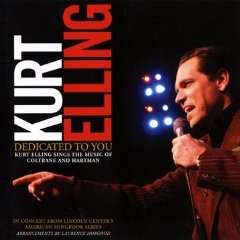 |
Kurt Elling - Dedicated to You (Concord 7231314)
|
Kurt Elling reaffirms himself as the most original male vocal interpreter in jazz today. In a live tribute to two unlikely collaborators, John Coltrane & Chicago song stylist Johnny Hartman, particularly their 1963 recording, Elling adds selections from Coltrane’s ‘Ballads’ album. The irony rests in the ‘poetic memory’ (an overly romantic history lesson) when Elling’s monologue recalls that the pair had no real rehearsal and carried no charts into the studio, yet these superb Laurence Hobgood arrangements are embellished by a string quartet! Ernie Watts might have been an odd choice as tenor saxophonist since his smooth style reverses the role of Hartman’s original foil against the more abrasive Coltrane. But it works. The majority of the tracks are spliced into two medley’s with the title track featuring the string quartet gorgeously plucking a riff against the melody while Elling’s interpretation of ‘Lush Life’ is one of the finest you’ll hear.
    
|
by Peter Wockner.
Previously published in Limelight November 09 |
|
Back to Index
|
|
 |
Simon Tedeschi & Ian Cooper - Quintet (S&I Records 0S001)
|
With the pleasantry of ‘Body and Soul’ and ‘It Had to be You’ among the selections, and violin in the front line my immediate reaction was ‘novelty value only’ but I was wrong and found some satisfying moments on this date with guests. James Morrison’s features on 4 tracks, most notably his trumpet exchanging fire with Cooper on ‘I Can’t Believe that You’re in Love with Me’. A prominent classical pianist, Tedeschi adds an impressive array of ideas, channelling Bach via Loussier during ‘All the Things You Are’ and solidly supporting some unlikely selections such as Miles Davis’s ‘Walkin’ and Oscar Pettiford’s ‘Tricotism’.
  
|
by Peter Wockner.
Previously published in Limelight November 09 |
|
Back to Index
|
|
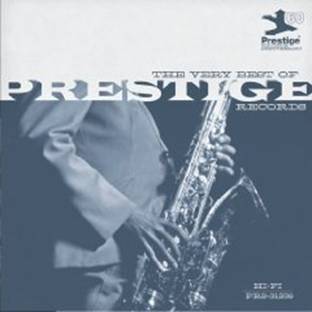 |
The Very Best Of Prestige Records (Universal Music 08880 723 12395)
|
“Classic” is the most overused word in music but this double CD set celebrating the 60th anniversary of this important record label founded by Bob Weinstock in 1949 has many tracks more than deserving of the title, especially those by giants like Miles and Monk and the tenor titans Sonny Rollins and John Coltrane. And that’s not even scratching the surface! This treasure trove begins with ‘Subconscious Lee’ with Lee Konitz and Lennie Tristano from their first session. Other memorable tracks, and there are many, include Miles’s ‘My Funny Valentine’, Rollins’s original ‘St Thomas’ and the MJQ’s ‘Django’.
    
|
by Kevin Jones.
Previously published in Limelight November 09 |
|
Back to Index
|
|
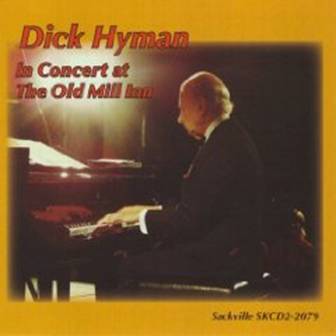 |
Dick Hyman - In Concert at The Old Mill Inn (Sackville SKCD2-2079)
|
At ease in any setting whether it be ragtime, boogie woogie, stride, swing or bop, the chameleon of the jazz piano practically knows no bounds as a player. Since the 1950s Dick Hyman has made his name as a pianist, organist, arranger, musical director and composer and at the age of 82 he shows no signs of slowing down. His versatility and knowledge of all piano styles is displayed in this virtuostic solo performance before an appreciative Toronto audience in 2007. With nothing to prove he revels in saluting Fats Waller, the Gershwins, Benny Goodman and even The Beatles. Masterful display.
   
|
by Kevin Jones.
Previously published in Limelight November 09 |
|
Back to Index
|
|
 |
Nicki Parrott - Fly Me To The Moon (Venus Records VHCD1023)
|
Think Julie London with her sexual coquettishness. Listen to the sensuality of Nicki Parrott on ‘Do It Again’ with Harry Allen’s tenor the perfect foil. (Do it again? She has with a new album on the Arbors label with Italian-born pianist Rossano Sportiello). The Australian-born vocalist-bassist’s second album for the Japanese label has been worth the wait, not only for her singing, sultry and relaxed, which goes from strength to strength; dig the beautiful ‘La Vien Rose’ and the admirable support she receives from her sister Lisa (soprano and baritone), the inventive pianistics of John Di Martino and the guitars stylings of Mark Sganga.
   
|
by Kevin Jones.
Previously published in Limelight November 09 |
|
Back to Index
|
|
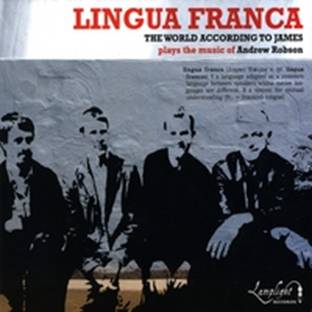 |
The World According to James - Lingua Franca (Lamplight Records LLR00309)
|
Sydney quartet, The World According to James formed in 1992, has enough musical experience and technique after seventeen years to have evolved its own Lingua Franca or common language to a finely honed degree, and this album proves the point. Playing compositions by the band’s saxophonist Andrew Robson, leader of his own acclaimed trio, the opening track, “Keep No Secrets, Tell No Lies,” sets the tight frontline of alto sax and James Greening’s trombone against a Latino backdrop provided by Toby Hall’s sparing drumbeats and Steve Elphick’s acoustic bass. Both Robson and Greening are expert soloists and alto taking the first solo leans right into the rhythm, quadrupling it in swinging style, while the trombone strides out with flair, blare, and triple tonguing, cavorting like the leader in a Brazilian street parade. The piece concludes in a deceleration to almost breakdown point. Greening’s other instrument is the pocket trumpet, having the same range and a similar sound to a full size trumpet. The longest track, “Tropic of Capricorn,” commences with the pocket trumpet voicing a pretty melody line in a minor modality against a ballad rhythm with strummed double bass chords beneath. The title track, “Lingua Franca” is dedicated to Sydney pianist Mike Nock and works as a deconstructed blues, moving into a march tempo for a bass solo, while the trombone passage is trad-like but laced with Greening’s characteristic humour.
   
|
by John McBeath.
Previously published in The Australian November 09 |
|
Back to Index
|
|
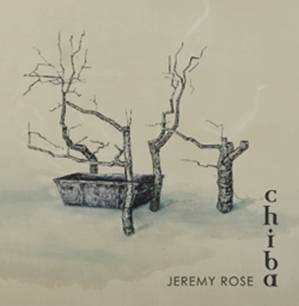 |
Jeremy Rose - Chiba (Earshift Records EAR 003)
|
Sydney saxophonist and composer Jeremy Rose, winner of the 2009 Bell Award for Young Australian Jazz Artist of the Year, leads this Australian-Norwegian project through a diverse collection of his innovative compositions. Guitarist Kim Johannesen and bassist Adrian Myhr are the Norwegian players, and Sydney drummer Alex Masso completes the quartet. Rose and Masso work together elsewhere, especially well in the jazz-reggae group The Vampires, and their acclaimed 2008 release “South Coasting.” Several of these new tracks have evolved from rhythmic post-bop styles, notably “Digression” with its alto and guitar in unison theme statement, but a different styling arrives with abstract tempo changes and thoughtful solos that are cameos of relaxation and restraint. There is a cool Nordic atmosphere throughout the album where high-energy pyrotechnics are unnecessary; instead there’s a serenity that often swings in its own unique way, even in waltz time on “Oslo Solo.” Other tracks eschew rhythms altogether: “Avant Garden” is a soundscape featuring a beautifully bowed double bass, a guitar backdrop and percussive effects for Rose’s dreamy alto moving from introspection into a quickening heartbeat. “I Saw Blue Then White” opens with transcendent sounds leading into a commanding Spanish-influenced alto passage fronting the trio’s textural wash. “The Phoenix” is the most groove-based piece with flying guitar plus an insistent sub-structure and a smart chordal solo from Myhr’s bass.
   
|
by John McBeath.
Previously published in The Australian November 09 |
Chiba represents a Sydney/Oslo project for the debut of the alto saxophonist’s wry compositions. These sounds seem to thrive untouched like spikey weeds in the barren environment of a median strip. Forming the quartet are guitarist Kim Johannesen and bassist Adrian Myhr while Sydney drummer Alex Masso provides colour splashes and splays of taunting tension between the spatial crevices created by guitar and bass. Rose shows us subtle glimpses of a marvelous technique and plays with the restraint of a mature master. Johannsesen might be a monster with the axe elsewhere but his talent shown here is firmly grounded in emotional control.
   
|
by Peter Wockner.
Previously published in Limelight Feb 2010 |
|
Back to Index
|
|
 |
Tina Harrod - Temporary People (Vitamin Records VT 0054)
|
Following her award-winning “Worksongs”, Sydney vocalist Tina Harrod has produced an intensely personal album of her own lyrics set to melodies by bassist Jonathon Zwartz, and three by her late partner, musician Jackie Orszacky to whom this recording is dedicated. The usual love and loss themes take on a truer, deeper meaning here as Harrod’s wrenching words trace out her life and feelings with Orszacky and the finality of his loss. The music is heavily soul-inflected and, as with the former album, features outstanding backing from pianist Matt McMahon, bassist Jonathon Zwartz, and Hamish Stuart on drums. Several guest artists make appearances, notably James Greening’s trombone solo, aching with longing, on “Seven Days,” and Bernie McGann’s suitably melancholy alto sax on “Blue On The Inside.” Harrod’s style embodies both force and fragility and the use of back-up vocals – some incorporating her own voice – enables moving call and response passages, especially effective in “Temporary People,” a reminder of impermanence. There are many insightful lines in these songs: “You’re so unsafe, just like my high heeled shoes, on a downhill slope,” captures an observation with poetic lyricism. Nearly all of the lyrics are suffused with pain, nostalgia, and sadness but the music lifts and transcends with its universal themes: “And the time stood still, just like winter frozen on the ground.”
   
|
by John McBeath.
Previously published in The Australian November 09 |
|
Back to Index
|
|
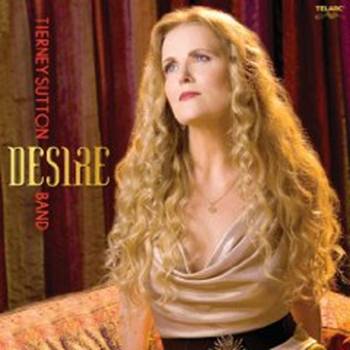 |
Tierney Sutton Band - Desire (Telarc CD 83685)
|
This is an extraordinary album. The exceptionally gifted Los Angeles-based vocalist Tierney Sutton takes a philosophically spiritual journey with jazz as the vehicle on a meditative theme on society’s obsession and desire for fame and materialism, beginning and ending it with a few texts from her Baha’i faith. Originally inspired by the music of Cole Porter, there are two of his songs among the nine standards, but the way Sutton and her band of 15 years – brilliant pianist Christian Jacob, bassists Trey Henry and Kevin Axt and drummer Ray Brinker – interpret them adds a hidden but emotional meaning to the original lyrics; something that becomes more apparent with repeated listening. Sutton cynically manipulates the lyrics of ‘My Heart Belongs to Daddy’, ‘Skylark’ and ‘Love Me or Leave Me’ to emphasise heartbreak, and although many have covered ‘Fever’ none are as striking as this stark version with Brinker and Henry. Truly a work of art.
    
|
by Kevin Jones.
Previously published in Limelight October 09 |
|
Back to Index
|
|
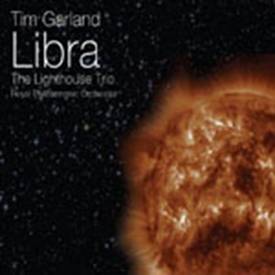 |
Tim Garland (The Lighthouse Trio) - Libra (Global Mix GM2CD03)
|
London saxophonist Tim Garland, leader of The Lighthouse Trio, has been described as one of the UK’s most successful musical exports working in jazz, but much of his music goes beyond conventional jazz boundaries into eclectic visions of new music. One example of Garland’s astonishing variety in this major work is the four part suite “Frontier” where the trio is accompanied by the Royal Philharmonic Orchestra, conducted by Garland in a fine balance of the languages of jazz and classical music. With pianist Gwilym Simcock and Israeli percussionist Asaf Sirkis using an unusual array of frame drums, bass udu (a Nigerian clay pot drum) hang drum – with a sound like a small steel pan – and tiny cymbals, Garland plays soprano and tenor saxes, bass clarinet, or bass flute with equal fluency. The resulting sounds are uniquely individual drawing on various influences, a “Diverse Unity” as Garland puts it, to produce free improvisation often employing a Middle East rhythm in ten beats, or a classical interlude, or a piano and percussion duet, or Garland fronting the trio in full-on swinging mode. Most tracks are Garland’s impressive compositions, except for three jazz pieces, including Charles Mingus’s “Nostalgia in Times Square,” where Simcock’s piano moves through grooving fugue-like passages and guest guitarist Paul Bollenback adds a heroic climax.
    
|
by John McBeath.
Previously published in The Weekend Australian 31/10/2009 |
|
Back to Index
|
|
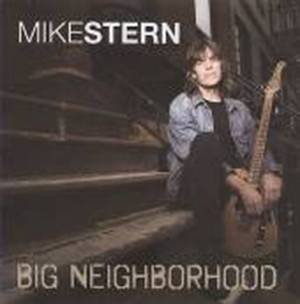 |
Mike Stern - Big Neighborhood (Heads Up/Fuse HUCD 3157)
|
New York guitarist Mike Stern’s neighbourhood is certainly big; there are fifteen guest artists on this album of originals by Stern, a five times Grammy nominee. The opening title track with howling guitars in rock fusion mode from Stern and ex Frank Zappa guitarist Steve Vai is not representative of the rest of the album. Vai also appears on the smartly titled “Moroccan Roll” playing sitar as well as guitar in a rock with Eastern influences piece. Rising star Esperanza Spalding contributes haunting, wordless vocals and acoustic bass on three numbers, including a jaunty up-tempo “Coupe de Ville” based on a favourite Stern standard, “There Is No Greater Love.” That track also features fine post-bop solos from Stern and saxophonist Bob Malach after a guitar and sax unison statement of theme. On the fast moving, African-flavoured “Reach” Stern collaborates with the impressive bassist/vocalist Richard Bona, after their successful pairing on 2006’s “Who Let The Cats Out?” In “Long Time Gone” Stern is joined by Texan Eric Johnson on soulful slide guitar with a sprawling Hammond Organ backdrop by producer Jim Beard who is on most tracks on piano. This widely varied album showcasing Stern’s surprising versatility concludes with a swinging “Hope You Don’t Mind,” featuring Randy Brecker’s trumpet from the Clifford Brown-Freddie Hubbard school and powerhouse drummer Cindy Blackman.
   
|
by John McBeath.
Previously published in The Australian 2009 |
|
Back to Index
|
|
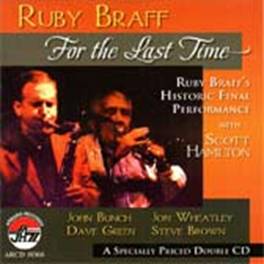 |
Ruby Braff - For The Last Time (Arbors ARCD 19368)
|
It was as if the cornet doubled as an oxygen mask as Ruby Braff, in a wheelchair propped up by pillows, battled the advanced stages of emphysema in a sublime final performance at the Nairn Jazz Festival in Scotland on August 7, 2002. The most melodic cornet player jazz has known had difficulty breathing. The length of the numbers might have been an indication; they enabled him to regain his breath before soloing. But his masterly playing, especially on Jerome Kern’s ‘Yesterdays’ with his long-time friend, tenor saxophonist Scott Hamilton, defied this frailty. An album to treasure.
    
|
by Kevin Jones.
Previously published in Limelight October 09 |
|
Back to Index
|
|
 |
Melissa Morgan - Until I Met You (Telarc CD83684)
|
With the tidal wave of young female “jazz singers” showing no sign of receding, it is a pleasure to hear the real deal in the richly expressive voice of Melissa Morgan who, on the evidence of her debut album of ballads and blues, is headed for stardom. Like her idols, Billie Holiday, Dinah Washington and Sarah Vaughan, she makes a song her own with the warm whispered intimacy of a voice that is sultry, sensual and even sexy!. Excellent backing is provided by the quartet of pianist Gerald Clayton and the impressive trumpeter Christian Scott.
    
|
by Kevin Jones.
Previously published in Limelight October 09 |
|
Back to Index
|
|
 |
Coffin Brothers - Living in Apocalyptic Times (Krishandtali Records KATR-02)
|
This is the second album from the Sydney based saxophone and piano brotherhood following up on the release of a live 2004 performance, with a studio session of deliciously chewy post bop. Sean Coffin’s gruff and gristly tenor breathes unrelenting bursts of energy into nearly every original except the slow samba ‘Cutez’ and ‘This Much’ with sombre dark shadows rivalling ‘St James Infirmary’. ‘70’s Moustache’ has an atonal urgency while ‘7 Bits of New Orleans’s second line morphs into a briskly swinging chart. The quartet is expertly rounded by Brett Hirst on bass and Simon Barker on drums.
   
|
by Peter Wockner.
Previously published in Limelight October 09 |
|
Back to Index
|
|
 |
Tom Harrell - Prana Dance (Highnote HCD 7192)
|
The trumpeter’s career continues to triumph over adversity considering his ongoing paranoid schizophrenia and few would argue that this is his greatest album yet. This is his 24th album as leader but the second with this particular quintet featuring the highly talented saxophonist Wayne Escoffery. The abundance of creativity from Harrell’s horn could be compared to the prolific improviser Sonny Rollins. Highly logical solos using melodic patterns embellish these arrangements to form a creative and thematic production but the arrangements never intrude on the album’s ‘in the moment’ post bop feeling especially during improvisation and group interplay. When meditated on against each composition title, the album soon acts as a figurative narration like ‘Kind of Blue’ or ‘Maiden Voyage’. Prana features lyrical harmonic lines between Harrell and saxophonist Wayne Escoffery so synchronous that they breathe as one. ‘Maharaja’ has tempting shuffling backbeats, while ‘The Call’ opens with angular staccatto harmonies featuring Danny Grissett on fender rhodes, Escoffery on soprano and Harrell’s trumpet. ‘Ride’ is a funky bumpy journey while ‘The Sea Serpent’ drifts along via Grissett’s rhodes into a loping moderate swing but nothing I’ve heard this year swings as pleasingly as ‘Sequenza’. This will be in my top ten this year.
    
|
by Peter Wockner.
Previously published in Limelight October 09 |
|
Back to Index
|
|
 |
Roil - Meaning (Rufus RF099)
|
Open-ended improvisation need not be without context as The Necks’s piano man Chris Abraham’s and his two younger co-horts evoke the solitary personal space of ‘Food and Board’ with its squeaking doors and wind chimes, or the fidgety, insatiable and tireless urgency of a file of ants on ‘Fauna of the Tiles’ . The trio take a leap of faith in each other to forecast the unknown rather than the known using the piano, bass and drums as tools of trade in the pursuit of possibility rather than probability. Six pieces, relatively short in duration, keep this challenging work within reach.
  
|
by Peter Wockner.
Previously published in Limelight October 09 |
|
Back to Index
|
|
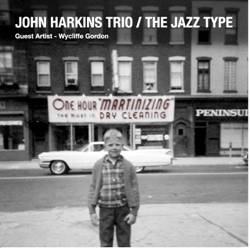 |
John Harkins Trio - The Jazz Type (www.harkins.com)
|
This is the trio of choice for a number of visiting US artists including trombonist Wycliffe Gordon, veteran of the Wynton Marsalis septet featuring on three tracks. While Gordon’s startling technical bravado might be out of context on Ellington’s ‘Prelude to a Kiss’, the focus remains on Harkins swinging some well beaten chest nuts along with one or two lesser known gems such as Benny Golson’s ‘Along Came Betty’ where the engaging banter between his right and left hand becomes an abruptly heated debate. The tucked tight groove between bassist Brendan Clarke & drummer Andrew Dickeson is becoming increasingly telepathic
   
|
by Peter Wockner.
Previously published in Limelight September 09 |
|
Back to Index
|
|
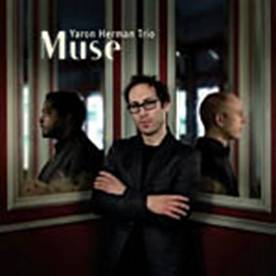 |
Yaron Herman Trio - Muse (La Borie Records LJ06)
|
Muse is the second offering of this ensemble led by the Israeli born 28 year old pianist now based in Paris. Fast becoming a phenomenon in Europe, Herman has added a string quartet as a lush melodramatic backdrop to a number of these pieces, which cover a variety of moods from the lonesome probing bass solo of Matt Brewer to the rollicking rhythmic gear shifts akin to Aron Ottignon’s Aronas. Dizzy’s gorgeous ‘Con Alma’ receives a faithful rendering around a delightful harmonically cryptic solo by the pianist, while ‘Lamidbar’ opens with Herman plucking the piano, harp-like using Yiddish rhythms and patterns. Exceptional!
    
|
by Peter Wockner.
Previously published in Limelight September 09 |
|
Back to Index
|
|
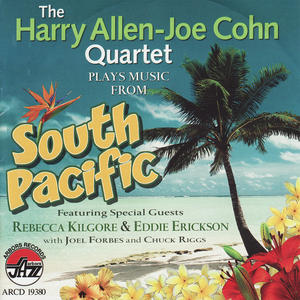 |
The Harry Allen-Joe Cohn Quartet - Music From South Pacific (Arbors ARCD 19380)
|
It’s a long time since I’ve listened to such an enjoyable and entertaining album. A great Broadway musical, a superb quartet which swings as naturally as breathing, and two singers, Rebecca Kilgore and Eddie Erickson, who uphold the theatre tradition without losing that jazz touch. Only three instrumentals, but Harry Allen’s tenor is heard on each track. His is the dominating voice: joyfully reviving memories of the great Zoot (Sims) on Bloody Mary and striking a Websterish (Ben) mood on the lovely ‘Balai Ha’I’ and ‘Some Enchanted Evening’. Jazz and the theatre combine and what a swinging affair it is!
    
|
by Kevin Jones.
Previously published in Limelight September 09 |
|
Back to Index
|
|
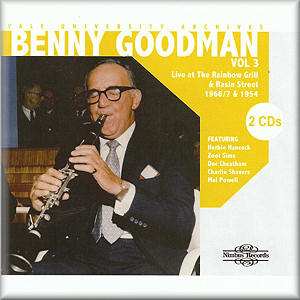 |
Yale University Archives, Volume Three - Benny Goodman (Nimbus NI 2723/4)
|
At last, an album by the legendary King of Swing in the centenary year of his birth. The three live broadcasts, culled from the Benny Goodman Archives at Yale University, are from the Rainbow Grill in the Rockefeller Centre and Basin Street club, both in New York. The septet (1967) includes the swinging tenor of Zoot Sims, and the sextet (1966) trumpeter “Doc” Cheatham and pianist Herbie Hancock. Even better, .another sextet (1954) includes trumpeter Charlie Shavers and pianist Mel Powell. Here Goodman, with former sidemen from his halcyon years plays with verve, energy and excitement. Timeless.
   
|
by Kevin Jones.
Previously published in Limelight September 09 |
|
Back to Index
|
|
 |
Fallingwater Trio - Stay (Jazzhead HEAD 102)
|
Minimalism has not only influenced design, architecture & decorative arts in recent years and this album of minimalist jazz, not to be confused with the awkward ‘ambient’ genre, is further proof of its influence on jazz. The sound here is as clear and as fresh as the air hanging over a forest valley stream. It’s been sometime since a jazz album without the drum-kit was reviewed here, but free from the rigours of an overbearing pulse, the saxophone, guitar and bass trio nevertheless create glorious undercurrents and passages of lyrical solitude. The lingering melody of ‘Forest Rain’ or the chiming repetition of ‘Bell’s’ allow Phil Bywater’s saxophone to sound stoic, soulful and formal simultaneously. ‘Absence’ is a 15 minute meditative deserted landscape and suddenly from the abyss appears a fluttering butterfly, while ‘African Wisdom’ is a brief two minute celebration. This will soothe rather than excite and stimulate rather than tire.
   
|
by Peter Wockner.
Previously published in Limelight August 09 |
|
Back to Index
|
|
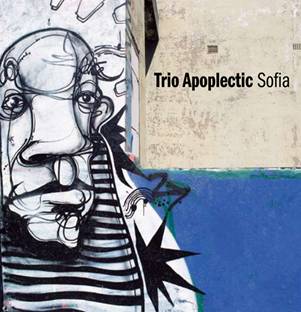 |
Trio Apoplectic - Sofia (Rufus Records RF080)
|
Sofia has the wondrous ability to place the listener in an immediate state of deep reflection. The lyrical lines from alto, bass and drums are all equally and refreshingly cliché free. Abel Cross’s bass winds its way around the lucid sound of Dave Jackson’s alto like a wild vine without losing rhythmic drive, while the subtlety extends to his choice of clean versus woody, vibratory, distorted or zithered chords when the sound of skin on string is just as important as the chosen chord. Jackson, the major composer, allows the alto to sound like it was meant to ala Paul Desmond.
   
|
by Peter Wockner.
Previously published in Limelight August 09 |
|
Back to Index
|
|
 |
Mark Ginsburg Band - Generations (Jazzgroove JGR 051)
|
The common demoninator of Klezmer and jazz has long been recognised as improvisation but what about the link between the Jewish Cantor and jazz improvisation? The seed of this idea is explored by this Sydney based saxophone led quartet. I love the intensity of these melodies. When the melodies relent, the thought process behind this cultural link inspires the tenor and soprano demanding all your sensory attention. A youthful rhythm section deepens the strength of sound almost to the point when you’d expect mountains to be moved, notably on the Coltranesque ‘Sojourn’. Vocalist Judy Campbell embellishes two pieces with some fine unison scatting.
   
|
by Peter Wockner.
Previously published in Limelight August 09 |
|
Back to Index
|
|
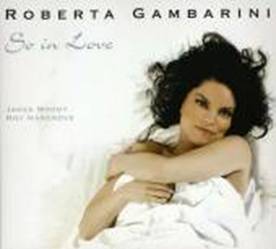 |
Roberta Gambarini - So In Love (Emarcy 02417 96010)
|
Only the elite among the great female jazz singers have earned the right to be referred to by their first names; Ella (Fitzgerald), Sarah (Vaughan) and Carmen (McRae) are instantly recognisable without their surnames. In 20 years we will be saying the same thing about the Roberta Gambarini! At last the torch of greatness has been passed to the true successor to the above three. Gambarini’s virtually unlimited technique with its warm timbre, impeccable timing, diction and phrasing and her intuitive grasp of jazz vocalising are captured on her latest album recorded in June last year _ except for two tracks recorded in September, 2001: “You Must Believe In Spring” and a medley from Cinema Paradiso. And they only emphasise her remarkable rise from very good to greatness! The album is book-ended by two consummate ballad performances with pianist Tamir Hendelman, her warm velvety tone revitalising the title track and Over the Rainbow without changing their essential character. As for her superb musicality, listen to the opening choruses of “Day In, Day Out” where she is accompanied only by the drums of Jake Hanna. Here is the complete singer. To paraphrase Stan Kenton this is “Artistry in Voice”!
    
|
by Kevin Jones.
Previously published in Limelight August 09 |
|
Back to Index
|
|
 |
Tierney Sutton Band - Desire (Telarc CD 83685)
|
This is an extraordinary album! The exceptionally gifted Los Angeles-based vocalist Tierney Sutton takes a philosophically spiritual journey with jazz as the vehicle on a meditative theme on society’s obsession and desire for fame and materialism beginning and ending it with a few texts from her Baha’i faith. Originally inspired by the music of Cole Porter, there are two of his songs among the nine standards, but the way Sutton and her band of 15 years, brilliant pianist Christian Jacob, bassists Trey Henry and Kevin Axt and drummer Ray Brinker, interpret them adds a hidden but emotional meaning to the original lyrics; something that becomes more apparent with repeated listening. Sutton cynically manipulates the lyrics of “My Heart Belongs To Daddy”, “Skylark” and “Love Me Or Leave Me” emphasise heartbreak, and although many have covered “Fever” none are as striking as this stark version with Brinker and Henry. Truly a work of art
    
|
by Kevin Jones.
Previously published in Limelight August 09 |
|
Back to Index
|
|
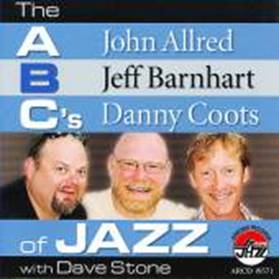 |
John Allred, Jess Barnhart and Danny Coots - The ABC’s of Jazz (Arbors ARCD 19371)
|
The title not only describes its wide ranging repertoire but the album also highlights the versatility of one the best trombonists in jazz, John Allred who showcases his lower register on “My One And Only Love”, blows restrained beauty on Charlie Haden’s haunting “First Song” and even interprets Alphonse Pucout’s clarinet chorus on the venerable “High Society”, Imaginative programming has “Puttin’ On the Ritz” blending into “Bernie’s Tune” and Fats Waller’s “Jitterbug Waltz” finding a partner in Sonny Rollins’ “Valse Hot”. And the latter word aptly sums up Jeff Barnhart ‘s piano playing. Marvellous mainstream!
   
|
by Kevin Jones.
Previously published in Limelight August 09 |
|
Back to Index
|
|
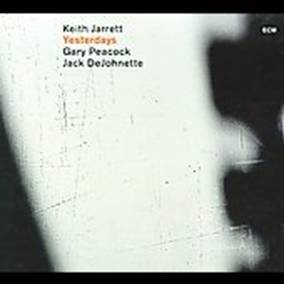 |
Keith Jarrett, Gary Peacock, Jack DeJohnette - Yesterdays (ECM 2060 177 4447)
|
Jazz and popular standards, bebop classics; it’s familiar fare for the “Standards Trio” of pianist Keith Jarrett. But there’s nothing commonplace about it when it’s a live performance from 2001, this magnificent group’s annus mirablis. With its high level of spontaneity, it has seldom sounded better than at this Tokyo concert. The joyously frenetic Gillespie-Parker line “Shaw Nuff” is taken at an incendiary pace, bassist Gary Peacock and drummer Jack DeJohnette pushing Jarrett all the way. The ballads are beautiful, especially the delicately tender “You’ve Changed”. Even better, a deeply moving “Stella by Starlight” from an aircheck!
    
|
by Kevin Jones.
Previously published in Limelight August 09 |
|
Back to Index
|
|
 |
Michelle Nicole - The Loveliest Night (ABC Jazz 179 9501)
|
If proof was needed, and there shouldn’t be, that Michelle Nicolle is Australia’s most outstanding jazz vocalist here it is. Her rich gifts of melodic inventiveness are displayed on the accapella treatment of I’m In The Mood For Love where her voice is allowed to glow in all it’s beauty. Bui it’s only one of the many highlights on a disc of mainly standard fare where she is consummately backed by bassist Tom Lee, drummer Ronny Ferella and, especially, guitarist Geoff Hughes. His duet with her on the title track is quite lovely. This is a voice Australia should be proud of.
    
|
by Kevin Jones.
Previously published in Limelight July 09 |
|
Back to Index
|
|
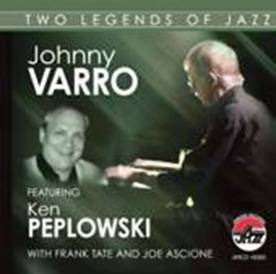 |
Johnny Varro featuring Ken Peplowski - Two Legends of Jazz (Arbors ARCD 19363)
|
This is classic mainstream jazz by two masters of the genre. Like his idol Teddy Wilson, consistency has been the hallmark of Johnny Varro’s elegant and swinging piano since he first joined Bobby Hackett’s group in 1953. Here he never plays a wrong note. Ken Peplowski, one of four clarinetists featured with The Lincoln Center Jazz Orchestra’s tribute to Benny Goodman in New York on May 28-30, is in brilliant form, as usual relishing the small group settings whether duos, trios or quartets. An imaginative song selection adds to the enjoyment of this laid-back session with only Out of Nowhere quickening the pulse.
   
|
by Kevin Jones.
Previously published in Limelight July 09 |
|
Back to Index
|
|
 |
Anita Wardell - Kinda blue (Specific Jazz SPEC009)
|
Australia’s loss has been London’s gain for more than a decade in Anita Wardell, whose natural affinity with swing and scat allied with that rare ability to sensitively express a ballad and make a song her own, is the complete package. Add her penchant for vocalese (singing words to jazz solos) and you have something very special. The 2006 BBC Jazz awards winner’s second album for the label is built around the word “blues” although some songs are only related. Enjoy the ebullient scat singing (Limehouse Blues), expressive longing (I Gotta Right To Sing The Blues) and the quirky (Loose Bloose).
   
|
by Kevin Jones.
Previously published in Limelight July 09 |
|
Back to Index
|
|
 |
Tom O’Halloran Trio - We Happy Few (Jazzgroove Records JGR 047)
|
Tom O’Halloran establishes continuity by retaining his Perth based co-horts Pete Jeavons bass & Daniel Susnjar drums for his follow up album to Green Hills and White Clouds. The pianist is able to call upon various periods of jazz piano history at ease and incorporate them elegantly into a context that is uniquely his own. There are feelings of tenderness, grandeur and freewheeling spontaneity with the addition of fourth dimensional electronic elements highlighted superbly on ‘Trio vs Computer’ where Jeavon’s fat groove is intriguingly ‘magnified’ by a series of implied electronic tweets and tweaks. O’Halloran also uses the innards of the piano to mystical effect.
   
|
by Peter Wockner.
Previously published in Limelight July 09 |
|
Back to Index
|
|
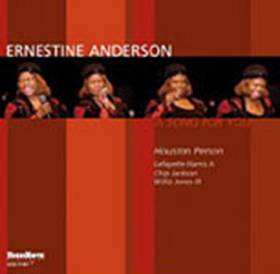 |
Ernestine Anderson - A Song for You (HighNote HCD7187)
|
I cannot think of another jazz voice at age 79 that sounded better. Anderson is a master at her craft. She believes the lyric and understands the limitations of her voice using every last ounce of emotion to express the feeling using moderated accents which probably explains why her chords are in such good shape. But there are few limitations that cannot be compensated by her clever use of staccato, dramatic use of space, gliding glissandi and gorgeous legato middle register lines, tastefully interpreted within reach of the melody using her subtle Texan twang. At the heart of this 2008 recording are medium tempo swingers like ‘This Can’t be Love’ and ‘A Lovely Way to Spend an Evening’. Houston Person, the long time choice of her contemporary Etta Jones instinctively adds his bluesy tenor making this album a winner apart from the inclusion of a rather hard to swallow ‘Candy’.
   
|
by Peter Wockner.
Previously published in Limelight July 09 |
|
Back to Index
|
|
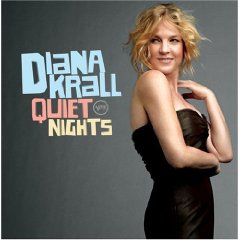 |
Diana Krall - Quiet Nights (Verve 1793110)
|
Admirers of the classic popular song will .love this album. Those who would rather hear Diana Krall in a more swinging and harmonically challenging vein will not be as enthusiastic. Opinions of the singer’s 12th album and first for three years will depend on which Diana Krall is preferred. This laidback “bossa nova tribute” reunites her with arranger Claus Ogerman for the first time since The Look Of Love eight years ago, still her biggest-selling album. The formula remains the same; dreamy balladry set to delicate bossa nova flavoured arrangements. However, this time Krall’s voice seldom rises above a whisper, her breathless huskiness part Julie London, part Peggy Lee, as she charts a honeyed yet sultry path through standards and such Brazilian classics as ‘The Boy From Ipanema’ and ‘Quiet Nights’. However, neither reaches the level of late night sophistication as the timeless collaboration between Frank Sinatra and Antonio Carlos Jobim , also arranged by Ogerman, more than 40 years ago. But there are two great tracks; Rodgers and Hart’s ‘Where Or When’ emulates what ‘Dancing In The Dark’ did for ‘The Look Of Love’ and ‘You’re My Thrill’ smoulders under Krall’s breathy elegance. Maybe too quiet for some but the ultimate in good taste.
   
|
by Kevin Jones.
Previously published in Limelight June 09 |
|
Back to Index
|
|
 |
Antti Sarpila - We’d Like New York In June! (Arbors ARCD 19375)
|
Finnish multi-reed virtuoso Antti Sarpilla shows he is the natural successor to his mentor Bob Wilbur on this enjoyable mainstream session backed by a classy international cast; Italian-born pianist Rossano Sportiello, former Australian bassist Nicki Parrott and American drummer Ed Metz Jr. Sarpilla has an earthy sound on tenor, his soprano shows Sidney Bechet’s influence but it’s his Benny Goodman via Wilbur inspired clarinet playing that is most enjoyable especially on the trio version of the almost forgotten chestnut ‘Whispers In The Dark’ and ‘Swing ala Chopin’. The classically-trained Sportiello continues to impress with his command of jazz styles.
   
|
by Kevin Jones.
Previously published in Limelight June 09 |
|
Back to Index
|
|
 |
Alex Maguire Sextet - Brewed in Belgium (Moonjune Records MJR022)
|
The UK pianist is known for his longstanding collaborations with the likes of Evan Parker and more recently with Elton Dean in the areas of fusion and free improvisations. This live Belgium set showcases his compositions that seamlessly allow open ended freedom within beautiful structures. The sextet were at one this evening and even the applause seems syncopated. Maguire’s gentile touch is interspersed with intermittent explosions of energy. Saxophonist Robin Verheyen plays a Coltranesque lead role on both tenor and soprano. The opening piano soliloquy ‘Psychic Warrior’ is Maguire’s highlight. The only drawback is the live recorded quality which has a certain remoteness.
   
|
by Peter Wockner.
Previously published in Limelight June 09 |
|
Back to Index
|
|
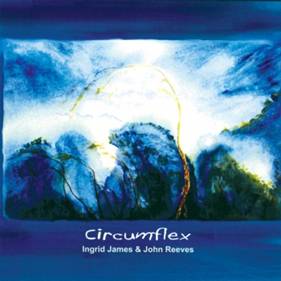 |
Ingrid James & John Reeves - Circumflex (Newmarket Music NEW3262.2)
|
Few jazz singers attempt nor succeed recording with solely piano accompaniment but James’s areabile tone and precise pitch hits the mark with a mixture of classics, jazz standards and contemporary tunes, given unfamiliar treatment in both tempo and accented phrasing; ‘Yesterdays’ finale recalls Betty Carter’s sublime bent about notes; ‘Just one of those Things’ rapid tempo is a lesson in agility and breath control while ‘Devil May Care’ is one of the finest I’ve heard. Weaker material like Eric Clapton’s ‘Strange Brew’ and Brian Wilson’s ‘God Only Knows’ receive undue credibility and thoughtful backing with tasty filling from UK pianist John Reeves.
   
|
by Peter Wockner.
Previously published in Limelight June 09 |
|
Back to Index
|
|
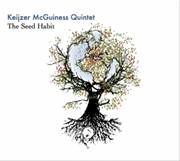 |
Keizjer McGuiness Quintet - The Seed Habit (Rufus RF079)
|
Despite thousands of miles of separation, Australian trombonist Lucian McGuiness and Dutch saxophonist Remco Keijzer have documented their intuitive musical understanding with a stellar Sydney quintet. The persistent use of staccato passages within the compositions builds a tension that is released like a steam valve when drummer James Hauptmann lays down the fattest of grooves or the dual horns intermingle with some delightfully lyrical counterpoint. Matt McMahon adds some trademark contemplation on Fender Rhodes but it’s the intertwined harmonic lines of the bone and sax that tends to demand more attention over the traditional role of the single soloist.
   
|
by Peter Wockner.
Previously published in Limelight June 09 |
|
Back to Index
|
|
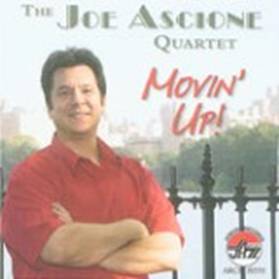 |
Joe Ascione - Movin’ Up (Arbors ARCD 19359)
|
Stricken with MS! No feeling in his hands! No problem for Joe Ascione. As he says in his liner notes “the party continues” Listen to the veteran New York drummer’s dazzling brushwork on the uptempo ‘Zip-A-Dee-Doo-Dah’s Got Rhythm’ (a blending of Disney and Gershwin). If that doesn’t astound you try the samba-inflected ‘So In Love’ on this inspired and imaginative drum journey through some lovely melodies with the ebullient but warm clarinet of Allan Vache, pianist and vibraphonist John Cocuzzi and bassist Frank Tate. Strongly recommended for those who like their jazz uncomplicated but straight ahead and swinging.
   
|
by Kevin Jones.
Previously published in Limelight May 09 |
|
Back to Index
|
|
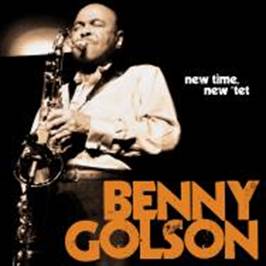 |
Benny Golson - New Time, New ‘Tet (Concord 08880723111213)
|
A fine tenor saxophonist but an even better composer and arranger, Benny Golson makes light of his 80 years as he revisits the timeless three-horn frontline sound of the Jazztet which he led with Art Farmer in the early 1960’s. No ‘I Remember Clifford’ and ‘Whisper Not’ is spoilt by Al Jarreau’s lightweight vocal but Golson’s grand new compositions include the lovely ballad ‘From Dream To Dream’ and the groovy ‘Uptown Afterburn’ plus original treatments of hard bop classics and tasteful jazz versions of Chopin and Verdi. Trumpeter Eddie Henderson is outstanding; exquisitely muted on ‘L’Adieu’ and rollicking on ‘Airegin’.
   
|
by Kevin Jones.
Previously published in Limelight May 09 |
|
Back to Index
|
|
 |
Horace Silver - Live At Newport ‘58 (Blue Note 0946 3 98070 2 4)
|
Another treasure from the past released for the first time! This time it’s pianist Horace Silver, the master of funk, Latin and hard bop, in exceptional form with his new quintet on July 6, 1958 at the Newport Jazz Festival. Of major interest is the exciting trumpet work of Louis Smith who would leave in a matter of weeks to return to teaching, his first love, and be replaced by Blue Mitchell. Tenor saxophonist Junior Cook’s depth and musical stability make him the perfect foil for Smith’s power and drive. Prime Silver at its exuberant best; a classic session.
    
|
by Kevin Jones.
Previously published in Limelight May 09 |
|
Back to Index
|
|
 |
The Fantastic Terrific Munkle - Music to Dance to (Jazzgroove JGR046)
|
This is TFTM’s joyous follow up to ‘The Cahoots’. The Sydney quartet’s instrumentation guarantees they could perform in a parade or a carnival; clarinets, tuba, trumpet, flute, banjo, guitars and percussion; absent are piano and double-bass. Composers Sam Golding and Julian Curwin provide portions of blues, but at times could be supporting a circus clown, a Turkish belly dancer, a Rastafarian but more likely entertaining at a Mediterranean Fiesta. Initially nomadic, ‘Incidental Gaucho’ becomes a triumphal prodigal homecoming. Freewheeling improv from a talented Sydney quartet ensures no parody just fantastic original jazz that doesn’t take itself too seriously.
   
|
by Peter Wockner.
Previously published in Limelight May 09 |
|
Back to Index
|
|
 |
The Bruce Cale Quartet - The Sydney Concert - On Fire (Tall Poppies TP203)
|
Historically, the 1980 NSW Jazz Action Society concert documented a young and extraordinary talented Dale Barlow with the uncanny ability to own these gorgeous melodies on tenor, soprano and flute. The late multi-instrumentalist Roger Frampton reveals, if there was ever any doubt, his genius as both a contemporary melody maker and an inventor with unlimited resource. His unaccompanied duet on alto saxophone with Barlow’s tenor on the Cale piece ‘Bells’ is an overwhelming highlight, while Phil Treloar’s percussion and in particular his brightly rendered cymbal work adds both rhythmic drive and balanced beauty. Like Dave Holland, Cale becomes an anchor but also a bridge for the others to cross pollinate. The post ‘Jazz Co-op’ empathy between Frampton and Treloar was probably most precious during this period. The only flaw is the bass pick up device which is a dead giveaway for 1980’s technology in contrast to today’s woody resonance.
   
|
by Peter Wockner.
Previously published in Limelight May 09 |
|
Back to Index
|
|
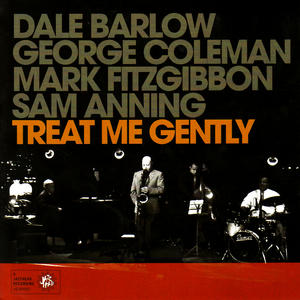 |
Dale Barlow - Treat Me Gently (Jazzhead HEAD 092)
|
In a hard swinging bop setting, there is hardly a tenor player on earth that can touch Dale Barlow in full flight and yet his basic instinct on the ballad ‘You Go to my Head’ displays a mature tenderness that would arouse romantics just as Coltrane’s ‘Ballads’ album did in 1962. Clearly inspired by the presence of US drummer George Coleman jnr and his long time collaborator pianist Mark Fitzgibbon, this is Barlow at the top of his game contributing two originals while Coleman brings two pieces from his Rivington Project collaborator/guitarist Victor Magnani, and his father’s funky ‘Amsterdam After Dark’.
    
|
by Peter Wockner.
Previously published in Limelight April 09 |
|
Back to Index
|
|
 |
Darren Heinrich Trio - New Vintage Tunes for the Hammond Organ (DazzJazz DJ001)
|
Showcasing the Hammond organist’s originals in two distinct trio settings: Heinrich has inhaled the musical breath of Jimmy Smith, Larry Young and Dr Lonnie Smith and exhaled a freshness and originality in composition and smart chops stylistically rooted in the Hammond-guitar trio tradition. The first with guitarist Steve Brien, whose light fleeting fingering complements drummer Andrew Dickeson’s intricate Blakeyesque patterns. The second trio carries weightier definition with Simon Relf’s guitar and Tim Firth’s funkier drums. Produced by organ master Tony Monaco; for organ fans with a connection to the greats of the instrument, this is where it’s at in Australia.
   
|
by Peter Wockner.
Previously published in Limelight April 09 |
|
Back to Index
|
|
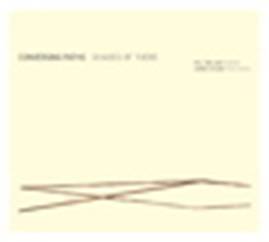 |
Phil Treloar & Hamish Stuart - Converging Paths Shades of There (Feeling to Thought Production FT 003)
|
I can’t imagine a recording which could capture more extemporization and random acts of giving from the human spirit. Treloar forgoes the drum kit for marimba while Stuart utilises the kit and whatever else within his immediate environ including the rustling sound of empty pistachio shells. There were no pre-conceived ideas or plans for these interactions which at times border on telepathic. The marimba repeats patterns that act like memory flashbacks rather than repetitious melody. Neither courageous nor self indulgent but honestly and faithfully expressed, clearly influenced by the over-arching maze of sound found in an Australian bushland setting near Milton NSW
   
|
by Peter Wockner.
Previously published in Limelight April 09 |
|
Back to Index
|
|
 |
Boz Scaggs - Speak Low (Decca 1784345)
|
Five years since his first standards album (But Beautiful) with a jazz quartet, Boz Scaggs has topped it with a quietly intimate collection of jazz and popular chestnuts. Pianist Gil Goldstein’s writing for reeds, vibes and strings has the right degree of mellow sophistication for the 64-year-old Scaggs’ subtle and emotional phrasing. I detect a nod to Chet Baker and Johnny Hartman, a far cry from his early influences Ray Charles and Jimmy Reed, especially his lonely soliloquy on Invitation and the laidback This Time The Dream’s On Me. Superior jazz solos, especially by Bob Sheppard (reeds). Add to the enjoyment.
   
|
by Kevin Jones.
Previously published in Limelight April 09 |
|
Back to Index
|
|
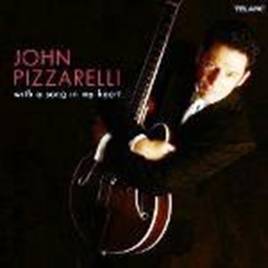 |
John Pizzarelli - With A Song in My Heart (Telarc CD-83676)
|
This album by one of the most recorded artists of the past 12 months reinforces my belief that Richard Rodgers’ partnership with Lorenz Hart produced superior music to that of his more theatrical output with Oscar Hammerstein II. The three tracks by the latter partnership are the weakest as the multi-talented John Pizzarelli takes a refreshing approach to Rodgers’ legacy. The title track swings effortlessly from start to finish and his smooth, informal supper club vocals are complemented beautifully by Don Sebesky’s charts (shades of Marty Paich) for the Swing Seven. The highlight: fellow guitarist and father Bucky guesting with him on It’s Easy to Remember.
   
|
by Kevin Jones.
Previously published in Limelight April 09 |
|
Back to Index
|
|
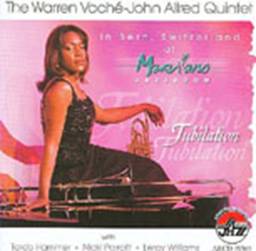 |
The Warren Vache-John Allred Quintet Live - Jubilation (Arbors Jazz ARCD 19369)
|
The special rapport between cornet player Warren Vache and trombonist John Allred built on a friendship of more than 20 years is evident in this hard-swinging live session recorded before an appreciative audience in December 2007 at Marians Jazzroom in Berne, Switzerland. They blend seamlessly, as on the unaccompanied two-chorus contrapuntal duet on Strike up the Band, and solo with style and conviction. Inspired by a crack rhythm section which includes two of New York’s finest in bebop, pianist Richard “Tardo” Hammer and drummer Leroy Williams, Vache shows his admiration for trumpeters Blue Mitchell and Lee Morgan as his playing takes on boppish overtones on the two Horace Silver numbers, Song For My Father and Strollin’. Add bassist Nicki Parrott with her big sound and great time and it’s no wonder Vache would like to “keep the group together for the next 20 years”. He may be a keeper of the swing flame but Vache is comfortable in any musical environment. The highlight: Vache on My One and Only Love where his lovely melodic balladry shares the honours with a quiet interlude from Hammer. And don’t miss his humorous asides with Parrott on Sweet Hunk O’ Trash.
    
|
by Kevin Jones.
Previously published in Limelight April 09 |
|
Back to Index
|
|
 |
Judy Carmichael - Come and Get It (www.judycarmichaelo.com)
|
Acclaimed as a polished exponent of stride piano with one of the most swinging left hands in jazz, Judy Carmichael now shows she is a more than capable singer as with her all star septet she slinks through the Benny Goodman chestnut All the Cats Join In and teases playfully on the title track. Her group, all class, includes two Australians, trombonist Dan Barnett and London-based guitarist Dave Blenkhorn but no one is more impressive that trumpeter Jon-Erik Kelso. Except Judy whose joyful solos capture the spirit of Fats Waller especially on the inspired version of Christopher Columbus
    
|
by Kevin Jones.
Previously published in Limelight March 09 |
|
Back to Index
|
|
|
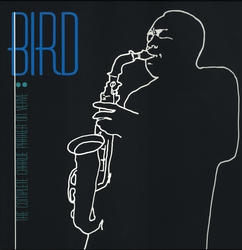 |
Charlie Parker Bird - The Complete Charlie Parker on Verve (Verve 983 3382)
|
Before signing an exclusive recording contract with jazz impresario Norman Granz in late 1948, Charlie Parker had played in mainly the bebop quintet format. Under Granz’s banner the then most influential musician in jazz recorded with strings, big bands, choirs and first-class small groups. This magnificent 10-CD set has everything Parker recorded for Granz’s various labels from a 1946 Jazz at the Philharmonic concert to his final studio session in 1954. No matter what the setting he played brilliantly and on the best of them never played better; even on the ponderous In The Still Of The Night his alto saxophone soars majestically above the Dave Lambert Singers. The quicksilver lines of both Parker and Dizzy Gillespie spark the reunion with Thelonius Monk although either Roy Haynes or Max Roach would have been better choices than the bombastic Buddy Rich. Parker constructs the perfect solo on Embraceable You at a 1949 JATP concert at Carnegie Hall, outplays the other two members of the jazz alto trinity, Johnny Hodges and Benny Carter, on an all star date and his sessions with strings produced the classic Just Friends. Great music and great musicians, these recordings by arguably jazz’s greatest improviser should be in every serious collection.
    
|
by Kevin Jones.
Previously published in Limelight March 09 |
|
Back to Index
|
|
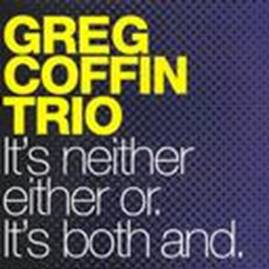 |
Greg Coffin Trio - It’s Neither Either or. It’s Both And. (Jazzgroove JGR 045)
|
These originals from the Massachusetts born, Sydney based pianist were written over a 15 year period, but there is never a sense that Coffin is in auto pilot. In fact there is a feeling of timelessness about the melodies and edginess in his dominant right hand that has more concern with spatial interplay than slick technique, often completing phrases with classical afterthoughts. The zithering bass of Cameron Undy implies many of the rich harmonies rather than clearly defining them and that presents a freer platform for drummer Nic Cecire to explore raw rhythms but filling spaces with some splashy cymbal work.
   
|
by Peter Wockner.
Previously published in Limelight March 09 |
|
Back to Index
|
|
Surprisingly smooth sailing from one of our most recorded bassists. On board for this overdue debut, is a stellar crew, including NY based pianist Barney McAll who makes the most appropriate statements at the most appropriate time, but like nylon string guitarist Doug DeVries, can be suddenly oblique and questioning. Phil Slater’s breathy and intimate trumpet might once have been called ‘cool’ but it kindles warmth on these appealing original bossas and sambas. The clarity of recording has one sitting amongst the musicians with seemingly very little post-production manipulation. Percussionists Hamish Stuart and Fabian Hevia provide the rhythmic impetus and the colligation of sound
   
|
by Peter Wockner.
Previously published in Limelight March 09 |
|
Back to Index
|
|
Mehldau meltsdown the Basement 12th March 2009
Brad Mehldau – piano
Larry Grenadier – double bass
Jeff Ballard – drums
Pianist Brad Mehldau’s first visit to the Harbour city lived up to expectation. Eleven years ago I recall an emerging artist. An artist not only deserving, but demanding wider recognition; an artist eager to incorporate contemporary music into his repertoire; the music of Radiohead; That in itself was hardly groundbreaking. Herbie Hancock had already recorded ‘New Standard’ years earlier but even in 1998 he shared billing with Hancock’s trio at the Marciac Jazz Festival in France. It was his youthful fresh approach. He had a tattoo on his arm. He didn’t look like the leader of a jazz piano trio.
Mehldau has lost very little of that youthful approach but has now refined his restrained, even handed and thoughtful approach to performance. He had the capacity Basement audience as thoughtfully pensive as I can recall. They listened very intently and reacted accordingly to every trickle or flourish.
Mehldau’s trio now includes Jeff Ballard on the drums and from the very first moment the logic was evident in this choice. Ballard’s playing is very similar to Mehldau’s; restrained, thoughtful and textural. In some contexts this ‘consistency’ in sound could become tedious but not here.
The program was one single lengthy set made up primarily of Mehldau originals. ‘Dreamsketch’, ‘Twiggy Waltz’, ‘B Blues’ an untitled waltz performed for the first time, ‘Stan the Man’ based on the chord changes of Charlie Parker’s ‘Confirmation’ were just some of the selections.
Mehldau has a rare ability to capture the imagination of both jazz purists and pop seekers. All his pieces had rhythmic drive and a propensity to be melodic without overstatement. While Larry Grenadier’s bass carries much of that weight, it’s the exquisite, lyrical touch of Mehldau that had me hanging on each and every note. Each of his hands genuinely communicate with each other, sometimes in different languages, conjuring the idea of ‘call and response’ between the treble and the bass, almost Monkish but with lighter hands arched and without the steadfast percussive trait.
The number of great Sydney musicians including a couple of legends in the audience justified the respect this artist demands. Fortunately someone had the sense or needed to be prompted to turn off an irritating clicking ceiling fan which detracted from a poignant Mehldau ballad about two thirds through the show.
Mehldau treated his Sydney audience to glorious encores. Come back soon Mr Mehldau.
|
|
by Peter Wockner.
|
|
Back to Index
|
|
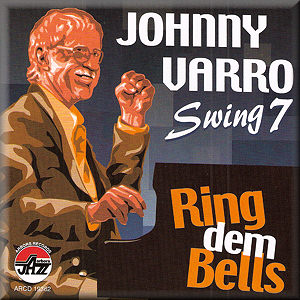 |
Johnny Varro Swing 7 - Ring Dem Bells (Arbors ARCD 19362)
|
Pardon my bias but this is the style of music which first attracted me to jazz My tastes are now wider and more varied but it’s pleasure to review an album which recaptures so well the spirit, both melodically and rhythmically, of the 1930s, 40s and 50s.. Versatility describes this all star septet: for example Jelly Roll Morton’s Buddy Bolden’s Blues is followed by a relaxed version of the Woody Herman big band classic Sonny Speaks in a program which salutes Ellingtonia, swinging operettas, standards and long forgotten warhorses (Shim-Me-Sha Wabble). The leader’s Teddy Wilson-Mel Powell inspired piano enhances every track and his charts leave plenty of room for the in-form front line _ Randy Sandke (trumpet), Dan Barrett (trombone), Ken Peplowski (alto/clarinet) and Scott Robinson (tenor). Marvel at the way each soloist builds on the foundation set by bassist Frank Tate and drummer Joe Ascione on the title track. It’s the epitome of swing.
    
|
by Kevin Jones.
Previously published in Limelight February09 |
|
Back to Index
|
|
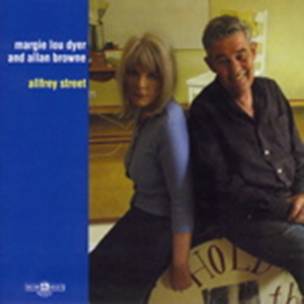 |
Margie Lou Dyer and Allan Browne - Allfrey Street (Newmarket NEW 3251 2)
|
The sounds of 1920’s jazz have rarely been in better hands. Melbourne drummer Allan Browne and his pianist-vocalist wife Margie Lou Dyer aided by some of the city’s finest combine elements of gospel, the blues and a Creole touch to continue an authentic tradition with style, humour and panache in a set dedicated to the Allfrey Street Stompers which included Margie’s late father Warwick and drummer Len Barnard. The multi-talented Stephen Grant shines on trumpet and Jo Stevenson’s clarinet has seldom sounded better but it’s Browne and Dyer who hold sway, especially the latter with her deep bluesy piano and sultry vocals.
   
|
by Kevin Jones.
Previously published in Limelight February09 |
|
Back to Index
|
|
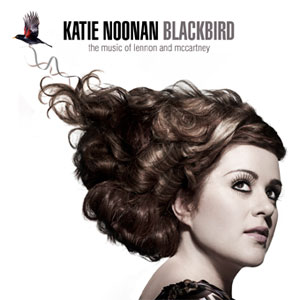 |
Katie Noonan - Blackbird (Sony/BMG 88897394382)
|
John Lennon and Paul McCartney wrote some nice songs but to describe them as the equal of the great classical popular songwriters . . . neither in melody nor lyrics were they in the same class as the Gershwins, Rodgers and Hart or Cole Porter. That said the best moments here come from the musicians led by tenor saxophonist Joe Lovano and guitarist John Scofield _ the instrumental Norwegian Wood is the best track. Despite the gushing liner notes, Katie Noonan’s vocal gymnastics don’t equate to jazz singing or scatting. I found the whole exercise irritating. Am I missing something? I doubt it. Pardon me while I listen to an Ella songbook.
  
|
by Kevin Jones.
Previously published in Limelight February09 |
|
Back to Index
|
|
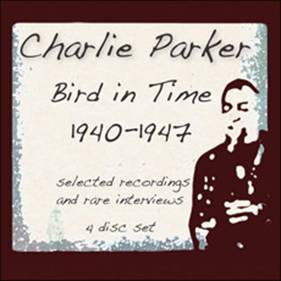 |
Charlie Parker - Bird in Time 1940-1947 (ESP Disk ESP 4050)
|
‘Modern Jazz’ has always been heavily reliant upon zealous Public Radio Broadcasters as a means of exposing the music that never receives mainstream coverage. Now even the legendary figure, Charlie Parker who moved jazz mountains in the 1940’s, posthumously relies on a dedicated American Public Broadcaster in Michael D. Anderson, along with an adventurous label to acutely chart his lead role in the development of a music reluctantly labelled ‘Be-bop’. This 4 disc set is definitely no historical compilation. Rather, it is an aural documentary featuring rare conversations with ‘Bird’ himself, interviews with the likes of Max Roach, Howard McGee, Milt Jackson and Ted Edwards and previously un-released material such as Parker’s first known demo recording. Dated at 1936 or 1937 when he was 16 or 17, this is proof alone that he “never consciously changed [his] style” when he moved to New York. The most revealing music comes in the form of four guitar duo takes with Efferge Ware captured in Kansas City in 1942. Parker, yet to have an original ‘Be-bop’ tune at his disposal, adapted ‘Cherokee’, ‘Body and Soul’, ‘My Heart Tells Me’ & ‘I Found a New Baby’ to suit the new music style he was spawning.
   
|
by Peter Wockner.
Previously published in Limelight February 09 |
|
Back to Index
|
|
 |
Jenny Scheinman - Crossing the Field (Koch Records KOC-CD-4590)
|
Violinist Jenny Scheinman has found a place where American mid-western folk, classical and jazz coalesce using an eighteen piece orchestra on six of the thirteen originals save Ellington’s ‘Awful Sad’. Moments of mystery, loneliness, melancholy, barn dance romps and marches but a definitive highlight is the back-beaten ‘Hard Sole Shoe’ where call and response conversations between Jason Moran’s probing piano and orchestra morph into an assimilated but retreating monologue before Doug Wieselman’s bass clarinet pokes and prods the strings back into the mix. Long Time collaborator Bill Frisell adds his effects laden quirky country fusion to this surprising concoction of disparate ingredients that ferments well.
   
|
by Peter Wockner.
Previously published in Limelight February 09 |
|
Back to Index
|
|
 |
Michael Feinstein - The Sinatra Project (Concord 7230819)
|
Frank Sinatra did it his way, and so does pianist and vocalist Michael Feinstein, one of the premiere interpreters of the classic American popular song, in this thoughtful homage to an icon. Feinstein, with arranger-conductor Bill Elliott, has explored some of the lesser known songs from the 1940s Sinatra canon, and re-interpreted them in Capitol’s famous Studio A in Hollywood as if they had been recorded a decade later in one of Sinatra’s classic concept albums with arrangers Billy May and Nelson Riddle. Outstanding is ‘Begin the Beguine’ in the swinging style of Riddle’s famous 1956 chart of ‘I’ve Got You Under My Skin’. Feinstein doesn’t attempt to emulate the swaggering yet sophisticated style of Sinatra’s glory days, who could? His soft distinctive tenor shines on the intimate ‘The Same Hello, The Same Goodbye’. This album simply reeks of class. Frank would approve!
    
|
by Kevin Jones.
Previously published in Limelight Jan 09 |
|
Back to Index
|
|
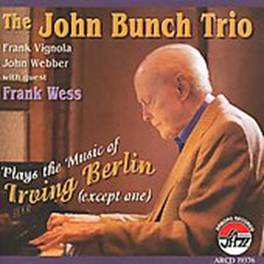 |
The John Bunch Trio - Music of Irving Berlin (Arbors ARCD 19376)
|
First-class piano jazz in the Hank Jones tradition, this is a melodist’s delight, not surprising considering the quality of the songs by one of America’s greatest tunesmiths, The 87-year-old John Bunch shows he is still an elegant swinger of the highest order and the same could be said for the former Count Basie star saxophonist and arranger Frank Wess (86) who, guesting on six tracks, shows he still has few peers as a flautist in jazz. Guitarist Frank Vignola and bassist John Webber both help make this album a joy from start to finish where the high standard set by Soft Lights and Sweet Music never falters.
   
|
by Kevin Jones.
Previously published in Limelight Jan 09 |
|
Back to Index
|
|
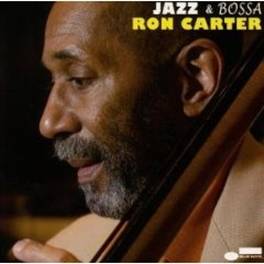 |
Ron Carter - Jazz and Bossa (Blue Note 50999 2 28104 2 7)
|
This 2008 session shows master bassist Ron Carter’s affinity with the bossa nova rhythms he first discovered nearly 50 years ago when he recorded on Antonio Carlos Jobim’s 1960 album ‘Wave’. Drawing on a pool of musicians comprising pianist Stephen Scott and percussionist Rolando Morales-Matos from his own group, the Brazilians, drummer Portinho and guitarist Guilhere Monteiro, and tenor saxophonist Javon Jackson, Carter leads them through a program of jazz standards, Brazilian numbers and his own originals with more than satisfactory results, especially in the more intimate settings such as the bass-guitar duet on ‘Wave’ and Monteiro’s lovely solo excursion on ‘Saudade’.
   
|
by Kevin Jones.
Previously published in Limelight Jan 09 |
|
Back to Index
|
|
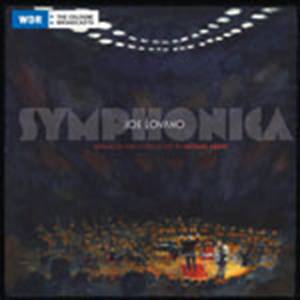 |
Joe Lovano with the WDR Big Band & Rundfunk Orchestra - Symphonica (Blue Note 50999 2 26225 2 5)
|
Lovano fearlessly tackles a variety of jazz settings, but the great pre-bop saxophonists can still be heard in his sound derived from his day’s playing with his father and his contemporaries. This Cologne 2005 performance has many essential ingredients of the jazz tradition and yet forges a fresh approach for a soloist fronting a renowned big band and orchestra. These are predominantly his own compositions including his adaptation of some ‘Body & Soul’ melody into ‘I’m all for You’ and Mingus’s similar compositional technique, transforming ‘Lush Life’ into ‘Duke Ellington’s Sound of Love’. There is never a lack of intensity despite the lush strings, his sometimes gargling tenor and his swiftly fluttering soprano. The sensitivity, honesty and above all his intricate inventions, rarely repeating phrases, make his one of the greatest tenors around. His fascination with percussion along with his collection of cymbals and gongs, gives his playing a rhythmic forward momentum pushing the Big Band along but mystically harmonic on the ballads. He trades blows with altoist Karolina Strassmayer on ‘Alexander the Great’ while a splintering trumpet soloist on the edgey ‘Eternal Joy’ goes without credit on the liners. Guitarist Paul Shigihara must have wowed the German audience with his blues tinged guitar work.
   
|
by Peter Wockner.
Previously published in Limelight Jan 09 |
|
Back to Index
|
|
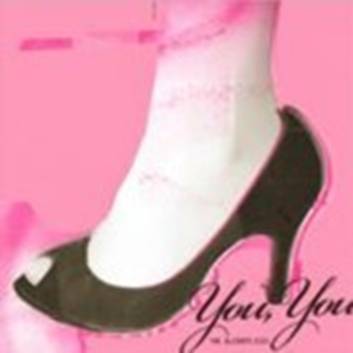 |
The Alcohotlicks - You You (Jazzgroove Records JGR044)
|
A two guitar trio with the anger and attitude of 1970’s pub rock but with the talent of a winner and runner-up of the National Jazz Awards in Aaron Flower and Ben Hauptmann with the unrelenting Evan Mannell on drums; if this band had a vocalist, imagine the queues at The Big Day Out! It’s not all screaming guitar solos and dark chords however, ‘Sad Song’ has a beauty that would make any anti-punk happy and imagine Robin car-bonnet ‘Surfing’ on the Batmobile? The Sydney grunge jazz scene has developed and refined itself and this recording now becomes the definitive sound.
   
|
by Peter Wockner.
Previously published in Limelight Jan 09 |
|
Back to Index
|
|
 |
Michael Occhipinti - The Sicilian Jazz Project (True North TND 516)
|
Van Gogh created masterpieces from potato farming peasantry. Guitarist Occhipinti’s use of peasantry is derived from 1950’s recordings by musicologists Alan Lomax and Diego Carpitella of traditional Sicilian folk music in a stunning adaptation by thirteen Toronto based instrumentalists. Vocalist Dominic Mancuso, who also has Sicilian heritage adds his husky lamenting cries most hauntingly on ‘The Sulphur Miners’ while Egyptian born vocalist Maryem Tollar broadens the fuse with ‘The Almond Sorters’. This is a genuine World Jazz project with potent portions of improv but never loses sight of its island origins. The liner notes are insightful, informative and well written.
    
|
by Peter Wockner.
Previously published in Limelight Jan 09 |
|
Back to Index
|
|
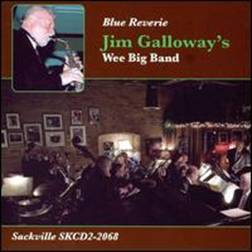 |
Jim Galloway’s Wee Big Band - Blue Reverie (Sackville SKCD22068)
|
If swing’s your thing, don’t miss this 2008 live recording from Toronto by a 17-piece Canadian ensemble. It has kept the spirit of the big bands alive for the past 30 years by stamping its own identity on some of the greatest charts ever written, all transcribed from the original recordings. Led by a swing-orientated soprano player, its strong solo roster (14 on this recording) keeps the music fresh without a hint of re-creation, whether it’s the swinging ensemble work on Benny Carter’s ‘Symphony In Riffs’ or Gerry Mulligan’s slow but tender re-working of ‘If You Were The Only Girl In The World’.
   
|
by Kevin Jones.
Previously published in Limelight December 08 |
|
Back to Index
|
|
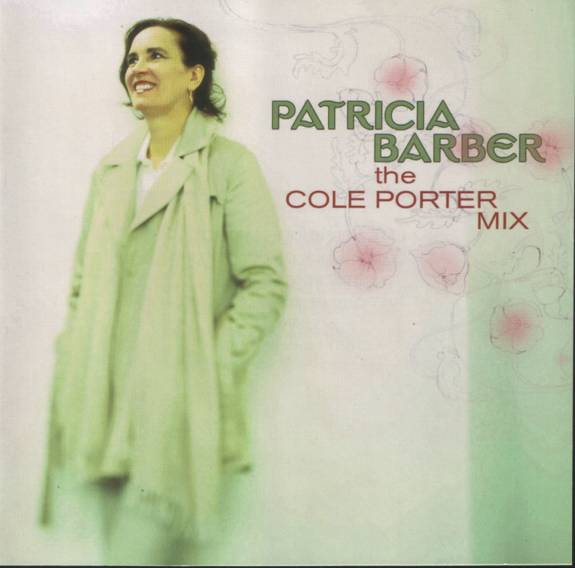 |
Patricia Barber - The Cole Porter Mix (Blue Note 50999 5 01468 2 6)
|
Barber’s distinctive vocal style is definitely an acquired taste but she has outlasted most at Blue Note and this is probably her most surprising to date. Only three originals but the addition of the equally distinctive Chris Potter on saxophone provides the pepper that might otherwise have made this a bland affair. Her long time collaborators Neal Alger & Michael Arnopol are still providing the well branded contemporary rhythms. Some tongue in cheek moments such as ‘You’re the Top’ should be taken only as light hearted necessity to the otherwise earnest attempt at new interpretation, which Barber achieves with uncanny serendipity
   
|
by Peter Wockner.
Previously published in Limelight December 08 |
|
Back to Index
|
|
 |
Don Braden - Gentle Storm (HighNote HCD 7186)
|
To his credit, the saxophonist has never excluded pop tunes from his repertoire, but always from a jazz perspective without compromise. He’s enjoyed tenures with Wynton Marsalis and Betty Carter and I suspect it’s his soulful sound that’s sought after as a sideman. Unlike ‘The Real Quietstorm’ from another tenor lion born in the 60’s James Carter, there’s a variety of weather conditions from sunny afternoons to gale force winds on his 14th as leader. Along with three originals, he covers ‘Never Can Say Goodbye’ from Jackson 5 fame, while a version of the 1953 classic ‘Secret Love’ is worth the price alone.
   
|
by Peter Wockner.
Previously published in Limelight December 08 |
|
Back to Index
|
|
 |
Dave Holland Sextet - Pass It On (Dare2 B001 1860-02)
|
The bassist’s compositions for sextet might be more accessible than the quintet but no less captivating. Counterpoint and harmonies shine amongst bouncy rhythms and breezy atmospherics, mostly in a post-bop setting. The three horns allow Holland to set melodies and/or improvisations for a single horn against the harmonic backdrop of the others and this becomes beautifully thematic. The highlight; a thirteen minute tribute to Sam Rivers which goes through several sections. Altoist Antonio Hart starts a fire before Eric Harland fans the flames of his cymbals into an Elvinesque inferno. Holland then douses with his dry woody sound before Robin Eubanks’s trombone reignites the rage.
    
|
by Peter Wockner.
Previously published in Limelight December 08 |
|
Back to Index
|
|
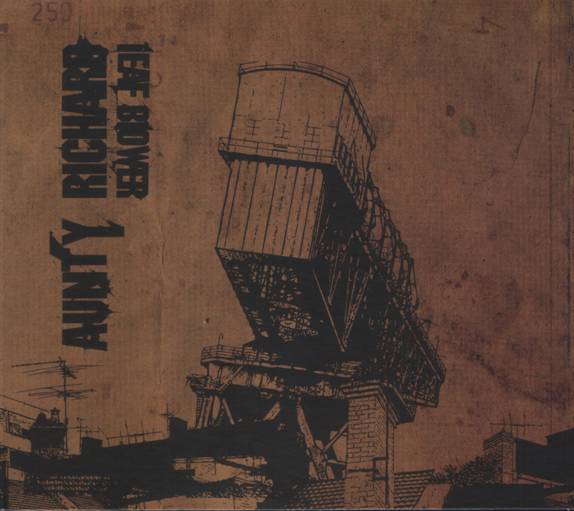 |
Aunty Richard - Leaf Blower (Jazzgroove JGR043)
|
Grunge jazz is taking hold in Sydney. Aunty Richard, the brainchild of saxophonist Joel Woolf who spent some years in LA uses this debut as a reactionary exhibit of those years. Canberra based electric bassist Ben Rodgers plays a trebly five string giving the trio an extra guitar-like dimension, while drummer Tim Firth, renown for his forceful, relentless drumming becomes the ideal choice for this energetic concept. There is beauty and anger in the Woolf tone with technical facility to realise all his ideas. Electronic effects give a comic space age slant, while the repetitive riffs and short track length maintain accessibility.
  
|
by Peter Wockner.
Previously published in Limelight November 08 |
|
Back to Index
|
|
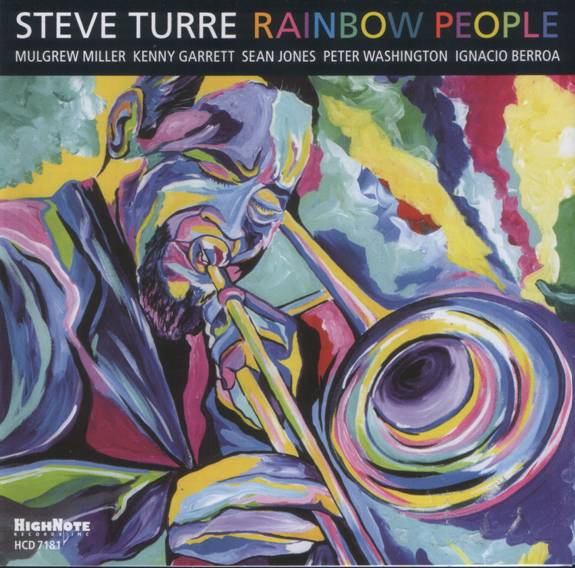 |
Steve Turre - Rainbow People (HighNote HCD 7181)
|
Turre sings with his trombone amongst a dynamic gathering including pianist Mulgrew Miller intricately knotting & untying on Turre’s earthy blues tribute to Ray Charles ‘Brother Ray’. Altoist Kenny Garrett & trumpeter Sean Jones alternate in the line-up with Jones providing some authentic Flamenco harmonies on ‘Lost in Madrid’. With a title like Rainbow People, I expected robust regional specific rhythms but I love the subtlety in the diverse concepts of hard-bop, soul, Flamenco and Cuban all grafted from a post bop root. His customary conch shells are saved solely for the Cuban ‘Para El Comandante’. This is possibly his finest release to date.
   
|
by Peter Wockner.
Previously published in Limelight November 08 |
|
Back to Index
|
|
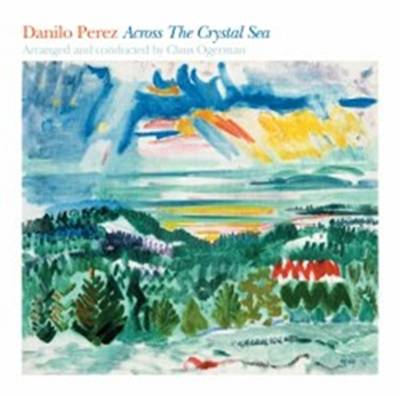 |
Danilo Perez and Claus Ogerman - Across the Crystal Sea (Decca 0060251764821)
|
An Ogerman collaboration with the Pan-American pianist is about as natural as they come given his previous work with both Antonio Carlos Jobim and Bill Evans, but this is risky business for Perez whose robust post bop Latin style takes on calmer more lyrical waters. Ogerman is the guiding contributor, adapting scores from classical composers such as Rachmaninoff, Massenet, Manuel de Falla, and choral composer Hugo Distler into lush orchestral jazz with the help of Christian McBride and Lewis Nash. The sound-scapes conjure feelings of intrigue, mystery, humility, grandeur, wonderment and romance, especially on Cassandra Wilson’s sensual ‘Lazy Afternoon’.
   
|
by Peter Wockner.
Previously published in Limelight November 08 |
|
Back to Index
|
|
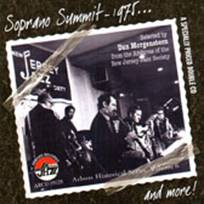 |
The Soprano Summit in 1975 and More (Arbors Jazz ARCD 19328)
|
This is a sparkling treasure chest of mainstream gems by one of the finest working jazz groups of the 1970’s selected from the archives of the New Jersey Jazz Society by Dan Morgenstern, director of the Institute of Jazz Studies. These were the so-called “fusion years” yet the Soprano Summit of Bob Wilber and Kenny Davern was a mainstream-traditional group with a repertoire of pre-bop standards and obscure melodies such as the lovely Song Of Songs introduced in France in 1914. Both were masters of the clarinet and soprano saxophone and the intensity of their interplay added an excitement which few could match. In the company of guitarist Marty Grosz, pianist Dick Hyman, bassist George Duvivier and drummer Connie Kay they breathe new life and fire into old favourites like The Mooche and Swing Thirty Nine. To top it off there are tracks with Davern’s Blue Three and a sublime meeting between Wilber and the great Ruby Braff. Marvellous stuff!
    
|
by Kevin JOnes.
Previously published in Limelight November 08 |
|
Back to Index
|
|
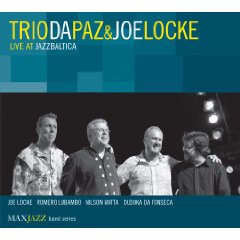 |
Trio da Paz and Joe Locke - Live At JazzBaltica (MaxJazz MXJ701)
|
Formed more than 16 years ago, the New York-based group of former Brazilians combine the best elements of jazz and the samba with a virtuostic intensity. The addition of Joe Locke, one of the best of the today’s contemporary vibraphone [players, only adds to the special chemistry created by guitarist Roberto Lubambo, bassist Nelson Matta and drummer Duduka da Fonseca as shown on this live recording from last year’s Jazzbaltica festival at Salzau in northern Germany. Lubambo’s lyrical acoustic guitar flows fluidly through Pron Flavio and Locke’s vibes strike sparks on the driving Bachiao. This is jazz-oriented Brazilian music at its best.
   
|
by Kevin JOnes.
Previously published in Limelight November 08 |
|
Back to Index
|
|
Wangaratta Jazz Festival 2008
The Wangaratta Festival of Jazz is surely Australia’s Jazz heaven. Most events are of concert standard but some less formal even primitive performances are presented, such as Julie O’Hara, a vocalist with a fine swinging style who also played faux cornet through her nasal passage at the Pinsent Hotel.
With Joe Lovano’s Cologne concert in my headphones, it felt almost surreal gliding down the train line from Sydney passing the abandoned ram shackled sidings against the backdrop of tarnished Australian green pastures, some blanketed in lush lucern and daubed with granite boulder peaks, like whales breaching out of a purple sea. The further south though, the browner the landscape became, reminding me of these drought conditions still prevalent since my last visit in 06.
Saxophonist Gai Bryant formed a group she calls the ‘Spare Parts Orchestra’ but the members were certainly no spare parts; they are mostly among Sydney’s finest, and deserving wider recognition. Saxophonists Craig Walters and Paul Cutlan, trumpeter Warwick Alder were amongst the ranks. Prominent New York pianist, composer and arranger Jim McNeely opened the Jazz Festival using this Orchestra, with a Jimi Hendrix tune of all people, proving that Big Band music can be wonderfully interpretive. His arrangements were spatial and at other times like gusty sheets of rain. In staggered sequence, sections were further sectionalized sometimes into flugelhorn, trumpet and muted trumpet parts for example, with the traditional solo’s flying high above from the likes of trombonist Lucien McGuiness, Walters, and other saxophonists Roger Manins, Andrew Robertson and Bryant herself. A highlight was McNeely’s tribute to Mel Lewis simply entitled ‘Mel’. A feature for drummer Andrew Dickeson, whose chart called for a series of melodic colours rather than rhythmic patterns, which were in turn echoed back by the horns in similar figures. McNeely re-arranged a piece by Renee Rosnes entitled ‘In this Moment’ and his right hand descending runs seem to pick up momentum like droplets down a window pane. His own piece ‘Absolution’ was based on himself as a young Catholic boy growing up dealing with the burden of guilt on his conscience. I found the lone singular horn voices crying out against the full sectional passages deeply personal as if they were protesting against a larger more infinite voice. McNeely’s other originals included ‘Touch’ with a lengthy solo piano introduction before morphing into a township African feel that could have been inspired by Dollar Brand, while in global economic uncertain times ‘Extra Credit’ had urgency with a subtle backbeat groove but certainly not the chaos of a dealing room.
The young Finnish group Ilmiliekki Quartet, which means - staring at a naked flame, wowed audiences with their youthful spirit and ensemble interaction, playing a Tom Waits cover and originals from the trumpeter Verneri Pohjola. While he may not have the sheer ‘in your face power’ of a Scott Tinkler, he employed striking sonic techniques, seamlessly moving from sounds ranging from the alphorn to a bass flute and even electronic sounds. A foggy image was felt by his breathy use of air through the horn but at a turn morphed the sound into magnesium brightness. The element of surprise in Pohjola’s trumpet playing alone maintained undivided attention. ‘Hot Chick’ had a single note groove/beat. Block chords predominant in Tuomo Prattaia’s piano solo briefly turned into a war cry and then retreated back into the single note. I found their interpretation of Ornette Coleman’s “What Reason Could I Give?” refreshing and respectful even when Pohjola played his trumpet into the grand piano. He paused and waited for the resonating distant echo to give him further inspiration. While the Fins varied their emotional and energy levels to striking affect, David Murray’s Black Saint Quartet maintained a ferocious 13 rounds in the ring of the replacement marquee venue.
Apart from the poignant protest song ‘Banished’ where Murray’s bass clarinet took on his trademark percussive plugs, all other pieces were played with an exhausting energy but for most part remained utterly captivating. The last time I witnessed Murray was in the context of his Octofunk (a band that once opened for the Grateful Dead) at the Quasimodo club in Berlin back in 1994. The capacity of the now 53 year old does not seem to have diminished. As always, I’m expecting someone to hand him an alto or soprano such is his upper register persistence. But that is the Murray sound, and while his lower register sound seemed less defined, which could have been due to my seating position, upper register shrieks were just as thrilling as I remember in Berlin. Murray uses all his physicality on his instruments. His head turned from side to side as if he was brushing his teeth, creating vibratory tones, then he mutes the horn with his knee in the fashion of our own Tony Gorman. There were mixed reactions to this performance but for the ones who love unrelenting energy, they were not disappointed. Jaribu Shahid’s dreads may just be as long as his double bass strings which were giving him some tuning frustrations. Nevertheless his plucky double time playing in the middle and lower registers was a refreshing foil against Murray. Pianist Lafayette Gilchrist was significantly more fluid and muscular on Saturday than the Friday night’s performance. The long solos from this group were a testament to their ability to maintain creativity for extended periods. Almost constant circular breathing gives Murray an edge to his melody lines. He achieves that similar goal that Frank Sinatra strived for when influenced by Tommy Dorsey; the uninterrupted flowing melody. He displayed a level of virtuosity difficult to better at this festival, although one Sydney tenor player I spoke with found him repetitious when compared to Joe Lovano and to a certain extent I agreed as Monk’s “Lets Cool One’ became lost in David Murray’s solo. ‘Murray Steps’ was his dedication to John Coltrane, but the bass was distorted at the marquee stage. Fortunately it was rectified for Matt Penman’s amped up sound for John Scofield. ‘Sacred Ground’ from the album of the same name re-arranged without the vocals of Cassandra Wilson became a major solo piece for Gilchrist who employed Bach like block chords and clever phases where his left hand bass lines faded up and back in the mix.
The best sound achieved in the Cathedral this year save maybe Mike Nock solo, was the soprano saxophonist Fiona Burnett & percussionist and marimba player David Jones. I was concerned when I saw his exaggerated drum kit in this sound bouncing space complete with ceramic tiling on the vaulted ceiling, but Jones tastefully reigned in his sometimes explosive approach using only brushes and mallets to heavenly, ethereal and meditative effect against the sometimes ‘Eastern’ sounding soprano.
The Impressions trio with Bob Sedergreen piano, Ted Vining drums and Michael Meagher replacing the late Barry Buckley was a sure fire crowd favourite. The empathy between Sedergreen and Vining is quite extraordinary and allowed them to almost intuitively swell and retreat the intensity like a tidal flow, during the theme from the nose wiggling television programme ‘Bewitched’.
I had never witnessed Megan Washington perform live before and my initial thought brought to mind memories of a London performance by Swedish pop/jazz/sex kitten Lisa Ekdahl. But she is so much more than Ekdahl. She might have a limited range but her Doris Day like tone, coupled with her intriguing original compositions left everyone impressed. At times her recital singing style with questioning lyrics, were punctuated by a series of breathy percussive exhales. Her performance was embodied by rock and pop sensibility, but with the complexity of contrasting harmonic lines and time changes. The highlight ‘Leaving Home’ saw both Washington and pianist Paul Grabowsky vacate the stage to leave saxophonist Jamie Oehlers, trombonist Shannon Barnett and guitarist Steve Magnussen in a raging firestorm lit by drummer Niko Schauble.
Off to ‘Blow’ and rather than striking one, I took time out to gaze at the fluffiest white clouds symmetrically dotting the bright blue sky, something we don’t see too often in Sydney. Blow is a band that defies categories. Bob Sedergreen alternated between Roland RD 300 and piano rendering post bop, avant-garde and fusion. Their dual bass performance included two tributes; ‘Buckle Up’ dedicated to the late bassist Barry Buckley and ‘And Heaven Called’ for trombonist Simon Kent which was a mournful yet celebratory piece. Despite the distorted bass sound on the Jazz on Ovens stage ‘Living and Dying’ had a spiritual feel about it while Peter Harper’s alto used some of British saxophonist Courtney Pine’s shimmering techniques.
Bernie McGann appeared with his ‘new’ Quartet made up of Andrew Dickeson drums and Brendan Clarke on bass replacing the Waples brothers with the perfect foil Warwick Alder utilizing his trademark ‘Hubbardesque’ exclamations. They played amongst others ‘Memories of You’ and it was clear that Andrew Dickeson was in his element in this setting.
I finally found some Hard Bop in the Craig Scott Quintet performance but sadly a little flat despite the distinctive Australian voices in Paul Cutlan, saxophones, Craig Scott bass and Warwick Alder trumpet. Generously presenting music by such deserving artists as Australian pianist based in New York Cathy Harley (Criss Cross) trombonist Peter Trotter, pianist Jan Rutherford (Mr Visa Man) and Alder, the latter’s ‘Bix Blues’ supersized by monster drummer Tim Firth. Alder proved he is still one of the great Australian improvisers building, demolishing and renovating during his solo.
By nightfall I was looking for some mental relief but I ended up with the ‘Heebie Jeebies’ thanks to the ‘Crescent City Serenaders’. Half this lineup looked under 30 years of age. Who said New Orleans music is dying? I enjoyed their take on the old chestnut ‘Isle of Capri’.
The violin as a vehicle for atonal improvisation is an acquired taste and I’m afraid my resistance wasn’t worn down by my persistence at the Antripodean Collective performance with John Rodgers on violin. Nevertheless, it is said, the power of Louis Armstrong’s playing, the sheer volume un-amplified, could be simply overwhelming. Our own trumpeter Scott Tinkler may be one of a select few capable of playing articulately with this kind of startling force.
Then it was down to the Pinsent Hotel for a truly multicultural band based mainly in Barcelona – Los Krokodillos whose version of the gospel ‘Just a Closer Walk with Thee’ included a new additional chorus backing vocal line “Walkin with my Jesus -‘Talkin with my Jesus”. Amen.
Trio Apoplectic own a special brand of chamber jazz and improvised music in this country. Made up of Dave Jackson alto, Alex Masso on drums and Abel Cross bass, they performed originals with slow tempos and lean bass sounds. Jackson created intriguing and curiously satisfying patterns against the bass, allowing the alto to sound like itself, never stretching the instrument to its limits; an approach I likened to Paul Desmond. There are no egos in this band. During the piece ‘Transition’, Cross had his bass sounding like the shifting of deep sea wreck. In contrast to the restrained collective sound of Trio Apoplectic, the John Scofield/Joe Lovano Quartet ramped up the volume considerably and performed largely the identical repertoire of their recent Sydney Opera House concert.
As great as these two giants of the jazz world are I found individuals just as impressed with the bass of Matt Penman and the drumming of Matt Wilson. Lovano’s ‘Fort Worth’ improvised opening made way for some bedrock bass playing from Penman whose style may have lacked the delicate finesse of a Dave Holland but compensated in hard driving propulsion with the fattest of groove. What’s more he makes it look easy! Lovano played ‘Big Ben’ on both dates with the twin barreled, polyphonic, soprano Aulochrome horn; an acquired taste. John Scofield used much of the facility in his armory but was sparingly discerning in his use of pedal effects, at times creating wild pistol fire ricocheting around the tent like the set of a western movie. There were some very special moments like Matt Wilson’s measured conversational solo introduction to one piece and John Scofields intro to ‘I don’t stand a Ghost of a Chance with you’. Miles Davis‘s ‘Budo’ the only addition to the repertoire, saw the pair trading fierce but inventive blows. Vocalist Katie Noonan, who only recently recorded with these pair along with Ron Carter and Sam Keevers in NYC on the rapidly released Lennon /McCartney tribute ‘Blackbird’, joined the band for a fitting encore.
In my opinion Michelle Nicolle (1998 winner of the National Jazz Award) has been and still is the best Australian jazz vocalist. Her repertoire consisted of challenging jazz standards such as Monk’s ‘Mysterioso’ and Horace Silver’s ‘Lonely Woman’. Her voice has taken on buttery burnt toast characteristics in the lower register while she has lost little of her operatic high register. Silver’s ‘Lonely Woman’ was given a slower tempo for a more haunting interpretation than DD Bridgewaters 1995 tribute recording of this vocal rarity. Nicolle played the trombone subconsciously with her voice and her flow of scatting ideas remains as unpredictable as ever. Combine this with a clear instrumental scatting intent, a cleverly effective microphone technique and the morning audience witnessed vocal jazz artistry. Given she only had 3 ½ hours sleep, the night before and her performance scheduled at bird’s twit for a musician (11am), this was quite a performance.
Peter Knights ‘Way out West’ was the clear instrumental highlight of this year’s festival. This band has a truly innovative instrumentation line-up and they have created a new fuse of Vietnamese and West African sounds capes, mixed with the blues soaked tenor and baritone saxophones of Paul Williamson. All selections were taken from their Jazzhead album ‘Old Grooves for New Streets’ suite and compositions. Williamson and Knight sounded the sirens in this street and interestingly, I found the bass low in the mix with no detriment to the groove whatsoever. Sri Lankan Ray Pereira played congas, djembe and the Ghanaian talking drums. The third movement in the suite had the group in tribal celebrations trapped in a tropical rainstorm via Dave Beck’s teaming cymbal work and Dung Nugyen’s ‘touch typing’ technique on his modified electric guitar. He also played the Vietnamese Dan Bau which at times sounded like a slide guitar or pedal steel. Put simply, each piece evolved into a hypnotic groove that made me want to dance. In this way I guess it reminded me of one of the main reasons jazz ever existed. But there was no dancing at ‘Wang’. Imagine the reaction from the jazz cognoscenti! I recall some infectious dancers at an early 1990’s Bellingen Jazz Festival, including journalist John Clare, dancing to the sounds of the collaborative group ‘Lustzone’ (Wanderlust and Clarion Fracture Zone). Why not let your brain and your body enjoy the sound?
The bassist Jonathan Zwartz brought the piano trio with the pop/rock sensibilities of groups like’ The Bad Plus’ and ‘EST’ to Wangaratta with ‘Soundgun’; joined by Tom O’Halloran on piano and Evan Mannell on drums. Mannell sometimes used his wedding ring on the rims harnessing a controlled groove rather than the grunge approach of his other trio settings. It was refreshing to see Zwartz in a lead role and performing his own tunes rather than his usual ‘ever reliable’ side man role. A judge in this years National Jazz Awards, Zwartz remains one of this countries best bassists, striking notes with acute definition and dexterity. The position of the grand piano at St Patrick’s Hall was perfect to give the audience full view of the nimble right hand treble work of O’Halloran.
Dale Barlow said of his new band “I formed this group because they are all great musicians”; Bobby Gebert piano, Bernie McGann alto saxophone, Ben Waples bass and Dan Waples drums. These days it’s rare to hear McGann in a sideman role but he makes a contrasting foil for the more powerful Barlow and contributed ‘D Day’ a tune in the great bop tradition. Barlow’s ‘Breathing Room’ sounded like it was based on the chords of ‘Sweet Georgia Brown’ while other new tunes included ‘New Phoria’ and Geberts tribute ‘Dales O’s Dance’. The marquee had a capacity of over 700 but it was probably never over two thirds full which I found quite remarkable given the stature of these musicians and the number of genuine performing opportunities they get in Sydney or Melbourne.
Kerrie Simpson’s band was probably a poor choice for the Cathedral where larger complex sounds bounce around and become muddy. However considering the festival was one venue down this year due to the demolition of the Town Hall and the Playhouse and the construction of the new Performing Arts Centre, there was bound to be at least one disappointment. Trying to achieve a Harlem Baptist jubilant feeling here was nearly impossible. We just don’t react this way and we’re not a particularly rhythmic audience either it seems. Her valiant attempt at audience participation fell on deaf ears.
The Paul Grabowsky Quintet featuring Joe Lovano was a chance to re-visit some of those challenging and yet wondrous pieces recorded in New York by Grabowsky, Tinkler and Lovano on ‘Tales of Time and Space’. Interestingly, Lovano did not look as engaged with this band as he was with John Scofield. A good example of Tinkler’s ‘machine-gun’ like attacks and tremolo effects were during his solo on ‘Reason and Rhyme’. Tinkler again produced some luminously glowing notes on ‘Circle of Trust’, while on ‘Tailfin’ his sound bubbled like boiling water and after a collective barnstorm of improvisation by Lovano and himself, somehow they managed to instinctively pause in perfect unison. It was one of those special ‘Hole in One’ jazz moments. Bassist Phillip Rex’s muscular whipping solo on ‘Updraft’ was also a highlight. Vocalist Katie Noonan was again in town for the encore performance. Noonan abandons lyric definition or articulation and uses her voice as an instrument of pure angelic sound. For that reason alone, she must be considered a legitimate jazz singer. Lovano’s tenor picked up Noonan’s last note and the shift was almost seamless; another special moment!
‘Vada’ was one of two groups pianist Aaron Choulai assembled for this festival. The trumpeter Eamon McNelis had a plastered broken left wrist and was bravely resting the horn on his cast. I don’t know why but he reminded me of Ned Kelly bracing himself and his heavy gun with a kind of plaster armour. Like Choulai’s baseball cap, Vada’s sound is radically ‘off-centre’ but beautifully textural from densely wooded forests to deserted streets. Soft deft touches from Choulai’s caresses to masses of scattered splashes from drummer Rory McDougall dissolved the deep grooves into fragmented shards. And I wondered why have I had not heard of tenor player Carlo Barbaro before! What a mountainous sound!
Phil Stack won this years National Jazz Awards for bass using amongst three pieces, a blues created only on the Sunday morning entitled ‘Mullet Blues’ dedicated to guitarist James Muller. The other finalists to achieve second and third were Ben Waples and Sam Anning respectively. I don’t have a problem with jazz in this case being ‘sport’ like in a competitive nature. After all I’ve always regarded test cricket as an art-form. Following this sweating it was time to check out the easy swinging style of vocalist Julie O’Hara. She endears her audience with a beautiful smile and superbly crafted lyrics to jazz classics like ‘Society Red’ by Dexter Gordon, ‘Mona’s Mood’ by Jimmy Heath, ‘Four Brothers’ by Jimmy Giuffre and ‘Spontaneous Combustion’ by Cannonball Adderley.
Meanwhile the formidable Victorian Police Show band presented some uniformly swinging big band on the free Reid Street stage with Count Basie’s ‘Wind Machine’ and Oliver Nelson’s ‘Emancipation Blues’.
While Aaron Choulai treated the audience with about as much indifference as a 06 Elliott Dalgleish, his knack of re-focusing absolute attention with his solos coming off the blocks at pianissimo level was just mesmerizing. His rhythms shunted like coal train carriages but with the momentum of a large container ship leaving shore. As with one of Vada’s pieces, the loping bass line somehow morphed into a stagger before finally tripping over in a strangely structured way. This was one of the few Australian bands that were begged for an encore and he obliged saying “You’re all Sick” in a tongue in cheek kind of way. Saxophonist Carlo Barbaro arrived back on stage with a party nail through his head.
This was also the first time I’d witnessed the St Patrick’s hall filling tenor sound of Zac Hurren who played significantly off mic. He has a dancing style and the power or a younger Sonny Rollins. During an opening soliloquy he used fingering patterns that created that grinding metallic multiphonic effect heard on his Jazzhead recording ‘Exordium’, while Sam Bates on drums plays with monumental power and conviction. Hurren paid homage to his mentor, saxophonist, composer and educator the late Tony Hobbs with a piece entitled ‘Conveyance’.
In a stunning coup for the festival, John Scofield agreed to join Sydney’s most promising guitarist James Muller on the marquee stage that had the expectation of a prize heavyweight fight. Fortunately there were no casualties and while it was an entertaining bout, it is questionable as to whether it reached the levels of expectation afforded it. To be sure, Scofield played with the greater inventive melodic prowess, while it might be argued that Muller displayed a more nimble technique and relaxed style. It was certainly a spectacle that transformed bop favourites like Denzel Best’s ‘Wee’ and Charlie Parker’s ‘Billie’s Bounce’ into virtual R n B anthems thanks to bassist Matt Penman’s fat groove. Scofield seemed genuinely challenged by Muller’s ‘Beethoven’, a track recorded in New York City and available on his Birdland release ‘Kaboom’. In contrast Muller seemed quite at home with Sco’s ‘Everybody’s Party’. I’ll confess guitar is not my first choice so I found Penman’s contribution and Ben Vanderwal’s double sweeping drumming action just as fascinating as the two guitar virtuosi.
|
|
by Peter Wockner.
|
|
Back to Index
|
|
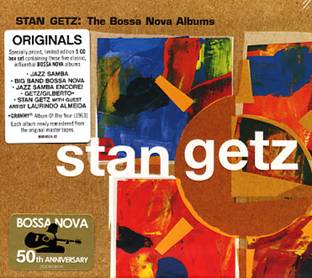 |
Stan Getz - The Bossa Nova Albums (Verve 06025 175 496 92)
|
Stan Getz’s melodic gifts have been rarely sounded better than on the Big Band Bossa Nova set with arranger Gary McFarland, one of five albums from 1962-63 now reissued in their entirety. McFarland sparingly uses the ensemble allowing the beauty of the solos and the music to take centre stage. Getz, who once described himself as “just a melody player”, is superb showing again his special affinity with the bossa nova, a synthesis of samba rhythms and sophisticated jazz harmonies. Here he is at the height of his creative powers, his flowing lyricism almost songlike as if he were singing through his horn. Only a few, notably his idol Lester Young, had this gift. The melodically lovely and subtly swinging setting found Getz at his most tender, his floating improvisations opening out like the petals of a flower in the sun. The albums are scattered liberally with musical gems - the haunting ‘Baia’ from Jazz Samba where Getz and Charlie Byrd’s guitar blend so beautifully; the Getz-Gilberto collaboration on ‘The Girl From Ipanema’ which still holds its charm although it pales besides Getz’s fire and drive on the exciting ‘So Danco Samba’ and the tenderly lyrical ‘P’ra Machucar Meu Coracao’. Both Getz and the music sound even better today than when these albums were first released.
    
|
by Kevin Jones.
Previously published in Limelight October 2008 |
|
Back to Index
|
|
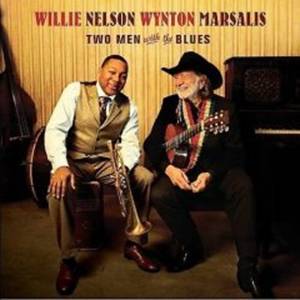 |
Willie Nelson and Wynton Marsalis - Two Men With The Blues (Blue Note 50999 5 04454 2 4)
|
Few would remember Louis Armstrong’s 1930 recording of ‘Blue Yodel No.9’ with Jimmie Rodgers but I suspect this was the catalyst for the unlikely, but so successful pairing of the urbane Wynton Marsalis with the grizzled country music legend Willie Nelson at New York’s Jazz At The Lincoln Center last year. Marsalis’ poised trumpet contrasts with the dustiness of Nelson’s guitar as, backed brilliantly by Marsalis’ crack quartet and Nelson’s long-time harmonica player Mickey Raphael, they find common ground in the blues. Each track is a standout with an intimate ‘Georgia On My Mind’ topping the bill.
    
|
by Kevin Jones.
Previously published in Limelight October 2008 |
|
Back to Index
|
|
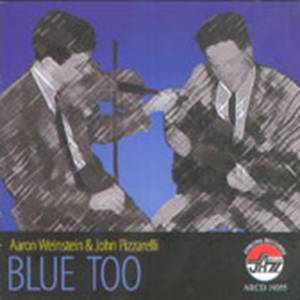 |
Aaron Weinstein and John Pizzarelli - Blue Too (Arbors ARCD 19355)
|
More Joe Venuti and Eddie Lang than Stephane Grappelli and Django Reinhardt, the phenomenal Aaron Weinstein shows the art of the hot jazz violin is alive and well in these fascinating duets with guitarist John Pizzarelli. However, it’s the spirit of the late Hezekiah Leroy Gordon Smith, better known as Stuff, which hangs over this joyful 2007 session. The 23-year-old Weinstein has Smith’s blazing attack with a pizzicato to match and in Pizzarelli, a master of the unamplified acoustic guitar, he has the ideal partner as they challenge and surprise one another in a mix of swingers and ballads.
   
|
by Kevin Jones.
Previously published in Limelight October 2008 |
|
Back to Index
|
|
Manly Jazz Festival 2008
Hampered by less than favourable weather conditions, jazz fans had to wait until Monday until performances moved out of first gear. Jeremy Borthwick’s Exposed Bone and the Gerard Masters Trio finally sparked some ignition and intensity into the outdoor event that weathered all seasons during each of the three days.
The Manly Jazz Festival, now in its 31st year is tiring and is in need of a complete overhaul in it’s artistic direction and how the event operates across Manly over the Labour Day long weekend if it is to continue into the future. Support from the jazz and improvised music communities for this event has declined it seems, in correlation with the number of quality jazz/improvised performances in recent years. Poor ticket sales for the highlight event Andrew Speight’s tribute to Charlie Parker with Strings is evidence of this. Not to mention the festival program guide which lacked detail and failed to ignite any interest in the artists. In what seems to be a commercial reality each of the stage’s presenters seem to be better versed in sponsorship announcements rather than the artists they are supposed to be introducing. Barry Crook especially comes across as being overly blase. Furthermore, the decision to relegate the student bands to a stage within the grounds of the local school had more than the obvious implications for the jazz artists of the ‘future’.
Although unsettled weather had been predicted from as early as Monday 29th September, there were no marquees or alternative wet weather venues arranged.
As a result, Saturday’s spirited performances by Warwick Alder, Lily Dior, Jane Irving and Adrian Cunningham were all well received by keen but unfortunately small audiences.
The festival receives little support from local businesses and potential venues which invariably profit quite significantly from the leisure seeking crowds that flock to Manly for the spectacle rather than the music. The potential for smaller venues to become involved with ticketed events of greater intimacy seems unlimited however NSW licensing laws are probably still smothering such opportunities.
What should have given this festival some hope and an interesting beacon for it’s artistic directors was the rapturous audience applause given to Exposed Bone led by the joyously rollicking trombone of Jeremy Borthwick, the cutting and swathing guitar of National Jazz Award winner Aaron Flower, the omnipresent bassist Brendan Clarke and the distinctively but intricate rock-like approach from drummer James Hautpmann. Similarly, the Gerard Masters trio added an intensity that the Monday audience seemed to be yearning for, performing pieces from his latest album Pendulum which included lengthy portions of both melody and creative improvisation.
|
|
by Peter Wockner.
|
|
Back to Index
|
|
 |
Neilsen Gough - A Beautiful Dream (KI Entertainment NGCD003)
|
What do Chet Baker, Vince Jones, Till Bronner and Neilsen Gough have in common? They all sing and play horn very well. Gough has a vocal tone in the realm of a breathy Buble, but other times like early Jones and occasionally borrows from the occasional casting trait of Elling’s phrasing. I recall his 2005 performance at the Manly Jazz Festival as one of the Sunday’s highlights due to his appealing originals and willingness to tackle lesser known material. This is a concept stock of his own love ballads and easy sambas but I was hoping for greater variety in textures and themes.
  
|
by Peter Wockner.
Previously published in Limelight October 08 |
|
Back to Index
|
|
 |
Manuel Mengis Gruppe 6 - The Pond (Hatology 659)
|
Strangely, a recent visit to Sydney’s Botanic Gardens duck pond put the Swiss trumpeter’s original compositions into greater perspective. His second album as leader features only four tracks but each has the twists and turns of a masterful epic in the numerous rhythm changes and mood swings. Roland Von Flue’s bass clarinet becomes part of a water bird habitat with honks and squawks amongst the splashing counterpoint and rippling grooves, while Mengis often takes the atonal flight, squeezing possibilities rather than surety from his trumpet. The piano-less contemporary instrumentation includes Flo Stoffner’s sometimes Frisell-ish guitar and Mareel Stalder’s melodic rather than thumping electric bass. Constantly compelling storylines call for heavy arrangements but they also allow for sub-contextual soloing by all three horns and guitar. Drummer Lionel Friedli provides some forceful rhythm and some feather-like cymbal work on the 18 minute journey Hide and Seek. One of the best this year.
    
|
by Peter Wockner.
Previously published in Limelight October 08 |
|
Back to Index
|
|
 |
Brian Blade & The Fellowship Band - Season of Changes (Verve 0602517610477)
|
The instantly recognizable influences of Coltrane/Tyner and the melting pot of New Orleans funk combine with the spirituality of the drummer’s origins in the Zion Baptist Church. Long time collaborator & keyboardist Jon Cowherd provides the tolling Tyneresque back-drop especially on the musical parable ‘Return of the Prodigal Son’ with Rosenwinkle’s authoritative guitar. The concept extends on ‘Omni’when Melvin Butler’s tenor briefly finds that promised land while Myron Walden’s bass clarinet finds solemn space in another chapel. The most precious one is of same name where Cowherd, Blade and bassist Chris Thomas construct a spare melody and segue to some grungey but uncluttered funk.
   
|
by Peter Wockner.
Previously published in Limelight October 08 |
|
Back to Index
|
|
Wycliffe Gordon Sound Lounge - 9th Oct 2008
John Harkins – piano
Brendan Clarke – bass
Andrew Dickeson – drums
Wycliffe Gordon – trombone
Mike Kenny – trumpet
Jason Morphett – tenor and soprano saxophones
Bone Practitioner works the Lounge
Wycliffe Gordon has been visiting Australia since 1990 mainly with bands led by Wynton Marsalis. It should come as no surprise then that his affinity with Australia extends to playing the didgeridoo, although we didn’t see this part of his repertoire during his Sydney performances.
Two sets were played at the Sound Lounge and each quite distinct in their jazz flavours. The John Harkins trio opened the first set prior to the Georgian taking the stage and announcing Dizzy Gillespie’s ‘Blue n Boogie’. The surety of his notes was immediate, taking up the last phrase of the Harkins solo and immediately firing elements of his vast arsenal. The art of call and response featured heavily in his solo using fluttering phrases by tonguing the mouthpiece at a rapid pace sometimes sounding like an imaginary melodic washboard.
Next he introduced the idea of the touring muso and fantasy while on the road. Fats Waller wrote the piece ‘I’m Gonna Sit Right Down and Write Myself a Letter’ and as a spur of the moment decision, he called the intro as trombone and bass at a ballad pace. His quaint but almost shy or apologetic singing style is quite a contrast to both his horn playing and that other inspirational trombone playing vocalist, Frank Rosolino. He articulates a lyric by sometimes over-emphasising the consonant to an Australian ear but that probably adds another rhythmic dimension to his phrasing.
Fortunately the audience didn’t take his song choice personally because ‘I Can’t Get Started’ (with you) and his own original ‘ShShSh the Band is trying to Play’ certainly did not reflect the level of audience respect at the Sound Lounge on this occasion. They were with him from the opening bar. His silken smooth solo on the former using a mute and cup could easily have been Tommy Dorsey had you closed your eyes.
Ray Noble’s ‘Cherokee’ opened with an overly exaggerated dirge pace so few were surprised when his trombone exploded with a machine gun like tempo using multi-phonics and at times creating a melodic distortion that sounded like a trombone on a radio station not quite tuned in; then like an instrumental version of Clark Terry’s vocalised ‘Mumbles’; then like a didgeridoo; incredibly effective.
Taking the stage for the second set was trumpeter Mike Kenny and saxophonist Jason Morphett. My hesitation at this mix was soon put to rest by the passion and emotion in their playing, even if clearly their facility did not reach the technical heights of the American. They drenched the charts which were mostly arranged by Kenny for the second set, and seized the opportunity to share the stage with one of the instruments modern day greats.
Opening with ‘Autumn Leaves’, the band relaxed into a comfortable hard-bop feeling, using the traditional head-solo-head formula. WC Handy’s ‘St Louis Blues’ was given a contemporary arrangement by Gordon, but soon moved into a Cuban territory with Harkins stirring up images of Chucho Valdes, encouraged by Andrew Dickeson’s perfectly timed cow bell. Much to Jimmy Shaw’s delight, they then returned to a Preservation Hall New Orleans flavour.
Both ‘The Nick of Time’ and ‘Savannah’ from the pen of Gordon, the latter a pop ballad with a soft backbeat broke up the standards repertoire prior to more Kenny arrangements of ‘You and the Night and the Music’ and ‘Alone Together’.
|
|
by Peter Wockner. |
|
Back to Index
|
|
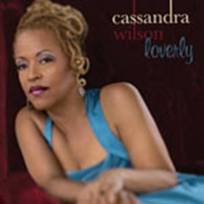 |
Cassandra Wilson - Loverly (Blue Note 50999 5 07699 2 6)
|
Of today’s major jazz vocalists, Cassandra Wilson is probably the only one primarily influenced by the blues, a legacy of her childhood in Jackson, Mississippi immersed in the Delta sounds and soul music. It shows in her highly personal style, the smokey-honey voice reinventing and changing tunes as a Billie Holiday, Sarah Vaughan or Betty Carter would. Noted in more recent years for interpreting original music and unusual covers, she returns to where she started with Blue Skies 20 years ago; an album of standards. Recorded in a rented house in her hometown, she combines the West African rhythms of Yoruba percussionist Lekan Babalola and pared back charts with the stellar talents of Lonnie Plaxico (bass), Jason Moran (piano) and Herlin Riley (drums) in a nearly perfect album. Spine tingling duets with Sewell (Spring Can Really Hang You Up The Most) and bassist Reginald Veal (The Very Thought of You) and a percussive Caravan show why Wilson remains in a class of her own.
    
|
by Kevin Jones.
Previously published in Limelight September 08 |
|
Back to Index
|
|
 |
Judy Carmichael - Southern Swing (www.judycarmichael.com)
|
Yes Virginia, jazz can be fun and entertaining without sacrificing excellence, swing and style. The proof, if needed: American stride pianist Judy Carmichael in prime form with two of Melbourne’s finest, Stephen Grant (cornet) and John Scurry (guitar) at the 2007 TAC Wangaratta Festival of Jazz in north-eastern Victoria at the first of her two sell-out concerts captured on disc from an ABC broadcast. Hearing the music again, reminded me just how good it was _ venerable tunes transformed by the cheerful openness of her playing, the attack rhythmic and vigorous, and Grant and Scurry excelling on the ballad Crazy He Calls Me. A wonderful memento of a special occasion.
    
|
by Kevin Jones.
Previously published in Limelight September 08 |
|
Back to Index
|
|
 |
Scott Robinson Plays the Compositions of Thad Jones - Forever Lasting (Arbors Jazz ARCD 19276)
|
No other jazz musician today has such a wide battery of instruments, many of them rarely heard since the 1920s, than the versatile Scott Robinson. He is the master of them all from brass (echo cornet) to reeds (C melody saxophone), the obscure (theremin) to familiar (tenor saxophone). Fourteen are played on this intriguing and adventurous tribute to the sublime talents of the legendary big band trumpeter, composer and arranger Thad Jones. In Robinson’s hands the usually cumbersome bass saxophone becomes supple (TNA Blues); on tenor, he sensitively duets with pianist Hank Jones on All My Yesterdays; and with Mike Le Donne’s Hammond B-2 organ adds soul to Three and One. Remarkable.
    
|
by Kevin Jones.
Previously published in Limelight September 08 |
|
Back to Index
|
|
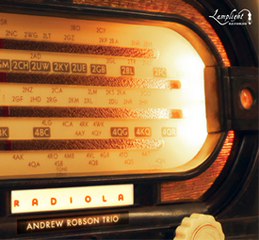 |
Andrew Robson Trio - Radiola (Lamplight Records LLR00208)
|
Not ideal for insomniacs. The infectious Transylvanian flavoured blues, Big Ben for Bennie Wallace was still spinning around in my head at 2am in the morning. Robson plays alto, soprano & recorder on this 2005 trio recording featuring Steve Elphick (bass) and Hamish Stuart (drums). From Irish piper on recorder to Middle Eastern trance on soprano with clear influences from Bernie McGann’s upwardly truncated spirals, coupled with his own rapid fire discharge of ideas abundant, Robson has produced an amalgam of vast breadth. Robson’s original melodies are doubly effective when played in unison with Elphick’s warm bass tone. Exquisite.
   
|
by Peter Wockner.
Previously published in Limelight September 2008 |
|
Back to Index
|
|
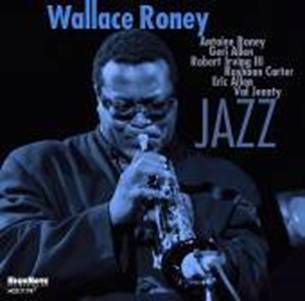 |
Wallace Roney - Jazz (High Note HCD 7174)
|
After 17 years, Roney is still blowing away the cobwebs of his close association with Miles in his twilight years. The virile attitude embedded in his music remains, despite the presence of the fleetingly fingered Geri Allen on piano and the contrasting placid tenor of his brother Antoine whose contributions on soprano and bass clarinet I found more contextual. Roney’s trumpet remains ferocious, but his darker choices during improvisation never fail to conjure images of Davis. I liked the addition of tabla and the DJ’s ultra-contemporary effects despite the customary scratches and in-audible preaching. A hard swinging highlight is Bud Powell’s Un Poco Loco.
   
|
by Peter Wockner.
Previously published in Limelight September 2008 |
|
Back to Index
|
|
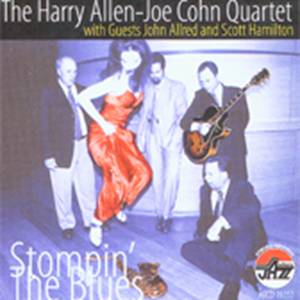 |
Harry Allen & Joe Cohn Quartet plus guests John Allred and Scott Hamilton - Stompin’ The Blues (Arbors ARCD 19353)
|
Harry Allen, a master interpreter of standards, has been called “the Frank Sinatra of the tenor saxophone”. Although born in 1966, his style is based on the classic swing of the masters yet his post Getzian warm and soulful sound is fresh and resourceful. And can he swing! Hearing him in full cry on the title track, his endless flow of inventive ideas spurred on by the rhythmic edge of the rest of the quartet he co-leads with guitarist Joe Cohn, I was reminded of Zoot Sims. There can be no higher praise. As for balladeering, listen to him on the spring medley (It Might As Well Be Spring and Spring Is Here) with the elegant trombone of John Allred, one of the best on the instrument in jazz today. It doesn’t get any better. And one mustn’t forget the London-based Scott Hamilton, 12 years Allen’s senior and his idol as a teenager, who guests on three tracks. Listening to this, it’s hard to believe Hamilton’s saxophone was badly damaged in transit, yet you wouldn’t know it, he blows superbly
    
|
by Kevin Jones.
Previously published in Limelight August 08 |
|
Back to Index
|
|
 |
Monty Alexander - The Good Life (Chesky SACD340)
|
Jamaican pianist Monty Alexander takes a welcome break from exploring the reggae music of his homeland to interpreting some of the melodies associated with the crooner Tony Bennett. And those familiar with Bennett’s exemplary taste, except when pressured by populist record executives, as he was early in his career, will know these are timeless songs. Backed by the Chicago-based pair, veteran drummer George Fludas and bassist Lorin Cohen, Alexander, at time elegant at others energetic, is in fine touch. ‘Maybe September’ is lightly tinged with bossa nova rhythms, ‘I Wanna Be Around’ shrouded in the blues and ‘Emily’ tenderly caressed. Recommended
   
|
by Kevin Jones.
Previously published in Limelight August 08 |
|
Back to Index
|
|
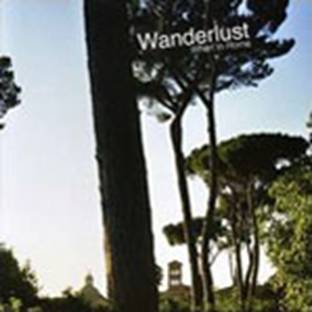 |
Wanderlust - When in Rome (Rufus 1353428)
|
Imagine an Italian summer sky at Villa Celimontana adjacent to Il Coloseo witnessing Australia’s now legendary group Miroslav Bukovsky’s Wanderlust. Admittedly, the sound quality is not at levels expected for live recordings these days (the sound engineer simply pressed record just in case) but the result, in this inspired setting, was a performance too good not to release. Wanderlust’s standards are always lively but there are tender moments especially Alister Spence’s intro to the wonderful melody Delicatessence and one produced by the reunion of former bassist now New Yorker Adam Armstrong in dialogue with guest oud player Joseph Tawadros on Dakar.
   
|
by Peter Wockner
Previously published in Limelight August 08 |
|
Back to Index
|
|
 |
Catherine Russell - Sentimental Streak (World Village 468075)
|
Daughter of ex-King Oliver and Armstrong pianist Luis Russell, Catherine’s voice embellishes each (single take) tune with the characteristics of it’s own genre from New Orleans dirge, the blues, ragtime and traditional jazz, then adapts readily to more contemporary tunes like Sinatra’s ‘South to a Warmer Place’ and her own ‘Luci ’. You can hear the smile on her face due to some cheeky lyrics and the obvious enjoyment of earthy, swinging playing behind her including Steven Bernstein’s trumpet. She’s worked with artists like Paul Simon, Cyndi Lauper and David Bowie but her New Orleans roots are exposed here.
   
|
by Peter Wockner.
Previously published in Limelight August 08 |
|
Back to Index
|
|
 |
Yuganaut - This Musicship (ESP-DISK ESP 4044)
|
The sound-scapes are many and varied from this NY trio utilising 24 diverse instruments plus voice but mainly moog (Stephen Rush), bass and drums. The opener ‘Running’ emerges like the sound of a distant but imminent stampede and indeed drummer Geoff Mann extracts some elephant-like strains from his cornet. From the distorted annoyances of a short wave radio between frequencies, to sounds possibly associated with animal torture and even didgeridoo, these intuitive effects are balanced by the intermittent reference back to classic jazz rhythms by bassist Tom Abbs and Geoff Mann who pleasurably release this tension at opportune moments.
   
|
by Peter Wockner.
Previously published in Limelight August 08 |
|
Back to Index
|
|
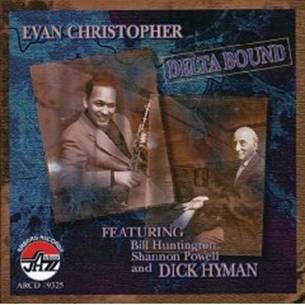 |
Evan Christopher - Delta Bound (Arbors AECD 19325)
|
There is much to admire about the clarinet of Evan Christopher; the whispering woodiness of his tone in the lower register and his bluesy personal sound at the other end of the scale. The Creole tradition is alive and well in the hands of the Californian-born Christopher, both a master and student of New Orleans music. The album is dedicated to Lorenzo Tio Jr, the father of the Crescent City’s clarinet style who taught many of the early greats. Veteran pianist Dick Hyman, another lifelong student of pre-World War II jazz, and two of the city’s finest, bassist Bill Huntington and rhythm master Shannon Powell add a sophisticated touch to the music. Hyman is the perfect musical conversationalist as Christopher’s sound, pure and full, soars throughout from the waltz ‘When We Danced at the Mardi gras’ as it moves into swingtime, to the stately ‘New Orleans’ and his own five originals, which capture the spirit of a great tradition.
    
|
by Kevin Jones.
Previously published in Limelight July 08 |
|
Back to Index
|
|
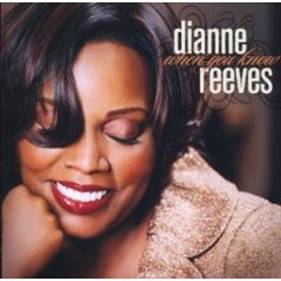 |
Dianne Reeves - When You Know (Blue Note 0946 3 89658 2 4)
|
What a letdown when compared to Dianne Reeves two previous releases, the soundtrack from the film Good Night And Good Luck (Concord) and her last for Blue Note (A Little Moonlight). I found it hard to sustain interest in what is her most commercial recording in years; a strange mixture of pop, soul and jazz covers. Reeves, blessed with a beautiful voice, phenomenal range and clear diction, is as immaculate as ever but she only cuts loose on the final track, the gospel blues ‘Today will be a Good Day’. Guitarist Russell Malone is featured extensively but despite the classy backing, it sounds more like “smooth jazz” than the real thing. After saying that it will probably be nominated for a Grammy!
  
|
by Kevin Jones.
Previously published in Limelight July 08 |
|
Back to Index
|
|
 |
Sweet Lowdowns - Cuttin’ Capers (Preston Records PEP 5105, Distributed by Newmarket Music (NEW 3241.2))
|
It’s uncanny how this Melbourne-based swing quartet captures the sounds of the 1930’s, especially the vocals by drummer Sandra Talty, sounding at times like a mixture of Mildred Bailey and Billie Holiday. But there is much to like about this disc which won the 2008 Australian Jazz Bell Award for the best classic jazz album. It swings easily as befits a working band with Talty, and bassist Richard Mander taking care of business with guitarist Liam O’Connell, a fresh and inventive soloist.. And there’s Michael McQuaid; so impressive whether it’s the light sound of his Lester Young-inflected tenor or his fluid clarinet. A rare talent!
   
|
by Kevin Jones.
Previously published in Limelight July 08 |
|
Back to Index
|
|
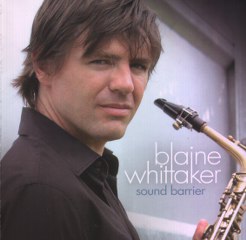 |
Blaine Whittaker - Sound Barrier (Saxis SR108)
|
Post production, slick agility, technical prowess, even some synonymous licks, will draw some comparisons with altoist David Sanborn’s 1990’s output. Highlights include the opening soulful version of Wes Montgomery’s Road Song and Leon Spencer’s funky The Scorpion, then what follows remains firmly in what the industry now calls ‘smooth jazz’. Guests include DJ Bonez who samples (amongst others) a suggestive female ‘check it out’ underneath Whittaker’s brazen baritone horn. James Morrison mutes his trumpet on Walk on By, while James Muller is under instruction to sound like Eric Clapton. Idol’s John Foreman and Erana Clarke ‘touch-down’ very gently with Still Crazy.
   
|
by Peter Wockner.
Previously published in Limelight July 08 |
|
Back to Index
|
|
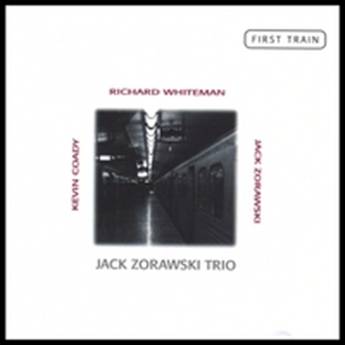 |
Jack Zorawski Trio - First Train (jackzorawski@sympatico.ca)
|
Better known to Canadian audiences, the Toronto bassist’s debut as leader presents an attractive, non-confrontational introduction into an original jazz arena of easy swing, impressionistic ballads and the odd juicy backbeat all taken with two sugars of sweet melody. You may have to overcome the annoying split second gap which fleetingly separates each track and some are faded abruptly, reminiscent of an earlier age of recording. That said, Zorawski is sharing rather than commanding, providing pianist Richard Whiteman, from a Red Garland stylistic lineage, room to showcase his fluid thoughtful approach, touching behind, on, and ahead of the beat.
  
|
by Peter Wockner.
Previously published in Limelight July 08 |
|
Back to Index
|
|
 |
Daniel Levin Quartet - Blurry (Hatology 653)
|
Tony Gorman once said “If it’s a thing of beauty, then its art”. Sharing aesthetic with the German/Austrian art movement Comic Grotesque, trumpeter Nate Woolley achieves those farcical nasal snorting sounds that remind me of a snoring chorus in a Strasbourg hostel dorm knowing I had to wake for an early train. The anxiety takes hold with the scattered splashes of Matt Moran’s vibes and the stretching strains of Levin’s cello. The beauty lies in Ornette Coleman’s Law Years and Charlie Parker’s Relaxin with Lee both taken at snails pace, and with no drums, these works offer a genuinely new interpretation.
    
|
by Peter Wockner.
Previously published in Limelight July 08 |
|
Back to Index
|
|
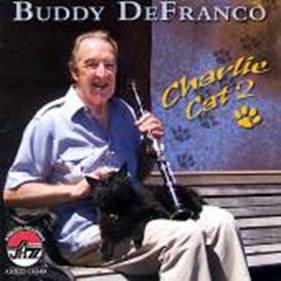 |
Buddy DeFranco - Charlie Cat 2 (Arbors Jazz ARCD 19349)
|
Buddy DeFranco, rated by some as the finest jazz clarinetist after Benny Goodman and Artie Shaw, seems to have drunk form the legendary Fountain of Youth if his latest album is any criteria. Although 83 at the time of the recording in December 2006, DeFranco plays with the energy and vitality of someone half his age as if inspired by the blazing trumpet burst from Lew Soloff which sets off the opening title track. He could not have been more impressive on Joy Spring and Anthropology as befits someone who was the first to play bebop on clarinet.. A remarkable effort.
    
|
by Kevin Jones.
Previously published in Limelight June 08 |
|
Back to Index
|
|
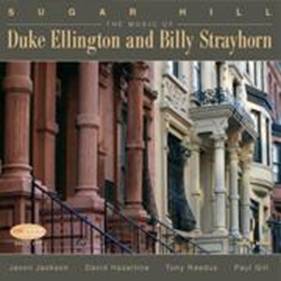 |
Jackson & Hazeltine - Sugar Hill: The Music of Duke Ellington and Billy Strayhorn (Chesky SACD 333)
|
Baritone saxophonist master Joe Temperley and myself have one thing in common: a love for the music of Duke Ellington. He never tires of playing it, .I never tire of listening to it. Especially when it’s as good as this. Instead of a large orchestra exploring the bluesy Ellington moods we have a quartet led by tenor saxophonist Javon Jackson with support from pianist-arranger David Hazeltine, bassist Tony Reedus and drummer Paul Gill. Some of the fare is familiar (Caravan, Chelsea Bridge) but when was the last time you heard a quartet version of Solitude? They rise to even greater heights on the deeply moving ballad Warm Valley.
   
|
by Kevin Jones.
Previously published in Limelight June 08 |
|
Back to Index
|
|
 |
Keith Jarrett, Gary Peacock, Jack DeJohnette - Setting Standards New York Sessions (ECM2030-32)
|
There is nothing standard about the music on this three-disc set reissued by ECM to celebrate the 25th anniversary of one of the elite groups in jazz history: the so-called “Standards: Trio” of pianist Keith Jarrett. Aided by the humming bass of Gary Peacock and the masterful drumming of Jack DeJohnette, Jarrett shows how the great standards – both jazz and popular – could and should be played. And what is even more amazing is that they have continued to raise the bar each year as they explore this music. Even more amazing is that the CDs – two of standard fare (originally issued as Standards Vol. 1 and Standards Vol. 2) and one of mainly improvised original material by Jarrett (Changes) – and much of it unrehearsed, were all recorded over a short period in January 1983, in New York by three musicians with their roots in the avant-garde! But what a revelation as they showed that the great standards, many of them recorded countless times before by other artists, could still sound fresh and exciting as the trio seamlessly integrated from one style to another. Of the highlights don’t miss the rocking gospel of ‘God Bless the Child’, the whispering beautify of the polyrhythmic ‘Never Let Me Go’ or the straight ahead swing of ‘All the Things You Are’. Here is the source of 25 years of creative greatness.
    
|
by Kevin Jones.
Previously published in Limelight June 08 |
|
Back to Index
|
|
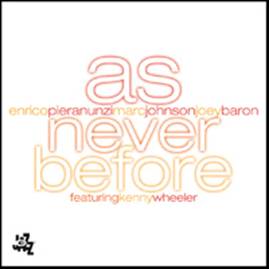 |
Enrico Pieranunzi - As Never Before (Cam Jazz 7807-2)
|
McCoy Tyner once described Pieranunzi as “a new addition to the top jazz-piano world”, and while the gut wrenching, sustained notes from Kenny Wheeler’s trumpet and flugelhorn renders this a rather sleepy first listen, persistence will reward with clingy haunting melodies and masterful playing by his trio of 24 years. With over 30 albums to his credit, the Roman pianist/composer has a knack for contrasting textural changes deployed with astounding effect notably on Many Moons Ago when the flugelhorn’s easy meandering river turns to pianistic rapids in a series of alerting descending runs. Pieranunzi’s originals seem to linger in your head like certain pop tunes; moreover his classical roots no doubt perpetuate the importance of melody. Wheeler’s mournful wavering resonances, as opposed to an orthodox vibrato, on both instruments become more melancholy with age. Marc Johnson’s lyrical bass solos and Joey Baron’s empathy on drums combine to make this a spellbinding album.
   
|
by Peter Wockner.
Previously published in Limelight June 08 |
|
Back to Index
|
|
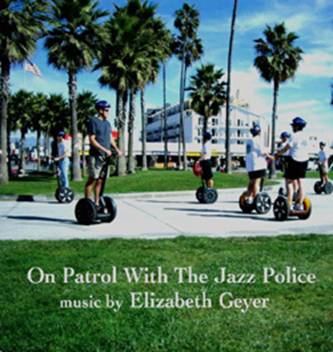 |
Elizabeth Geyer - On Patrol with the Jazz Police (www.elizabethgeyer.com EG003)
|
Elizabeth Geyer’s third album re-boots the momentum driven by The Dream where the aesthetic is blurred between an original contemporary jazz edge and a pianist-singer-songwriter sensibility. Her breathy yearning tone adapts readily to a range of emotions and desires in her lyric. While much of Geyer’s thought provoking poetry is open for personal interpretation, these compositions and arrangements especially the energetic pieces include qualities of climactic drama and surprise. I didn’t want the crescendo of A Candle is Sweeter than Fire to end. Most of her trumpet/flugelhorn acts as improvised gilding but complements the dynamic between Bill Risby’s piano and Jonathon Zwartz’s bass.
   
|
by Peter Wockner.
Previously published in Limelight June 08 |
|
Back to Index
|
|
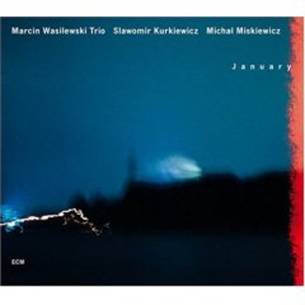 |
Marcin Wasilewski Trio - January (ECM-2019)
|
This Polish piano trio demonstrates maturity beyond its years, due to its history dating back to 1990 as teenagers but gaining stature most recently with their involvement with Tomasz Stanko and Manu Katche. The first five selections are restrained impressionistic sounds lingering like a musical incense. Compositional rights are as diverse as Tomasz Stanko, Gary Peacock and Prince but are tempered with a light touch extracting each minimal essence. Serious tempo only commences on track 6 with Carla Bley’s ‘King Korn’ and they swing hard but swing is no holy grail on this album and that’s what makes it so compelling
   
|
by Peter Wockner.
Previously published in Limelight May 08 |
|
Back to Index
|
|
 |
Pat Metheny - Day Trip (Nonesuch 367828-2)
|
Metheny is back at his melodic best with this mainly tepid but well balanced trio album which in many ways is as good as his Warner Bros output at the turn of the century. The new trio comprises of the most sought after bass player in jazz Christian McBride and rising star Antonio Sanchez on drums. McBride’s bow work on the 2005 Katrina dedicated ‘Is this America?’ is especially exquisite. Not a sound of anger, rather, this is a mournful lamentation with some notes played so caressingly they are virtually implied, just as the question is implied in his melancholy melody; what have we become? Other mood changes include a couple of steaming tempos that showcase their collective virtuosity, a reggae, ‘The Red One’ and the soulful ‘When we were free’ where a gear shift suddenly morphs the guitar sound into an electronic folk-like fiddle. All the selections are Metheny originals.
   
|
by Peter Wockner.
Previously published in Limelight May 08 |
|
Back to Index
|
|
Bravura! While some singers make claim by including evergreens from the Great American Songbook in their repertoire, Irving is a jazz singer. Her scatting would be among the most sincere recorded in Australia since Kerrie Biddell as it has genuine instrumental purpose. The selections are challenging jazz standards for vocalists including Horace Silver’s Doodlin’ and Oliver Nelson’s Stolen Moments but she naturalises them using her warm tone sometimes reminiscent of Michelle Nicolle. Contributions from Matt McMahon’s piano and arr. and Ashley Turner’s bass are worthy of note especially Don Rader’s Milesian bittersweet flugelhorn solo on JJ Johnson’s Lament.
   
|
by Peter Wockner.
Previously published in Limelight May 08 |
|
Back to Index
|
|
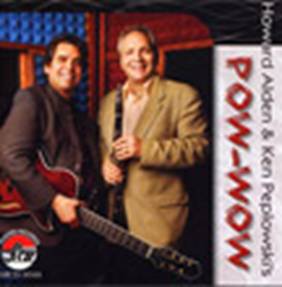 |
Howard Alden & Ken Perlowski - Pow-Wow (Arbors ARCD 19340)
|
This is a brilliant study in jazz interplay, the music rich in its diversity and mood, by long-standing musical compatriots, clarinetist and tenor saxophonist Ken Peplowski and guitarist Howard Alden who first began performing as a duo in 1992 and recorded a well-
received set for Concord Records. There is an almost telepathic connection between the two, one of jazz’s pre-eminent clarinetists and a guitarist noted for his subtle finesse and swing, as they confidently and congenially converse with their instruments. Don’t miss the exciting question and answer romp through the rousing title track based on Cherokee written by another guitarist Joe Puma or the almost reverent treatment of the lovely Billy Strayhorn gem After All. Unfairly dubbed “Young Fogies and New Swing” when they both arrived in New York in the early 1980s, there is nothing tired or ancient about their interpretations of some long-forgotten and little known jazz and popular standards by the likes of Cole Porter, Duke Ellington and Bill Evans to name but a few. Indeed the challenge of fresh the material only emphasizes their deep rapport and musical chemistry: Peplowski’s clarinet is ebullient or gentle, his tenor warm; the perfect foil for Alden
    
|
by Kevin Jones.
Previously published in Limelight May 08 |
|
Back to Index
|
|
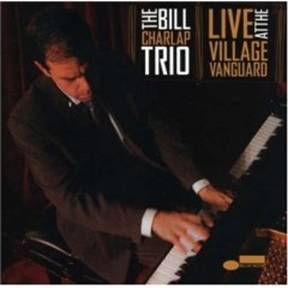 |
Bill Charlap - Live at the Village Vanguard (Blue Note 7143 5 97044 2 5)
|
For anyone not familiar with the Bill Charlap Trio, this set recorded live at the legendary New York club in September 2003, is the perfect introduction. The pianist is the foremost interpreter of the classic standards which sound as if they were written just for him. Few, if any, piano trios swing more than Charlap’s. With the Washingtons, Peter (bass) and Kenny (drums), the pianist gives full reign to his fleet-fingered aerobics on the breakneck The Lady Is a Tramp. But it’s the ballads, where he gives full reign to his sophisticated romanticism, which shows him at his best. Not to be missed!
    
|
by Kevin Jones.
Previously published in Limelight May 08 |
|
Back to Index
|
|
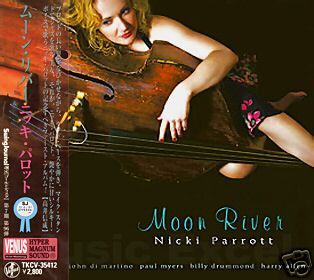 |
Nicki Parrott - Moon River (Venus Records TKCV 35412)
|
The Newcastle-born Nicki Parrott is very much in demand in New York as a bass player. Now her jazz vocals are impressing more and more with a voice that is emotionally sensitive, tender, sometime coquettish and on Nicki’s Blues downright erotic! Harry Allen’s tenor is added on some tracks and he is the perfect accompanist, dreamy (Besame Mucho), grooving easily (Taking A Chance On Love) and playful (Is You Is Or Is You Ain’t My Baby). As for Nicki, her best may be yet to come as a singer but this is more than good enough for now. Impressed? You bet. Just listen to The More I See You.
   
|
by Kevin Jones.
Previously published in Limelight May 08 |
|
Back to Index
|
|
 |
Ruby Braff - Ruby Braff and the Flying Pizzarellis (Arbors ARCD 19270)
|
I never tire of listening to Ruby Braff, the melodic master of the jazz cornet. Like the great Stan Getz in his final months, Braff refused to let his fragile health compromise his artistic integrity and the high standards he had always set. This was especially true on this, his final session, recorded only eight months before his death through emphysema on February 9, 2003 which ended a 54-year (1949-2002) recording career. Some of his finest albums (and for that matter some of the best ever by a small group) were recorded with two guitars. And this is the case here when, reunited with veteran drummer Jim Gwinn and Bucky Pizzarelli, and playing with the trio of the guitarist’s son John for the first time. Braff is in great form, sublime on the ballads and reveling in the spontaneous interplay. It’s typical Braff: nice tunes, beautifully played. What more could you want?
    
|
by Kevin Jones.
Previously published in Limelight April 08 |
|
Back to Index
|
|
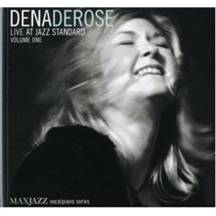 |
Dina Derose - Live At The Jazz Standard, Volume One (MacJazz MJX504)
|
“The most creative and compelling singer-pianist since Shirley Horn” wrote one American critic. No wonder my ears pricked when I first heard Dena DeRose. This album recorded over three nights at the New York club in March 2007 with her trio of seven years (bassist Martin Wind and drummer Matt Wilson) is the perfect setting to enjoy her. Impressed? You bet. She handles her dual role with aplomb. I like her no-nonsense approach to standards as she renews them with the devil may care attitude of the late Anita O’Day. A remarkable talent at the head of one of the best trios in the business!
    
|
by Kevin Jones.
Previously published in Limelight April 08 |
|
Back to Index
|
|
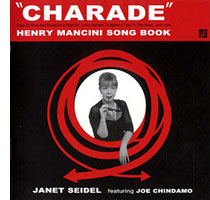 |
Janet Seidel featuring Jone Chindamo - Charade: Henry Mancini Songbook (La Brava LB0077)
|
Vocalist Janet Seidel and pianist Joe Chindamo have one thing in common _ they have both have topped the international jazz album charts in Japan. As they also share a love for melody, it seemed only logical our most popular jazz singer should record with one the country’s very best pianists and on the results here I hope it’s not their last album together. Janet’s albums always have a theme; this time it’s the music of Henry Mancini. The warmth of her voice adds to such staples as Days Of Wine And Roses and Charade and Chindamo, the supreme accompanist, shows how to touch the soul of a ballad and swing easily at any tempo. All class.
   
|
by Kevin Jones.
Previously published in Limelight April 08 |
|
Back to Index
|
|
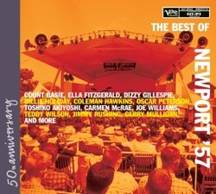 |
The best of Newport ’57 - Various artists (Verve 0625 17416109)
|
Jazz impresario Norman Granz never did anything in half measures. In 1957 he recorded the whole four days of the Newport Jazz Festival for his Verve label. This two-CD set celebrating the 50th anniversary of the event _ most of it never released before _ shows how diverse the music on offer was. Considering the lineup of legendary names, no wonder the 1950’s are considered a golden era. To numerous to mention, they range from traditionalists like Kid Ory and George Lewis to the big bands of Count Basie and Dizzy Gillespie, tenor giant Coleman Hawkins, the Gerry Mulligan Quartet and then contemporary pianist Cecil Taylor. Great memories and some wonderful music.
   
|
by Kevin Jones.
Previously published in Limelight April 08 |
|
Back to Index
|
|
Kim Sanders & Friends - "Bent Grooves" - Sound Lounge 9th May 2007
Such was a celebration of various cultures through regional music, a reflection of the endless pursuit of diversity for Kim Sanders. Whilst performances sharing the theme of diversity have not gone un-acknowledged over the past decade, it felt to me like the shackles of the Howard monoculture had finally been broken during this performance which represented more than just creative music but friendship, inclusiveness, respect and genuine inter-cultural collaboration. Sanders might look like a gypsy with his long greying locks, his Bohemian garb and his goat skin bags but his manner and his dialogue is as Aussie as the next bloke and this fact almost defies the reality of his ability to converse in several languages across the Asian, European and African continents, let alone his ability to foster musical conversations in as many languages using over 14 wind instruments.
Along with Kim Sanders, the core quartet of the ‘Friends’ include Sandy Evans tenor and soprano saxophones, Bobby Singh tabla and Steve Elphick double bass. They opened with Heyamoli a Northern Turkish lament which saw Kim playing Turkish gaida (bagpipe) and Sandy in unison on tenor.
Next they performed the suite A Journey in Saba Makam. The ney is a sufi flute made of bamboo which Sanders freely improvised the first movement Bas Taksim over a singular Elphick drone followed by the additive of Evans and Singh. Such was Evans sensitivity on tenor during the second movement Saba Nefes I that her shadowing was simply an additional tonal flavour of the smokey fluted melody. The final movement showcased the awe-inspiring talent of Singh on tabla.
Sanders who is also a keen surfer, at one time took up the boogie board instead and soon found that serious surfers refer to them as a Speedbump but what commenced as a gypsy jam ended up a Congolese groove thanks mainly to the synchronicity of both Singh and Elphick.
Yet another continent was thrown into the mix with the addition of Chilean Carlos Villanueva and his Andean charango playing the flamenco tinged The Bad Bodgie Bulerias. With an almost clenched fist, Villanueva’s finger nails rapidly raked the repeated four chords of this piece on this instrument of only ukelele dimensions. By now parts of the capacity crowd were shrieking.
Kay Yagar which is interpreted as ‘snow is falling’ was a further showcase of Sanders skills; this time on the double reeded flute, the mey. His circular breathing and tonguing of this instrument created a spellbinding vibrato which preceded his swap to the bagpipes. Another dimension of this piece was the addition of Llew Kiek from the renowned band Mara! on the baglama or Turkish lute.
Istanbul Blues allowed Sandy Evans on tenor a precursor of what was to come on Oi Havar where she simply soared, taking the audience with her on a carpet ride of freedom and joyous expression.
When George Doukas arrived on stage the battle of the bouzouki’s began with Kiek choosing his own richly decorated axe. While Doukas proved a virtuoso, nothing was going to prepare us for the arrival of the final friend Bobby Dimitrievski on clarinet who displayed an agility on the instrument which is rarely witnessed. Following a standing ovation the group finally returned to the stage for a fitting finale. But what was probably the most musically intuitive passage of the performance came after Evans (during her solo) cried to Dimitrievski to ‘join in Bobby’. The result was a lesson to us all in genuine conversation where listening is just as important as speech when the magic of their respective instruments interwove a singular dialect of perfect harmony.
This was nothing less than a triumphant performance by Kim Sanders and Friends
|
|
by Peter Wockner. |
|
Back to Index
|
|
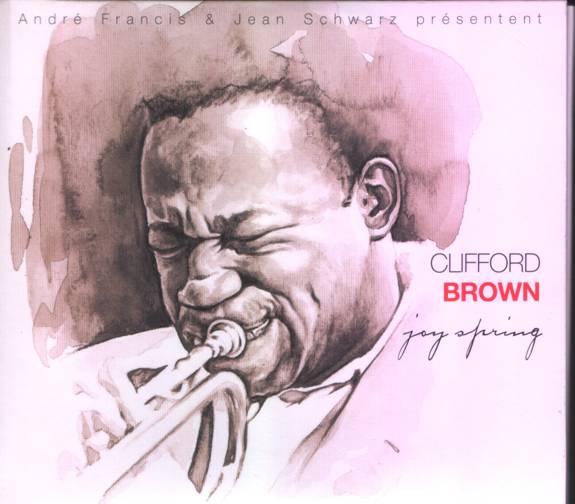 |
Clifford Brown – Jazz Characters, Joy Spring (Le Chant du Monde 2741455-56)
|
A 1950 serious car accident did not deter ‘Brownie’, the young Indiana bop trumpeter from reaching stellar heights with expectations of even surpassing Dizzy. CD 1 charts his development from 1952-1954 including the quirky inclusion of the calypso ‘I Come from Jamaica’. The definitive moments are found on disc 2; firstly a duo with Max Roach which could now be argued as a pre-cursor to Roach’s Freedom Now Suite and a rare live recording of a theatrical Dinah Washington ‘I’ve got you Under my Skin’ complete with Brownie, Clark Terry and Maynard Ferguson trading fierce blows. Tragically, Brownie died in another car accident in 1956.
   
|
by Peter Wockner.
Previously published in Limelight April 08 |
|
Back to Index
|
|
 |
Eliane Elias - Something for You. Eliane Elias sings and plays Bill Evans (Blue Note Records 5099951179526)
|
Elias returns to Blue Note after a short spell with RCA to document a moving tribute to the legendary pianist. Her husband and bass player on this recording Marc Johnson was with Evans in his final trio but it was a cassette recording of unfinished works that triggered this project, part of which can be heard in its original form on the final track. The Brazilian pianist adds her light and breezy vocals with her clipped phrasing to some tracks, but it’s her swinging playing, exquisite time changes and some previously un-recorded Evans material that I wanted to hear most.
   
|
by Peter Wockner.
Previously published in Limelight April 08 |
|
Back to Index
|
|
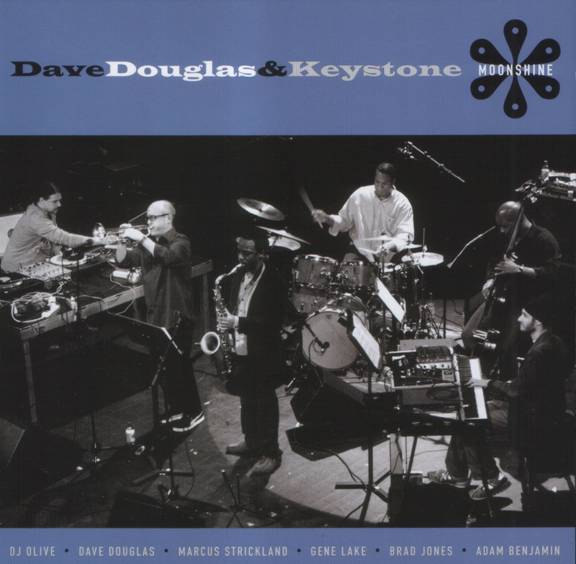 |
Dave Douglas & Keystone - Moonshine (Greenleaf Music GRE-06)
|
Trumpeter Dave Douglas finds new inspiration in a live recording to develop further the futuristic style of his 2005 Keystone release. Moonshine beckons the dancer with shuffling backbeats and questions the conscience with samples of Bush’s monotonous reference to ‘terrorists’ against mournful Middle Eastern female chants juxtaposed by a trumpet lament. The music is spiked heavily by DJ Olive and his laptop, while the fat vibrato of Adam Benjamin’s fender rhodes subconsciously propels the rhythm. Douglas himself strikes the fine balance of pre-conception versus spontaneity that results in such a tasty recipe, embedding this new sound in the tradition of jazz.
    
|
by Peter Wockner.
Previously published in Limelight April 08 |
|
Back to Index
|
|
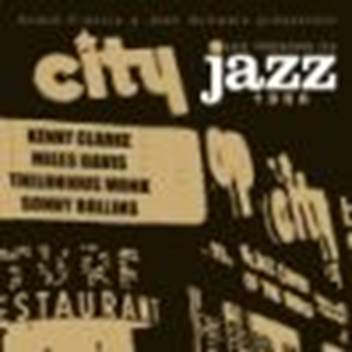 |
Les Tresors - Du Jazz, Volume 7 (1956), Various (10-CD set), Le Chant Du Monde 574 1471.80
|
Ratings are superfluous when faced with a historically important reissue package such as this. In 1956 jazz was part of music’s mainstream (a far cry from today when it is all but shunned by the major record companies) and the sounds recorded rich in their diversity. Greats abound. Ellington, Armstrong and Basie to the MJQ, Miles and Max and Clifford - and the sounds: traditional to big band, mainstream, cool, bebop and post bop. The only greats not represented appear to be Benny Goodman and Coleman Hawkins. And the music! Who said West Coast jazz didn’t swing: a listen to the romping version of the Basie favourite The King by alto saxophonist Bud Shank and tenorist Bob Cooper puts pay to that. Or tenor giant Stan Getz at his imperial best making light of the fast tempo as he outplays both Dizzy Gillespie and Sonny Stitt after they had both vowed to put him in his place musically. Or the genius of pianist Art Tatum with another tenor giant Ben Webster. Or . . . I could go on. This is an indispensable set no serious jazz collector should be without. Already my reissue of the year.
    
|
by Kevin Jones.
Previously published in Limelight March 08 |
|
Back to Index
|
|
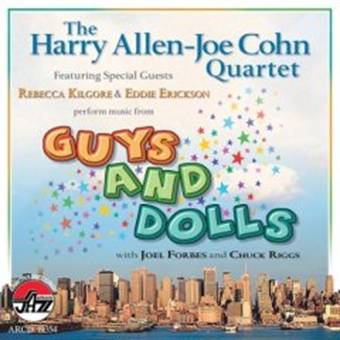 |
Harry Allen-Joe Cohn Quartet - Music from Guys and Dolls (Arbors ARCD 19354)
|
Songs from Frank Loesser’s classic score have proved a favourite with jazz musicians including such greats as Louis Armstrong (Sit down You’re Rockin’ the Boat) and Miles Davis (If I Were a Bell). The mostly hard swinging versions by this award-winning quartet are enhanced by guest vocalists Rebecca Kilgore, warm and supple, and Eddie Erickson, who adds just the right touch to Luck Be a Lady. As for the excellent Allen, he is at his Getzian best on the lyrical I’ll Know and with co-leader, guitarist Joe Cohn, swings joyously on the title track. This is a working band in rare form.
    
|
by Kevin Jones.
Previously published in Limelight March 08 |
|
Back to Index
|
|
 |
The Jimmy Cobb Quartet - Cobb’s Corner (Chesky SACD 327)
|
Fifty years ago albums like this were commonplace, superior blowing sessions built around popular and jazz standards, a blues and a few originals. Today they are an exception to the rule but what an exception this is! Don’t miss it. The legendary Jimmy Cobb, the last surviving member from Miles Davis’ Kind Of Blue session, gives a master class in the art of drumming with a stellar quartet: trumpeter Roy Hargrove, pianist Ronnie Mathews and bassist Peter Washington. Whether open or muted, the versatile Hargrove is all class and the burnished beauty of his ballad playing on flugelhorn quite lovely.
    
|
by Kevin Jones.
Previously published in Limelight March 08 |
|
Back to Index
|
|
Australian pianist Barney McAll continues to forge a pathway in the fertile hot-bed of NYC. Apart from the highly personal compositional style of McAll, the key ingredient here is the addition of the frighteningly agile guitarist Kurt Rosenwinkle. Rather than fluid lines, McAll in a guiding role, uses the piano as a navigational tool within the context of his mood swinging compositions; from agitated thunderstorms followed by sublime composure through to contemplative utterances with subtle influences from Africa, the Middle East and Cuba allowed to bubble through to the surface. Obed Calvaire’s double time cymbal work is quite remarkable.
   
|
by Peter Wockner.
Previously published in Limelight March 08 |
|
Back to Index
|
|
 |
Matt Keegan Trio - Tone Imagination (Jazzgroove JGR039)
|
Enthusiasts identify the famous Blue Note ‘sound’ immediately. The Sydney based collective have released their 39th album and similarly, if there is a sound that embodies the ‘Jazzgroove’ sound then Keegan’s Tone Imagination is it. His trio’s third and finest continues to explore the possibilities of the organ-like shoebox known as the ‘Maestro’ which, when connected to both wah-wah pedal and his saxophone mouthpiece, produces an array of tonal palettes sometimes industrial or metallic at other times radiant and soothing. Cameron Undy on electric bass is not as busy here as his 20th Century Dog digs and instead plays a pure pulsating groove. Keegan’s compositions curb the intensity of Undy’s bass and Goodman’s textural percussion leaving Keegan wider spaces to overdub and orchestrate ravishing releases of tension, undoubtedly influenced by hip-hop projects, DJ collaborations, and the great Eddie Harris. Brilliantly recorded and if you have the luxury of space largesse – turn it up!
   
|
by Peter Wockner.
Previously published in Limelight March 08 |
|
Back to Index
|
|
 |
Steve Russell - When the Light Comes (Pinnacles Music PM 02/04)
|
Further proof of the quality of jazz scene’s outside of our major cities. The pianist has gathered the core artists of the Northern NSW jazz scene. Two sparkling solo-piano standards Round Midnight and Stella by Starlight are expressed thoughtfully and respectfully, while his originals germinate from a generic, well versed tradition then expose contemporary influences from Cuban to Coltrane and West Coast characteristics. Russell’s compositions allow Jack Thorncraft’s bass a collaborative role in forming the melodic appeal of this material and his bow work is as commanding as ever. Tony Buchanan, John Hoffman and Jim Kelly also stamp their brands.
  
|
by Peter Wockner.
Previously published in Limelight March 08 |
|
Back to Index
|
|
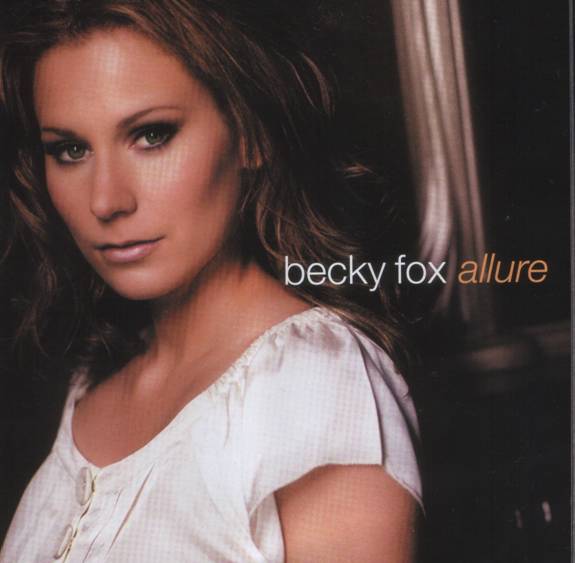 |
Becky Fox - Allure (ABC JAZZ 4766239)
|
Despite the prevalence of pop leaning backing vocals and ‘ooh wooh’ padding, Allure provides more than a taste of the pure essence of Fox’s angelic voice; a voice of luscious sensuality that I’d like to hear in a less produced setting. Most selections are sung in French with remarkable pronunciation. Slick arrangements by Graeme Lyall and others but the re-arrangement of I Love Paris provides little scope for emotional connection with the lyric. Romanticism is at the forefront of a Joe Chindamo piano accordion solo on Let it be Me. Other major contributors include John Hoffman on trumpet/flugelhorn and Simon Patterson on guitar.
  
|
by Peter Wockner.
Previously published in Limelight Feb 08 |
|
Back to Index
|
|
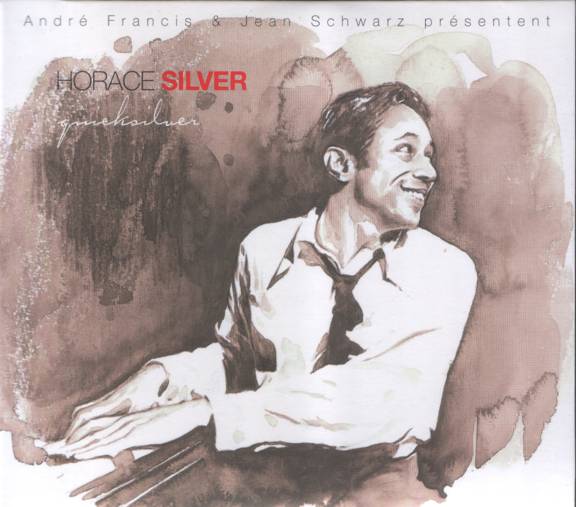 |
Horace Silver - Jazz Characters (Le Chant du Monde 2741537.38)
|
One of 40 titles in the Jazz Characters series compiled by French jazz conservationists Andre Francis and Jean Schwarz. This dual CD set presents the formative pianist in numerous be-bop and trio settings from 1951 to 1954 on disc 1 featuring the blistering Lou Donaldson alto and an un-decided Miles Davis, before gravitating to his signature soul jazz sound from 1954 to 1956 on disc 2, with his quintet and the Jazz Messengers. Re-mastered sound ensures a surprisingly consistent quality throughout. The chronological compilation documents his development from a sizzling bop exponent influenced by Bud Powell, to the soulful melodist at medium tempo.
   
|
by Peter Wockner.
Previously published in Limelight Feb 08 |
|
Back to Index
|
|
 |
Cam McAllister Quintet - Libran Balance (CAM001)
|
Rich dark chocolate harmonies set against a background of melodic bass-lines and energetic rhythms dominate this independently released debut album from the Melbourne trumpeter. Listen intently and allow his mood changing but highly accessible compositions to overshadow his gently piercing trumpet style showing some Terence Blanchard tendencies coupled with a certain soulful fragility. At it’s most dramatic, White Knight has a feeling of mystery and intrigue via the captivating lines of pianist Mark Fitzgibbon. Dave Rex on alto completes the classic quintet instrumentation while trombonist Jordan Murray guests on three of the nine tracks. A talent deserving wider recognition.
   
|
by Peter Wockner.
Previously published in Limelight Feb 08 |
|
Back to Index
|
|
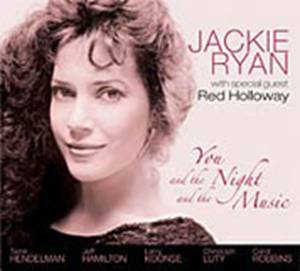 |
Jackie Ryan - You And The Night And The Music (OpenArt OA 07292)
|
I’ve been so busy praising Roberta Gambarini for the past 12 months that I’d forgotten about the San Francisco-based Jackie Ryan who has been a fixture at Ronnie Scott’s Club in London for the past eight years and sung at major venues in New York and Los Angeles. This brilliant album, her first for four years, is a timely reminder that Ryan who one English critic called the best singer to appear at Ronnie Scott’s since the late Shirley Horn, shows she is among the very best of her generation. Four years is too long between albums for a singer with such a richly expressive voice although I understand one with pianist Cyrus Chestnut and tenor Eric Alexander will be released later this year. I detect overtones of both Sarah Vaughan and Betty Carter and, like the former she has the ability to rephrase a melody. But she is very much an original stylist from her whiskey and honey tone in the lower register to the crystal clear intonation at the top. And her backing is all class; pianist and arranger Tamir Hendelman, bassist Christopher Luty, drummer Jeff Hamilton and, on five tracks, the ballsy tenor of veteran Red Holloway. Every track has something to offer: the sensual beauty of Besame Mucho, the lovely ballad Never Let Me Go and the swinging title track to name a few. Unreservedly recommended.
    
|
by Kevin Jones.
Previously published in Limelight Feb 08 |
|
Back to Index
|
|
 |
Ella Fitzgerald - Live At Mister Kelly’s (Verve 06025 17332157)
|
A real treasure trove, this set captures a relaxed Ella Fitzgerald in an intimate setting interacting confidently with a live audience at the Chicago nightclub in 1958 with her trio. Never released before, probably because Norman Granz had already issued concert albums with her from the Hollywood Bowl (1956) and the wonderful Live At The Opera House (1957). This is vintage Ella, a mixture of up-tempo numbers, lovely ballads and swing anthems scatted as only she knew how. Many were songs she rarely sang including two associated with Frank Sinatra; In The Wee Small Hours and Witchcraft, complete with verses. A must for Ella fans
    
|
by Kevin Jones.
Previously published in Limelight Feb 08 |
|
Back to Index
|
|
Described by drummer-leader Anthony Howe as “classic jazz Aussie style”, this is bright and more than acceptable music played by one of the best small groups of its kind. It may have traditional roots but Howe’s deep knowledge and catholic taste keeps the band’s repertoire varied, original and good humoured. Here it includes compositions by Duke Ellington, Benny Carter, Gerry Mulligan, his own originals and a Jimmie Lunceford-styled Ain’t She Sweet. Spurred by a healthy rhythm section, the rocking ensembles are played with ease and assurance leaving space for strong solos, especially by trombonist Dan Barnett, both open and muted and pianist Peter Locke, one of the unsung treasures of the Sydney jazz scene. .
   
|
by Kevin Jones.
Previously published in Limelight Feb 08 |
|
Back to Index
|
|
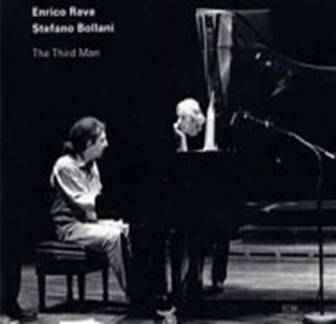 |
Enrico Rava and Stefano Bollani - The Third Man (ECM 2020 173 7322)
|
Musicality, freshness and lyricism; these words sum up this album by ECM’s Italian dream team, the richly gifted improvisers trumpeter Enrico Rava and pianist Stefano Bollani. The nimble-fingered virtuoso, who has all the jazz piano styles at his fingertips who won the 2007 European Jazz Prize sponsored by the city of Vienna, is the perfect foil for Rava’s warm and melodic trumpet. Most of the tracks are Rava originals; standard-like melodies, tone poems and free improvisations plus two takes of Jobim’s romantic Retrato Em Branco Y Petro and the lovely Estate caressed so yearningly in Milesian fashion by Rava. In one word: delightful
   
|
by Kevin Jones.
Previously published in Limelight Feb 08 |
|
Back to Index
|
|
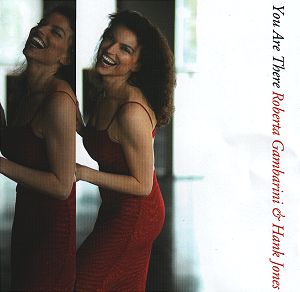 |
Roberta Gambarini and Hank Jones - You Are There (Emarcy 0602517370678)
|
“A dream come true” is how Roberta Gambarini describes her second album, this 2005 session with piano master Hank Jones who has been a consummate accompanist to singers for more than 50 years. And a good pianist does wonders for a singer! Think of the Ella Fitzgerald Gershwin sessions with Ellis Larkins or, in a more popular vein, Tony Bennett with Bill Evans. The Italian-born Gambarini could not have asked for a more tasteful or sympathetic soloist than the 89-year-old Jones, the last of a famous dynasty with drummer Elvin and flugelhornist and arranger-composer Thad. Described in the 1950s as a “modern day Teddy Wilson”, Jones shows why as he elegantly but with maturity enhances the beauty of Gambarini’s melodic control on a memorable Stardust and adds to her warmth on the ballad Deep Purple. They may have been born generations apart and in different musical eras but Gambarini and Jones are a perfect match.
The fastest rising vocal star in jazz, Gambarini has been compared to Ella although I find Carmen McRae more of an influence. Admittedly there are similarities with Ella whose vocal powers no one could match but the sparkling When Lights Are Low and her slow scat on People Time show Gambarini’s flexibility. She will record even better albums than this in the future, a mouth-watering prospect.
    
|
by Kevin Jones.
Previously published in Limelight Jan 08 |
|
Back to Index
|
|
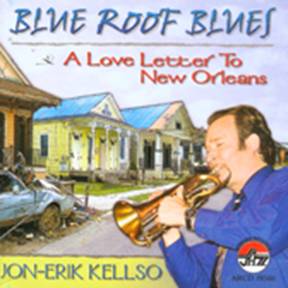 |
Jon-Erik Kelso - Blue Roof Blues: A Love Letter to New Orleans (Arbors Jazz ARCD 19346)
|
Jon-Erik Kelso and Evan Christopher will be familiar to traditional and mainstream jazz lovers who have attended the annual Bob Barnard Jazz Party in Melbourne. Kelso may have Chicago roots but his trumpeting shows his affinity with the music of New Orleans and Christopher’s clarinet playing continues the classic legacy of a rich musical tradition. They seamlessly bond together on originals and breathe new life into such hoary chestnuts as Panama (dig the habanera beat) but the highlight is Kelso’s long but mournful title track which captures the bruised heart and soul of a devastated city; a very special letter from the Big Apple to the Big Easy
    
|
by Kevin Jones.
Previously published in Limelight Jan 08 |
|
Back to Index
|
|
 |
Russell Malone - Live At the Jazz Standard, Volume Two (MaxJazz MXJ604)
|
No stretching the boundaries of jazz here, just guitar playing of the highest class as Russell Malone, a brilliant soloist, shows why he is held in such high esteem. Listen to the shimmering sensitivity of Irving Berlin’s How About Me, a ballad feature which is just one of the many delights of the second “live“ album by Malone’s working band; pianist Martin Bejerano, bassist Tassili Bond and drummer Jonathan Blake, taped at the Jazz Stand club in New York in September, 2005. Malone finds new avenues of exploration on these extended workouts. It’s mainly original material but there are exceptions, especially his inventive take on The Theme from Gunsmoke
   
|
by Kevin Jones.
Previously published in Limelight Jan 08 |
|
Back to Index
|
|
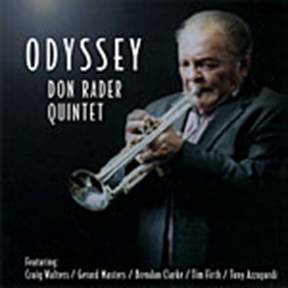 |
Don Rader - Odyssey (Newmarket 3237.2)
|
Trumpeter Don Rader has chosen a mixture of hard bop, jazz standards and originals to showcase his new young quintet and on the evidence here, it won’t be the last we will hear from a group which shows a high level of creativity solo wise and the horns blend nicely together. It includes two of Rader’s former students, pianist Gerard Masters who plays with a graceful economy and sparkling ebullience, and drummer Tim Firth. Brendan Clarke, Sydney’s most in-demand bassist, and tenorist Craig Walters complete a lineup which is augmented by Tony Azzopardi on two tracks. Rader is tastily muted on Alone Together and the group obviously enjoyed the Latinised Bernie’s Tune.
   
|
by Kevin Jones.
Previously published in Limelight Jan 08 |
|
Back to Index
|
|
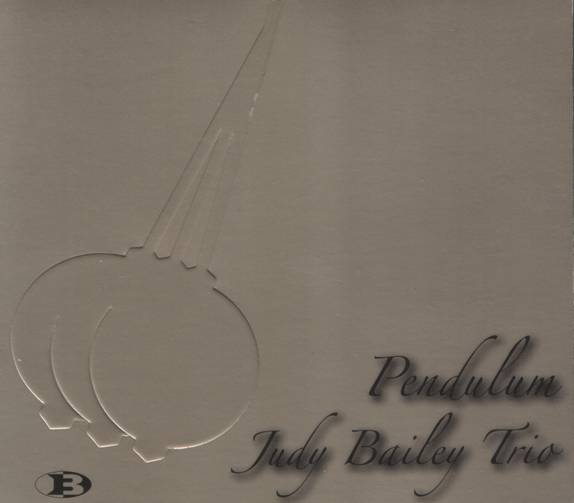 |
Judy Bailey Trio - Pendulum (BL017)
|
The release of a new Judy Bailey trio recording should be a regarded as a treasured moment in the history of Australian jazz. Her composition choice carries an air of majesty from the dark harmonies and shimmering arpeggios of the wonderfully lyrical ‘Flamingo’ to her own soulful ‘Country – not Western Blues’ and a jaunty rhythmic re-arrangement of Cole Porter’s Night and Day. Craig Scott lays a multi-coloured conduit and extracts all the physical nuances of his double bass during solo-work while Tim Firth’s abstract brushwork on Tad Dameron’s ‘If You Could See me Now ‘, is like a Gene Kelly tap routine.
   
|
by Peter Wockner.
Previously published in Limelight Jan 08 |
|
Back to Index
|
|
Laced with weighty potent passages of unashamed rock and funk, this trombone and guitar led recording exposes the groove and grunge sound of the younger Sydney jazz set. The wailing and growling trombone of Jeremy Borthwick also displays some remarkable piston-like agility especially on the Indian and African flavoured pieces along with some ferocious guitar work from Ben Hauptmann. Most compositions employ sections of jamming and overdubbed trombone harmonies hanging above repetitive guitar motifs, but pendulum swings and momentum shifts surprise when roles reverse and melody takes over. There’s also the rare taste of Brendan Clarke playing electric bass utilising synthesised effects.
   
|
by Peter Wockner.
Previously published in Limelight Jan 08 |
|
Back to Index
|
|
 |
GEST8 - Kaleidoscope (Tall Poppies TP195)
|
Sandy Evans and Tony Gorman are again pushing jazz through its outer most boundaries with sounds that reflect the diversity of Australia’s social landscape without abandoning fundamentals. Sadly, today’s music scene offer’s few live opportunities for a band like GEST8 but the cohesive interplay between members is a testament to their level of musicianship. Compositionally compelling and zany as ever; Gorman’s Kaleidoscope was built around the architecture of Coltrane’s Giant Steps while Evans’s bumbling The March of Captain Vanstone had me laughing out loud. You’ll find GEST8 a compass range away from the previously successful Clarion Fracture Zone with Satsuki Odamura’s ground-breaking koto and bass koto melding with the Korean informed percussion of Simon Barker. Greg White’s sampling, the flexibility of Carl Dewhurst’s guitar, Paul Cutlan’s accordion-like Eb clarinet, Phil Slater’s ethereal trumpet and Steve Elphick’s well travelled bass add artistic dimensions of enormous proportion.
It should be made compulsory listening to fulfil the citizenship test.
    
|
by Peter Wockner.
Previously published in Limelight Jan 08 |
|
Back to Index
|
|
 |
Dexter Gordon - Live in 63 & 64 (Jazz Icons Naxos 2.119002)
|
When not riding his bicycle around Copenhagen, Gordon was, at 40, touring Europe using pick-up rhythm sections playing a repertoire steeped in the history of jazz. Holland 1964 and the relaxed, handsome Gordon, (epitome of cool) enters the cosy club late, the rhythm section already on stage, wearing a trench coat through the haze of cigarette smoke, gives a charming dignified introduction to ‘A Night in Tunisia’; a reflection of his stately tenor sound. Switzerland 1963 was a concert hall but with a milk bottle sounding piano while Belgium 1964’s ‘Body and Soul’ with Art Taylor on drums is simply a treasure in both picture quality and sound.
    
|
by Peter Wockner.
Previously published in Limelight Jan 08 |
|
Back to Index
|
|
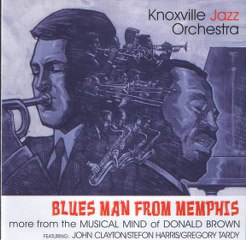 |
Knoxville Jazz Orchestra - Blues Man from Memphis (Blue Canoe BC 1040)
|
Few jazz orchestras compare with the K.J.O. No less than seventeen chairs with room for fifteen additional artists on eight mostly medium to up tempo originals by the Mississippi born pianist, composer & leader Donald Brown, who replaced James Williams in Blakey’s Messengers in 1981. The three live selections have the powerhouse sound you’d expect, however the studio cuts portray a multifaceted composer of swing, blues, contemporary, reggae and Latin with a refreshingly restrained intent of extracting the essence of each composition. Guests include Stefon Harris & Greg Tardy. A highlight is ‘Peace for Zim’ with a distinctive township flavour and a screaming Tardy tenor solo.
   
|
by Peter Wockner.
Previously published in Limelight Dec 07 |
|
Back to Index
|
|
 |
Andrew Robson and Paul Cutlan - Simpatico (Lamplight Records LLR00106)
|
This is a duo set of musical conversations. In the context of compatible spontaneous improvisation, listening to each other goes hand in hand with creation. The Sydney reedmen listened intently as they played on this delightful balancing act of atonal freedom and melodical motifs. Foreshadowing, foxing and reaching for the unknown, rather than the known, without compromising on melody, some of which are clearly influenced by their tenure with the Eastern European flavoured group Mara! Cutlan plays tenor and Eb clarinet but predominantly with the bass clarinet and uses the lower extremities to haunting effect, while Robson often plays the straight man on alto.
   
|
by Peter Wockner.
Previously published in Limelight Dec 07 |
|
Back to Index
|
|
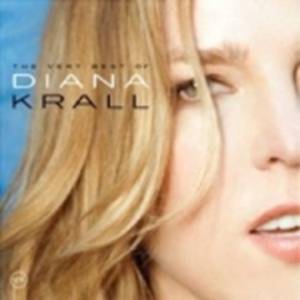 |
Diana Krall - The Very Best Of Diana Krall (Verve 9547000)
|
Diana Krall must have put a special emphasis on her signature opening tune I Love Being Here With You during her first major American tour several months ago after giving birth to twins on December 6 last year.
She took “my little angels” (the twins Dexter and Frank) with her! That’s hardly surprising for someone who considers herself to be a hands-on mother but this is an artist who the previous decade spent 300 days each year on the road.
“I ended up sleeping two hours a day,” she says on the telephone from London but she had the best reviews of her career with critics from the east coast to the west lavish in their praise. Motherhood and marriage to Elvis Costello obviously agree with the 42-year-old singer-pianist. Combining them with a career is the ultimate challenge but Krall says it’s “going surprisingly and extraordinarily well. I’m loving it. Not a lot of sleep but I’m loving it. I make the most of every moment. It’s been the pivotal point of my life having my own family.”
She’s more relaxed, content and happy and it shows as we talk. Maybe it’s the thought that after our conversation she will be ringing the United States to check on the twins.
With Oslo the next stop and hardly any rest from performing until a break in December-January combining her two careers may become more daunting in future. “I have five more years to figure that out. I don’t plan on an early retirement. Jazz musicians don’t really retire. We keep going, but I will always do what is best for my family.”
The songs she sings act as emotional weather report. With demos already in hand for her next album, a second collaboration with veteran arranger-conductor Claus Ogerman and the London Symphony Orchestra to be recorded in February, the forecast couldn’t be better.
To paraphrase one of the first albums I ever bought (Jazz for People Who Hate Jazz), Diana Krall remains the jazz singer of choice for those who really don’t dig the music. It’s her personal interpretations of the great standards whether with a lush string orchestra, a big band or small groups that has enabled her to attract both the jazz and mainstream audiences. The emphasis is on ballads in this classy retrospective drawn from eight of her previous 10 albums but there are also examples of her with a trio or quartet, the format which first captured the attention of the jazz lover. She describes the album as being “for people who have never heard of me”. Never heard of her! It’s hard to imagine anyone who has not heard of this critically and commercially successful singer who remains one of the hottest, if not the hottest, vocal property in jazz. She’s a class balladeer. Listen to the tracks from her 1999 collaboration with arranger Johnny Mandel (When I Look In Your Eyes) where his string arrangements provide the perfect platform for Krall’s sultry, honey-laced with bourbon voice as she seductively purrs through the bossa nova flavoured Let’s Face The Music And Dance and reflectively explores I’ve Got You Under My Skin. She confidently moves into Sinatra territory on the previously unreleased lament of lost love, Only the Lonely, with the London Symphony Orchestra. And the swinging quartet tracks before a live Paris audience show what a stunning performer she is. Krall respects these songs and delights in singing them; there’s no better way for newcomers to get acquainted with her talents than this set which is coupled with a DVD of concert footage and videos.
    
|
by Kevin Jones.
Previously published in Limelight Dec 07 |
|
Back to Index
|
|
 |
Kurt Elling - Nightmoves (Concord Jazz 7230138)
|
The multi-talented Kurt Elling is the best male jazz singer around. A master of scat singing, he reigns supreme in the art of vocalese. ie putting words to improvised solos. By utilising tenor star Dexter Gordon’s solo, he turns the long, bravura tour de force on Body and Soul into a dedication to his daughter; words are added to Keith Jarrett’s Leaving Again leading into the inspired cameo of In The Wee Small Hours. He musically enriches poems by Walt Whitman and Theodore Roethke with jazz, and that’s not even scratching the surface of his best album to date. The last word in jazz singing!
    
|
by Kevin Jones.
Previously published in Limelight Dec 07 |
|
Back to Index
|
|
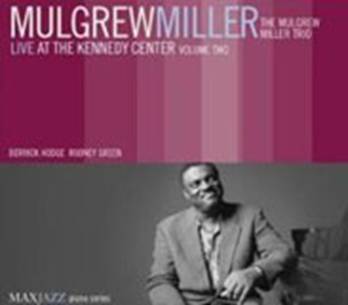 |
The Mulgrew Miller Trio - Live At The Kennedy Center, Volume Two (MaxJazz MXJ219)
|
Oh to have been among the audience on the opening night of the KC Jazz Club at the John F. Kennedy Center for the Arts on September 5, 2002 in Washington DC to hear Mulgrew Miller with bassist Derrick Hodge and drummer Rodney Green take the piano jazz trio to its highest level. This second volume continues where the first left off with the music vibrant, energetic and intense, reinforcing the view that Miller is at his best before a live audience. Impressively fleet-fingered on the hard-swinging opener Song For Darnell, Miller’s Eleventh Hour mixes boogie woogie with the blues and a rousing finish to end an album where the powers of inspiration never flags.
    
|
by Kevin Jones.
Previously published in Limelight Dec 07 |
|
Back to Index
|
|
 |
Ella Fitzgerald and Louis Armstrong - The Ultimate Duets (Verve 530 0986)
|
Ella Fitzgerald and Louis Armstrong set the bar at the highest level when they recorded this series of duets for Norman Granz’s Verve label in 1956-57. These duets have never been surpassed either in jazz or popular music (I can already imagine angry die-hard traditionalists pressing the claims of those with Louis and trombonist Jack Teagarden with his lazy, Texan burr.) But here we have two of the last century’s elite artists paying homage to some of the greatest of the classic American popular songs in their own unique way. It was a contrast in styles: Ella’s bell-like clarity of tone and rhythmic brilliance against Louis’ guttural charm, warm personality and rhythmic intensity.
Then there was their mutual warmth and humour of which there is no better example than the Swing Era favourite Stompin’ at the Savoy which begins sedately before evolving into a bubbling tour de force with references to bandleader Chick Webb and some joyful scat singing. The ballads are beautiful, especially Autumn in New York, The Nearness of You and Summertime. And a gem from 1950, Sy Oliver’s arrangement of Dream a Little Dream of Me which could have been the catalyst for this inspired pairing six years later.
    
|
by Kevin Jones.
Previously published in Limelight Nov 07 |
|
Back to Index
|
|
 |
Harry Allen & Joe Temperley - Cocktails for Two (Sackville SKCD2-3071)
|
Take two top instrumentalists, add a classy rhythm section, stir in several jazz and popular standards and a blues, and shake before a live audience. The result is a musical cocktail of the highest order. The always swinging tenor Harry Allen (40) blends effectively with the masterful baritone of 77 year old Joe Temperley, soloing strongly from the platform provided by pianist John Bunch, bassist Greg Cohen and drummer Jake Hanna. Both are masters of the ballad – Allen at his Getzian best on Everything Happens to Me and Temperley expressively eloquent on Polka Dots and Moonbeams. This is my kind of music
    
|
by Kevin Jones.
Previously published in Limelight Nov 07 |
|
Back to Index
|
|
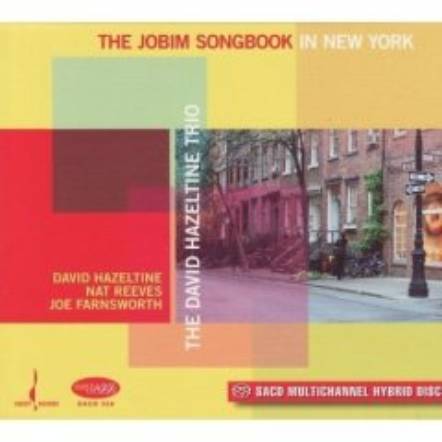 |
David Hazeltine Trio - The Jobim Songbook in New York (Chesky SACD 328)
|
It takes a special pianist to stamp his own individuality on the lovely melodies of Antonio Carlos Jobim, especially when faced with what is a line-up of the ‘greatest hits’ by arguably the last of the great popular composers. But David Hazeltine, whose trio with bassist Nat Reeves and drummer Joe Farnsworth is one of New York’s best, continues to show there are no limits to his imagination or any tune he can’t rearrange or re-harmonise. Whether it’s the free flowing Meditation or the beauty of O Grand Amore, Hazeltine is fresh and fluid. A trio session where everyone shines!
   
|
by Kevin Jones.
Previously published in Limelight Nov 07 |
|
Back to Index
|
|
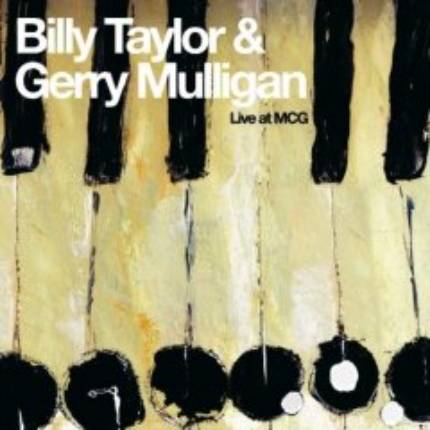 |
Billy Taylor & Gerry Mulligan - Live at MCG (MCG Jazz MCGJ1025)
|
It may have taken 14 years, but thankfully this summit meeting between esteemed pianist and educator Dr Billy Taylor and baritone saxophone giant Gerry Mulligan is available at last. Good friends on and off the bandstand, they took part in a series of concerts at the Manchester Craftsmen’s Guild in Pittsburgh over 1-3 October, during which Taylor recorded the pilot program for his respected NPR Jazz at the Kennedy Center series. It’s an intriguing dialogue: the combination of Mulligan’s lyricism and light touch and Taylor’s percussively bop approach, especially their duet on All the Things You Are which begins as a fugue. A set to treasure.
    
|
by Kevin Jones.
Previously published in Limelight Nov 07 |
|
Back to Index
|
|
 |
Carol Sloane - Dearest Duke (Arbors Jazz ARCD 19350)
|
Carol Sloane is an absolute marvel. She made her debut as a vocalist with the Larry Elgart orchestra in the 1950’s, caught the attention of jazz fans at the 1961 Newport Jazz Festival, yet at the age of 70 still remains one of the best of today’s traditional jazz singers. She has always had a love for the music of Duke Ellington yet, unlike her two previous albums of Ellingtonia, there are no strings or all star backing. Instead she has opted for the minimal but sympathetic backing of clarinetist and saxophonist Ken Peplowski and pianist Brad Hatfield which accentuates her heart-felt renditions of some of the Duke’s finest ballads.

  
|
by Kevin Jones.
Previously published in Limelight Nov 07 |
|
Back to Index
|
|
 |
Watermelon Slim - The Wheel Man and The Workers (Northern Blues Records)
|
Vietnam veteran, anti-war activist, forklift operator, sawmiller, firewood salesman, collection agent, funeral director, truck driver, watermelon farmer, small time criminal... Add to the mix bachelor degree in journalism, master degree in history, membership in Mensa (certified genius IQ group) and the great BLUES TALENT. This is Bill Homans a.k.a. Watermelon Slim. His previous CD (released in December 2006) gathered six 2007 Music Award Nominations for Artist, Entertainer, Album, Song, and Traditional Album of the Year in USA, was ranked Number One by MOJO Magazine and won Blues Album of The Year - among several other awards. Now Northern Blues Records continues with Slim's second record - "The Wheel Man and The Workers".
Actually, this will be his third record. The first LP was recorded in 1973 and was based on Homan's Vietnam war experiences (he taught himself to play blues in military hospital using 5$ balsa-wood guitar and Army issued Zippo lighter as the slide). After that came long years as a truck driver hauling industrial waste, near death heart attack in 2002 and decision to return back to Blues. Thirty years of tough life on the road added to Slim's smoking voice, which resonates with emotional depth. The very gutsy performance of the band - The Workers - should also be noted. The Wheel Man, Jimmy Bell, Sawmill Holder (this is the voice only number, but how deep and crisp it is!), Judge Harsh Blues are the highlights of this cut. This album is a strong and very authentic collection of songs, sung from the heart, from the experience of a very rough and colourful life.

  
|
|
by Vlad Gilbourd. |
|
Back to Index
|
|
Rarely does one audio collection include such broad insight into 20th century’s greatest musical art-form. Bed Sidran “on assignment from a future generation” displays the technical expertise as an interviewer and the theoretical knowledge as an accomplished musician/performer to reveal the essence from 60 of the music’s major figures on a 24 CD set. Conversations rather than interviews between 1984 & 1990 reveal emotional thoughts and meaningful dialogue amongst heavyweights like Miles Davis, Dizzy Gillespie and Branford Marsalis. Respectful, non-patronising questioning and candid heartfelt answers of honesty and sometimes humility; Sidran asks Miles about his sound; “it’s like your sweat, it’s your sound” or Dizzy’s admission on be-bop; “Charlie Parker, he’s the one that created that style of playing” or Marsalis on family pressure to avoid pop music “my first musical hero was not Charlie Parker, it was Elton John.” For most jazz fans, Talking Jazz will be revelation upon revelation
    
|
by Peter Wockner.
Previously published in Limelight Nov 07 |
|
Back to Index
|
|
 |
Jazzgroove Mothership Orchestra with Florian Ross - Dream Wheel (Birdland Records BL016)
|
“Intellect and feeling do not exclude each other” says German pianist/composer Florian Ross and his statement sums up why his assimilation with the Jazzgroove Mothership Orchestra in September 2006 was triumphant. The second release of the JGMO was recorded live at the Sound Lounge and Ross contributed 6 of the 7 selections including 2 recognizable melodies via some clever re-arrangements of Autumn Leaves and Come Rain or Come Shine. An abundance of composed contrapuntal lines, with traditional big band space for the soloist, underscored by warm harmonies and serious swing; they are not simply keeping the candle burning for important composers they are flamethrowers.
   
|
by Peter Wockner.
|
|
Back to Index
|
|
 |
The Steve Hunter Band - Dig My Garden (Birdland Records BL015)
|
Steve Hunter’s originality on the electric bass has lured great artists like Billy Cobham, Chick Corea and Bobby Previte and after spending 10 months in Andalusia, he’s added another facet to his compositional skills and virtuosity. The tapas flavours are best savoured on The Lemon Bird, Cazador and the bass solo Poema del Bajo. James Muller dazzles on Cazador (Spanish for Hunter), a musical theatrical experience complete with suspense, surprise, drama and climax. He then exposes his largely hidden talent on acoustic guitar. But while there is no dismissing Steve Hunter’s balladry, his signature appeal is found in those rapidly rumbling riffs.
   
|
by Peter Wockner.
Previously published in Limelight Nov 07 |
|
Back to Index
|
|
 |
Dave Brubeck - Indian Summer (Telarc CD 83670)
|
“A sort of Indian summary” is how Dave Brubeck describes the title track, a number he first recorded more than 50 years ago. It also sums up this superb piano showcase, the third and best of his three solo albums for the label. Moving and reflective, it’s probably his most personal statement on disc as the 86 year-old recalls his life in music with rarely-heard standards and his own compositions acting as signposts on the journey. With emphasis on restraint and intimacy, he shows the fires of creativity still burn brightly. Recorded shortly after being inducted as a Living Legend of Jazz at the Kennedy Center in Washington on March 3rd 2007, Brubeck shows his mastery of changing tempos and a wide range of styles, despite being in considerable pain with a severe foot injury. An elegant You’ll Never Know, recalling his days as a soldier in World War II, sets the scene for a nostalgic mood laced with lovely melodies. Brubeck admits to becoming more aware of the lyric “the days dwindle down” from September Song but although in the twilight of his career, on the evidence here he has never played better. A magnificent recording.
    
|
by Kevin Jones.
Previously published in Limelight Oct 07 |
|
Back to Index
|
|
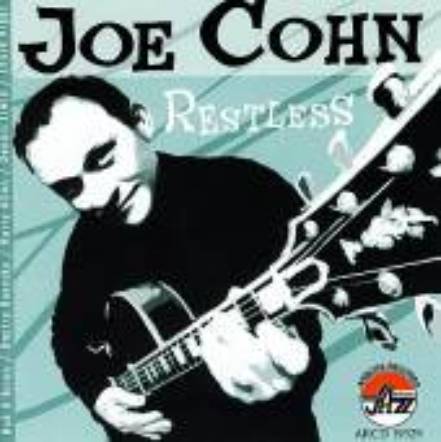 |
Joe Cohn - Restless (Arbors ARCD 19329)
|
Harry Allen’s melodically inventive gifts and lovely tone, which have made him a great favourite of mine, are fully displayed in this session under the leadership of guitarist Joe Cohn, with whom he leads a swinging quartet. Allen plays on only five numbers on the album, but his languid reading of the title track Restless is a knockout and he unleashes his full-bodied tone on the up-tempo Comes Love with Russian altoist Dmitri Baevsky. The mix of originals (two by his famous father Al Cohn) and standards from the musically fertile 1930’s seem the right mix for a fine set by a guitarist who impresses more with each hearing.
   
|
by Kevin Jones.
Previously published in Limelight Oct 07 |
|
Back to Index
|
|
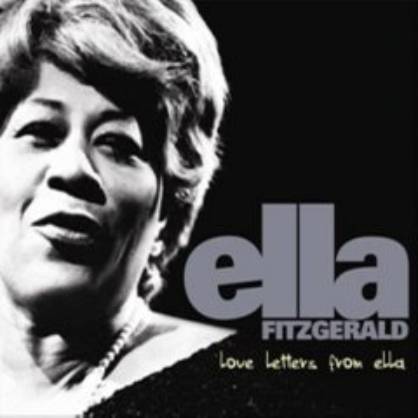 |
Ella Fitzgerald - Love Letters from Ella (Concord Jazz 723 0213)
|
Be warned this is latter-day Ella Fitzgerald and not the finest from that era. Be warned also that except for those with Count Basie and his Orchestra and Our Love is Here to Stay with pianist Andre Previn from 1983, the best track, newly-recorded backing has been added to Ella’s voice including the London Symphony Orchestra and a contemporary rhythm section. But even the LSO cannot hide the deterioration and surprising fragility of Ella’s voice, sad really, like listening to Frank Sinatra in the autumn of his years. With so much prime Ella to be reissued in the coming months, this can be ignored – except by completists!
  
|
by Kevin Jones.
Previously published in Limelight Oct 07 |
|
Back to Index
|
|
GEST8 - Friday 26th October 2007, Sound Lounge
Hearing GEST8 perform live should be made compulsory in the Citizenship Test. GEST8 is the brain-child of Sandy Evans and Tony Gorman who were internationally successful with their previous joint project with Alister Spence Clarion Fracture Zone [CFZ]. However such is the state of the Sydney jazz scene, that, this band has only given public performances once a year since it’s inception in 2004. Interestingly, the Sydney Improvised Music Association has presented the band on every occasion. In contrast, I recall CFZ playing the Manly Jazz Festival, the Bellingen Jazz Festival and many more local events during it’s hey day in the 1990’s.
The performance was opened with the Gorman piece The Emperor’s Old Clothes with Evans giving a blistering soprano saxophone solo while Satsuki Odamura used a bow to sustain the impact on koto. Odamura was commissioned to introduce the instrument to Australia and was given a prime opportunity to collaborate with Sandy Evans in this band. The koto has 13 strings, each with its own bridge requiring re-tuning to suit each composition. It’s likely that the traditional Japanese sound of Koto in the world of jazz is unique to this band. Phil Slater took the next solo creating digital resonances as a pre-cursor to his later improvised piece with Greg White on the computer, while Simon Barker’s dancing style over the drum kit is as much of a joy to witness as it is to the ears. Next up was A Shower of Sunbeams a piece written by Evans with a shuffling West African rhythmic feel where Joe Zawinul meets Ornette Coleman,
The inclusion of Greg White in this group is another facet that pushes the boundaries of jazz or indeed improvised music. His improvised duo with Phil Slater created water droplet images and ironically a needle skimming across the surface of a playing record.
After a lengthy Gorman monologue sharing the story behind Whistling at Dinner, (a thump to the head from grandfather ensured that he was the only one allowed to whistle at the dinner table, a fact that Tony and the rest of us present will never forget) written by Gorman with the string trio in mind of Steve Elphick’s bass, Carl Dewhurst’s guitar and Odamura’s koto. The tension these three created was akin to overbearing warmth of a roaring fireplace in a small room.
The first set finished with a rendering of the title track of the album Kaleidescope (Tall Poppies), written by Gorman using the changes of Coltrane’s Giant Steps, featuring both the Eb clarinet of Paul Cutlan and Dewhurst’s slicing guitar.
This second set opened with the piece Just 8 which is not on the album but written by reed player Paul Cutlan. It showcased his playing of bass clarinet which at times sounds much like the didgeridoo. Written while on tour with the Mara! band across the top end. Needless to say, it recalled the arid wilderness of remote northern Australia.
The March of Captain Vanstone had me laughing out loud again. It stumbled along like a clumsy clown via the harmonies of Evan’s tenor and Cutlan’s bass clarinet then into the gaping steps of Elphick’s bass. The koto added to the feel of calamity prior to the start of the march which was appropriately cut short.
Living with MS and lots of time on his hands, Tony Gorman learnt the guitar and from that achievement came the piece Lambent. A spacious, melodic piece that celebrates what is possible from a dedicated artist facing head-on, a lifelong disability.
The blues School’s Out starts out as a scramble prior to Cutlan’s bass clarinet interacting with Odamura scraping the strings of the koto. In fact much of the improvisations built into these arrangements were interactions between the artists rather than single soloists. Slater took a wandering then excited solo on trumpet. It’s now off to the Wangaratta Jazz Festival for GEST8. My goodness! That will be two gigs this year!
|
|
by Peter Wockner. |
|
Back to Index
|
|
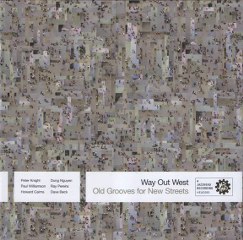 |
Way Out West - Old Grooves for New Streets (Jazzhead HEAD085)
|
A mixed marriage of unprecedented success! While the thought of fusing African and Vietnamese music may appear unusual, the result is one of the most compelling releases of 2007. Trumpeter Peter Knight is a renowned innovative composer. Dung Nguyen brings the fleeting street sounds of Vietnam using a modified electric guitar and multi-stringed dan tranh. Dave Beck, Howard Cairns and Ray Pereira, are at one with the rhythms, the latter especially textural when raising the African grooves to danceable levels. But their grooves are corralled by the underlying focus on interaction and expression through the horns of Knight and Paul Williamson.
    
|
by Peter Wockner.
Previously published in Limelight Oct 07 |
|
Back to Index
|
|
 |
Chris Cody Coalition - Conscript (Nocturne CHC001)
|
The restless rhythms immediately impact like a chorus of castanets, while the pianist’s balladry attracts like the smell of a freshly baked baguette. Ex-Zappa & Lacy trombonist Glenn Ferris is featured heavily with his abundant flow of fervent ideas seemingly expressed with ease, from breathy and intimate to fidgety, festive and boisterous. Sydney pianist Cody has been based permanently in Paris since 2000 and it seems his art has been allowed to blossom. While clear melody lines exist in all 11 selections, dynamic impetus shifts maintain an ‘edge of your seat’ feeling to the vast majority of these impeccably recorded works.
   
|
by Peter Wockner.
Previously published in Limelight Oct 07 |
|
Back to Index
|
|
 |
Sara Gazarek - Return to You (Native Language NLM0967-2)
|
One gets the feeling of honesty in the voice of Sara Gazarek. On her second release, she has chosen to retain much of the trusted formula of her 2005 debut Yours. John Clayton Jnr’s production and the Josh Nelson trio are back but this time with the addition of strings on 3 of the 13 soft pop ditties. Nelson triples his worth on piano; Hammond B3 and glockenspiel while Erik Kertes does likewise on double bass, guitar and guitarlele. This gives a stylistic flexibility to the landscape which moves effortlessly from swing to folk and country embodied by Gazarek’s sweetly enunciated twang.
   
|
by Peter Wockner.
Previously published in Limelight Oct 07 |
|
Back to Index
|
|
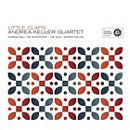 |
Andrea Keller Quartet - Little Claps (Jazzhead HEAD083)
Andrea Keller – piano
Eugene Ball – trumpet
Ian Whitehurst – tenor saxophone
Joe Talia – drums
|
The promotional material that accompanies this release would have you assuming contemplative chamber-like, western art music in a unique bass-less quartet; a fair enough assumption, given the instrumentation. What lies beneath however is a playful set of musical fantasies - almost childlike at their essence, but brought to life in a wholly accessible and engaging jazz playhouse. Each of the 10 pieces is written by the pianist Andrea Keller for this quartet’s third release and the first with drummer Joe Talia.
Talia sets the landscape ‘Under the Birch Tree’ with a shuffling brushwork groove before Keller’s broad reaching chords allow Ian Whitehurst’s radiant shafts of light to penetrate the canopy like Renoir’s The Garden in Montmartre. Eugene Ball follows as a magical talisman introducing his celestial trumpet tone, singing through those skylights to the heavens.
‘The Dance’, not surprisingly is an elegant waltz time signature. Keller leads a jaunty momentum akin to the spring of a ballerina in a series of triplet sautés across the stage, while the fullness and deft touch of Keller’s left hand (as it does throughout this recording) defies the reality of the bass’s absence in tribute to pianist Geri Allen. ‘Lady Geri’ sews this recurring thread of Keller and Talia playing the rhythmic foundation against saxophone and trumpet shadowing each other in a sense of freedom and diversity.
‘Moments in Parallel’ is the album’s highlight of spontaneity, introspection and telepathic interplay, breathing in and out of time changes. Juxtaposing power then intimacy, the horns rotate then morph into a haunting close knit harmony while both ‘Foibles (of the Big Bad Wolf)’ and ‘Lines on my Face’ are almost novelty interludes. The former rocks along huffing and puffing its way through 2 minutes and 24 seconds to ‘Lines’ and its syncopation of Keller-esque ragtime interspersing the rhythms of another era against an atonal horn headline.
‘Broken’ becomes more unconstructive despite its obvious charted passages for trumpet and saxophone. Keller and Talia release the reigns but the dynamics retain their sensitivity, honoring the temperament; neither laughing nor crying.
‘Hand me Downs’ is the second of two introspective pieces. Melancholy in its utterances of conflicting distant memories drawn from Keller’s sepia harmonies and Talia’s lattice-work poly-rhythms, but Whitehurst’s saxophone enters with a clear notion of events. Wearing another’s hat never really changes who you are. Received as a gift, it should be adapted to suit your own purposes.
A change of role play on ‘Jim’s Favourite’ transpires with the horns ushering in a shimmering rhythmic harmony amid Keller underplaying the sweet melody. By this stage I’m conditioned to the bass-less sound as Keller’s left hand claps thunderbolts of weighty bass chords before allowing the sunset to fade away under a deadened single treble string note.
Whether the farcical idea of ‘Singing in a Sinking Ship’ was inspired by the Titanic or not, it will certainly put a smile on your face. Following Keller’s lyrical solo intro, Ball is torn between the flight of a bumble bee and the flight of a butterfly spoiled for choice in a colourful garden. Quality systems will amplify his voicing strains through the trumpet’s mouthpiece.
Surprise! Surprise! After 30 seconds of silence between ‘Sinking Ship’ and track 11 which is not credited on the album sleeve, the quartet launches into a rollicking four minute bonus studio encore. Why 30 seconds of silence? Just enough time to provide your own lounge room standing ovation.
The little claps of my one year old aren’t intrusive or indeed raucous. Rather, it’s the feeling of innocent purity that makes those little claps extra special.
   
|
by Peter Wockner.
Previously published in Limelight Oct 07 |
|
Back to Index
|
|
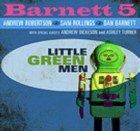 |
Barnett 5 - Little Green Men (Vitamin B5001 April 2007)
Dan Barnett - trombone, voice
Andrew Robertson – saxophones
Sam Rollings – guitar
Ashley Turner – bass
Andrew Dickeson – drums
|
Why do we have yet another new release re-creating hard-bop, soul jazz and blues from another era? Sam Rollings puts it simply “its music that appeals”.
The idea to record this material was encouraged by an overwhelming response at the 2005 Wangaratta Jazz Festival. Mainly known for his big band vocals, Dan Barnett adds his voice to two of these eight tracks. He tends to channel the scatting of the late Joe ‘Be-Bop’ Lane and his friend and mentor Mark Murphy simultaneously on the original ‘Soup Song’ and Nat Adderley’s ‘Old Country’.
Additionally, other selections are refreshingly obscure. Ellington’s ‘Searchin’ is given soulful treatment, Wayne Henderson’s hard swinging ‘The Young Rabbits’ and NYC guitarist Peter Bernstein’s ‘Little Green Men’ (LGM), the latter showcases Rollings’s easy fluency.
Ashley Turner brings more than just NYC experience to his bass role. His contribution ‘The Girls are Groovin’, the artistic highlight, walks along with a suggestive sassy swagger. The horn lines are uncluttered but sustained in dual harmony, gliding over the rhythm and allowing Rollings’s guitar, the space to tickle the underbelly of the melody.
Original Jazz Crusader Wayne Henderson’s composition is taken at a hopping pace by Robertson’s bright but largely anonymous alto tone while Barnett, especially at this tempo, displays a greater clarity and agility in a more traditional classical jazz setting.
A former flautist, Andrew Dickeson relishes this late 1950’s hard bop style, dropping bombs and riding his heavy cymbals with metronomic precision.
LGM is further proof that there is much more yet to be explored of this post be-bop genre and it’s most competent explorers are not necessarily drawn from the land of its creators.
  
|
by Peter Wockner.
Previously published in Limelight Oct 07 |
|
Back to Index
|
|
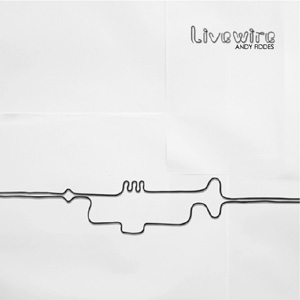 |
Andy Fiddes - Livewire (Jazzgroove JGR038)
Andy Fiddes - trumpet
Serge Ermoll - piano
Peter Knight - trumpet
|
The word ‘Hybrid’ comes from the Latin word ‘Hibrida’ or ‘Mongrel’. The word once was used for one born of a Roman father and a foreign mother or a freeman and a slave, but has since been corrupted to mean refined or efficient.
The Livewire idea of expressing rock ideals using an improvised platform or a jazz sensibility has ‘Hybrid’ graffitied all over it. It sounds refined but there’s an abundance of mongrel here to enjoy with gusto too.
Joystring. Are there no limitations to the possibilities of what can be communicated from a single Majkowski bass note? Communication can be as innocent as two tin cans and a piece of string or have the complexity of the selfless emotions that these individuals are sharing with each other.
A Question of Creation. Again the rhythm section causes tension prior to the Fiddes appearance against a racing bass line. The bridge in question evokes a Miles Davis ‘All Blues’ that has been marginalised by a shift in communal attitude. Fiddes triumphs with originality in his ideas and configurations.
Unstable Substances. Following a hauntingly lyrical intro, the mystique of the substances unfold into a melodic bass line underneath an initially reflective Fiddes but then he leads the band on an increasingly intrepid gradient until a plateau is reached where the view is quite exhilarating. Harrison then tightens the reigns, regroups the band to treasure the moment.
Struck from Above. Here is a good resting place to devour the warm sustained neon tone of the Fiddes flugelhorn. The rhythm section creates an intermittent breath-like time zone where life is nothing more than a simple journey to share ideas collectively rather than individually.
Return of the Darkness. Intent on drawing inspiration from Australian rock in the 1970’s; the earthy bass figures, the intensity in emotion, Mannell zealously charting ground where most rock drummers don’t go but then digging even deeper as a backdrop for Harrison to explore a series of ascending and descending runs. This is the distilled essence of Livewire, packed with drama and texture.
The Tolling. Picture a group of gypsies emerging out of the darkness of an eastern forest, entranced by what they can hear. Listen in wonder at their dancing spirit, made more infectious by Mannell’s use of toms and the snare off. Joyous but fervent, melodic but engrossing, celestial but relevant.
Ritalin. A spacious addictive rolling rhythm is established (around about heartbeat pace) and an equally spacious but restrained Fiddes solo smelling of the blues, augments itself before Harrison adds a lyrical bridge prior to being joined again by Fiddes in a mild mannered dialogue, rather than a fierce trade-off.
Lights On, Lights Off. The final brief ensemble piece provides another opportunity for group interplay. Its ambient and textural rendering has the lasting effect of communion, promise and a compelling urge to press ‘play’ again.
|
by Peter Wockner.
Previously published in Limelight Oct 07 |
|
Back to Index
|
|
 |
Jane Monheit - Surrender (Concord 072300507)
|
Jane Monheit considers Ella Fitzgerald her mentor and inspiration so it’s surprising she was not on Verve’s ‘We All Love Ella’ tribute. Except for Diana Krall, Dianne Reeves, Dee Dee Bridgewater and, maybe Patti Austin, she has far greater claims and ability than the other so-called “big name singers”. Monheit shows she has come of age on this, her first session for the Concord label: a lovely, lush and romantic album of ballads and bossa novas which show off the richness of her warm and supple voice. More contemporary fare than previous albums but the standouts are an elegant ‘A Time for Love’ and the stunningly lyrical ‘Moon River’
   
|
by Kevin Jones.
Previously published in Limelight Sept 07 |
|
Back to Index
|
|
 |
Oscar Peterson, Ray Brown & Milt Jackson - The Very Tall Band (Telarc Jazz CD-83663)
|
Respected jazz writer Gene Lees first used the phrase “The will to swing” to sum up the piano playing of Oscar Peterson. It also describes the musical philosophy of two other giants, vibraphonist Milt Jackson and Ray Brown, on this follow-up album to ‘Live at the Blue Note’ recorded over three nights (Nov 24-26, 1998) at the New York club with young drummer Karriem Riggins, the only one of this “dream band” not in his 70s. It has a feel of an after-hours jam session with Peterson and Jackson spontaneously feeding ideas to one another in extended workouts on six jazz and popular standards and a blues. The relaxed ‘Limehouse Blues’ sums it up.
   
|
by Kevin Jones.
Previously published in Limelight Sept 07 |
|
Back to Index
|
|
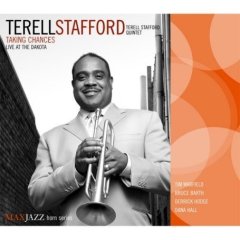 |
Terrill Stafford Quintet - Taking Chances: Live at the Dakota (MaxJazz MXJ405)
|
Trumpeter Terrell Stafford’s first live recording is one of his best, if not his best yet. Beautifully recorded at the Dakota Bar and Grill in Minneapolis, Minnesota in 2005, it showcases his classy quintet to perfection in a mixture of standards and originals. Stafford shows his delicately muted side on the lovely ‘Old Folks’ but there is not one weak track with standouts being the long and languid ‘Taking a Chance on Love’, the stomping ‘Blues for J.T.’ and the changing moods of the renovated traditional ‘Jesus Loves Me’ where Tim Warfield shines on soprano.
    
|
by Kevin Jones.
Previously published in Limelight Sept 07 |
|
Back to Index
|
|
Manly Jazz Festival 2007
Large crowds enjoyed warm sunny days and good doses of jazz across most of its styles despite the loss of the festival’s long term Artistic Director John Speight. Traditional tastes were as usual well catered for by the likes of Paul Furniss and Geoff Bull, while many proud parents listened to the jazz of the future in the showcase of student bands over the three days. Mainstream jazz from evergreens Errol Buddle and Bob Henderson continued to prove crowd pleasers at the 30th anniversary of this festival for the masses. Two of Australia’s greatest vocal talents appeared at this year’s festival with Michele Nicolle backed superbly by drummer Robby Ferella, guitarist Carl Dewhurst and bassist Jonathan Zwartz while Kristin Berardi was accompanied by guitarist James Sherlock in support of their award winning album. Modern jazz was represented by US horn duo Bob Montgomery and Al Hermann visiting for their third festival joined by James Muller. While their version of Coltrane’s ‘Africa’ was a refreshing diversion into the avant-garde it was all undone with a corny jazz version of ‘Waltzing Matilda’ while Dale Barlow teamed up with Hammond B3 man about town Darren Heinrich. Numerous highlights included original contemporary material from Sydney Conservatorium’s Craig Scott, with the frontline of Paul Cutlan and Warwick Alder. Alto saxophonist Andrew Speight led his quintet through a soul jazz concert so funky that in the 1960’s Cannonball Adderley would have regarded it a threat. Although a version of Zawinul’s ‘Mercy Mercy Mercy’may have been an appropriate addition given the keyboardist’s untimely recent death. In fact the absence of any dedication to Zawinul or music from his songbook throughout the festival is indicative of the mainstream course it has taken in recent years. Warwick Alder was in scintillating form with the uncompromising Bernie McGann quartet where it seemed his flawless technique allowed articulation of every challenging idea that arose. This was a set normally be reserved for presentation at the Sound Lounge.
Michelle Nicole singing her version of Ornette Coleman's 'The Blessing'
Plaque dedicated to the re-named ‘John Speight Stage’ at the Corso Manly
San Francisco based AndrewSpeight
Craig Scott, Manly
Mr Percival spontaneously improvising at Manly
|
|
by Peter Wockner. |
|
Back to Index
|
|
'Wanderlust' - 28th August 2007, Sound Lounge
Miroslav Bukovsky (flugelhorn 1st set trumpet 2nd set) James Greening (trombone) Alister Spence (piano) Steve Arie (bass) Fabian Hevia (drums) Jeremy Sawkins (guitar)
In the era of economic rationalism, one of the fundamental difficulties for bands has been the challenge of endurance. It seems those that remain are the survivors who endear their audiences whilst maintaining and revitalising their central themes. One of those bands is Miroslav Bukovsky’s Wanderlust. Since the early 1990’s ‘Lustzone’ experiments in Bellingen and elsewhere, with perhaps the more innovative Clarion Fracture Zone (CFZ), Wanderlust has never been far from the forefront of Australian jazz, riding a wave of renewed international interest in fusing jazz with various regional music.
About 90 people aged from approximately 12 to 75 were present at the Sound Lounge; exemplifying the band’s diverse following. Nods of approval from both Bukovsky and the audience met the first James Greening trombone solo on ‘Delicatessence’; treated gingerly with sustained notes and delicate phrasing. In contrast, Bukovsky produced a bold lip splitting solo on flugelhorn whilst left handed guitarist Jeremy Sawkins used synthesized motifs on his guitar, steering the piece to an exploding climax of group synchronicity.
Bukovsky commented, “When I first heard CFZ perform Alister’s [Spence] ‘Samba Nova’ I decided to form a band just to play the tune”. Why not?!!
In the hands of Wanderlust, Samba Nova not only re-kindles fond memories but is harmonically darker and brassier. Spence’s unique style of improvising, akin to a series of FAQ’s, were answered by passages bringing to mind the contrasting styles of Chucho Valdez and McCoy Tyner. His quizzical but compelling solo was the catalyst for the night’s foot tapping to commence. Chilean born Fabian Hevia in his element deploying cowbells and rim shots, sent Bukovsky’s flugelhorn into screaming territory it wasn’t built to inhabit.
Spence’s ‘Twilight Rain’ swapped intensity for understatement. His random treble descending runs were as entrancing as raindrops trickling down a window pane. Hevia’s brushwork and Sawkins’s dampened chords shuffled along in a perfect tempo to hear the thoughtful mood change of Greening who prompted the pensive crowd to acknowledge the warmth of Bukovsky’s lyrical flugel prior to producing a passage with perhaps even more expression. “Nice solo”, mildly put by one punter.
‘Manchao’, a piece written by Hevia is the essence of Wanderlust. The steep climb up the Andean mountain was conjured by contrasting phases of momentum, alternating Blakey-esque ride cymbal passages with a plateau of primitive beats more likely associated with Argentinean bombo drums. I noticed at least one mountaineer dancing in his seat.
The second set opened with Steve Arie unfolding a dramatic and deceptively wrapped ‘The Year of the Pig’. With no hint of the melody line, he worked the length and breadth of the fingerboard but achieved greater clarity and more potent ideas from the bottom end rather than the top. Greening, now more brazen and funky, shouldered the rhythm section’s impetus to the summit where the group paused to reflect on the view. Arrives Bukovsky, who replaced flugelhorn with trumpet, and produced his sound from the bell of the horn in contrast to say Marsalis where it comes from the bore. While it may not have dazzling agility, it’s brighter, projected and quite magnetic. When muted and intimate with the microphone, it’s tender and vulnerable. Following his tonguing solo along with Hevia’s backbeat and Sawkins’ grinding guitar, the tune almost petered out prior to the final re-ignition of the melody line.
The arrangement of ‘Field Call’ was much freer than the recorded version. Sawkins built Middle Eastern and Frisell-like western phrases into a frenzy of jaunty African township jive before a return to a sustained simmer. Greening heralded the impending storm against the backdrop of dark brewing clouds above an African plain, with the final flurry of notes like a flock of birds startled by a wildebeest. “Yes! Yes!” the audience was finally passionate.
Again Arie opened ‘Dakar’ and utilised his expansive fingerboard reach and painted the vast sandy desert. Wanderlust is often lazily tagged Brazilian/Latin but I tasted North African and Mediterranean in their mix. Even broader, ‘Dakar’ adopted a post Bitches Brew electrical persona, via Spence who distorted the piano strings against Sawkins’s looped guitar. Greening seamlessly took up Spence’s plucked treble string and produced a sound of uncanny likeness. Could they become any more dramatic I wondered before ‘Dakar’ morphed into their stalwart ‘Bronte Café’. Hevia’s heart beat bass drum allowed Greening the spotlight to withdraw submissively which left a yearning void before Hevia’s thunderous use of the toms, snare and cow bell underpinned the all too familiar melody; track No 1 of their 1993 self titled debut.
From the expressions on faces at the Sound Lounge on the 24th August, the survivors have successfully continued their tradition.
|
|
by Peter Wockner. |
|
Back to Index
|
|
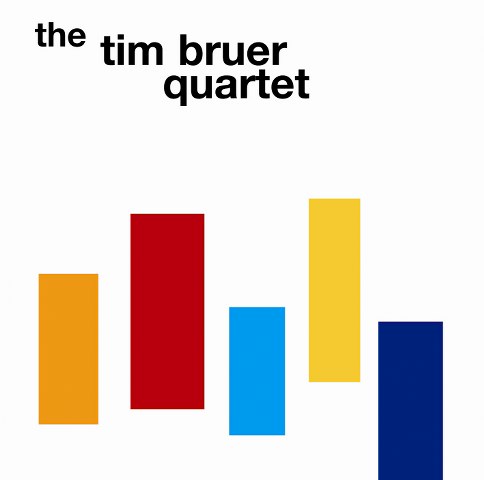 |
The Tim Bruer Quartet (La Brava LB0073)
|
While Tim Bruer’s debut as leader is diverse in it’s influences, it’s fundamental straight ahead hard bop with lyrical, funky, swinging and melodic qualities featuring Sean Coffin on tenor, Brett Hirst bass and Simon Barker drums. Showcasing original compositions from the pianist, the opener ‘Like John’ is more than a nod to John Coltrane’s version of ‘My Favourite Things’. ‘Euroscape’ has a Nordic inference, while ‘Plastic Elastic’ and ‘Slinky’ have a deliciously understated backbeat that simmer along very nicely. While each voice is distinctive, this has the sound of a collective largely due to Bruer’s caressing rather than forceful touch.
   
|
by Peter Wockner.
Previously published in Limelight September 07 |
|
Back to Index
|
|
 |
Deidre Rodman & Steve Swallow - Twin Falls (Sunnyside Records SSC1149)
|
More than a romantic reminiscence of pianist Rodman’s birthplace, these melodic original compositions cut a picturesque pathway back to Twin Falls Idaho. The literal composition titles evoke images on a land, non-natives may never have seen; ‘Skatelands’ slippery stride and Swallow’s gentle misty glow on ‘Midnight Snow-Bright’. Inspired by the striking beauty of a township by the mountains, Rodman takes a sentimental and sometimes theatrical journey back ‘home’. Swallow’s pure, serene sound on electric bass complements this duo setting where Rodman’s preferred channel of remembrance is through melodies that linger. Without reading the liners, the album could quite easily be mistaken for a film score.
   
|
by Peter Wockner.
Previously published in Limelight September 07 |
|
Back to Index
|
|
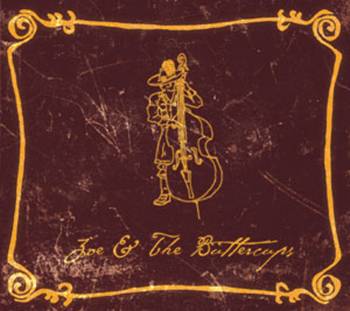 |
Zoe and the Buttercups (Jazzgroove JGR 035)
|
Bill Frisell and Norah Jones have fused country, folk and jazz, but neither could fully prepare you for this new jazz hoedown, complete with a grinding guitar dual, finger picking banjo and agile horn sections underpinned by a warmly toned double bass. The Hauptmann family affair made up of Zoe (bass, leader), Ben (guitar, banjo) and James (drums) comprises of originals written from a jazz rockabilly perspective. Portions, when used as a vehicle for jamming might be less than captivating, but the mood changes, momentum shifts and infectious grooves more than compensate. Dan Waples alto solo on ‘Feral and Bed’ deserves recognition for it’s rapid-fire fluidity and articulation
   
|
by Peter Wockner.
Previously published in Limelight September 07 |
|
Back to Index
|
|
Tony Gorman and Bobby Singh - As Wide as the Sky, Paddington Uniting Church, 13th September 2007
A small but dedicated audience attended the Sydney launch of the new album by Tony Gorman and Bobby Singh ‘As Wide as the Sky’.
Tony commenced proceedings by proudly demonstrating his ‘Sruthi’ boxes. A contraption which has it’s origins in India, and looks rather like an old transistor radio, capable of producing 3 constant notes but a fourth drone can be wound up or down to the pitch of choice. The effect two of these boxes create can be quite mesmerising. Soaking in this ambience of clarinet, sruthi and tabla was like being invited into Tony’s world. A world which was turned upside down for Tony, when over a decade ago, he discovered he had MS.
Tony Gorman has his own sound on clarinet and it can be distinguished either on his past Clarion Fracture Zone triumphs or his latest meditative yearnings. Utilising simple sustained melodies, multi-phonics and most importantly a deeply spiritual desire to create, Tony Gorman communicates now with the same dedication but within his limited physical capabilities. His duo with the sruthi boxes lasted around 30 minutes prior to Bobby Singh’s empathetic contribution on tabla. His dazzling technique amplified perfectly throughout the Paddington Uniting Church. Most of these sounds created from fingering rather than smacking the drum. He moved seamlessly from rapid relas to Bollywood backbeats.
The album is a live ‘in-store’ recording at Birdland Records and is issued on the Birdland Record label.
|
|
by Peter Wockner. |
|
Back to Index
|
|
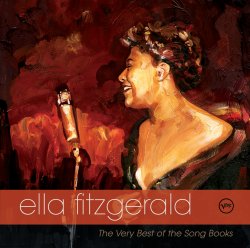 |
Ella Fitzgerald - The Very Best Of The Songbooks (Verve 1705238)
|
It’s a matter of opinion whether you agree with the blurb that these tracks are the “crème de la crème” from the songbooks recorded by Ella Fitzgerald between 1956-64. If that were the case they would have been mainly those from the George and Ira Gershwin Songbook with arranger Nelson Riddle, the highwater mark of this monumental series dedicated to the greatest of all the American popular music composers. The Man I Love and Embraceable You are obvious choices here but to leave out Someone To Watch Over Me! The albums weren’t perfect.: Buddy Bregman’s charts for the Cole Porter set were unimaginative and Duke Ellington’s ego meant he would not play second fiddle to anyone, not even Ella.. The arrangements were virtually [put together by the Duke and Billy Strayhorn in the studio which is why the mall group Ellingtonia recordings with tenor saxophonist Ben Webster, violinist Stuff Smith and guitarist Barney Kessel are much more enjoyable. However, there is no better showcase for the singer Mel Torme called the “High Priestess of Song”. Not only do we have examples of her great ballad singing but also the jazz-inflected spirit of her delivery as she skates in and around the melody line with a casualness which disguised her remarkable vocal powers. These ageless recordings will survive us all.
    
|
by Kevin Jones.
Previously published in Limelight August 07 |
|
Back to Index
|
|
 |
Kenny Davern and Ken Peplowski - Dialogues (Arbors ARCD 19317)
|
As a lover of the jazz clarinet I can’t speak highly enough of this final summit meeting between mainstream masters, the late Kenny Davern and Ken Peplowski. Sadly it was also to be the final studio date for drummer Tony DeNicola but at least we have this beautiful album full of warmth, rhythmic spontaneity and thrilling interplay. Time an indefinable quality aspired to by many but fewer have it. However, both the virtuostic Peplowski (he also shines on tenor) and Davern have it in spades. Aided by an outstanding rhythm section which includes guitarists Howard Alden and James Chirillo and bassist Nicki Parrott, they effortlessly turn familiar chestnuts into golden nuggets like the samba version of Muskrat Ramble.
    
|
by Kevin Jones.
Previously published in Limelight August 07 |
|
Back to Index
|
|
 |
Tord Gustavsen Trio - Being There (ECM 2017 172 3517)
|
The sound of contemplative beauty continues on this third ECM album, a perfect ending to what could be called a trilogy by the Norwegian pianist Tord Gustavsen whose quiet creativity impressed me so much when I first heard his initial release (Changing Places) in 2003..Not for him the virtuosity and fireworks of an Oscar Peterson but instead in the fully integrated company of bassist Harald Johnsen and the almost whispering drums of Jarle Vespestrad an almost reverent and meditative approach to lyrical melody. Softly restrained, it’s a trio unique in jazz sometimes blending the distinctions between chamber jazz, classical and pastoral music as it creates some of the most moving sounds to be heard today. They can be heard here: the quietly dancing Blessed Feet and the hypnotic Still There. Perfection.
    
|
by Kevin Jones.
Previously published in Limelight August 07 |
|
Back to Index
|
|
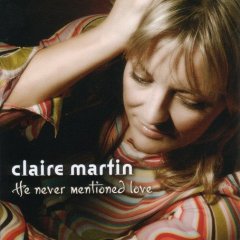 |
Claire Martin - He Never Mentioned Love (Linn AKD 295)
|
This is more than just a tribute album to the late pianist-singer Shirley Horn whose ultra slow vocals often seemed to dissipate like cigarette smoke in the air. Horn, who died in 2005, was one of Claire Martin’s greatest influences but as befitting someone whose musical intelligence, jazz spirit and individuality make her the complete singer, England’s finest jazz diva stamps her own personality on each track, her smoky voice with the richness of its bottom range as palatable to the ear as ever. Dig her own Slowly But Shirley, the ache of The Sun Died (superb flugelhorn by Gerard Presence) and the charging All Blues. It’s all class.
    
|
by Kevin Jones.
Previously published in Limelight August 07 |
|
Back to Index
|
|
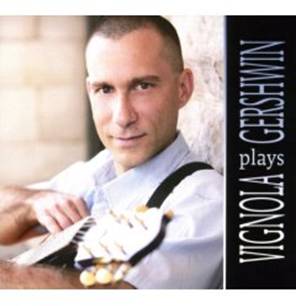 |
Frank Vignola - Vignola Plays Gershwin (Melbay MB10122CD)
|
“If everybody listened to Gershwin for an hour a day”, Vignola says, “there would be no bombs being dropped”. These fourteen gems from the pen of America’s master melodist are all first or second takes. Vignola doesn’t play guitar on his 12th as leader, he makes it sing. His end of phrase bent notes are just one of his abundant tools. Driving swing and embracing ballads from ‘S’Wonderful’ to a Spanish tinged ‘Summertime’, Vignola is superbly supported by another guitar stable mate Corey Christiansen, Tom Kennedy bass and Joe Ascione drums. A dazzling technical ability but laced with respect for these timeless classics
   
|
by Peter Wockner.
Previously published in Limelight August 07 |
|
Back to Index
|
|
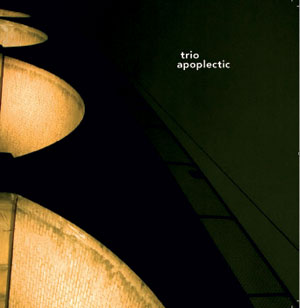 |
Trio Apoplectic - Trio Apoplectic (Jazzgroove JGR036)
|
Composition choice is paramount to the ultimate appeal of a disc. Here I found myself listening to the talented individual soloists rather than the trio collective, partly due to the good doses of lyrical individual solo space but also due to the barren original compositions. However there are exceptions like the opener ‘Dynamite’ that explodes like a sprinter off the blocks. The choices from Mal Waldron and Thelonious Monk keep the disc in good balance. The saxophone, bass & drums trio is an Australian institution thanks to Bernie McGann; it’s heartening to see the piano-less sound used to maintain the rage
  
|
by Peter Wockner.
Previously published in Limelight July 07 |
Life is full of surprises, and one of the most joyous of course is discovering music. Jazz has a special place in that journey, as part of Nat Hentoff, I think, called jazz the sound of surprise. As you grow up, its pleasure is the continual exploration of sounds, and the emergence of the individual voice of the player and collectively, the group. When older (much older!),it's harder to get excited as one has been in the discovery of new sounds - it has to be pretty special to stir one up. Picture a Sunday Afternoon (one track is called Sunday Arvo - Aussie patois for Sunday Afternoon) in a small beachside village on the North Coast of New South Wales, Australia, called Sawtell (and spelled Heaven!!!)on a very sunny winter afternoon in May 2008. A main street of two hundred metres or so, some large trees down the centre, and a gaggle of shops, one a coffee bistro with a dozen tables and some music - Monk's Boo Boo's Birthday as it happens being played by Trio Apoplectic - a title devised by the group I suppose intended to be deeply ironic and oh so hip. Be that as it may, there is an audience of four, not including the staff, but the group - Dave Jackson, Alto; Abel Cross, Double Bass; Alex Masso, drums; are doing fairly nice things with the aforementioned Monk tune. To hear any passing interpretation of Monk's work in the likes of Sawtell was really special and, thanks to the Australian Government arts funding for that, Trio Apoplectic were in town for one gig as part of an annual tour. But it was the next ballad, written by the bass player that made the heart pound and hair stand up with that revelation of the sound of surprise, and the recognition that here was something special.
The self titled CD, beautifully designed by the way, has eight works which provide an excellent taste of what this trio is all about. Reviewed on an ME 850 through Duntech Marquis speakers, the recording (Robin Gray, St Kilda) and engineering (Paul Bryant, Wollongong) is first rate, and is especially effective capturing the bass of Abel Cross - well balanced with the other instruments but catching every nuance of the player’s exceptional technique.
The program of music opens and closes with two works by the drummer, the first is like an entree saying - yeah, we can swing, the closer - yeah, we can swing slowly too! There are two classics - Firewaltz by Mal Waldron made famous by the interpretation by Eric Dolphy, and the aforementioned Boo Boo's Birthday which showcases to some extent the fine drumming of Alex Masso. It is a trio of equals, but all seem especially engaged when the works of the bass player Abel Cross are played by the trio. "Details of how to get APOPLECTIC on your license plate" (more hip stuff!) has a stunning drum/alto dialogue, exploratory sounds on bass, sounds which are what sub-tonic? Sub-sound? Followed by delicious and delightful arco explorations, cymbal splashes concluding with a final bass coda figure Charlie Parker would have sighed for. Windy (as in zephyr? or circumlocutious?) has an opening bass solo reminiscent of Jimmy Garrison with John Coltrane but wholly original, some stunning alto, and drum work, and is beautifully constructed. Skyblocks may be the topper on the disc infected as it is with energy, passion and technical mastery - it is a haunting and emotionally powerful soundscape created by three young Sydney Conservatory of Music trained guys at the top of their game. Brilliant. Attention must be paid! Dave Armstrong's work on this, the brilliant arco work, the track may be a classic in the making. Get the CD while you can.
In 2008, no finer Australian jazz CD have I heard, and in terms of my enjoyment, it's up there with Chris Potter, Mr William Parker etc.
|
|
by Ian Muldoon
|
|
Back to Index
|
|
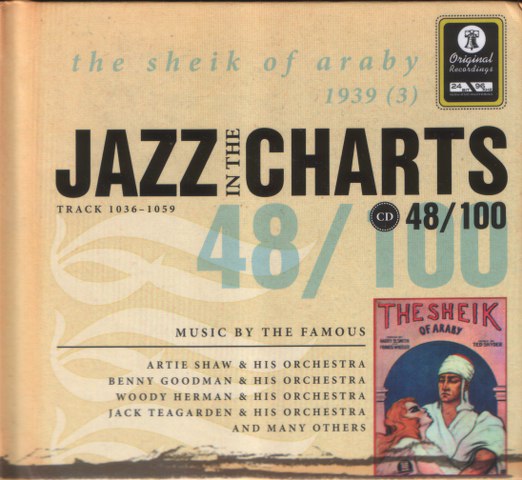 |
Artie Shaw, Benny Goodman, Woody Herman, Jack Teagarden and more - Jazz in the Charts, 48/100 (MCPS 223747-222)
|
Number 48 in a series of 100 ‘Jazz in the Charts’ compiled in Germany and claiming to present in total 2211 jazz recordings (in all 100 discs) that made the Billboard charts between 1917 and 1954. The clear intent is not only the preservation of the music (which has been 24 bit re-mastered) but also the provision of comprehensive information and incidental commentary (additionally in German) on each recording. Each is packaged in a bound booklet designed with vintage aesthetics in mind. Many highlights including Lionel Hampton’s 1939 two fingered piano on Wizzin’ the Wizz and in the same year Artie Shaw’s Deep Purple.
   
|
|
by Peter Wockner. |
|
Back to Index
|
|
 |
Squall - Squall (Rufus RF074)
|
Aficionados may recall maybe five major voices on the French horn such is it’s obscurity in jazz. Stephen Morley’s agility on the instrument is matched by the quality of his freewheeling compositions and constructive frameworks. A challenging instrument for avant-garde jazz, Morley’s muted fragile sound is best heard in stark contrast to Warwick Alder’s extroverted trumpet on ‘Run Slowly’, ironically developing into a rapid chase. Cutlan’s alto work on Dave Holland’s ‘Four Winds’ is inspired while Spence is as oblique and as jagged as you’ll hear. Healthy portions of free improvisation and rich morsels of blues from seasoned campaigners flavour this surprisingly heroic recording.
   
|
by Peter Wockner.
Previously published in Limelight July 07 |
|
Back to Index
|
|
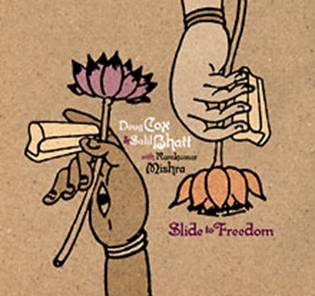 |
Doug Cox, Salil Bhatt with Ramkumar Mishra - Slide to Freedom (Northern Blues Music NBM0039)
|
Conceived after a year of collaboration, here is an enlightening fusion of Indian classical and slide guitar blues rendered with an unorthodox palette of resophonic guitar, tabla and veena. The latter, a 20 string variation on the sitar created over 20 years ago by Ravi Shankar disciple Vishwa Mohan Bhatt guesting on this album. Although primarily a Dobro player, Doug Cox’s weathered vocals and steely resophonic add some vintage authenticity to the blues infusion, but the balance is tipped in favour of entrancing ragas and soulful, lyrical instrumentals. McLaughlin and Shakti admirers take note; Doug Cox has struck a remarkable and spiritual three-way conversation.
   
|
by Peter Wockner.
Previously published in Limelight July 07 |
|
Back to Index
|
|
 |
SHOWA44 - Ormus (Kimnara 005)
|
The challenge for the un-initiated is to disassemble all pre-conceived ideas about the possibilities of spontaneous personal expression or improvisation. This minimalist duo recording instils the essence of the fundamental primitive idea of call and response. Distant industrial echoes from the cymbals and arid lonesome landscapes from the guitar permeate your consciousness in a meditative way, but what fascinates most is the courage to explore ideas, sometimes repetitiously; the faith in human collaboration, when sometimes impulses clash; and an unwavering sightline of both improvisers to the horizon. You may need to un-lock a new psyche, but ultimately, no other stimulants will be required.
   
|
by Peter Wockner.
Previously published in Limelight July 07 |
|
Back to Index
|
|
 |
Paul Motian - Time And Time Again (ECM 1992 1701137)
|
Here is one of the best modern jazz groups at its impressionistic best. One of the joys of listening to the trio is the interplay between drummer Paul Motian, guitarist Bill Frisell and tenor saxophonist Joe Lovano who have been recording and playing together on and off since 1981. The artistry of the 76-year-old Motian’s brushwork remains undiminished as he uses ever shifting patterns on his drums and cymbals to colour what are mainly dreamy tone poems, their atmospheric richness enhanced by the Frisell’s sensitivity and a restrained Lovano’s use of his instrument’s high register. The music evolves gently as their three-way conversation unfolds over seven Motian originals, one by Lovano, a standard from the Broadway show South Pacific (This Nearly Was Mine) and a Thelonious Monk tune (Light Blue). The Rodgers and Hammerstein number is strikingly beautiful as Frisell and Lovano gently explore the melody above Motian’s lively brushes. Space, time and colour _ this group delivers in spades.
    
|
by Kevin Jones.
Previously published in Limelight July 07 |
|
Back to Index
|
|
 |
Cheryl Bentyne - The Book Of Love (Telarc CD-83652)
|
Surprisingly Cheryl Bentyne, a 37-year member of the vocal group The Manhattan Transfer, is never mentioned when discussing today’s best jazz singers. However, on the strength of her seventh solo album, the honey-voiced Bentyne deserves to be. This concept album charting the beginning and end of a love affair contains some of the best ballad singing I have heard in some time. Be My Love with minimum backing from Wayne Johnson’s classical guitar and Armen Ksajikian’s cello (and what a solo) is perfection. It takes a special talent to cover Sinatra (I’m A Fool To Want You) and Julie London (Cry Me A River) so flawlessly . Not surprisingly she is one.
   
|
by Kevin Jones.
Previously published in Limelight July 07 |
|
Back to Index
|
|
 |
Fred Hersch - Personal Favourites (Chesky SACD324)
|
Pianist Fred Hersch has a firm grip on melody. So often he begins at the very edge of a song which becomes more familiar the longer he plays. His unabashed romanticism and love for standards is given full reign on some of his favourite tracks from the albums Dancing In The Dark (1993) and The Fred Hersch Trio Plays (1994) with bassist Drew Gress and drummer Tom Raney. His love for Bill Evans shows in his eloquent light touch and flowing improvisations as he elegantly and reflectively unfolds the romantic numbers and plays with vitality and warmth on others. His languid interpretation of Thelonious Monk’s Played Twice is a treat. In contrast, the tracks from Forward Motion (1995) with its unusual front line of Rich Perry’s tenor and Erik Friedlander’s cello are much more challenging and show another side of his musical personality.
   
|
by Kevin Jones.
Previously published in Limelight July 07 |
|
Back to Index
|
|
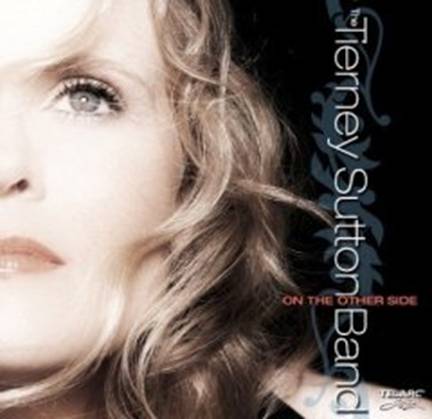 |
Tierney Sutton Band - On The Other Side (Telarc CD-83650)
|
I doubt whether Tierney Sutton will ever record a better album. Business Week in the United States has called it a masterpiece, placing it alongside In The Wee Small Hours (Frank Sinatra), Sketches Of Spain (Miles Davis) and The White Album (The Beatles). High praise indeed for a vocalist who would not be that well known to the average Australian jazz fan. However, whether you agree with Business Week’s assessment or not, this is a landmark recording in jazz singing by an artist whose ability to deconstruct a standard is matched by very few. Blessed with a fluid technique and a captivating voice, an innate sense of swing and a sound knowledge of harmonic and rhythmic changes, Sutton has few peers as a jazz singer today. On this eloquent and magnificently sung concept album, she explores the dark side of happiness superbly backed by her band under the direction of pianist Christian Jacob.
Touched with disillusion, she inventively reinterprets the usually bright You Are My Sunshine into an ode for loneliness. Outstanding are the contrasting versions of Get Happy; dirge-like to exuberant and Happy Days Are Here Again; hip to reflective. And Dream adds just the right touch at the finish!
    
|
by Kevin Jones.
Previously published in Limelight June 07 |
|
Back to Index
|
|
 |
Regina Carter - I’ll Be Seeing You: A Sentimental Journey (Verve 9850962)
|
Regina Carter, the most celebrated violinist in jazz today, dedicates her first album in four years to her late mother. Showing her growing musical sophistication, Carter recalls a classic era in American popular music with engaging treatments (both celebratory and reverent) of songs her mother loved with input from classy guests. Carter, clarinetist Paquito D’Rivera and accordionist Gil Goldstein turn Little Brown Jug into a hoedown, Dee Dee Bridgewater scats through This Can’t Be Love, Carla Cook (what a singer!) is appropriately bluesy on St Louis Blues, and pianist Xavier Davis shows what an exceptional talent he is. But it is the adventurous and imaginative Carter in moods ranging from tender to jaunty, who dominates.
   
|
by Kevin Jones.
Previously published in Limelight June 07 |
|
Back to Index
|
|
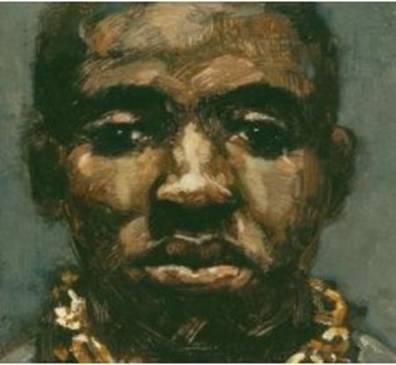 |
Wynton Marsalis - From The Plantation To The Penitentiary (Blue Note 0946 3 73675 2 0)
|
Caustic, confronting lyrics, including a sharp-tongued sermon in the form of a rap (Where Y’All At), make up this angry social commentary by Wynton Marsalis where his lyrics claim Afro-Americans are still enslaved in the modern chains of “dope and drink”. Despite the rich, lush voice of the remarkable 21-year-old Jennifer Sanon, sadly the lyrics don’t match the music, a fusion of traditional styles with quality blowing from Marsalis and saxophonist Walter Blanding. Max Roach and Oscar Brown Jr. did it much better in the 1960s with their civil rights anthem Freedom Now Suite but this is worth a listen if only for the solos.
  
|
by Kevin Jones.
Previously published in Limelight June 07 |
|
Back to Index
|
|
 |
Christian McBride - New York Time (Chesky SACD 314)
|
This is straight ahead hard bop at its best. The inspired meeting of Christian McBride, today’s leading bass player, and the fluid, full tenor of Javon Jackson with esteemed veterans, pianist Cedar Walton and drummer Jimmy Cobb, has resulted in the best of the New York Sessions series to date. McBride’s commanding tone has seldom sounded better than in this context. Four top musicians exploring some Walton originals and such jazz standards as Whisper Not and Naima. It’s a simple but effective formula.
Some may call it back to basics, but compared to so much of what passes for jazz today, it’s a breath of fresh air.
   
|
by Kevin Jones.
Previously published in Limelight June 07 |
|
Back to Index
|
|
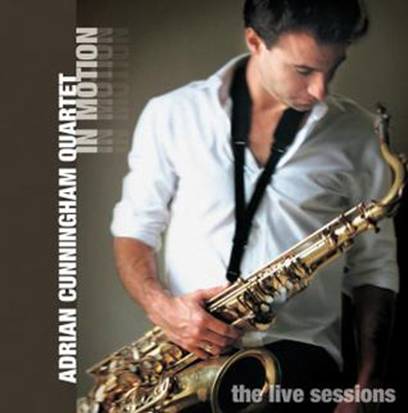 |
Adrian Cunningham Quartet - The Live Sessions (Newmarket NEW 3229.2)
|
Multi-instrumentalist Adrian Cunningham goes live on his third album, recorded over two nights at Sydney’s Sound Lounge. A rollercoaster ride steeped in the blues, some Latin and mainly Cunningham’s likeable originals, save the workhorse ‘Georgia on my Mind’. The package is complete with a 53 minute DVD of the performances, which is rare for Australian releases. Call and response, rasps, screams and sometimes a contorted clarinet sounding like a blues harp, he and Bill Risby lead the audience into a frenzy employing cohesive, melodic and unashamed good fun. ‘Loneliness’ is Cunningham’s highlight, wailing, searching and extending himself emotionally as well as using his abundant technique.
  
|
by Peter Wockner.
Previously published in Limelight June 07 |
|
Back to Index
|
|
 |
Bonnie J Jensen - The sapphire tree (La Brava LB0074)
|
Jensen’s voice has been compared to Diana Krall; indeed, it would sit just as comfortably in a country or soft rock setting. Careful to avoid the term jazz in her liner notes, Jensen prefers to cross genres, while she continues to choose top class modern jazz talent on her third release for La Brava and her finest album to date. She also skilfully accompanies herself on piano on 4 of the 11 selections. Highlights include Alister Spence’s sensitive solo on a U2 favourite, Craig Walters’s crystalline soprano solo on ‘A Night in Tunisia’ and Mike Bukovsky’s passionately muted trumpet solo on Jensen’s ‘Aeroblue’.
  
|
by Peter Wockner.
Previously published in Limelight June 07 |
|
Back to Index
|
|
Sean Coffin Quintet - Live at the Sound Lounge 2nd June 2007
Simon Ferenci - trumpet, Mark Harris - bass, Dave Goodman - drums, Mike Nock - piano
Sean Coffin assembled a fine group of musicians for the SIMA debut of scQUINT (the Sean Coffin Quintet) which was a showcase for some appealing compositions from the saxophonist indeed. None other than Mike Nock playing the electric piano (an instrument that saw him rise to US prominence in the 1960’s), the youthful Simon Ferenci on trumpet, swinging and funky bassist Mark Harris and the ‘player’ of drums Dave Goodman. Once again Mike Nock finds himself with a group of younger players who, with youthful exuberance on their side no doubt inspire the statesman but the younger players even more so, feed off his abundant ideas, and this, along with such attractive charts, made this gig an excellent choice on a quality SIMA calendar. With the absence of Peter Rechniewski, it was handed to John Clare in a moment of satirical brilliance to introduce the band complete with PR mannerisms and accent.
‘The Dinosaur Fable’ opened proceedings with a funky backbeat and Nock gave early indications of his approach with a mid solo change of tack, where he commenced his solo thoughtfully, but in an instant, his ideas were ferocious and attacking.
While the jury is probably still out on the length of the memory of goldfish, the reality is that it’s likely to be very short, so the frequent time changes in ‘Memory of a Goldfish’ were quite appropriate. In fact the pieces were to fit together like a jig saw puzzle. A dual between Coffin and Goodman while Nock’s solo used a kaleidoscope of counterpoint and block chords.
‘Hal and Ed Robbed Zer Mint’ got away to a swinging start before Ferenci featured with a pensive creeping solo. Out of every passage of thunder came clarity finished with some stabbing motions. Meanwhile Harris kept the operation swinging effectively with his stalking bass lines.
Coffin pared the group back to a duo with Nock for the brief but lyrical dedication to his wife and daughter before more Goodman backbeats with ‘Hey Man I Thought you Played Flute’. The interplay between Nock and Goodman was especially prevalent here.
Whilst I preferred the first set to the second there were some notable moments in the second which clearly retained all the audience attention. ‘New England Sketches’ encompassed a waltz time and other time changes. Coffin having spent ten years in the Boston and New York City has a big beefy sound without having to overplay the horn.
Ferenci picked up the flugelhorn for the lyrical balad ‘Summer of Vitamins’, while ‘Organised is Mayhem’ could have been re-titled ‘A Herd of Elephants is Approaching’ ‘Num Num’, a frequent phrase from Coffin’s young toddler in demand of food was the title of the finale of the night.
The culmination of distinctive individual soloists, the idea of Mike Nock on electric piano and some outstanding writing by Sean Coffin resulted in a very impressive scQUINT debut performance. Don’t miss the next one.
|
|
by Peter Wockner. |
|
Back to Index
|
|
 |
Harry Connick Jr - Chanson du vieux carre (Marsalis Music 087494600062)
|
This is one of Harry Connick Jr's best-ever albums. It's a splendid showcase for his musical talents as a pianist, composer and arranger as he pays tribute to his hometown of New Orleans with refreshing and lively orchestrations of some of the classic songs associated with the Crescent City including those by Louis Armstrong, Hoagy Carmichael, Sidney Bechet and three originals of his own including a lush Ash Wednesday with its Ducal overtones.
His big band, with its strong ensemble playing and such distinctive soloists as trumpeter Leroy Jones and trombonist Lucien Barbarin, rises to the occasion, especially on the infectious Bourbon Street Parade and closing Mardi Gras In New Orleans.
   
|
by Kevin Jones.
Previously published in Limelight May 07 |
|
Back to Index
|
|
 |
Scott Hamilton - Nocturnes And Serenades (Concord Jazz CCD-30025-2)
|
It's 30 years since I first heard Scott Hamilton's tenor saxophone, then a classic blend of such influences as Ben Webster, Zoot Sims and Stan Getz. Now very much his own man he has produced one of the great ballad albums, a disc such esteemed balladeers as Webster and Don Byas would be proud to call their own. In fact Hamilton's version of Chelsea Bridge almost invites comparison with Webster's majestic rendition with Duke Ellington. High praise indeed but there is no better showcase for the beauty of Hamilton's effortlessly warm and assured sound than here with his touring English rhythm section. The loveliness of his melodic statements is epitomized by I'm Glad There Is You and A Portrait Of Jenny.
    
|
by Kevin Jones.
Previously published in Limelight May 07 |
|
Back to Index
|
|
 |
Romero Lubambo - Softly (MaxJazz MXJ 6)
|
Forget genres, this is a magnificent guitar album by a musician who is not only steeped in the Brazilian and jazz traditions but is also outstanding in the classical field. Based in New York for the past 21 years, Romero Lubambo, a member of the Brazilian group Trio de Paz, has completed a solo project of rare beauty accompanying himself with multiple guitar overdubs. In all he plays five different string instruments on an album of originals, bossa novas and jazz standards where the mood is in turn reflective, romantic and restrained from the emotionally moving Heaven Here to the tender I Fall In Love Too Easily.
   
|
by Kevin Jones.
Previously published in Limelight May 07 |
|
Back to Index
|
|
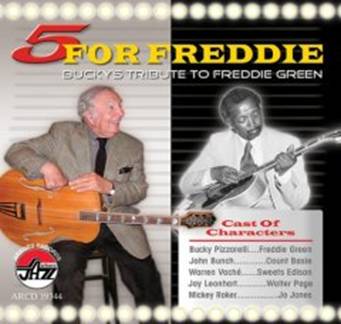 |
Bucky Pizzarelli - 5 For Freddie (Arbors Jazz ARCD 19344)
|
Perfect time and swing summed up Count Basie's “All American Rhythm Section” of the 1930s and 1940s anchored by guitarist Freddie Green. The art of rhythm guitar may be a dying art but Bucky Pizzarelli, a professional guitarist for 63 years, plays like a dream as with the help of pianist John Bunch, bassist Jay Leonhart and drummer Mickey Roker he recalls the relaxed drive of a big band engine room which has no equal in jazz. I have never heard a more laidback version of the bop classic Groovin' High. Warren Vache's outstanding muted cornet adds to the listening pleasure. Dreamsville sums it all up.
   
|
by Kevin Jones.
Previously published in Limelight May 07 |
|
Back to Index
|
|
 |
John Pizzarelli - Dear Mr Sinatra (Telarc CD-83638)
|
At last, a tribute to Frank Sinatra that doesn't insult my intelligence. John Pizzarelli's voice may be modest in comparison; then again there have only been a handful of male vocalists who weren't, but he swings naturally and his light, crooning style enables him to pay tribute to Sinatra rather that attempt to imitate him. Thus many of the songs here were standards before Sinatra gave them the definitive treatment and on nine tracks he has the exceptional backing of a working big band, the Clayton-Hamilton Jazz Orchestra. Don't miss Quincy Jones chart of In The Wee Small Hours, originally written for a Sinatra - Count Basie date but never recorded.
    
|
by Kevin Jones.
Previously published in Limelight May 07 |
|
Back to Index
|
|
 |
Various Artists - Lush Life (Blue Note)
|
Although this companion soundtrack to the 90-minute TV special on Billy Strayhorn, one of America's finest composers, barely scratches the surface of the musical legacy of Duke Ellington's musical companion, the inspired blowing by an all start roster from the label on 15 compositions, ranging from buoyant to bittersweet, more than compensates. Backed by Russell Malone's acoustic guitar, Dianne Reeves distinctive vocal stylings effectively convey the emotional message of the title track, tenor saxophonist Joe Lovano and pianist Hank Jones show their rapport on a pair of ballads, and pianist Bill Charlap romps through Fantastic Rhythm and joins Jones on an amazing version of Tonk. Not to be missed.
  
|
by Kevin Jones.
Previously published in Limelight May 07 |
|
Back to Index
|
|
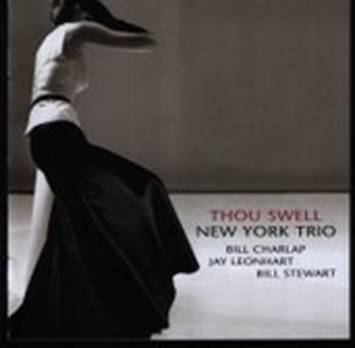 |
New York Trio - Thou Swell (Venus Records TKCV-35384)
|
Echoing the heritage of the 1960's ‘Oscar Peterson plays the Richard Rodgers Songbook', this Bill Charlap Japanese release shares only two common tunes with the Verve classic, ‘My Funny Valentine' with a pensive but faithful introducing verse and ‘I Didn't Know What Time it was'. Likewise, the remaining selections are all bread and butter for straight ahead jazz players worldwide, but in the hands of Bill Charlap, you almost feel like you have to be wearing a tux when you're listening to this. Elegant chapters of sublime deft touch and hard driving swing with solid support from Jay Leonhart and Bill Stewart.
  
|
by Peter Wockner.
Previously published in Limelight May 07 |
|
Back to Index
|
|
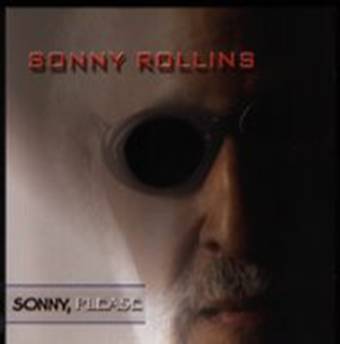 |
Sonny Rollins - Sonny Please (Doxy/Emarcy B0008257-02)
|
At 76, Sonny Rollins' ongoing appeal relies heavily on his electrifying aura during exhausting live performances.
However any fan of the colossus who says Sonny Please is great listening is letting
sentimentality cloud reality. Rollins' improvisational abundance remains but his band falls short of historical expectations.
He's still writing attractively, proven by the title track and Nishi.
However, the irony in Someday I'll Find You is almost sorrowful due to wandering, aimless conversations between sax and drums then sax and electric bass.
His frequent references to Oh Susanna during improvisation are also a little tedious. For the diehard Rollins fans only.
  
|
by Peter Wockner.
Previously published in Limelight May 07 |
|
Back to Index
|
|
 |
Judy Campbell's Mosaic with Bandika Ngao - Colours of Kenya (Maju 06-3.1)
|
Beautifully packaged and comprehensively detailed, there is an historical intrigue behind each of these original pieces composed mainly by Judy Campbell, Bandika Ngao and Mark Ginsberg. Courtesy of the Kenyan master percussionist and craftsman, underlying primal rhythmic patterns and chants weave a cohesive thread throughout what is now a resilient concept of fusing tribal African and jazz music's. Much of the beauty here lies in the traditional and contemporary lyrics. Jubilant and spiritual in its vocal harmonies and danceable in its grooves, this collaborative band is sounding as tight as the skin on the Kenyan Mijikenda and as synchronous as Bandika's handmade Kayamba.
   
|
by Peter Wockner.
Previously published in Limelight May 07 |
|
Back to Index
|
|
Tim Bruer Quartet, Sound Lounge Fri 11th May 2007
Tim Bruer - piano, Lloyd Swanton - bass, Simon Barker - drums, Sean Coffin - tenor saxophone.
Tonight offered an opportunity to re-visit, re-interpret and extend upon works recorded up to 15 months ago for a self-titled album launched by a slick quartet led by pianist Tim Bruer. For the audience, it was a gift; a rare opportunity to hear original works by a busy pianist about town but a pianist and composer who deserves wider recognition as a band-leader.
The post bop opener 'Like John' was inspired by Coltrane. The buoyant quartet created swelling waves of sound and filled the lounge with a modal piece in ¾ time. Simon Barker's dark dense cymbals, a sound reminiscent of Jack DeJohnette's heavy metals added to these imposing crescendos and retreating diminuendos.
Tim Bruer's style is one of dexterity and fleeting touch; caressing rather than attacking, while both hands rarely straying apart to the extremities of the keyboard. When in support of his soloist his timing is impeccable, filling in spaces at the most opportune moments, making his music breathe with intensity.
'Euroscape' had the tension of a bullfight. It opened with a freely improvised section confined within the context of the mood changes which were to follow. The theme evoked musings from the spirit of Horace Silver to the etchings of a Spanish dance.
The second set commenced with the funky 'Plastic Elastic'. Lloyd Swanton, subbing for Brett Hirst and achieved a sparkling top end clarity on his bass seemingly with ease.
'A Blues of many Hues' had a 1960's Blue Note feel about it and this provided Sean Coffin with the inspiration to soar. His quintessential muscular sound lifting the bar to another level, before Simon Barker in his trademark crouched position took a solo that had as much to do about space as sound.
An under-exposed talent yes but the end result was one of quality re-invigorated. The self titled album is available on the La Brava label.
|
|
by Peter Wockner. |
|
Back to Index
|
|
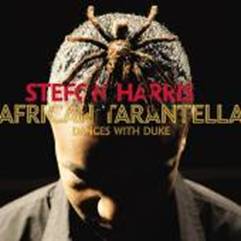 |
Stefon Harris - African Tarantella (Blue Note 0946 3 41090 2 4)
|
Stefon Harris may consider he is just getting started in the jazz world but at the age of 33 the present day master of the vibraphone shows with this beautifully conceived and played album he has reached an early maturity. It's been said that at some time all musicians must come to terms with Duke Ellington's music and Harris' fresh perspective on his work is the most exciting contemporary reinterpretation of Ellingtonia I have heard for years. He captures its spirit in a chamber music setting with a nine-piece ensemble including trombone, two reeds and two strings. The Ellington effect is enhanced by trombonist Steve Turre, a master of the mute, and Greg Tardy's clarinet. Harris has intriguingly arranged movements from the lesser known The Queen's Suite (1959), one of Ellington's last major works The New Orleans Suite (1974), and excerpts from his own Ducal flavoured The Gardner Meditations.
Inspired is the only way to describe the ballad playing on the two most famous works from The Queen's Suite, Sunset And The Mocking Bird and The Single Petal Of A Rose. The former has some stunning interplay between Harris and pianist Xavier Davis and whereas Ellington played the latter romantically, Harris' solo performance is as a reverential as a piece from one of the Duke's sacred concerts. This is a major statement.
    
|
by Kevin Jones.
Previously published in Limelight Apr 07 |
|
Back to Index
|
|
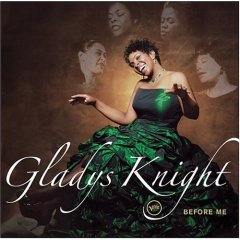 |
Gladys Knight - Before Me (Verve 9850961)
|
Some knowledgeable judges have claimed Gladys Knight's sound and phrasing have always suggested an undercurrent of jazz feeling. At 62, the pop-soul diva who was a teenage jazz singer with her high school big band in Atlanta, Georgia, shows she still has an affinity for the music with this classy tribute to the influential idols of her youth (Billie Holiday, Ella Fitzgerald, Sarah Vaughan et al). With a sophisticated elegance, Knight richly and imaginatively interprets jazz standards including an intimate Good Morning Heartache, the lush arrangement enhanced by Roy Hargrove's trumpet, and a whispers through a subtle boss-nova flavoured The Man I Love. Hopefully there will be a follow-up.
   
|
by Kevin Jones.
Previously published in Limelight Apr 07 |
|
Back to Index
|
|
 |
Russell Malone - Live At The Jazz Standard, Volume One (MaxJazz MXJ602)
|
Russell Malone's versatility has made him one of the most in-demand guitarists in jazz today and this “live” album is proof _ if any is needed _ that he is among the instrument's elite. Recorded during a week-long stand in November, 2005 at one of New York's finest venues with his working group _ pianist Martin Bejerano, bassist Tassili (correct spelling) Bond, and drummer Jonathan (correct spelling) Blake _ Malone feverishly stretches out with an endless stream of ideas on his own well-crafted originals and two covers, the haunting ballad Heartstrings the only exception. And for Malone's “nastiest” playing on disc dig the final track, a raunchy gutbucket blues.
   
|
by Kevin Jones.
Previously published in Limelight Apr 07 |
|
Back to Index
|
|
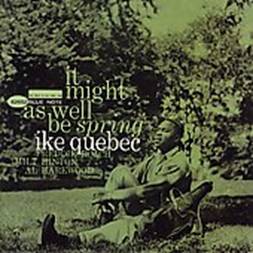 |
Ike Quebec - It Might As Well Be Spring (Blue Note 0946 3 62652 2 3)
|
Recorded 45 years ago when big-toned tenor saxophonist Ike Quebec had only 13 months to live before dying of cancer at the age of 44, this is one of Blue Note's all-time great 1960s albums. His gorgeous sound with its reflective grace and authority is captured to perfection as he meshes perfectly with the tasteful organist Freddie Roach, superb bassist Milt Hinton and the musical timekeeping of Al Harewood. There are few better examples of Quebec's ability to weave languorous ballads than the emotional Willow Weep For Me and the relaxed phrasing of Lover Man. In contrast he stomps with exuberance on Ol' Man River.
    
|
by Kevin Jones.
Previously published in Limelight Apr 07 |
|
Back to Index
|
|
 |
Charles Tolliver Big Band - With Love (Blue Note/Mosaic 0946 3 693152 4)
|
Although some of these charts were written more than 30 years ago, they show just how exciting a big band can still sound today. The brash and powerful 20-piece group was formed in 2003 by trumpeter Charles Tolliver whose brilliant lead work sparks the blasts of high brass which are accentuated by the aggressive drum fills of Victor Lewis. Tolliver, who came to the fore in the 1960s with Jackie McLean, heads a blistering array of strong soloists including exciting pianist Robert Glasper as they blast their way through six of his originals and cover Thelonius Monk's Round Midnight with differing moods and tempos in a bravura performance. Excitement plus.
   
|
by Kevin Jones.
Previously published in Limelight Apr 07 |
|
Back to Index
|
|
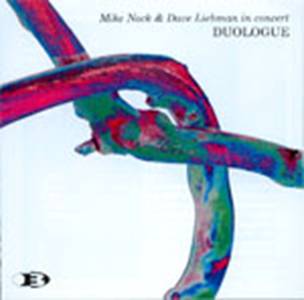 |
Mike Nock and Dave Liebman "In Concert – Duologue" (Birdland BL 009)
|
The Chinese Whistle Kites of Nantong have a dual trail line, and each of those lines are made from a two stranded rope. The traits that provide for stability, flexibility and agility make this music fly. This live 2004 Wangaratta date has its origins in a duo on the 1970's quartet album entitled Opal Heart. Nock's beautiful “Acceptance” is full of Liebman soprano squalls played with drama and conviction. The conventions of “On Green Dolphin Street” are blasted away, but the mutual intuition these two statesman of jazz share, elevate the dialogue to levels which outshine the meaningful compositions themselves.
   
|
by Peter Wockner.
Previously published in Limelight Apr 07 |
|
Back to Index
|
|
 |
Tom O'Halloran Trio - Green Hills and White Clouds (Jazzgroove JGR 034)
|
Ex-Perth pianist Tom O'Halloran is another of a growing number of jazz artists unafraid to allow global rhythms to positively affect their music. The propulsion of Afro-Cuban rhythms form an undercurrent along with a playing style gravitating towards Rubalcaba (without the percussive traits), yet retaining his own identity via his original compositions. 'Gonzalo's Rubix Cube' is where all the albums subtle Cuban references come to a head. However, even in the hard bop 'Get me to the Village' and the quieter moments like his solo offering 'I wish you love', there is a youthful buoyancy weaving intricate colours and textural contrasts.
   
|
by Peter Wockner.
Previously published in Limelight Apr 07 |
|
Back to Index
|
|
 |
Paul Motian - On Broadway VOL 4 (Winter & Winter 910 125-2)
|
Paul Motian, whose appearances with artists as diverse as Billie Holiday and Arlo Guthrie is now 75 and just as widely recognized for his own concept albums as for his achievements in the drumming chair of the Bill Evans and Keith Jarrett trios. If you've ever been to the gallery and overheard another's vastly different take on your favourite painting, a piece you thought you knew like the back of your hand might now seem to hold even greater beauty. Eight of the 13 broadway tunes feature the folky voice of Maine native Rebecca Martin, whose tone is strikingly similar to Karrin Allyson.
   
|
by Peter Wockner.
Previously published in Limelight Apr 07 |
|
Back to Index
|
|
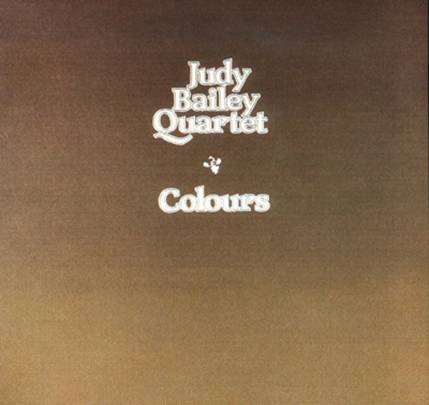 |
Judy Bailey Quartet - Colours (Basement Digs/Birdland Records BDCD1032)
|
The electrified sounds of jazz funk in the 1970s were not just an American phenomenon. The slow funky groove of Fall Down Dead on this classic 1976 reissue shows how well Australians were also exploring the genre especially on this session by that living legend of the jazz piano, New Zealand-born Judy Bailey. The moods range from Brazilian fusion to the spatial over four originals, two by Bailey whose touch and clarity on both the electric piano and the distinctive sounding clavinet adds so much to the date's success. Her empathy with the other quartet members _ Ken James (reeds), Ron Philpott (electric bass) and John Pochee (drums) _ was another telling factor.
   
|
by Kevin Jones.
Previously published in Limelight Mar 07 |
|
Back to Index
|
|
 |
Kenny Davern - No One Else But Kenny (Sackville SKCD2-3069)
|
This album serves as a fine memorial to Kenny Davern, one of the most swinging clarinet players of the past 30 years, who died at the age of 71 on December 12 last year.
Claimed by the New York Times to be "the finest jazz clarinetist playing today”, Davern, a true original and a superior craftsman, was in fine fettle on this 2006 trio date with the New Orleans pair, pianist David Boeddinghaus and drummer Trevor Richards. The fare may be familiar _ such staples as Moonglow, Sugar and All By Myself for example _ but Davern , by adding his own personal touch, always finds something fresh to say about each one.
    
|
by Kevin Jones.
Previously published in Limelight Mar 07 |
|
Back to Index
|
|
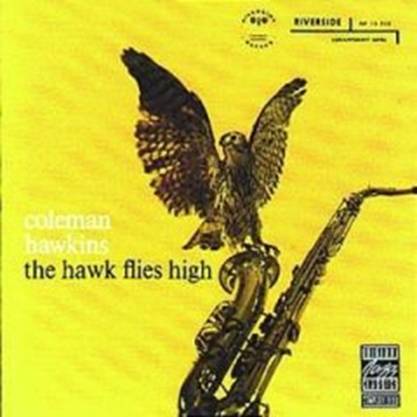 |
Coleman Hawkins - The Hawk Flies High (Ultradisc UDSACD 2030)
|
Originally recoded for the Riverside label in 1957, this session marked the resurgence of Coleman Hawkins although, like Duke Ellington's "return” the previous year at the Newport Jazz Festival, he had never really been away. With a hand-pocked group including the then young beboppers, trombonist J. J. Johnson and trumpeter Idrees Sulieman, and the greats, bassist Oscar Pettiford and the Jones', pianist Hank and drummer Jo, Hawkins reaffirmed his status as one of the truly great tenors. He dominates to such an extent that it would have been even better album with only Hawkins and the rhythm section. His tone is full and robust yet tender and warm on the ballads.
   
|
by Kevin Jones.
Previously published in Limelight Mar 07 |
|
Back to Index
|
|
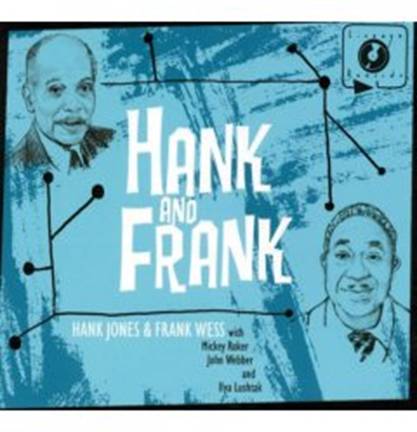 |
Hank Jones and Frank Wess - Hank and Frank (Lineage Records LIN-103)
|
Smooth, subtle and swinging is an apt description for the music of pianist Hank Jones and saxophonist and flautist Frank Wess, two esteemed octogenarians who show that jazz with these qualities will never go out of style. Jones, as usual, is all class and consistency He speaks the same musical language as Wess, the former Basieite whose muscular yet melodic tenor is such a joy as they conjure up a feeling of relaxed swing with a maturity that adds freshness to everything they do Their piano-flute duet on The Very Thought Of You is something very special _ and they couldn't have wished for a better support group than drummer Mickey Roker, bassist John Webber and guitarist Ilya Lushtak!
    
|
by Kevin Jones.
Previously published in Limelight Mar 07 |
|
Back to Index
|
|
 |
Norm Kubrin - I Thought About You (Arbors ARCD 19342)
|
As an unabashed lover of the Great American Songbook who has been appalled in recent months by market-driven interpretations of standards (they appear to be lacking in some quarters) it was an unexpected delight to find a male vocalist who can interpret these songs with warmth and sincerity. Meet the Palm Beach, Florida-based Norman Kubrin, who not only has a feeling for the rich tradition of America's classic popular songs but is also an elegant piano stylist who is ably assisted here by Bob Hanni's guitar and Don Coffman's bass. He scores with his intimate ballad singing, especially Gershwin's little heard Isn't It A Pity, but also handles faster tempos with ease. A rare find
   
|
by Kevin Jones.
Previously published in Limelight Mar 07 |
|
Back to Index
|
|
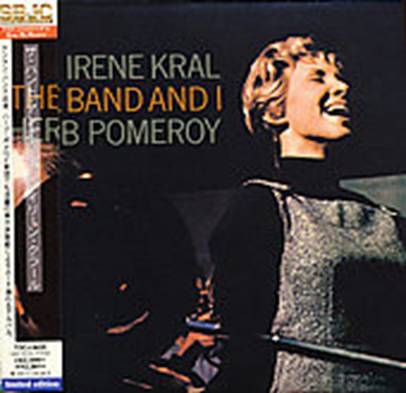 |
Irene Kral - The Band And I (Capitol Jazz 0946 3 69809 2 8)
|
At last this long forgotten treasure from 1958 by one of the most perfect and purest jazz voices with the legendary Boston-based Herb Pomeroy Orchestra has finally been reissued. Irene Kral, sister of Roy (of the vocal duo Jackie and Roy) who was only 46 when she died of cancer at the height of her career, could swing with the best of them but her flawless diction and intonation made her the perfect ballad singer. Her style was delicate with subtle and haunting interpretations of little known material _ her sensitive handling of Lazy Afternoon and the warmth of Memphis in June. This is probably the only CD of her available so don't miss it.
    
|
by Kevin Jones.
Previously published in Limelight Mar 07 |
|
Back to Index
|
|
Mark Isaacs's Resurgence Sound Lounge 24th March 2007
Mark Isaac - piano, James Muller - guitar, Matt Keegan - saxophone, Tim Firth - drums, Brett Hirst – acoustic bass
While there may have been some distance between the analogy of Mark Isaacs’s return to jazz performance and the naming of his new band ‘Resurgence’, the implied meaning was inference to catapult the zeal of this band to heights rarely witnessed in local performances. The tune was in fact written ……… and was recorded last year in LA with James Muller, Steve Tavaglione, Bob Shephard and Vinnie Colauita.
During a dramatic opening piece with time changes causing light and shade, Isaacs utilised heavy block bass chords reminiscent of McCoy Tyner on A Love Supreme and accompaniment that bordered on intervention during solos by Matt Keegan, James Muller and Tim Firth.
His ballad ‘You Never Forget Love’ continued the melodic tack, where piano, saxophone and guitar individually re-stated the melancholy theme prior to offering their improvisations. Isaacs this time, using a contrasting approach with the focus on the right hand.
The highlight of the first set was the Latin flavoured ‘Lately’. James Muller’s solo here was lightning fast and, as he does so often in performances, influenced the opening figure of the following soloist. In this case Matt Keegan, who not only extended the idea but gave his tenor a platform to attack the next tune where his whole body vibrated into a spasm, providing a fat vibrato effect and sounding almost like a trumpet.
The second set commenced with the lyrical ‘Home Coming’. While it was a less melodic opening than the first set, Isaac’s treble concentration provided pods of blossoms which rewarded the majority of the audience who patiently waited their return.
‘Night Song’ was an ensemble piece with no soloing. Rather, Keegan and Muller alternated on the head leading Tim Firth’s cymbals to a climax of shooting stars, while ‘Resurgence’ had another Latin feel before ‘Tell it Like it is’ brought the program back to an earthy base with what may be Isaacs most accessible work to date in an R&B sound. This line-up is well placed to excel in this area too. Keegan’s squawks, Muller’s screaming guitar, Hirst’s stomping bass while Isaac’s lyrical equilibrium over the top of Firths intensity.
Let’s hope we don’t have to wait another six months to witness another performance like this.
|
|
by Peter Wockner. |
|
Back to Index
|
|
While the concept of fusing traditional African music and jazz is well worn, Mosaic has forged a compelling vocal harmonic approach which has breathed new life into the path paved originally by greats like Dizzy Gillespie, Abdullah Ibrahim and Don Pullen.
Judy Campbell's exuberance in performance was infectious, but it's more than simply a performance, it's a joyous celebration of community. So infectious was the celebration that you could feel the audience moving to the beat of Bandika's hand made drums.
This was the final concert of a tour that lasted six weeks and took in regions from Wangaratta to Brisbane. It was evident the band built a common bond over these weeks with the charts largely discarded, the sound so refined over weeks of one-nighters but flexible enough to allow an array of guest artists including former drummer/percussionist with the group Nick McBride from Shanghai, National Jazz Award winner Jackson Harrison and head of the jazz department at the Cape town University Mark Campbell.
A backdrop of 3 colourful African tapestries set the Eastside Arts stage for 'The Colours of Kenya'. A quartet of Bandika's Ngao's own handmade Mijikenda drums suspended in readiness for Mosaic to commence their collage. What's this? The band is in striking 'colours' costume as well.
Bandika opened the performance with a solo using a handmade Kayamba that is shaken from side to side or in a figure 8 motion for a slower funkier effect. Nick McBride, who studied with Bandika and who was the conduit for the Kenyan/Australian connection, was then invited behind the kit for a rendition of his 'Bandika's Song' with lyrics by Judy Campbell. This is a danceable piece with solo space for Michael Kahr, Aaron Flower and was reminiscent of the Dollar Brand 'township' sound.
A highpoint from the first set was the traditional Jewish New Year melody entitled 'Avinu Malkeinu'. A festive tune arranged saxophonist Mark Ginsburg with such a positive feel, that even a few keyboard sound problems could not dampen.
Ginsburg's simmering solos, sometimes wailed into a soulful r'n'b zone on both soprano and tenor but never failed to remain in context with the arrangement and overall ensemble feel.
The performance was cleverly balanced with some jazzier pieces such as Michael Kahr's 'Nockstein Blues', a dedication to his former teacher Mike Nock and 'In Memory', Mark Ginsburg's tribute to the late Michael Brecker. Bandika's cautious touch on these pieces was in contrast to his buoyant confidence when playing his own music, but, in solo, with a single djembe drum, his indisputable talent had the audience in awe.
Another highlight of the second set was 'Time will not wait' or 'Kiringongo' a song written by Mark Ginsburg and Bandika Ngao with lyrics by Judy Campbell. Bandika only on this tune used his handmade marimba with a repeated motif again in a bouncy township style. A very relaxed and jovial Brendan Clarke clearly enjoying the moment expanded his solo on the three note bass line before Ginsburg took another earthy tenor solo.
For those who cannot wait for the next Judy Campbell's Mosaic performance, it's satisfying to know that $5 from the sale of their current release 'Colours of Kenya' goes directly to The Tweed – Kenya Mentoring Program to support safe water projects in Kenya.
|
|
by Peter Wockner. |
|
Back to Index
|
|
 |
The Necks - The Basement 21st March 2007, 1st Set
Chris Abrahams – piano
Lloyd Swanton – bass
Tony Buck – drums
|
When an almost capacity crowd fills the Basement on a Wednesday night for a band that plays 100% improvised music you know that you're at 'the' gig. Further, when the audience shows the respect of 100% attention for 50 minutes of non-stop musical self-expression, you know you're witnessing something very special.
The Necks formula is very simple and almost all the time it works. The trio calmly took to the stage and commenced a creation. I remember the Sydney Olympics when the bus drivers all said 'Gday', but I also recall the team cycling pursuits at the velodrome when the lead cyclist peeled himself off the head of the pack like a banana skin and rejoined at the rear of the team. Similarly, this is how I hear the Necks assembling their ideas; building, pushing, pursuing further then discarding and then repeating the process end to end.
This circular motion, if you like, creates sound-waves of sonic resonance and, while it was magical to witness this unfolding, it was even more rewarding to close one's eyes and allow the aural vibration to conjure up images of water trickling, thunder, gale force winds, alarm bells, multiple sirens and waves swelling and crashing against a rugged shoreline. On reflection it seems I could have survived cyclonic conditions.
Another epic journey from with The Necks and gauging the audience reaction all were very satisfied.
|
|
by Peter Wockner. |
|
Back to Index
|
|
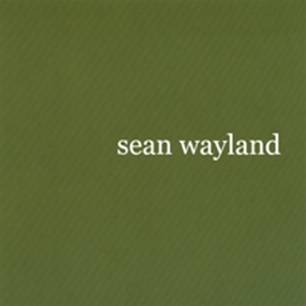 |
Sean Wayland – piano
|
Perhaps solo is where you'll find the emerging composer Sean Wayland most comfortable and willing to share his inner most thoughts. From the rolling waves and the picturesque glory of Little Bay to the exploratory repetition of 'Five', this solo piano recording opens the shutters on eleven diverse vistas, all uniquely Sean Wayland, including the Lennon/McCartney 'All Across the Universe'. The swinging 'Inspiration' is screaming for a band while 'Rising' invokes the promise of a new day with a slowly revealing warmth. While the courage of the final two 'Oberheim Xpander' tracks is acknowledged, some may find the sound past it's used by date.
  
|
|
by Peter Wockner. |
|
Back to Index
|
|
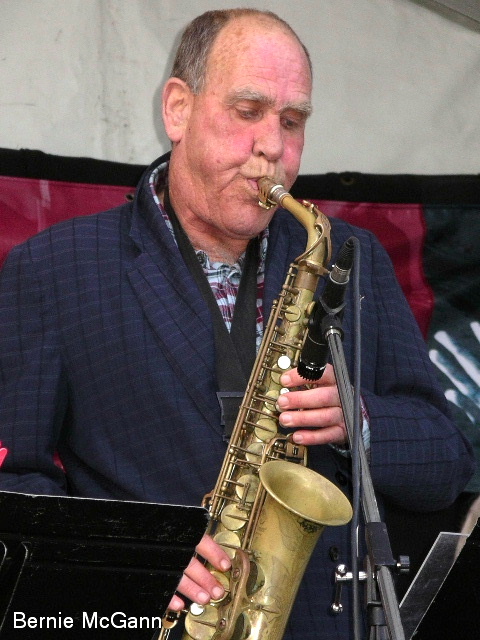 |
Re-unite at the Lounge (Jan 19th, 2007)
Bernie McGann - alto sax
Roger Manins - tenor sax
Warwick Alder - trumpet
Lloyd Swanton - double bass
John Pochee - drums
|
New Zealand tenor saxophonist Roger Manins first performed with the McGann quartet in early 06, so a repeat performance in 2007 was always going to be a special treat to start the year and the capacity crowd at the Sound Lounge was not disappointed despite the tentative approach
to the opener "Fried Bananas" by Dexter Gordon.
These days the 69 year old McGann exploits his own limitations into a style of truncated, spacious sequences rather than the sinuous upwardly twisting lines of more youthful times. The McGann sound is
still ripening, though the ideas sometimes can't be fulfilled.
I was so glad to hear "Spirit Song". Bernie McGann has single-handedly made this into a jazz standard in Australia. The beautiful melody line demands it. Roger Manins was compelled to repeat the
melody in his solo such is its splendour.
Warwick Alder has moved on somewhat since the recording of "Blues for Pablo too". Always an adventurer and a thinker, he incorporated growls and gurgling into his horn and was clearly enjoying this
intimate venue with the audience focussed on every single nuance.
McGann then called "Salaam" and while the others made the salami pun, the hot pace that McGann had in mind was no joke. The statesman Pochee was up to the task with his angular and sometimes
swirling drumming action and an updated sound with a new Paiste hammered crash cymbal. Still a timekeeper of great precision but more so, a communicator and
"feel" player, never taking his eye off the soloing artist.
To me the second set was superior to the first. I've no reason to believe people are weary of McGann's traditional head solo head approach to jazz, to me it still creates expectation, tension
and release. The punters stayed until the last ball was bowled. I never tire of the art of a soloist in construction mode. The finale came in the form of Alder and Manins locking horns and trading blows in a cutting session on another
McGann gem, the title track of his successful Rufus release "Blues for Pablo too".
Lloyd Swanton's bass work never seemed too busy, even on the demanding up-tempo pieces. His strumming chordal bass lines added another dimension to the depth of the music, especially on Pablo.
If you missed this performance, there is some glimmer that a commercially available recording of this group including Roger Manins is on the horizon. It can't come soon enough.
|
|
by Peter Wockner. |
|
Back to Index
|
|
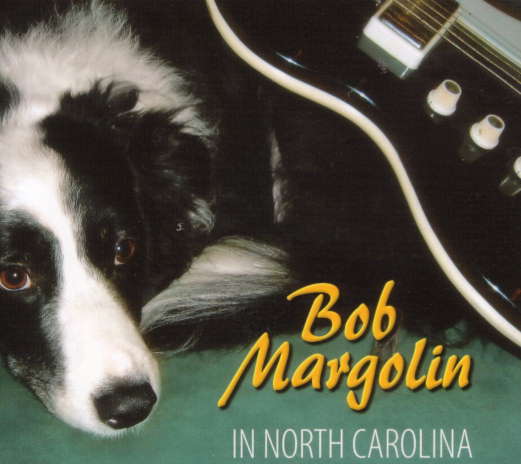 |
Bob Margolin – In North Carolina (Steady Rollin' Records)
|
In the final line of his biography, Bob Margolin's says "I like to be 'professional' in terms of responsibility and competence, but past that, I am a blues musician playing for my friends" – and he does just that on his latest album 'In North Carolina'. Through the album, Bob simply tells his story and shares his musical memories, from way back when he was Muddy Waters' guitarist right through to his current projects.
This storyteller plays solo. He sings and plays all instruments on this recording.
The album features an eclectic mix of styles, drawing from different authors and different times. For guitar lovers, this album is your candy store - slide , electric, surf, Les Paul, acoustic and more. Listen to "Lonely Man Blues" - energetic voice, great guitar, Muddy's times blues or Dylan's "Tears of Rage" - a restrained feel with a distinctive 1960's hippy flavour. The highlights on this album, in my opinion, are 'Red Hot Kisses' and ' surfy' blues 'Floyds Guitar Blues'.
Following a suggestion by Australian blues musician Fiona Boyes, Margolin, never the predictable artist, concludes this CD with nine minutes of spoken word, humbly telling "You never know" his blues fiction to old friends.
A warm insight into soulful bluesman.
   
|
|
by Vlad Gilbourd. |
|
Back to Index
|
|
Dave Panichi Septet – Sound Lounge 24th Nov 2006
Seven Steps to Manhattan
Surrounded by so many young faces on stage, Dave Panichi may have looked like the nurturer of talent with his new septet, but a closer look reveals that each one of these 'new' players is either a leader or co-leader in his own right.
Panichi has been on the jazz scene since 1975 and 18 of those years were spent in New York City, and you can tell. His trombone sound is bold and channelled like the deepest part of a waterway, clear and concise, thoughtful, logical and musical. The septet remains his primary showcase for his original material but some of his pieces such as 'Pyldriver' are played by other Sydney heavyweights.
He opened with what must be one of his audiences more favoured pieces in 'New Orleans Thang' where the funky Nawlins backbeat courtesy of the second line of Mike Majkowski on bass and Tim Firth on drums held sway. It set the scene really, for a night of commanding compositions coupled with driving rhythm and superb individual soloing, for Panichi's compositions were not over-arranged with complex and contrasting dynamics. He preferred to get to the heart of the composition with pure clarity and melody in his improvisations and showed faith in his younger sidekicks to do the same. Working with Buddy Rich, Aretha Franklin and Mulgrew Miller in the US (just to name a few) did his style no disservice.
'Dream Logic' had hard bop flavours with James Muller getting the first of many vocal acclamations from the Friday night audience. The sound was pared back for Panichi's solo to a trio of bass and drums only, then, Hugh Barrett on piano contributed the first of a number of inventive solos prior to the band returning to the head.
Mike Majkowski has an enormous talent that makes his bass sing with charisma and personality. His was sweet playing from diminuendo to crescendo in patterns that characterised a human voice rather than a constant legato.
The story behind the 1982 written 'Manhattan' was too raunchy for the bandstand, so Phil Slater provided a romping solo in its place to complete the first set with this piece that sounded like it was written and arranged for a contemporary big band.
The second set commenced with a dedication to saxophonist Dave Liebman and Slater took his horn in a different area, sometimes sounding like he was controlling the expulsion of air from a balloon. One gets the feeling Barrett has studied Herbie Hancock, but here he built his improvisations using melodic platforms in a similar way to his leader on the night. But Peter Farrar on alto nearly stole the show with his solo on 'Lieb'. He has a tone reminiscent of Ornette Coleman and an expeditious array of ideas which drew an excited and appreciative applause.
Panichi's fat vibrato was most evident on 'Rhumba Quabe', producing almost throttle like gargles, while Majowski delivered bass lines reminiscent of the most soulful of Horace Silver tunes, while 'Hits and Spaces' saw the interesting pairing of soloists. Firstly Slater and Muller, with Slater taking the lead and Muller playing the conversationalist, then Farrar and Barrett, in a wild exchange that had me checking whether Farrar was using circular breathing.
An exceptional live performance was capped by the funky 'Pyldriver' which saw Muller urging, pulling, teasing and then pushing hard, while Barrett drew cryptic lines against Panichi's bone. Tim Firth put on the icing with a melodic, textural pattern that collapsed back into the groove.
|
|
by Peter Wockner. |
|
Back to Index
|
|
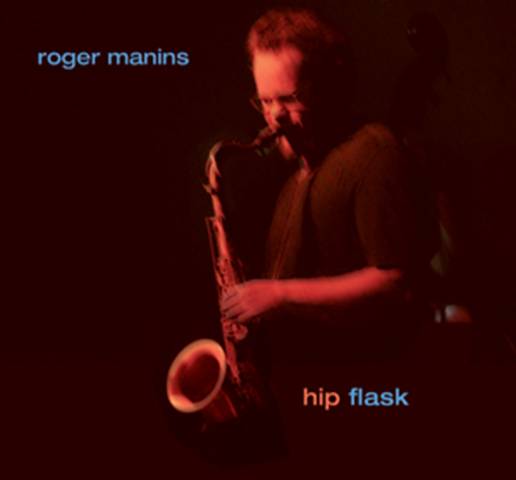 |
Roger Manins – Hip Flask (Jazzgroove Records – Ode Records)
Roger Manins – tenor saxophone, bass clarinet
Stuart Hunter – organ
Adam Ponting – piano
Brendan Clarke – bass
Toby Hall – drums
|
A remarkable characteristic of this album is not just the exceptional musicianship of Roger Manins (his debut as leader and recorded in 2001), but his unusual use of both Hammond organ and piano in the line-up. Renowned Sydney organist/keyboardist Stuart Hunter joins forces with Adam Ponting on piano complementing mostly Manins' compositions.
Manins states in the liner notes "the focus of the music is the groove and the blues". While most of the compositions are simple and attractive both melodically and in structure, each artist is anxious to explore outside the melody and the groove albeit in the head-solo-head tradition. Particularly evident on 'Victoria' where the elementary blues turns avant-garde thanks to a spirited exchange from both Ponting and Manins.
The immensely talented Brendan Clarke plays an unwavering role on both acoustic and electric basses. 'Bang' takes time out from the prevailing bluesy flavour when Manins chooses the bass clarinet for a celestial introduction, developing into a canvas of shifting corridors and bright shafts of light, while Ponting is heard redeploying McCoy Tyner's thunderous heavy handed bass chords. 'Impulse' sees the return of the blues feel but this time with a funky backbeat courtesy of Toby Hall.
Manins has a tough, beefy sound, which is boldly projected without any indefinable notes, a quality which blossomed from experiences in NYC between 1996 & 1999. A sound arguably recollecting Eddie 'Lockjaw' Davis' but with altoist Hank Crawford's Memphis overtones.
Another surprise is 'Jacqueline Grace' – a slower than heartbeat bass drum pulse underpins the transcendental contributions from Manins, Hunter and Ponting. 'Big Sis' concludes the program in the broad brushstroke of earthy rhythm and gritty blues, which dominate.
One gets a feeling there's a parallel between the bold Manins sound and the rationale behind this album. If you're being heard for the first time, make an impact. An ominous signal for the jazz world.
   
|
|
by Peter Wockner. |
|
Back to Index
|
|
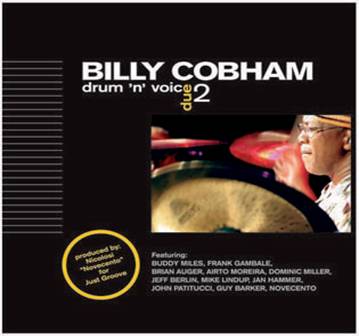 |
Billy Cobham – Drum'n'voice, Vol 2 (Nicolosi Productions – Just Groove NIC 90038)
Billy Cobham – Drums
Frank Gambale – guitar
Brian Auger – Hammond organ
Buddy Miles – vocal
Jeff Berlin – bass solo
Mike Lindup – vocals
Airto Moreira – percussion
Jan Hammer – synth solo
John Patitucci – bass
Dominic Miller – guitar
Guy Barker – flugel horn
Pino Nicolosi – keyboards
Marco Fadda – percussion
Rossana Nicolosi – bass
Dora Nicolosi – vocals
Lino Nicolosi – guitar
Michele Carrabba – tenor saxophone
Pepe Ragonese – trumpet
Juan Carlos Calderin - perucussion
|
Cobham has rarely been off the scene since the heady 1970's when jazz fusion was the cutting edge music of the day for many jazz fans. For me, the awesome sight of Cobham's largesse double bass drum kit on the back cover of 'Alivemutherforya' and the overwhelming power he created at that late 1977 concert, are the trademark reminiscences I have of the man.
While this recording is essentially a Nicolosi family affair which Billy Cobham lends his name to, there are moments of that fusion 'edginess' on this disc. The general flavours are mostly of funk, groove and jazz pop, with some adventuresome solo passages which die hard Cobham fans will be yearning to hear.
Cobham has lost none of his rapid precision around the kit. 'Ozone Part 1' is one of those pieces where the virtuosic groove grabs you and leads you to 'Part 2' which is ripe with funk and more lightening fast solo work.
There are some stellar contributions from a cast of guests. Take Brian Auger's Hammond solo on the opener 'Waveform' and the subtle reference to 'Freedom Jazz Dance' or Guy Barker's Freddie Hubbard flugel horn sound on 'Let Me Breath'.
Both Nino and Pino Nicolosi have a hand in writing every piece and contributing to most tracks. Apart from the two percussion pieces, all have the dominant sound of slick post production. 'Final Destination' has the tenor of Michele Carrabba and the trumpet of Pepe Ragonese in an elaborate meandering unison backdrop for the underlapping groove.
My favourite tracks are the two percussion pieces where Cobham and Airto Moreira lock horns and transport your body into a rhythmic subconscious.
Overall a glossy funky look at how the fusion years influenced the Nicolosi's with some superb contributions from an excellent array of guests in an un-testing environment.
   
|
|
by Peter Wockner. |
|
Back to Index
|
|
 |
The Necks – Chemist (Fish of Milk distributed by Shock Records P/L)
Lloyd Swanton – bass
Chris Abrahams – keyboards
Tony Buck – drums, guitar
|
The Neck's technique of recording and performance, is virtually free of any pre-conceived ideas. What an outstanding testament to their collective musicianship that their output has remained fresh and original for nearly 20 years. Known for their 60-minute journeys, the latest offering 'Chemist' is a departure somewhat, in that instead of one vast canvas, we are treated to a triptych of three by twenty-minute contrasting soundscapes. In another departure from their proven formula of piano, bass and drums, Europe based Tony Buck reveals a hidden talent and plays guitar on all tracks.
The first track 'Fatal' is reminiscent of some of their work of 10 years past. Rather than build intensity from a quiet essence into a powerful force, it's actually turbulent from the outset and strengthens as Buck redoubles his rhythms and Abrahams layers his courses. The second track 'Buoyant' retreats into a spacey atmospheric area spawned by a sequence of random early-bird Yamaha DX7 tweets. Swanton attributes much of the inspiration for The Necks music to the Miles Davis album 'In a Silent Way' and this piece is an ideal example. Think of a slowly revealing pre-dawn glow as the sun gently augments it's early morning radiation to reveal its first ray of warmth.
The final on this album 'Abillera' is the least jazz inspired of the three although a brilliantly recorded chiming bass solo introduces it. The bass sound is so pure, you can hear the harmonics of each note. The guitar-based creation however, is probably the most 'produced' of the three and is indeed a danceable piece of pop art and is typical of their cult brand of sound.
While The Necks aren't exactly re-inventing themselves, they continue to surprise, inspire and influence and this is a worthy 13th edition to their already impressive catalogue.
   
|
|
by Peter Wockner. |
|
Back to Index
|
|
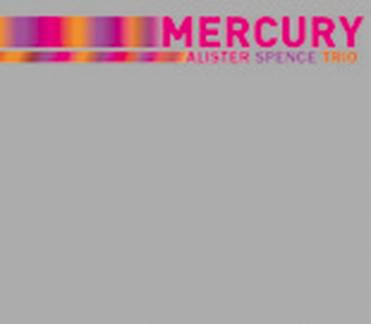 |
Alister Spence Trio – Mercury (Rufus Records – RF 075)
Alister Spence – piano, piano and glockenspiel samples
Lloyd Swanton – double bass
Toby Hall – drums and glockenspiel
|
From the opening hauntingly pensive bass lines, this album captures and retains your attention from the first listen. A contrast to the touring trio's previous Aria nominated album 'Flux', this album has large portions of rhythmic drive and funk.
Recorded following a successful tour of the UK and Canada, their sound as one cohesive unit has never sounded so solid. Sparse and irregular at points, building seamlessly into vigorous and potent bounties.
The intro to 'Luminescence' is a free expression of sound with Lloyd Swanton sounding like he's playing nearly on the bridge with his bow, Toby Hall delivering punctuations on glockenspiel and Spence exploring samples of the piano before the trio once again immerses themselves into a jam band sound of intensely repeated motifs, alternating with quieter passages of introspection.
Spence draws from jazz's traditional call and response elements, but I like to describe his improvisational approach as Question and Answer. Often he quizzes himself obliquely in solos and then logically provides himself an answer.
In 'Eagle Man' he goes further, with his left hand in unison with Swanton's bass while he asks the questions of Hall with his right hand. Compelling conversations indeed.
There are a few tracks, which are faded out, and I have an aversion to this but there is usually a reason.
The glockenspiel plays more than just a token role in this recording too. It brings Hall into the picture as melody maker. Spence even samples some of the glockenspiel sounds, which is possibly a first in Australian jazz.
Here is an album that oozes originality in composition, arrangement and musicality.
   
|
Alister Spence Trio – Sound Lounge 11th November 2006
The Sound Lounge once again played host to the fabulous sounds of the Alister Spence trio. A band that seems to gain in stature at each and every performance. Brimming with confidence following a successful UK and Canadian tour and for this outing, they celebrated the launch of the finest of their three albums to date 'Mercury' on Rufus Records.
The bandstand laid waiting with the traditional trio instruments along with a laptop and glockenspiel. The trio performed the pieces in album sequence including the shorter improvised intros that were generally underscored by samples of either piano or glockenspiel. The audience was hip enough to refrain from applause between intros and the actual pieces, which intensified the tension.
The dynamics of these new compositions are underpinned by a rhythmic drive that only occasionally bubbled to the surface on previous albums. While there was solo space for all three, the arrangements ensured all three were actively participating conceptually virtually all the time. This made for compelling entertainment, but even more so for a piano trio.
On 'Luminescence' Swanton played with the bow just above the bass' bridge while Spence used piano sampling to supplement the sound.
'Eagle man' is about a traditional hunt for a buried figurine at Point Plummer in the states north. A family holiday tradition that became the basis for a scrambling composition which features Hall digging and snatching his drums, painting the image of the Spence kids desperate to find the Eagle man first. We didn't find out what the prize was!
'Mercury' utilised glockenspiel sampling and Hall makes entry on the instrument himself to add another dimension to the melody line, while this time, Swanton uses a drumstick and a bow to create distorted remnants of sound. Hall's glockenspiel was played in unison with Spence but then suddenly switched back to drums. He is a master of building tension and releasing the groove within his kit. These types of sounds, coming mainly from American trios have been referred to in recent years as 'jam bands'.
Now that the first set was in Spence's words 'dispensed with', the audience gave their first applause for a solo and this was repeated throughout the second set. I couldn't hear Toby Hall's vocal groans on the album but they were very evident in this performance. At best adding to the texture of the sound, or at worst distracting the audience from his masterly touch. Nevertheless, his rim shots certainly galvanised the audience along with his brilliant solo using the brushes.
All the writing and arranging is the work of Alister Spence. This performance was an articulate reflection of the recording, which is also reviewed on this site. Read review.
|
|
by Peter Wockner. |
|
Back to Index
|
|
 |
John Harkins (Independently released)
John Harkins – piano
Jonathan Zwartz – bass
Andrew Dickeson – drums
|
Borrowing more from a pop sensibility than jazz, Harkins vocals are in contrast to his no-nonsense straight ahead jazz piano style. It shouldn't be surprising to learn that this trio is one of the busiest working rhythm sections in Sydney, making many good vocalists (local and international) sound great. This album however is about John Harkins vocals mainly, and the tasteful song choice which stretches from Irving Berlin to T Bone Walker, with Benny Carter's 'Fresh out of Love' thrown in for good jazz measure.
Harkins' vocal tone is a melting pot made up of doses of John Pizzarelli, Chet Baker and Paul Simon, with a subtle vibrato kicking in at the very end of a sustained note.
A special place on the album is 'Meet me at no Special Place'. A not so special place is 'Love for Sale' where a slightly broader range is required or a lower key choice. I would have loved to hear a couple of up-tempo instrumental trio tracks or even a solo piano piece to provide a greater blend to the mix from these seasoned instrumentalists.
Meanwhile, the piano solos on most songs provide foot tapping swing such as 'Change Partners' where Dickeson also gets solo opportunity.
This independent release certainly deserves wider recognition, due mostly to it's small 'j' jazz approach, pleasant vocals and 'in the pocket' drum and bass support.
   
|
|
by Peter Wockner. |
|
Back to Index
|
|
Days of Wine and Oehlers – Wangaratta 2006.
The Wangaratta earth may be parched but the wine was flowing, the roses blooming and the improvisation abundant during this the 17th Wangaratta Festival of Jazz. The fine clear weather saw large audiences, 'full house' signs and happy punters for this annual event traditionally held on the weekend prior to the Melbourne Cup and incorporating the National Jazz Awards.
The opening concert of the festival at the Wangaratta Town Hall was re-arranged at the last minute due to the Dutch ICP Orchestra experiencing flight delays. The Phil Slater Quartet took great advantage of the opportunity to be broadcast live on ABC Classic FM and on the internet in their place. The brilliant trumpeter becomes a spiritual chaneller of the music. He provided a masterly showcase of his original material with a supportive display from Simon Barker, Matt McMahon and Lloyd Swanton.
US pianist and this year's headline act Geri Allen, was invited to the stage at the smaller St Patrick's Hall and immediately delivered the now Americanised cliché, "We've come a long way to play for you tonight".
Her repertoire was carefully taken from her current album Timeless Portraits and Dreams. A consummate pianist who was clearly playing with her own set of cards but one thought rarely attempted to visit card tables outside her sphere.
The Australian Art Orchestra is literally a who's who of contemporary music improvisers. Led by Paul Grabowsky who generously presents pieces from various members of the ensemble, and on this occasion, admirers of the group Clarion Fracture Zone were equally pleased with two pieces from that bands former repertoire. Tony Gorman's 'Eternal Frost' conjured the images and sounds of ice cracking and vast glacial movements. Elliott Dalgleish took Lachlan Davidson's 'Witch Doctor' into a vertical spiralling frenzy only to be tempered by some indulgence by violinist John Roger's unflattering Johnny Cash vocalising.
Late on Saturday morning the audience warmly welcomed ex ABC broadcaster Jim McLeod when he took the stage to introduce the ICP Orchestra. With an early morning arrival and a late morning performance, it wasn't going to be easy to lift to the euphoric levels required for their spontaneously invented style of music. They rose to the occasion however, largely through the endearing character of drummer Han Bennink. While some may have been gritting their teeth through the initial free improvisations of the string trio, it was the sense of humour and their collective precision in harnessing what seemed to be feely created passages that was utterly fascinating.
The fusion group led by electric bassist Steve Hunter provided some contrast and certain accessibility to proceedings in the new undercover 'Jazz on Ovens' outdoor venue. The ever popular James Muller added more than just a rock awareness to his guitar soloing, while the emerging drummer James Hauptmann continued to thrill with his intricate technique and adaptability.
The trio of Andrea Keller, Tamara Murphy and Allan Browne opened their exquisite set in the pastoral Holy Trinity Church with the first track from their new recording, Mancini's 'The Days of Wine and Roses'. Contrary to my expectations of a joyous clarity in the acoustics of the 1856 building, I found the sound of the bass muddied with the drums. Logically, the building was never built for amplified bass and drum kits. Despite this, it's the empathy of Browne's drumming, which takes this group to a higher plane and I was pleased to hear them for the first time live.
A ferocious performance by both Oehlers and Tinkler and one that I'm sure will spawn a forthcoming recording. This was high octane jazz driven by Philip Rex on bass and Dave Beck drums. For me, this was one of the highlights of the festival, to hear these two accomplished virtuosi inspire each other with some overwhelmingly inventive improvising played like there was no tomorrow.
A broken piano string delayed proceedings at the Town Hall but it was not enough to prevent a reunion of two wizards of aus jazz. Paul Grabowsky and Dale Barlow in duo form commenced their bracket with the old Wizards tune Visby. Unfortunately, my witnessing any more of this collaboration was curtailed by the dreaded mobile phone.
Sydney's 'Java Quartet' led by bassist Michael Galeazzi presented pieces from their complete catalogue of albums. Simon Barker was subbing on drums for Mike Quigley who is currently in Germany performing with his heavy metal band Tourettes. Barker has played this role before and I found Wangaratta's playhouse a perfect setting for this groups two brackets. Java is in a world of it's own. Minimalist, melodic and the interaction between pianist Greg Coffin and saxophonist Matthew Ottignon is nearly as telepathic as the one that exists with his brother and saxophonist Sean Coffin.
I was on hand to hear only the final fifteen minutes of the Eric Boeren Quartet play in the Town Hall. They drew from the Ornette Coleman songbook and Boeren's cornet playing is extremely fluid with ideas and versatility. Rather than a single snare drum, Bennink had a full kit to exploit this time. Not many more effects can be created from a kit than what Bennink extracts. The use of his heel is prominent both on the snare and the tom to obtain varying pitch and texture.
The lack of good bop at the festival was noted by one ongoing fan. However I drifted into the somewhat inadequate Bull's Head to hear Al Davey and his Monstars. With the sound quality poor (I couldn't hear the piano), the elongated shape of the room and lack of capacity it was difficult to argue against the notion that be-bop was relegated here – be-bop must be dying.
After dinner, the Sydney group 'Theak-tet' led by alto and tenor saxophonist David Theak presented mainly music from their latest recording made in Oslo 'Old School'. Tonight, Tim Firth replaced Evan Mannell, the bands usual drummer. A showcase for Theak's compositional talents, but also another vehicle for the immensely talented James Muller on guitar, this was the best I've heard this group sound live. 'Evil Bert' had a funky Firth backbeat that galvanised the Town Hall, while I continue to ask the question, when will an Australian audience give a standing ovation to James Muller?
Something lacking at this year's festival was a global fusion sound. Most of the instruments I witnessed were European in origin apart from the electric piano, which gave Andrea Keller the tool for some dub reggae with the Paul Williamson sextet. The excitement of jazz is often enhanced by the addition of other ethnic musics into the mix and Williamson used this reggae beat to great effect. His glowing neon trumpet playing, as is often the case, foiled by the uproar of Jamie Oehlers on tenor.
Elliott Dalgleish and Misha Mengelborg collaborating in duo mode probably seemed like a good idea at the time, and there were some highlights like the dissection of Monk's 'Round Midnight', but on the whole it disappointed, especially the final dialogue between the two, which neither the audience nor Dalgleish himself could properly hear. If nothing else, it was proof that we have a reed player with an abundance of facility, endless ideas and just as zany as the Dutch.
While Tinkler used up plenty of high octane with Jamie Oehlers, earlier in the day, there was still some left in the tank for the much anticipated 'Tinkler, Grabowsky, Rex – Edie' performance at the Town Hall which was another highlight of this years festival. It was however the hunchback of Wang, Paul Grabowsky who this time stole the show. With hair now a whiter shade of grey, his performance alternated from madcap professor to consummate concert pianist. His overly dramatised lurches, successive rapid like runs across the expanse of the keyboard, his exploratory surgery on the innards of the grand piano, the distorted sounds of sheet music on the piano strings and at a turn, the most sublime, deft and melodic touches on piano you're ever likely to hear. Their performance overshadowed last year's live recording of the group but Wangaratta somehow brings out the best in our artists doesn't it? Their sounds drifted from hard swinging rhythms, to industrial, to spontaneous inventions. The grafting or layering of Tinkler's bursts against Grabowsky's flourishes along with Grabowsky's interplay with Edie was especially rewarding.
A phenomenon that seems to have emerged in Wangaratta are two separate communities. Firstly the locals. The locals frolic in Reid Street enjoying the samples of gourmet food and wine from local producers with the free sounds of local and regional bands in the background. Then there are the visitors. The visitors concentrate almost only on the venues in Ford and Oven Streets (including many with media passes).
If you missed the festival, don't despair, Wang is going from strength to strength and will no doubt be as imaginative and entertaining next year.
Incidentally, the National Jazz Awards focussed back on the piano this year and the winner was Sydney pianist Jackson Harrison.
|
|
by Peter Wockner. |
|
Back to Index
|
|
 |
Andy Fiddes - 'Survival of the Fiddes'
Gig at Sound Lounge Semour Centre for SIMA
Sydney, 02/06/2006
|
Miraculously, the urgency and energy of City Rd was transported to the Sound Lounge's stage in the form of ex-Gunnedah trumpeter Andy Fiddes' 'Survival of the Fiddes'. A name presumably inspired by the Hancock composition 'Survival of the Fittest' via 'Maiden Voyage'. Fiddes, initially in trio mode with Ben Waples on bass and Dave Goodman subbing on drums ensured instant opinion with the bold avant-garde 'Apathy Buster'. Then 'The Wisp' returned to traditional theme and variation, with NZ tenorist Reuben Derrick and trombonist James Kennedy forming the quintet. Derrick held the tenor on his right hand side in a posture reminiscent of a young Dexter Gordon but his rasps and shrieks, especially in the high register would recall Roland Kirk or Eric Dolphy.
The Fiddes tone was luminous with paper-thin vibrato and a smooth velvety texture. His clever writing for the three-horn line-up gave each horn singular voices during harmonising on the head, allowing the arrangements to breath against the pianoless heartbeat. 'Fear Smile' saw the horns syncopated into a crescendo as if a New Orleans marching band was approaching the fairgrounds while on the simply entitled 'Mandy' dedicated to the trumpeter's wife, Waples' large bass hands, magically turned Indian drones into Pierre Michelot 'Play Bach' like figures.
'Mustard!?!' - It's hot and you're at Taronga with a hot-dog in your mouth walking past the cockatoo enclosure. In free flight? No - controlled chaos, simmered to boiling point. The implied theme imbedded in an environment of freely created sounds while 'Hewn' placed Goodman's emphasis on patterns and textures rather than rhythm. Cuts and gashes and at one point like a motor mower about to stop, needing a fuel injection from his deeper than typical toms.
The second set commenced after the "ceremonial donning of the clogs". With his feet planted firmly in his Dutch mementos, the effect was a weighty rendering of 'Something wicked this way's been' followed by a feeling of emotional isolation in 'The Fall that takes an Age'. A melancholy tone was set by Fiddes on trumpet but was this an opportunity missed not to pick up the mellower flugelhorn?
'Buzzard Spiral' was introduced as an 'interpretative improvised dance'. "Animal cruelty!" was the lone shout from the crowd; such was the desperate, petrified yelps from Derrick's tenor, while Goodman painted light and shade impressions by snatching the cymbals and smacking the rims. Waples strummed the bass strings like a bow, building tension and sustained sound, then, at a turn, played nearly on the instrument's bridge to create electronic pulse like vibrations.
Having spent two years in London, 'Stale Sweat & Smog' is Fiddes' dedication to the tube. They trawled a beefy, fatty groove with Derrick front and centre frightening with his sheer capacity. At his fiercest, bloody, showing no fear with his lashings and guttural sounds.
The Fiddes sense of humour is embroiled in many of these compositions. 'Mink oiled boots are made for walkin', so don't try running in Colorado's and jeans in the mud with a hangover! It's a struggle, it's laborious. Slipping and sliding. Heavier and heavier as it starts to stick. It's farcical, it's parody, and it's a survival of the fittest.
When the art of composing, arranging and improvising meld together, a showcase like this can demonstrate high art. Add a great sense of humour, a relaxed atmosphere and good sound quality and you're left with the question "since when was high art such great fun?"
|
|
by Peter Wockner. |
|
Back to Index
|
|
 |
Coffin Brothers - 'Coffin Brothers Live' (Newmarket Music – NEW3222.2)
Sean Coffin – tenor saxophone
Greg Coffin – piano
Brett Hirst – acoustic bass
Simon Barker - drums
'I Hope Tomorrow is as Good as Yesterday'
|
I chose Sean's composition and track seven of eight on this disc as the title for this review because on this particular track, the quartet affects the perfect scenario for live performance - leaving you with an appetite for more.
Captured live 14th August 2004 at the now defunct 'Side on Café', this was a remarkable night when all the ingredients of a tenor sax post bop quartet seem to have come together.
The Coffin Bros have been on and off the local scene for over 10 years. Sean, having spent the latter part of the 1990's on the East Coast of the United States, forges that straight ahead NYC jazz sensibility on this disc.
'Matriarch of Marblehead' a tune written in dedication to the brother's grandmother, (the family having origins in the township near Boston) is written in the style of classic post bop with Simon Barker's ride cymbal getting the appropriate workout.
There is no pretence about this music. It's honest, raw and mainly restrained. While each of the quartet plays with expected authority, there are no egos, at least they don't surface at this performance. Sean Coffin plays within himself, displaying teasing glimpses of his technical prowess, preferring to give-way to the quartet's collective gravitation with which each composition is approached.
The interaction between the brothers is at a level you'd expect from such closely related artistic kinship especially on the ballad 'Calm After the Storm'.
All on the program are Sean's original compositions apart from 'The Far Queue' by pianist brother Greg. Greg's playing on his feature, displays his inventive, angular and sometimes jagged flourishes punctuated saliently by his intuitive left hand.
Then the flavour turns somewhat soulful with 'Something Missing' written when the absence of brother Greg left an irreplaceable missing cornerstone in the quartet while in Japan.
The savvy uncompromising music on this live date puts it in a sought after place amongst Australian live jazz recordings. An Aussie 'Live at the Vanguard' equivalent for people who enjoy the essence of the Sonny Rollins, Johnny Griffin, Joe Henderson lineage.
   
|
|
by Peter Wockner. |
|
Back to Index
|
|
 |
Grace Chung – 'Liking you Liking Me' (Independently released)
Grace Chung – vocals
John Kamman – guitar
Flaco Woods – percussion
Alan Lewine – bass
Marty Knepp – marimba and vibraphone
Phillipe Depontet – congas and dumbek
Jodi Beder – cello
Blair Goins – tuba
|
This is the fourth offering from Sydney vocalist Grace Chung. Originally from Hong Kong, Chung began singing in the 'jazz' genre in Sydney over 10 years ago. Since then she has enjoyed lengthy residencies in venues in Hong Kong and Washington, the latter working in collaboration with DC guitarist John Kamman who features heavily performing and arranging on this album.
This album, would sit just as comfortably on 'adult contemporary' shelves but clearly has influences from Blossom Dearie and Julie London. Chung's voice is front and centre on this recording with little space for improvisation but Kamman's guitar holds sway sufficiently to find it on jazz shelves too. Chung's articulate diction and her multi-tonal vocal characteristics also add to the jazz feel. She has the chops too. On the difficult but beautiful 'I'm All Smiles', the band is paired down to a vocal/guitar duo where she shows a full command of the art of telling a story.
Perhaps the highlight of the 11 track program is 'Perhaps Perhaps Perhaps/Sway where Chung sounds relaxed and playful, embracing the samba tempo. Kamman supports here with a restrained melodic solo.
The Tom Waits 'I don't want to grow up' has a faux Cindi Lauper attitude about it. While ex-Richie Cole bassist, Alan Lewine ensures an unwavering groove on 5 of the 11 offerings.
While Ne Me Quitte Pas (If you go away)/The Look of Love is at times over indulgent with sustained notes, the minimalist arrangement breathes new life into the second of the Bacharach/David tracks. Chung's search for perfect enunciation sometimes leaves her noticeably short on breath, which could be annoying for some.
An imaginative mix of song choice, from Cole Porter to Tom Waits to Redd Stewart and Pee Wee King's Tennessee Waltz, rounds off what is a valiant attempt to capture the middle ground in a laid back bluesy, unobtrusive jazz fashion.
  
|
|
by Peter Wockner. |
|
Back to Index
|
|
 |
Leo Trincabelli - 'Hangmusic' (Independently released)
Leo Trincabelli - hang
Bukhard Hessler - melodica
|
According to Wikipedia "world music" can be roughly defined as music which uses distinctive ethnic scales, modes and musical inflections, and which is usually (though not always) performed on or accompanied by distinctive traditional ethnic instruments".
What would you say about very distinctive original music, recorded in magic Barcelona, played by a Uruguayan musician on a unique instrument invented by a Swiss engineer? The instrument, "The Hang" is based on Indian scales and the Japanese gong. Global fusion? Keep listening. I'm sure, you'll find your own favourite hues on this simple, but very powerful palette of sounds and rhythms. Maybe Moorish, Northern-African, Medieval – European, maybe something different. It is definitely global fusion across the different cultures and different times. Unique music, a unique instrument.
The Hang (an empty metal void in the shape of a hemisphere with variable thicknesses of it's wall, designed by Felix Rohner and Sabina Scharer) is very different to the Caribbean steel drum mechanically and in nature - it has a very different and much wider tonal scale, along with a much deeper sound and is played with the fingers.
Some of compositions on the CD are backed-up by melodica (harmelodica).
While the relationship with the melodica might at first be difficult to uncover, (the contrast of a raw, undeveloped medium to a highly developed and dependable sound), it's fascinating how these two tones accommodate each other in their own worlds.
The Great Wizard of the "The Hang" - percussionist Leo Trincabelli.
Listen to the samples (1, 2, 3) of these strange and very elegant cascades of sound.
This CD is the world debut of the new musical instrument and the music of Leo Trincabelli.
Very well done. Very interesting, fresh, highly recommended.
   
|
|
by Vlad Gilbourd. |
|
Back to Index
|
|
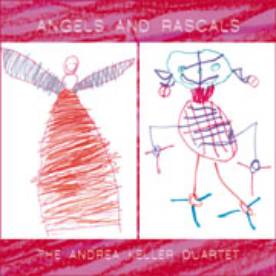 |
Andrea Keller - 'Angels and Rascals' (ABC Records)
|
When sometimes we become what we were born for
The title of this review is the name of the last track on this program of work by Andrea Keller who composed and arranged all 12 pieces. This is my first exposure to Ms Keller. Undoubtedly we are living through a period in improvised, perhaps all, music when the consumer - I hesitate to say listener - is subject to a multitude of reissues, compilations, and remastered classics of the genre that is somewhat overwhelming. Companies, such as CBS, are milking this market for all it is worth. For an emerging artist it must be incredibly difficult, firstly to get any attention from a producer, and secondly, to compete in such a market for the ears of the consumer. This year - 2006 - I have listened to three programs of music that were not reissues that compelled me from the opening notes to pay attention to what ultimately proved to be three outstanding works - Andrew Hill's TIMELINES, Charles Lloyd's SANGAM and Andrea Keller's ANGELS AND RASCALS. I found this surprising as the first two are established masters - such is the subjective nature of music and its enjoyment: but, its an enjoyment based on harmonic and melodic richness and rhythms that delight and not just one tune, but the care and attention that has gone into the programs. For example, on ANGELS AND RASCALS the piece Prague Ten, with an arranged repetitive motif for the horns with Danny Fischer serving us up with some "free" drumming seamlessly moves into Machine Gun Piano which has some interplay and collective improvisation and cooks.
For purposes of comparison for the seasoned jazz listener, I would say the work of David Berkman and his HANDMADE spring to mind. Which is to say, great care has gone into arrangements and programming as opposed to a blowing session.
The quartet consists of Ms Keller piano, Eugene Ball trumpet, Ian Whitehurst tenor, Danny Fischer drums augmented by Shannon Barnett Trombone, and Gian Slater voice.
I'll say up front that I am not a fan of voice in the jazz setting as so few appeal to me. However, Ms Slater uses her voice as another instrument to enhance the overall colour of the works. The harmony of voice and trombone on 20/10 is especially effective. I am a fan of the piano, and Ms Keller's touch, control, feeling, and drive are everywhere evident.
Interest doesn't flag - which in itself says something. The highlight for me was RESTING PLACE which has superb work by all concerned but especially Mr Ball with
the breath of cymbal by Mr Fischer providing a lattice of support behind. The use of space in this work also reveals Ms Keller's exceptional feel for music. Hence the title of my review. Being born is one thing, but you have to put the love into the work you are destined for - Ms Keller clearly has.
Jim Keller's drawings and the overall package design and the warmth of the excellent recording by Mal Stanley make this one of my best purchases of 2006. One to own.
   
|
|
by Ian Muldoon. |
|
Back to Index
|
|
 |
Brad Mehldau Trio – 'House on Hill' (Nonesuch 79911-2)
Brad Mehldau - piano
Larry Grenadier – bass
Jorge Rossy – drums
|
As we've come to expect from Brad Mehldau, every one of these self penned pieces has a beautiful melodic quality. Instantly engaging with the listener. Quite an extraordinary talent with a virtual pop sensibility, but this is far from music to attract the masses. Real jazz doesn't aim to, does it? That's a question for another occasion.
Having witnessed Mehldau with this trio at Marciac 1998, I realised I was hearing something very special. All of these originals were recorded between 2000 and 2002 and as Mehldau mentions in the lengthy liner notes (which could also be used in place of a jazz studies lecture) they form a time capsule of his writing then, and of the way the trio was playing together.
While Mehldau admits these compositions sit within the theme and variation model of the majority of small jazz ensembles, he also is frustrated by the limitations it brings to composing. All the more hats off to Mehldau I say, because his themes here are compelling the listener to study the variations or the improvisations.
Meldau's improvising is tender, meandering but always drawing from the soul of his original theme.
Larry Grenadier's notes bounce off his bass like a rubber ball off the pavement, such is his technique. Take his solo on 'Bealtine' for instance, melodically skipping across the theme provoking and entertaining.
Rhythm and lyrical texture is what drives Rossy. Always empathetic to the band sound, and a great explorer of the cymbal's possibilities. He's a big reason why this recording has such welcoming and embracing feel.
    
|
|
by Peter Wockner. |
|
Back to Index
|
|
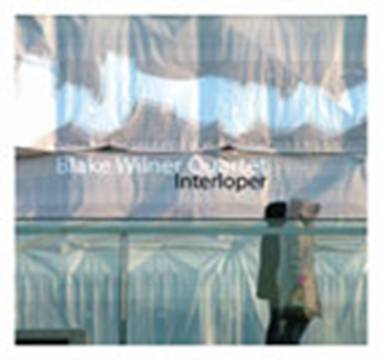 |
Blake Wilner Quartet - Interloper (Ant Jazz ANTJCD4)
Blake Wilner - guitar
Brandon Allen - saxophone
Oli Hayhurst - bass
Chris Hutchings - drums
|
There is an urgency and energy in this music, which is very welcome.
Reminiscent of fiery Finnish 'jazz' with no stylistic boundaries. I hear the
energy and subtlety of Jukka Perko and Teemu Viinikainen combos in this
recording, but it's Blake Wilner's thoughtful compositions, which really gives
this album an assured theme and identity.
The guitarist Blake Wilner may have escaped your radar but it's only because
he's been soaking up influences in the UK, New York and Europe. His writing
here on all the compositions has the band in mind and the band sound is what
strikes the major chord. This, his third album, was recorded in London. The
interplay and synchronicity between Wilner and Allen especially is something
quite special to hear.
Brandon Allen is also now based in London and makes a bold statement on this
album. His bluesy saxophone style has a soulful fat vibrato feel on ballads but
shrieks and shouts on the up-tempo selections.
'Mo Mo' is a simple funky repeated bass line motif, which provides Wilner and
Allen the setting for improvisation of weight and intensity.
'Interloper' is introduced with the majestic sounds of Oli Hayhurst playing
with the bow until the interloper arrives creating busy city sounds, horns
honking, rapid transit, people communicating or shouting loudly and in a hurry.
These are the images conjured by such clever writing for the quartet.
'Stormy Friday' simmers away under the steam of Wilner's guitar until the brew
reaches boiling point. Then sublimely, the eye of the storm (Allen's horn and
Hutching's drums) recedes back into its infectious melody. This is compelling
music.
'Dangerous Mind' breaks into grunge and funk sounds with Allen and Wilner
breaking in and out of unison while maintaining an overall impulsive approach.
Highly recommended listening.
   
|
|
by Peter Wockner. |
|
Back to Index
|
|
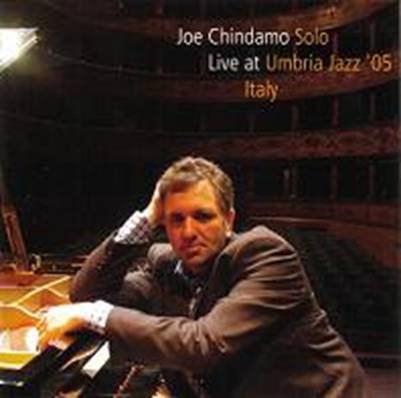 |
Joe Chindamo - Solo Live at Umbria Jazz 2005 (Newmarket 3205)
Joe Chindamo - piano
|
While Joe Chindamo's name may be unfamiliar to you, a sit was to me, one must
assume that it takes a certain measure of talent to be invited to perform not
one but three solo piano concerts at a prestigious festival such as Umbria
Jazz, as Chindamo was this year (2005). It's not long before he validates that
assumption and proves it correct. From the liner notes, written by Chindamo
himself, I deduced that he is an Australian (or at least resides there) and
that his principal role model is the great Oscar Peterson, who coincidentally
also performed at this year's Umbria festival (2005).
It's immediately apparent that Chindamo has listened closely to and learned
indispensable lessons from Peterson, as he has from Oscar's legendary
precursor, the incomparable Art Tatum. Peterson's influence is conspicuous in
Chindamo's forceful left hand, Tatum's (and Oscar's) in the nimbly expressive
right. Above all, he has the singular ability, gleaned from both of them, to
compose a spellbinding narrative using only his two hands and those
eighty-eight keys.
Chindamo has chosen for this album what he says are the best tracks from the
three Umbria concerts, which lasted in total around four hours. He opens with
Gershwin ("It Ain't Necessarily So"), revisits standards by Hoagy Carmichael,
Cole Porter, and Jerome Kern, refreshes Duke Ellington's "Satin Doll" and
Charlie Chaplin's "Smile", and recalls the Nat King Cole hit "Answer Me My
Love" before closing with Errol Garner's "Misty". Throughout, his approach is
one of unpretentious elegance underscored by superlative technique. The album
is wonderfully recorded, the audience so hushed one can almost hear a pedal
tapped. A delightful concert from start to finish.
|
|
by Jack Bowers - Cadence Magazine June 2006. |
|
Back to Index
|
|
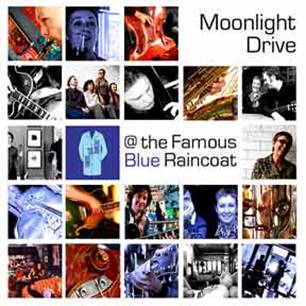 |
Leo Dale'Moonlight Drive - @ the Famous Blue Raincoat'
(Qreleases.com)
Leo Dale - baritone, alto and soprano saxes, alto flute and vocal
Tim Nikolsky - Guitar and electric bass
James Wakeling - guitar and vocal
Margot Leighton - vocal
Special guests Ray Pereira - Percussion
Philip Rex - double bass
Peter Knight - trumpet
Mal Webb and Gavin Gray - backing vocals
Shannon Barnett - trombone
|
Jazz is certainly an art form where something of great substance can come from
informality. I'm confident that after only two listens to this album you'll be
humming or whistling the simply catchy melodies. This recording is the result
of regular jam sessions in a west Melbourne cafe. Breezy summer Sunday
afternoon jazz in an easy listening style but not without a good measure of
improvisation.
Perhaps best known for his work with the group Oxo Cubans, Leo Dale's creative
flare was nurtured in Melbourne until the age of 19 before he took up the
saxophone. He now plays all the saxophones, flute and sings on some of these
Latin inspired numbers. His appealing tone and restrained solos are showcased
brightly against a clean sounding rhythmic backdrop.
Guitarist and bass player Tim Nikolsky completed a Diploma of Music Performance
in 1998 at NMIT and returned in 2000 to complete the Advanced Diploma in
Contemporary Music. His rhythmic feel on both instruments maintains a passive
unobtrusive pulse throughout the album. Vocalist Margot Leighton is an
experienced jazz singer on the Melbourne scene since 1988. She contributes two
of the pieces from the all original album, 'Rum Rhumba' and 'Cycling through
France'. While her vocals won't have you pedalling hard, you'll be riding easy
and enjoying the vistas.
One of the six guests on the album is Sri Lankan born percussionist Ray
Pereira. With influences as diverse as Harry Belafonte and Sri Lankan baila,
Pereira is the percussionist of choice for so many Australian music leaders
including Vince Jones, Paul Kelly and Renee Geyer. The absence of a full drum
kit on this album gives him the space to enjoy himself, and you, the
opportunity to hear his subtleties.
If you like jazz that swings with understated Latin flavours, the odd harmonic
vocal and totally uncluttered then take a 'Moonlight Drive'.
  
|
|
by Peter Wockner. |
|
Back to Index
|
|
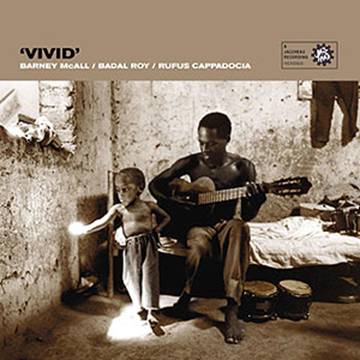 |
Barney McAll 'Vivid' (Jazzhead Head 065)
Badal Roy - tablas
Barney McAll - piano, wurlitzer, kalimba, keyboards
Rufus Cappadocia - 5 string cello, gerhu
|
Try and recall when Barney McAll toured Australia with Gary
Bartz a few years back. He made the story so vivid that we all believed it.
Here is a butterfly, fluttering randomly from flower to flower in a colourful
garden. A butterfly, intent on its mission, but cherishing each little journey
or diversion.
Barney McAll embraces so many diverse influences. Since moving to NYC
permanently, his lotus has been allowed to blossom. It blossoms vividly here in
this Jazzhead release. The recording session took place in what looks like
Barney's NYC apartment. He gathers musicians with wide ranging influences such
as tabla player Badal Roy who worked with Miles Davis in 1972, to the funky
trombone of Fred Wesley. Barney himself plays piano, wurlitzer, kalimba and
other keyboards. In fact the recording has no less than 11 guest artists
joining McAll, Badal Roy and cellist Rufus Cappadocia on 13 tracks.
The result is an East meets West melting pot that emancipates your spirit on a
journey through Africa and the subcontinent. This music hypnotises. Barney
plays a thoughtful spare role of his own volition and lets the music unfold
itself.
A robust traditional vocal in the native tongue of Abdoulaie Diabate snaps you
out of that trance like state on track 11 '25 Min'.
'Balatabla' is a duet with Famoro Diaubate on balafon and Roy on tabla. It's
groove employs rhythm shifts, and seemingly spontaneously created melodies.
This album will appeal to fans of that overly used term 'World Music' and in
doing so will expose Barney McAll to a new audience. However there are imposing
passages of improvisation here to keep the jazz fan smiling.
    
|
|
by Peter Wockner. |
|
Back to Index
|
|
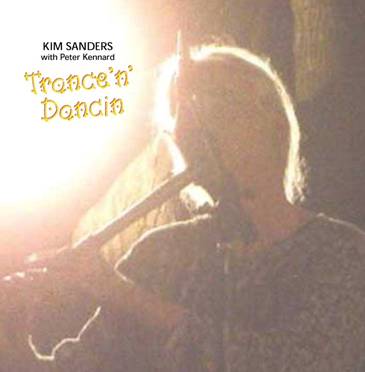 |
Kim
Sanders with Peter Kennard 'Tranc'n'Dancin' (Independently
released)
Kim Sanders - ney, kaval, mey, Bulgarian and Turkish gaidas, aardvark, saluang.
Peter Kennard - dhaf, bendir, darabukka, megabukka, riq, zills,
gong-on-a-mattress, wood blocks, dried budgies, surdo, ride cymbal, harmonium,
keyboards, chan, another cymbal.
|
Given the jazz provenance of Kim Sanders, prior expectations
that this is a jazz album may be justified. A few minutes listening to this CD
however, will quickly put such suppositions to rest. From the very first track,
the dominant flavour is clearly not just Middle Eastern but very particular
strands within the complex heritage of Middle Eastern music and Balkan music.
A major part of this album is a modern interpretation of Traditional Mevlevi
(Whirling Dervish) and Balkan dance music. Yet it loses none of the meditative
and languid qualities of the original trance music, especially in the initial
tracks, "Saba Saz Semaisi" and "Kimizi Gul", but most apparent in Kim Sanders'
own composition "Saba Taksim".
These pieces give way to the effervescence of "Solitary Circumambulation", an
acquired taste perhaps, being according to the liner notes, the world's first
composition for gaida, Hammond organ, and surdo, as well as the more buoyant
"Kaval Taksim." Yet, the real beauty of the album is the way that the bulk of
the tracks achieve the near impossible feat of exuding a sound that is elegiac
but at the same time spirited. The hauntingly beautiful "Gidemem Siraza ben" is
almost heartrending in this technically masterful and emotionally uplifting
intertwining of the plaintive with the exuberant. If there is a killer track in
this album, this has to be it.
It is little wonder that the album announces itself as trance music-the
listener is transported by this otherworldly music to a mysterious and rarefied
atmosphere. Kim Sanders' superb flute playing, with the Turkish ney and the
Bulgarian wooden kaval goes a long way in creating the overarching mesmerising
quality of this album.
Multi-instrumentalist Kim Sanders achieves total command over all his
instruments and together with Peter Kennard has produced a masterful album
which is an ideal vehicle for a breakthrough to a wider audience.
   
|
|
by Dush Perera. |
|
Back to Index
|
|
 |
The
Conglomerate 'Go to the Beach' (Independently released)
Ollie McGill - piano
Harry Angus - trumpet
Jules Pascoe - double bass
Harry Shaw-Reynolds - drums
Andy Baldwin - mixes
|
Head to most Aussie city beaches and you're likely to find a
diverse demographic, people all shapes and sizes, from near and faraway lands
drawn to the beach and enjoying one common denominator - the vibe.
Literally however, the word conglomerate means something composed of different
or random things. Geologically, a sedimentary rock formed of rounded pebbles
deposited in or by water and cemented together.
Whatever the reasoning, this group is perfectly named for the sounds it has
created on this album.
Although underpinned by the approach of modern jazz and improvisation, the disc
draws from sounds and influences as diverse as blues, funk, contemporary
classical, vaudeville, electronica, hip-hop, Middle East and Asian sound-scapes
and freely improvised sections.
The opener to the album 'A Hot Day' simmers along underneath the trumpet of
Harry Angus like a brewing storm that disappears as quickly as it strikes, but
wait, just when you least expect it, the eye of the storm circles and you're in
it's path again.
Sometimes zany in it's approach to composition. Infectiously formulated grooves
and liberating in its freely improvised sections, brightly mixed together with
samples. At times chaotic and at other times sublime, this recording represents
a compelling musical collage that will reward you with every hearing. The tune
titles, coupled with the contrasts from track to track are reminiscent of a
motion picture soundtrack.
'Kombi Ride' turns into just that with Harry Shaw-Reynolds providing the bumpy
groove on the drums and Ollie McGill the tour director on piano, showing you
just how fast the Kombi goes down the hill but just how much more there is to
see at a slower pace going up the other side.
Overall it's not only a lot of fun to listen to but it's quirky twists and
turns make it one of the most interesting first listens in a long time.
  
|
|
by Peter Wockner. |
|
Back to Index
|
|
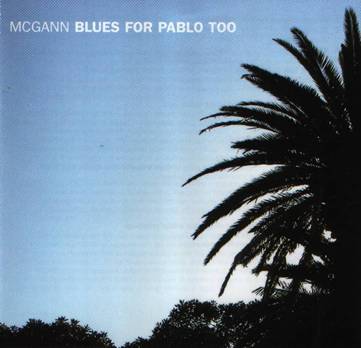 |
Bernie McGann 'Blues for Pablo Too' (Rufus Records RF083)
Bernie McGann - alto saxophone
Warwick Alder - trumpet
Lloyd Swanton - acoustic bass
John Pochee - drums
|
Put on your sombrero, step outside and enter the world of
Bernie McGann. Accept the brisk walking bass line opening invitation of Lloyd
Swanton on this marvellous disc from our most distinctive of alto stylists.
Just as self expression was Picasso's lifelong struggle, here we have McGann
wrestling his ideas through the sinewy tone of his alto that we have come to
know and love. Could it be the single most identifiable sound on the saxophone
in jazz today?
No longer the 'Three Masked Musicians', Alder is now the perfect foil for
McGann. His feature on the Blue Note reminiscent 'Midget' should get him the
recognition he deserves. Surely this is his greatest recorded output to date.
The quartet played the state supported Bimhaus in Amsterdam this year on a
European tour.
Pochee and his trademark parentheses exclaim rather than shout in a parity
which influences and directs rather than merely keeping time. Here is a
gentleman of the kit still at the height of his power but dig his brushwork on
'Three', a piece by saxophonist Gai Bryant.
For me, the most moving piece is the Roger Frampton tune, 'The Body Blues', one
of Australia's great composers. Worth the price of the disc alone, this cooks
and is served up on a platter par excellence.
    
|
|
by Peter Wockner. |
|
Back to Index
|
|
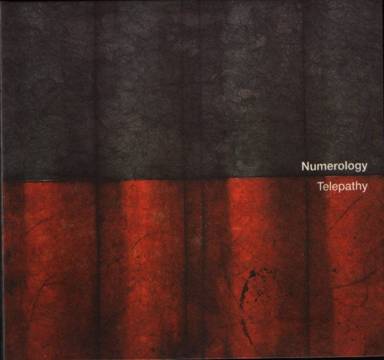 |
Cameron Undy 'Numerology - Telepathy' (Jazzgroove JGR026)
Cameron Undy - bass
Carl Dewhurst - guitar
Simon Barker - drums |
'So Blue', the opener creeps in on you and smothers you in a sonic blanket
before Carl Dewhurst materialises the theme.
Cameron Undy, leads this trio which showcases his more acoustic presence on
Sydney's jazz scene. Readers may recall his other band 20th Century Dog &
his work with Matt Keegan on the electric bass.
This trio is also a perfect vehicle for the writing talent of Undy. Extrovert
and in your face is the 'Mother Tongue', with Simon Barker creating multiple
layers of rhythm on the drums.
There are two short tracks on this disc which provide variety and aural
perspective on a bass players outing. Remember bassist Ron Carter has recorded
more than 50 albums as leader. 'Life of Colours' is one of the compositions
which feels as though it's a complex puzzle without being fully resolved.
'3.5.7' explores a variety of time signatures on a freer paranormal platform.
'Telepathy' brings the disc back into the edgey groove where it all began. How
vital is Simon Barker to this music? This disc is a muesli mix of very
interesting soundscapes and discoveries. Keep an open mind and you'll be
rewarded.
  
|
|
by Peter Wockner. |
Back to Index
|
|
|
 |
Greg Osby 'Public' (Blue Note Records 7243 5 97683 2 8)
Greg Osby alto saxophone
Nicholas Payton trumpet
Megumi Yonezawa piano
Robert Hurst bass
Rodney Green drums
Joan Osborne vocals on 'Lover Man'
|
Greg Osby must now be considered as one of the alto saxophone powerhouses of
his generation. His volume of consistent output over the last 15 years speaks
for itself. His latest offering is captured live at the Jazz Standard before a
demanding New York City audience in January of this year . The best Jazz is
live Jazz and there is no exception here.
Since his explorations into 'Jazz Rap' in the early 1990's he has been grasping
the biggest dilemma of his generation of jazzers. How do you both stay true to
the tradition of the genre and at the same time take the music forward into the
21st century.
This is very much a straightahead jazz album with a mixture of evergreen Jazz
standards and original tunes by Osby played by a regulation jazz Quintet
instrumentation, ie sax, trumpet, piano, bass and drums. If you heard his
studio recording last year 'St Louis Shoes' then you'll be familiar with some
of the original tunes here which form the core of the current Osby repetoire.
Osby really leaves listeners in little doubt now that he has a sound of his own
on the alto saxophone. An instantly identifiable tone blowing lines often
logical in sequence but searching in spirit.
Special guest is Nicholas Payton trumpet and Joan Osborne on vocals with 'Lover
Man'. It's worth the price however just to hear 'Bernie's Tune' and the wicked
version of 'Summertime'
In 'Summertime' the scene is set by Robert Hurst on bass who creates tension
with a harmonic riff around the melody. Then Payton and Osby trade blows,
understating the melody line before Payton, the New Orleans native, takes you
on a glorious bumpy tractor ride through Louisana on the Gershwin masterpiece,
before Osby brings you back home on a rapid express steam train. An brilliant
live recording.
   
|
|
by Peter Wockner. |
Back to Index
|
| |
 |
Jasper Leak Quintet 'It's Cold Out' (Jazzgroove Records JGR018)
Jasper Leak - acoustic and electric basses
Matt Keegan - tenor saxophone and maestro
Cameron Deyell- electric and acoustic guitars
Gerard Masters - piano, wurlitzer, fender rhodes and organ
Evan Mannell - drums and percussion
|
Since it's formation in 2001 the Jasper Leak Quintet has always featured Leak's
original compositions and outstanding playing by some of Sydney's finest young
improvisers. 'It's Cold Out' is no exception. It offers a refreshing showcase
of originals from the bass player.
Everything about this album is appealing. Jazzgroove album presentations are
now looking fantastic and the charcoal artwork on this cover (front and back)
look minimal and sophisticated against the ice green colouring.
But it's the music that retains your attention. Although the band is primarily
a jazz band, the material here draws on African, hip-hop, rock and contemporary
European sounds as a basis for the improvisation and interplay. The
compositions here are melodic and the improvisations uncluttered.
The title track 'It's Cold Out' is a non-confrontational gentle Latin inspired
piece with Matt Keegan taking a restrained but searching solo over a rhythm
that is seemingly breathing in and out due to subtle use of meter changes.
'Left Wing Larrikin' a collaboration of Leak, Keegan and Deyell is a tip of the
hat to Jasper's father and cartoonist Bill Leak. The introduction has an
African village dance type feel to it but the mood swings quickly to an
introspective thoughtful period then again to a driving hard bop sound where
Masters provides an impressive solo. Evan Mannell completes the sections to
this piece with a drum solo.
'Aries' is where Keegan's maestro gets it's first hearing. Keegan re-fuels the
distortion box which Eddie Harris first used with his saxophone in the 1960's.
The exceptional bassist Jasper Leak takes his first bass solo on the 5th track
of the album 'Little Match Girl'. He gets a very rich sound from the double
bass and doesn't overplay. Then Deyell and Keegan head into duet mode with
Keegan's saxophone almost sounding like a bass clarinet with another outing for
the maestro.
Jasper's bass resonates throughout this fine album. It's hard to believe he is
only 20 years as there is a maturity in his superb playing that reaches way
beyond his years.
   
|
|
by Peter Wockner. |
Back to Index
|
| |
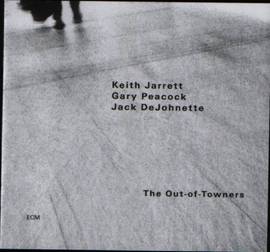 |
Keith Jarrett 'The Out of Towners' (ECM)
Keith Jarrett - piano
Gary Peacock - double bass
Jack DeJohnette - drums
Recorded live at State Opera 28th July 2001
|
What a comeback Keith Jarrett has made since his hiatus in the late 1990's with
Chronic Fatigue Syndrome. One gets the impression that Jarrett, however his
career path progressed, was always going to be a major musical phenomenon, but
his spells with Art Blakey, Charles Lloyd and Miles Davis in no way
disadvantaged his rise to greatness. He is popular worldwide and probably one
of the most influential pianists of the last 30 years but also has the capacity
to demand the highest concert ticket price of any other jazz musician.
This recording is a somewhat welcome relief as the trio focuses on a number of
original tunes by Jarrett rather than the standards which he has become so
famous for his re-interpretations. However in saying that, the introductory
number 'I Can't believe that you're in love with me' is a 12 minute gem.
Critics and fans are at odds with Jarretts vocalising although. His constant
voicings during improvisational periods are captured articulately here and one
finds it difficult to focus soley on his piano playing. For me it's always a
disappointment because his improvising is mostly so delightfully melodic only
to have it spoilt by an awful groaning/straining sound which is now obviously
part and parcel of the Jarrett package. (Mike Nock who has also formed the
habit, was once asked by a record company not to make this sound)
The trio swings deeply on this recording though and DeJohnette's heavy ride
cymbal which he plays very close to the centre of the bell, limiting the
sustain and actually creating sonic space for Peacock's bass to drive the
rhythm madly.
The original composition 'The Out of Towners' is where the interplay between
the three is best. It continues for over 19 minutes, one of the great
advantages live jazz recordings. It's almost like being there !
ECM as always have created a classic recording which will last the test of time
-
   
|
|
by Peter Wockner. |
Back to Index
|
| |
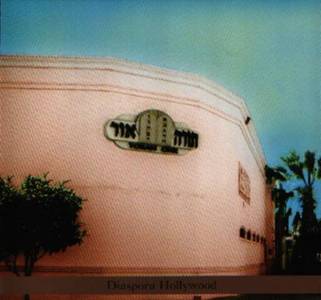 |
Steven Bernstein 'Diaspora Hollywood' (Tzadik TZ7191)
Steven Bernstein - trumpet, flugelhorn
Pablo Calogero - baritone saxophone, bass clarinet, bass flute, flute, balloon
flutes
DJ Bonebrake - vibraphone
David Piltch - bass
Danny Frankel - drums, bongos, percussion
|
Interestingly the opening notes of this album are played by Pablo Calogero on
the bass clarinet, but very soon after, Bernstein stamps his footprint with his
now identifiable slide trumpet purchased back in 1977.
Steven Bernstein is noted predominantly for his band 'Sex Mob' a band which is
identifiable in sound but difficult to categorise. This however is the third in
his Disaspora series on Tzadik, following the very successful Diaspora Soul and
Diaspora Blues.
Bernstein, with his fat vibrato tone explores newly created territory in a land
somewhere between classical Jewish melodies, Hollywood movie scores and 1950's
West Coast cool jazz. It's a fascinating place to be.
The only frustrating element is the occasional metronomic sound of drummer
Danny Frankel, who concentrates the brushes on the kit but swings much more on
the bongos.
The front line playing the melody in unison is now back big time in jazz and it
is certainly showcased here.
Bernstein's 'Meyer Lansky' is a composition which tells a story of shifting
rhythms and melodies.
Bernstein's hero Lester Bowie would grinning from the heavens over 'B'Rich
She'me' which disintegrates into 'Art Ensemble of Chicago like' freedom
exercises with Frankel reverting to the cymbals at last and Calogero's fleeting
multiphonics on the baritone saxophone.
Bernstein has a classic trumpet tone somewhere between Dizzy Gillespie, Wynton
Marsalis and reminiscent of our own Scott Tinkler with distinctive wide
vibrato. A fine album.
    
|
|
by Peter Wockner. |
Back to Index
|
| |
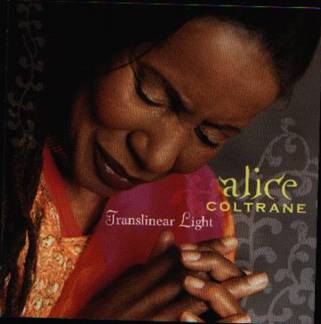 |
Alice Coltrane 'Translinear Light' (Impulse Records
0602498619292)
Alice Coltrane - piano, Wurlitzer organ, synthesizer
Ravi Coltrane - tenor saxophone, soprano saxophone
Oran Coltrane - alto saxophone
Charlie Haden - bass
James Genus - bass
Jack DeJohnette - drums
Jeff 'Tain' Watts - drums
The Sai Anantam Ashram Singers
Produced by Ravi Coltrane
|
This is the first recording from Alice Coltrane since the 1980 Warner Bros
release 'Transfiguration'. The widow of the giant saxophonist continues her
exploration into Eastern influenced expressions with 'Translinear Light'.
The tracks were recorded over three separate sessions between 2000 and 2004 and
while this provides great contrasts from track to track (or provides constant
disconnections depending on your view) and interesting cross sections of bands,
it somehow doesn't lend itself to the overall concept.
The 67 year old keyboardist, Alice Coltrane magically transforms the Wurlitzer
organ into a drone which sounds much like the Scottish bagpipes on the
traditional Sita Ram. Remember the Wurlitzer has a very unique sound, hollow
when compared to the Hammond B3.
Another traditional hymn 'Walk with Me' has typical JC 'First
Meditations'overtones which smoothly transforms into an easy groove laid down
by James Genus on bass and Watts on drums.
There are two John Coltrane pieces on the album. 'Crescent' and 'Leo', with
Ravi playing tenor on both. Big shoes to fill and one would have to question
whether these were appropriate choices.
The title track was recorded in 2000 and has an extended introspective opening
with son Ravi on soprano before Coltrane on piano takes you on a seemlingly
aimless chordal journey. Ravi finally re-enters and adds the spice which the
piece lacked for the first five minutes.
'Jagadishwar' and the synth get's the first of it's two outings. This is too
glossy and is little more than shopping mall background music.
The album closes with a chant by members of the Sai Anantam Ashram singers with
the background Wurlitzer drone. Quite appropriate for a Coltrane album and a
not so subtle tip of the hat to the most majestic chant of all 'A Love
Supreme'.
On the whole a little disappointing due to it's overall inconsistency. There
are some highlights and the Wurlitzer does make for an interesting conceptual
change, but it must be one for the die hard Coltrane devotees.
  
|
|
by Peter Wockner. |
Back to Index
|
| |
 |
Fiona Johnson and Cameron Undy 'Beads of Light' (Independent
www.pointlight.com.au)
Fiona Johnson - electric guitar
Cameron Undy - bass
Simon Barker - drums
Carl Dewhurst - acoustic guitar |
This is a stand out recording for the brother and sister team who share all the
composing rights on this independent release.
Fiona's 'Gentle Morning' is an especially appealing melody taken at an easy but
faster than heart beat pace. Think Bill Frisell or even the John Scofield/Pat
Metheny collaboration 'I can see your house from here'. Fiona Johnson has been
out of the music spotlight somewhat for a number of years now however her
exciting Manly Jazz Festival performances with Mike Nock in the 1990's remain
as some of that festivals most memorable highlights.
While Cameron has been establishing himself as one of Australia's jazz bass
players of choice, he's also been pursuing funk and groove opportunities in the
UK and Europe. 'Here and Now' another Johnson piece is suited very much to the
theme of this album, bright melodies, warm harmonies all captured brilliantly
in what sounds like a small cosy room setting thanks to sound engineer Richard
Belkner.
Lets not forget the importance of Carl Dewhurst to this outing. He is not heard
often in this rhythmically acoustic setting having well established his jazz
fusion and funk chops with his own quartet.
Simon Barker as always, daubs his impressionist beat in and around the rhythm
like a Renoir rendering beads of light in 'Moulin de la Galette'.
Cameron Undy gets to reprise his 'Temple' originally recorded in duo format
with Mike Nock in 1995 on the album of that name. Barker's cymbals elevate the
piece to even greater spiritual heights than 1995. Jazz and guitar lovers alike
will enjoy this album.
   
|
|
by Peter Wockner. |
Back to Index
|
| |
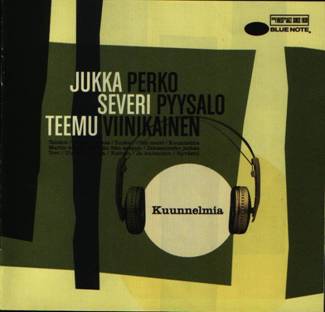 |
Jukka Perko, Severi Pyysalo, Teemu Viinikainen 'Kuunnelmia'
(Blue Note 7243 875248 2 8)
Jukka Perko - alto and soprano saxophone
Severi Pyysalo - vibraphone
Teemu Viinikainen - guitar |
Jukka Perko the Finish saxophonist and Severi Pyysalo, are well known to
Australian jazz audiences via their tours with the group 'Perko Pyysalo
Poppoo', one of the most exciting jazz groups to ever to appear at the Manly
Jazz Festival. The name Perko came to the forefront of the jazz world when at
age 18 at the 1986 Pori Jazz Festival he wowed audiences with virtuosic
performances which received rave reviews and the word 'sensation' was used
freely. He went on to tour with Dizzy Gillespie in 1988.
Severi Pyysalo's rise is just as meteoric having been discovered by Paquito
d'Rivera and Sarah Vaughan at the 1982 Pori Jazz Festival.
Teemu Viinikainen is the newest addition to this trio on guitar and he shares
compositional duties on five of the thirteen original pieces.
The pieces are best described as musical poetry of the highest order.
The format of saxophone, guitar and vibes create a minimal, uncluttered and
refreshing sound which focuses all your attention on melody, harmony and the
introspective improvisations that abound on these Nordic ballads.
On 'Olin nuori' Perko shows his glorious alto tone and superior technique
bending notes and playing triplets like a Terence Blanchard on the trumpet. On
soprano, his tone is not unlike Wayne Shorter.
Atmospheric and beautiful.
   
|
|
by Peter Wockner. |
Back to Index
|
| |
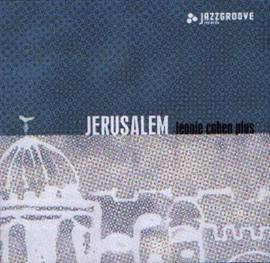 |
Leonie Cohen Plus 'Jerusalem' (Jazzgroove JGR 022)
Leonie Cohen - piano
Paul Cutlan - soprano and alto saxophones
Roger Manins - tenor saxophone
Hugh Fraser - double bass
Simon Barker - drums |
The concept of this album is now becoming a global trend by jazz musicians with
Jewish heritage to fuse together traditional Jewish music forms with jazz. The
movement, predominantly led by US jazz artists such as John Zorn and Steven
Bernstein has spread to Australia with the Jazzgroove release by pianist Leonie
Cohen.
Leonie Cohen formed the group in 1999 and has taken the band to the Melbourne
International Women's Jazz Festival and major Australian Jazz venues such as
Bennett's Lane in Melbourne and the Side On Cafe in Sydney.
The opening track is the Israeli anthem 'Hatikvah' a haunting melody played at
a leisurely walking pace. The addition of the 'under-recorded' Paul Cutlan on
soprano adds a certain spirituality to this piece.
The traditional 'Hava Nagila' is instantly identifiable and the drums of Simon
Barker offers the improvisers an urgent rhythm to build much more than the
original creation. Leonie Cohen's arrangements are inventive and at the same
time remain true to the tradition of the music.
Leonie Cohen's charter here is clearly not to overwhelm with an excess of
music. Her improvising is spare but melodic, haunting but not introspective.
'Dayenu' is a traditional Passover melody given a groovy backbeat while Cutlan
and Manins play the melody harmonically in unison before Manins solos with
Barker maintaining the groove with his tight brushwork.
Hugh Fraser, fresh from his bass work in 'We Will Rock You' is a solid edition
to this great Sydney based group.
   
|
|
by Peter Wockner. |
Back to Index
|
| |
 |
Graeme Lyle Meets Joe Chindamo 'Love Blues and Other Fiction'
(Newmarket Music 3163.2)
Graeme Lyall - alto & soprano saxophones
Joe Chindamo - piano & piano accordian
Sam Anning - bass
Ben Vanderwal - drums |
This is a collaboration between two of Australia's jazz greats. All the
compositions are originals by the saxophonist and pianist. On 'The Manic
Impressive', Chindamo's playing resembles elements of Oscar Peterson's sheer
rhythmic brilliance, while Graeme Lyall's alto has the fire and passion of an
Art Pepper with new found freedom, exploring, reaching and touching. The unison
passages here are so tight you'd be mistaken that these pair had been playing
together for years.
Thankfully though, this is the first of a series of at least three albums. The
opening blues 'The Second Last Supper' has an earthy 60's Blue Note sound with
passages of chordal vamps, walking basslines and sparkling Chindamo right hand
trills.
The beautiful ballad 'Daughters' is rendered on the album (previously heard on
Christine Sullivan's 'Here and Now' as 'When you find true love') magnificently
by a breathy almost vocal sounding alto, respecting the melody in a melancholy
way like only Lyall can.
The mix of Soprano and Piano Accordian on 'In Genius-Lee' makes for an
interesting diversion on the album. Traditional French Folk meets Lyall's
soprano tone which conjures a Wayne Shorter like mystery.
This is another fine album on the Newmarket label. Chindamo's writing and
playing is superb.
   
|
|
by Peter Wockner. |
Back to Index
|
| |
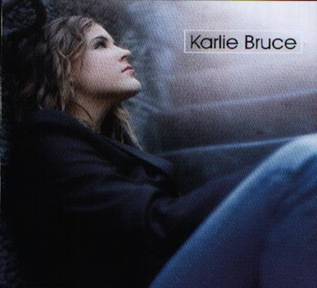 |
Karlie Bruce 'La Brava' (LB0066)
Karlie Bruce - vocals
John Harkins - piano
Jonathan Zwartz - bass
Ben Hauptmann - guitar
Dave Hibbard - drums |
One of the compelling aspects of this album is the interesting arrangements of
what is largely a gathering of jazz standards. The opening 'I Remember You', is
arranged by pianist John Harkins with a samba beat that's not usually applied
to this Johnny Mercer classic. Although jazz people fondly recall Chet Baker's
stamp all over it, Karlie's interpretation is fresh and her intonation is
something very special. These are tunes taken at a pace that suit all the
natural qualities of her voice and the listener gets to hear them all.
Karlie Bruce has emerged over the past couple of years as one of the most in
demand vocalists on the Australian music scene. Her jazz sensibility and clear
intent to understand the lyrics and believe in the lyrics is instantly apparent
on this self titled debut which was recorded back in 2003. A musician who
started playing the recorder and progressed to the saxophone, she brings a
certain instrumental quality to her phrasing. The package is complete with
eloquent diction and a gorgeous tone.
Karlie lets you know that she's got a lot of spare fuel in the tank with the
blues 'Don't Deceive Me'. Many singers these days belt out even the most gentle
of ballads. It's like over chilling a bottle of white wine and losing all those
special qualities and characteristics. But not the case with Karlie Bruce, the
timbre is not lost.
'Gone with the Wind' alone is worth the price of the CD and is suitably
reprised as track 9. Jonathan Zwartz's arrangement is a delight and showcases
Ben Hauptmann's acoustic guitar solo. You won't hear a more angelic rendering
of the lyric 'Just like a flame'. Yes this is indeed an album that makes you
feel good to be alive.
    
|
|
by Peter Wockner. |
Back to Index
|
| |
 |
Adrian Cunningham 'The View from Here'(Newmarket Music NEW
3175.2)
Adrian Cunningham - alto & tenor saxophones, clarinet
Bill Risby - piano
Dave Pudney - bass
Gordon Rytmeister - drums
Tony Azzopardi - perc 2,4,6,8,9
Victor Rounds - voice 8,2
Stuart French - acoustic guitar 4 |
Adrian Cunningham is a young Australian Jazz artist from Sydney who has the
amazing talent of making his emotions metamorphous into beautiful songs. He
makes playing the Alto/Tenor Saxophones and Clarinet look as easy as brushing
your teeth. He composes amazing songs by reflecting upon the emotions he has
felt throughout a variety of life experiences and allows his audience to share
these emotions as they listen to him.
Adrian has performed throughout Australia, Asia, Europe, The United States, and
even Africa. He has also released 2 phenomenal CDs. His second CD "The View
from Here" contains 10 outstanding, emotionally charged, tracks from beginning
to end. Eight out of ten of these songs were personally written by Adrian and
he also produced the CD. His team of musicians, Gordon Rytmeister: Drums, Bill
Risby: Piano, Tony Azzopardi: Percussion, Stuart French: Acoustic Guitar, David
Pudney: Bass, and Victor Rounds: vocals, mix their talents with his into sounds
that are universally enjoyable.
With fast songs such as "Unrequited," written about an unrequited crush he
experienced as a 12 year old, your day is bound to start on an upbeat note and
help motivate you to get what you want without being afraid. If you drained
from a hard day at work and flying away to a tropical island is unreachable for
you then listening to the two part "Island suite" is the second best thing to
being there.
Many songs by popular artists are often badly re-created, but Adrian's
perfectly unique rendition of U2's "With or Without You" would surely make Bono
and U2 feel completely flattered. It can create the perfect romantic atmosphere
for a special night for two, or can help you recapture the heart of someone you
want back.
A sure hit on Adrian's CD is "Goodbye Soup," a song he wrote in dedication to
the closing of a popular Jazz restaurant in Sydney, "Plus Soup," that
subsequently ended up not closing but just moving. "Goodbye Soup" possesses a
sound that will instantly make you feel a sense of sentimentality, reminding
you of your most favourite and cherished memories. As Adrian describes "Plus
Soup felt like a comfortable pair of old sneakers," and you can feel that while
listening to this song.
The fifth and most heartwarming song on the CD is "Bye You All." This song is
dedicated to Adrian's father who sadly passed away 6 years ago. The loss of a
parent is one of the greatest losses any child can endure. Adrian masterfully
composed all of his emotions into this song just a few months after his fathers
passing. Capturing the love he felt for his father with the intensity of his
loss he put it brilliantly together. Adrian's father would undoubtedly be
honoured and very proud. Talent can take an artist to a certain level of
success but to capture truly dedicated fans an artist must also posses a warm
hearted personality, and music that the audience can feel internally. Adrian
enraptures all of this and is sure to reach to the top with ease. His music
will easily grab onto your heart and make it pump a little bit faster.
To read more about Adrian, or to purchase his music, you can visit his website
at: www.adriancunningham.com
|
|
by Aparna Datta. |
| Aparna Datta is a published Writer, Photographer & Graphic
Designer who provides Promotional and Marketing services to individuals and
companies worldwide. To contact her view her website at:
www.aparnadatta.com |
Back to Index
|
| |
 |
The Java Quartet 'Deep Blue Sea' (Vitamin Records DHR 005)
Matthew Ottignon - saxophone
Greg Coffin - piano
Michael Galeazzi - bass
Mike Quigley - drums |
This is the fifth album from a group, which started out basically as a vehicle
for the compositions of bassist Michael Galeazzi, but has now become almost an
institution in Australian jazz. The group members who are ordinarily scattered
world wide on individual projects, gathered in Byron Bay for the recording in
the fashion of the 1960's Blue Note sound.
Michael Galeazzi contributes all the album's compositions except 'Jetty' by the
drummer Mike Quigley. Michael's spare and lyrical melodies are perfect settings
for both Ottignon and Coffin to improvise over. Ottignon's restrained style on
the saxophone proved he was the perfect replacement for the gap left by Richard
Maegraith when he left the band in 2003. Ottignon's solo on 'The Leaving Song'
for instance is as fleeting as watching an express train miss your station but
somehow avoids sounding as busy as that visual juxtaposition could be.
Greg Coffin provides a touch not un-like Herbie Hancock, asking melodic
questions and then providing the lyrical answers. This could be called a
concept album in that, while each piece has it's own characteristics, the
overall consistency in approach, the focus on the Galeazzi bass and the imagery
which those 'deep' notes create, almost has you submerging in a blue heaven.
'Little Boy', presumably written for Galeazzi's young toddler, is a gorgeous
ballad showcasing the brush work of Quigley, and how beautiful these players
can improvise at this slower than heartbeat tempo.
For me, this release is about as commercially accessible as straight ahead
Australian modern jazz can be while remaining so true artistically. What an
ideal sound the Java Quartet have found.
   
|
|
by Peter Wockner. |
Back to Index
|
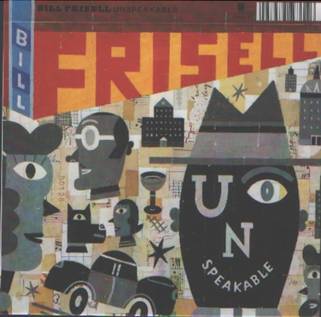 |
Bill Frisell 'Unspeakable' (Nonesuch 79828-2)
Bill Frisell - guitars
Hal Willner - turntables, samples
Tony Scherr - bass guitar
Kenny Wollesen - drums
Don Alias - percussion
Steven Bernstein - trumpet
Briggan Krauss - baritone Sax
Curtis Fowlkes - trombone
Adam Dorn - synth
Plus The 858 Strings:
Jenny Scheinman - violin
Eyvind Kang - viola
Hank Roberts - cello |
Bill Frisell's 'Unspeakable' is reminiscent of a vast Brett Whitley canvas,
unpredictable, diverse in influence, whimsical in approach and musical samples
scattered in places that you would least expect. For the fans of the 'folk'
Frisell, you're in for a different perspective. 'Unspeakable' is ripe in
repetitive grooves and orchestration thanks to the addition of The 858 Strings.
Most of the tunes are penned by Frisell and feature his trademark laid back and
spare feeling and tempo. Frisell's own playing and soloing still leaves
sufficient space for the groove to suck you in and at times hold you in a
trance like state. 'White Fang' is a funky romp, while 'Del Close' has the
repetitive 'I'm gonna get ya' feeling. 'Stringbean' has the backdrop sound of
the old 'frying vinyl' heard on your old LP's and even has the effect of your
CD player getting caught on a split second groove. Trust me I tried it on three
different players to make sure I wasn't hearing things.
Yes this is Frisell in a different world. 'Alias' reminds me of a retro
soundtrack to a 60's James Bond movie with big bold brassy lines riveted
through the groovey bass line and guitar breaks. 'Who was that Girl' or
'Goodbye Goodbye Goodbye' are probably the closest sound to Frisell's folky
style. On most tracks I would have liked to have heard more of the congas and
African drums setting the groove rather than the rigid sounding rhythms set by
Kenny Wollesen on the drum kit. Overall a very pleasing release.
   
|
|
by Peter Wockner. |
Back to Index
|
|


















































































































































































